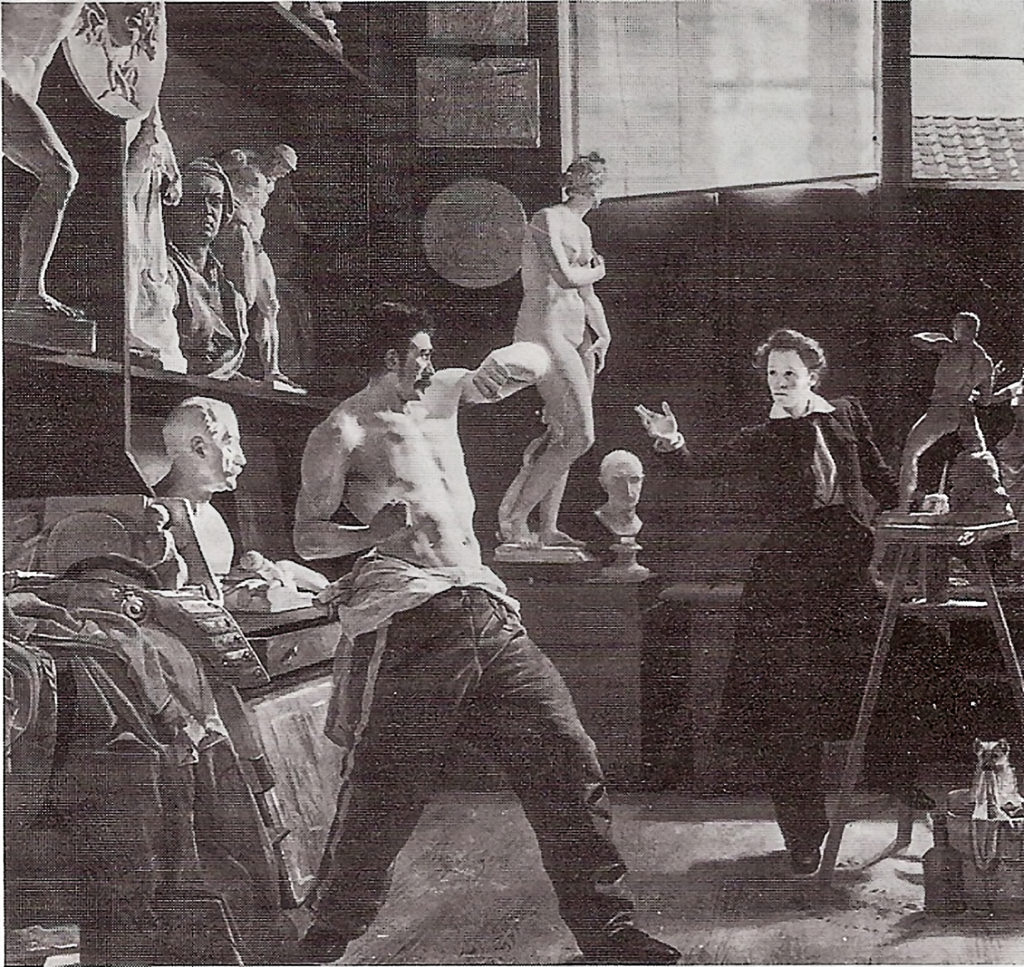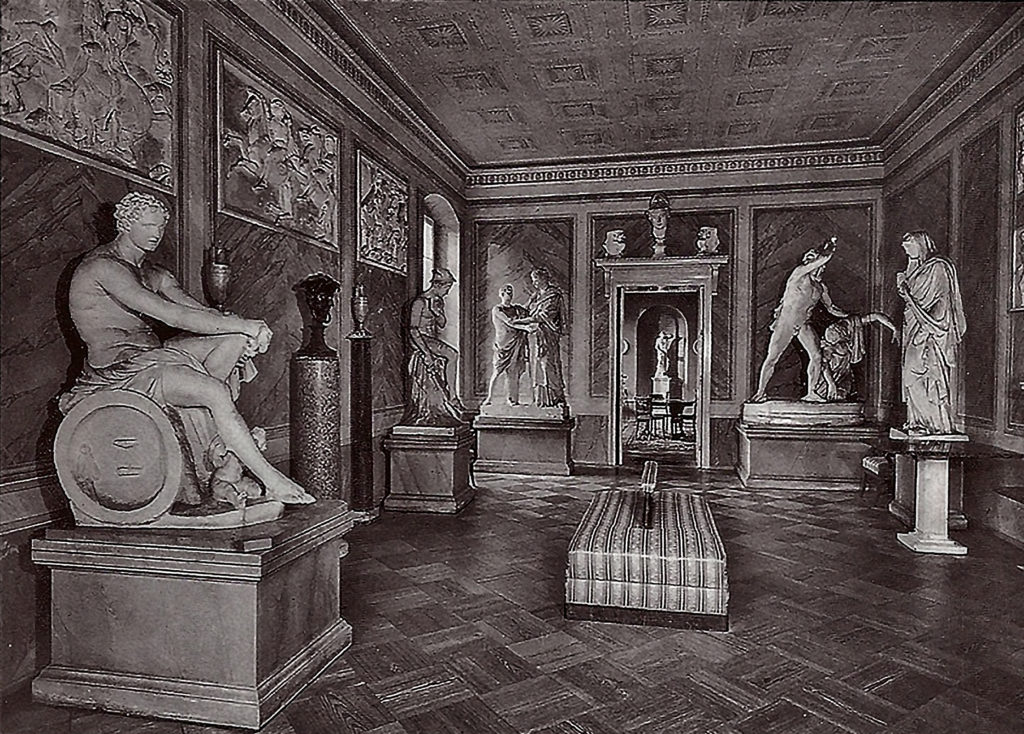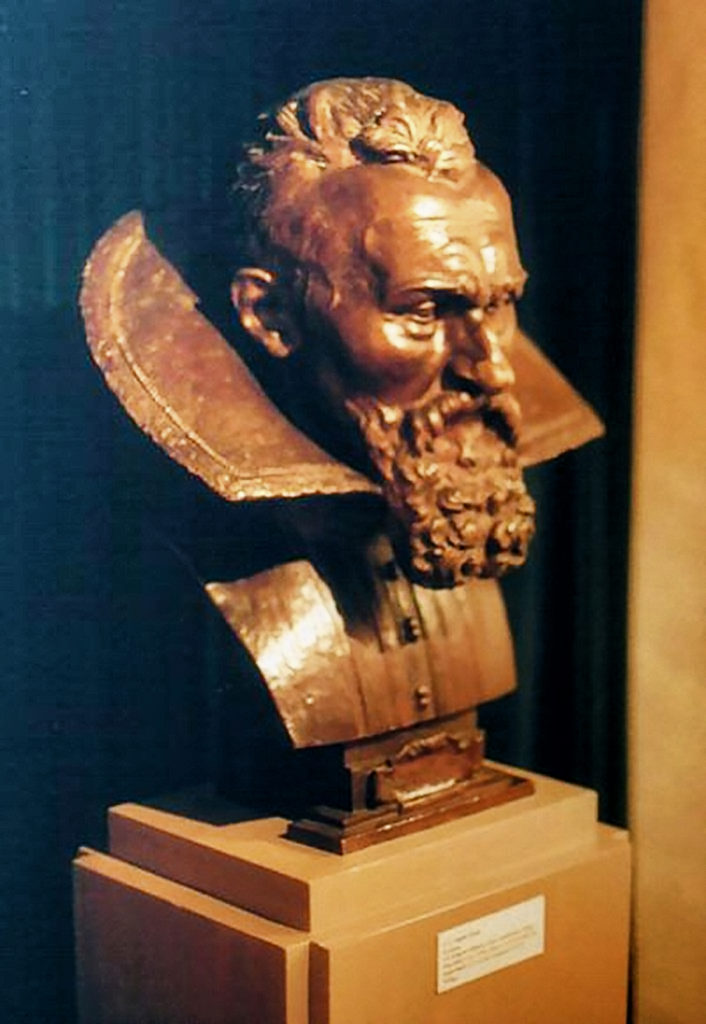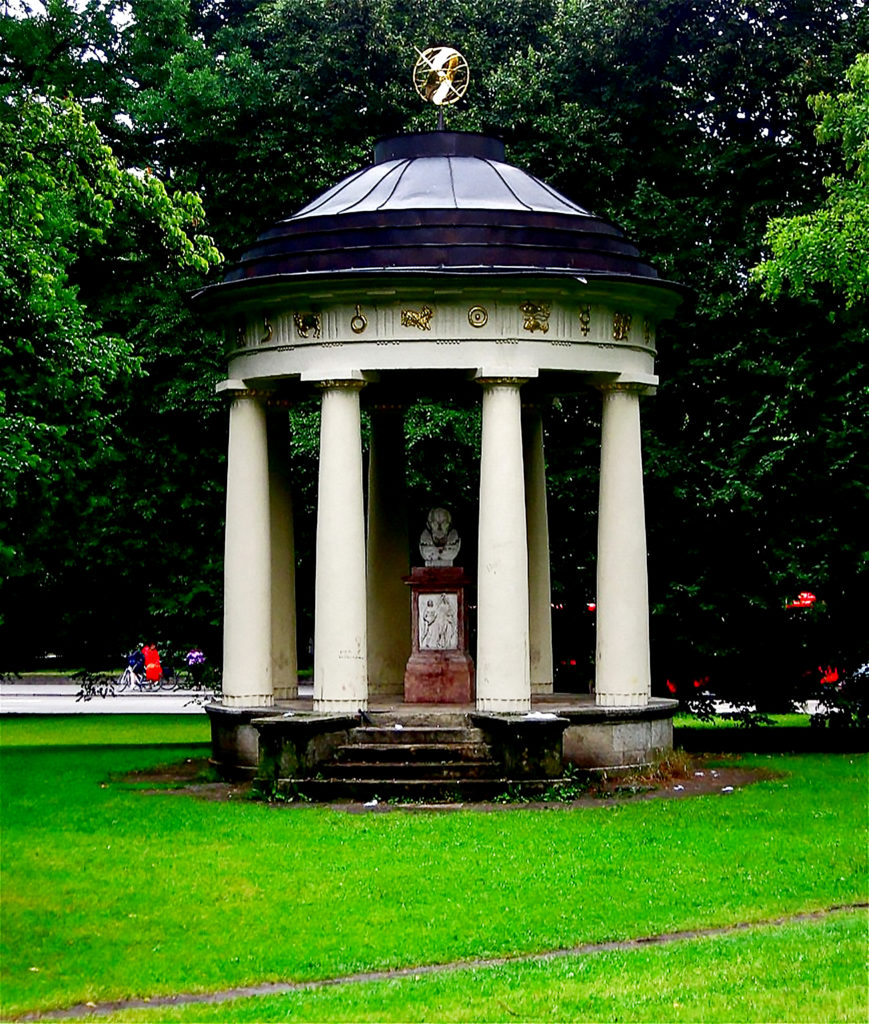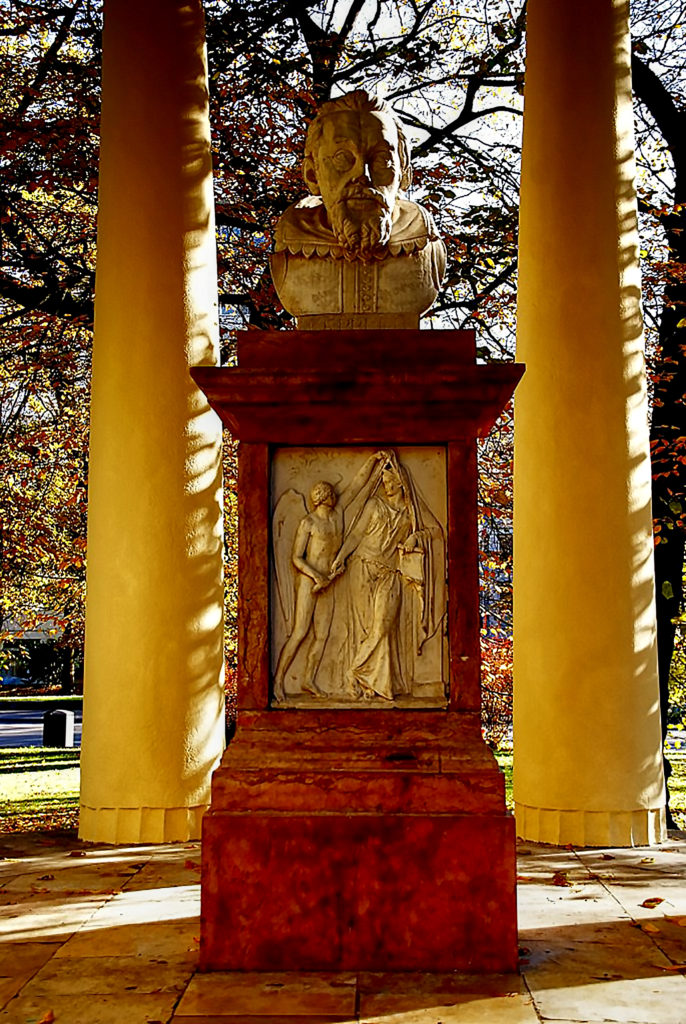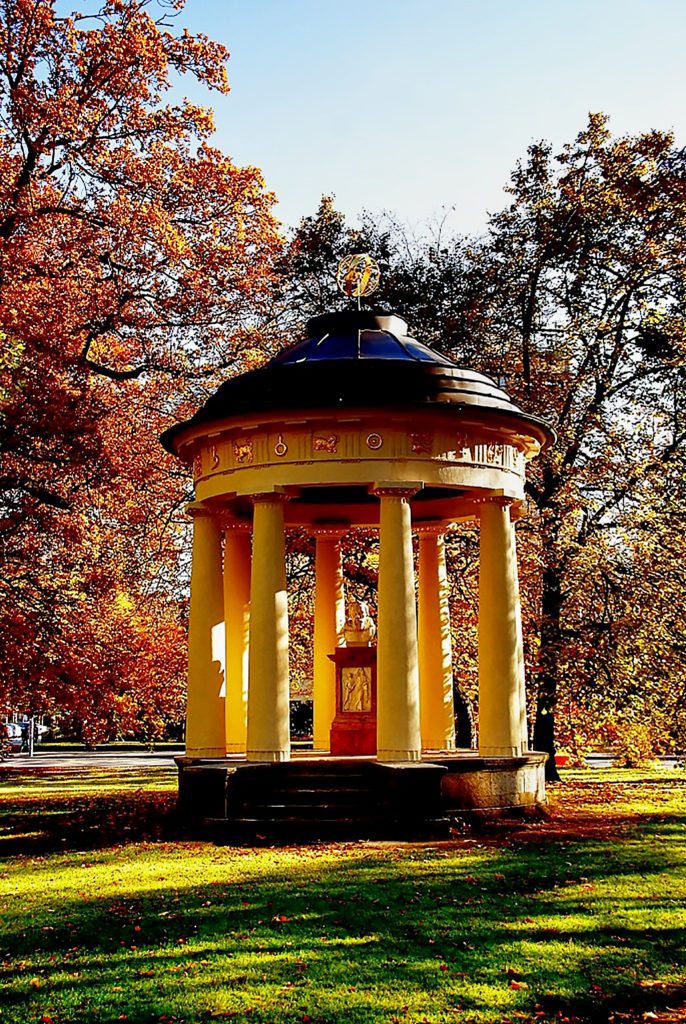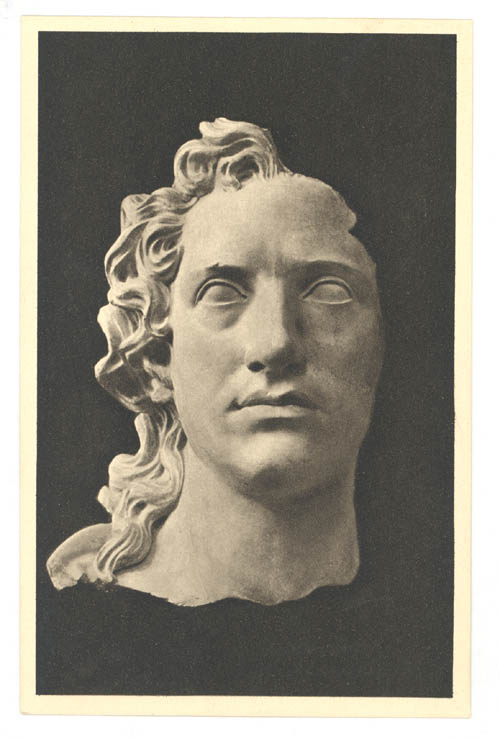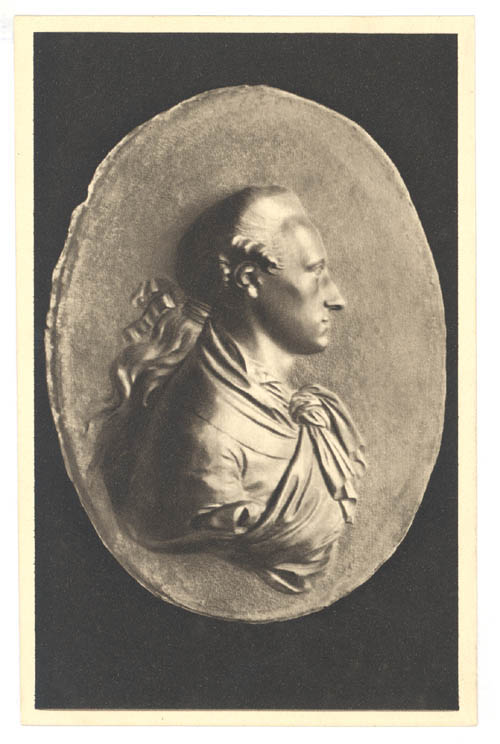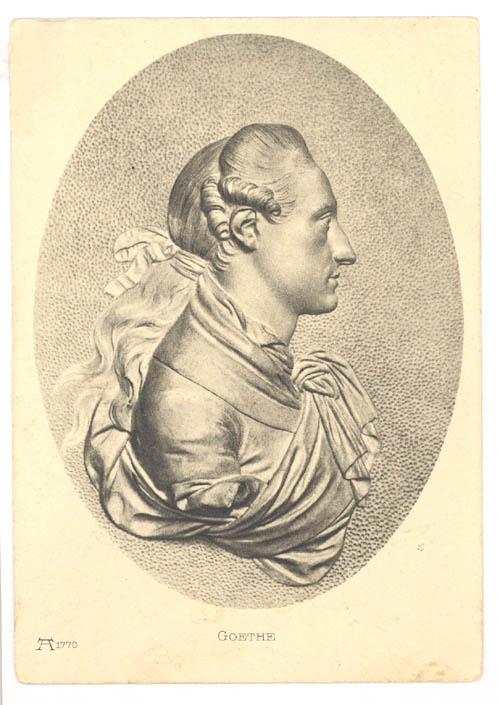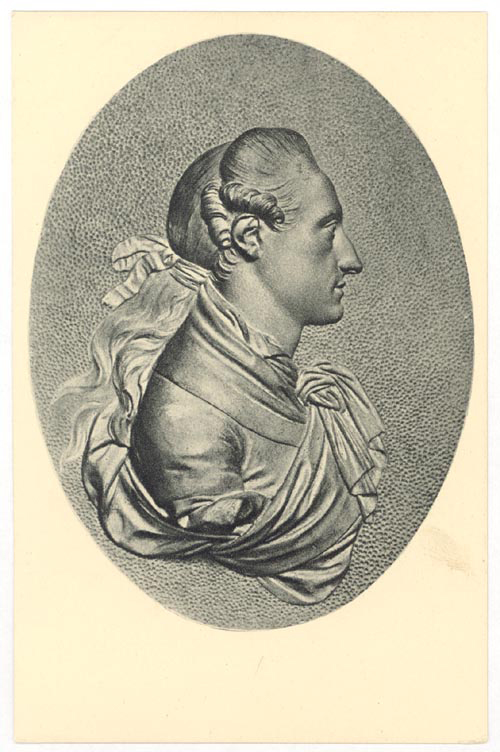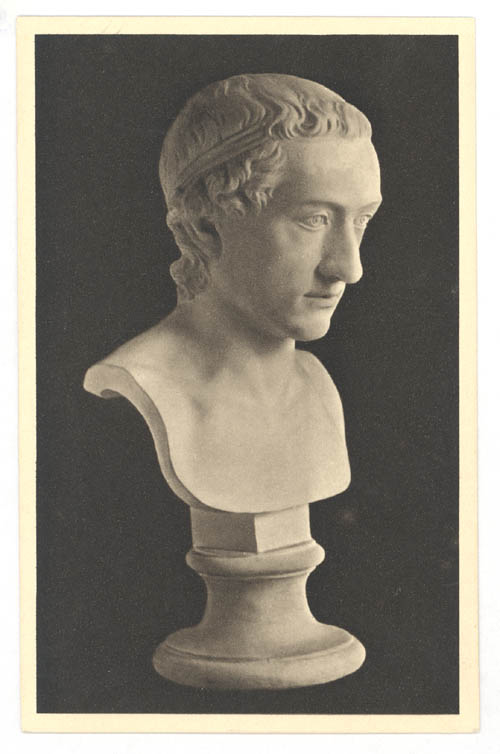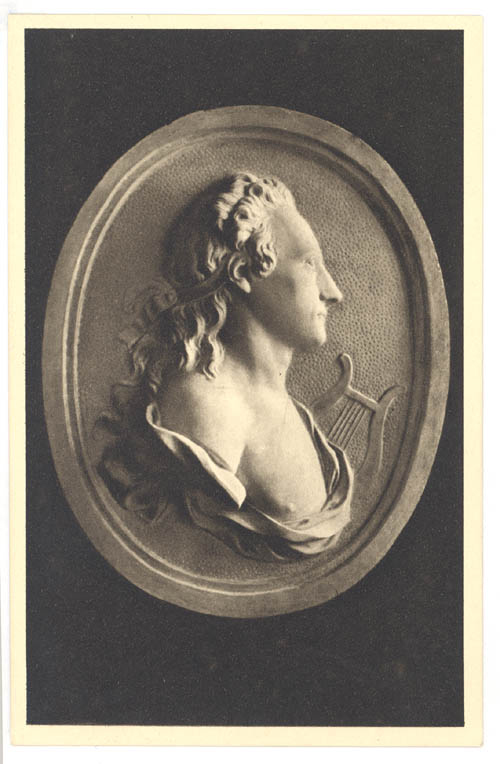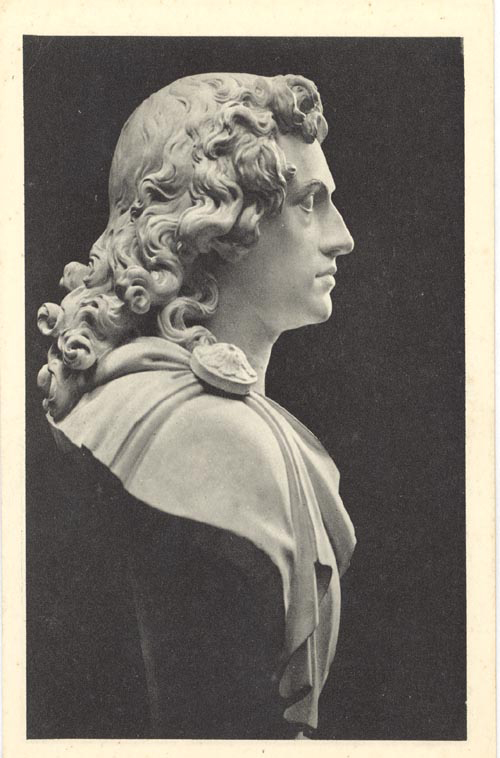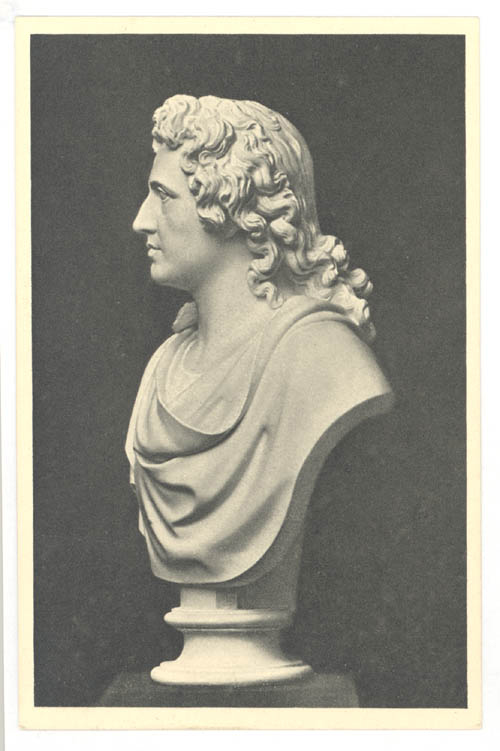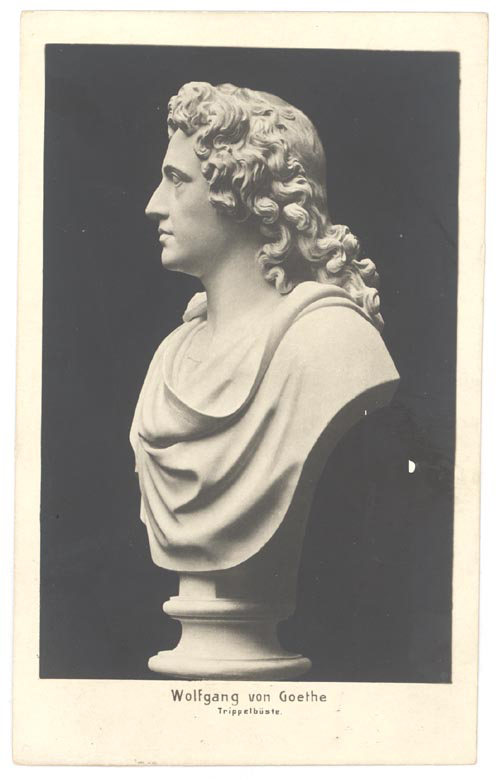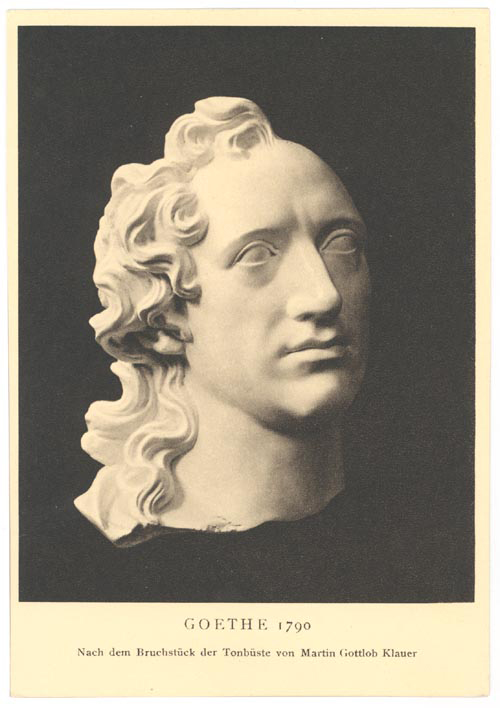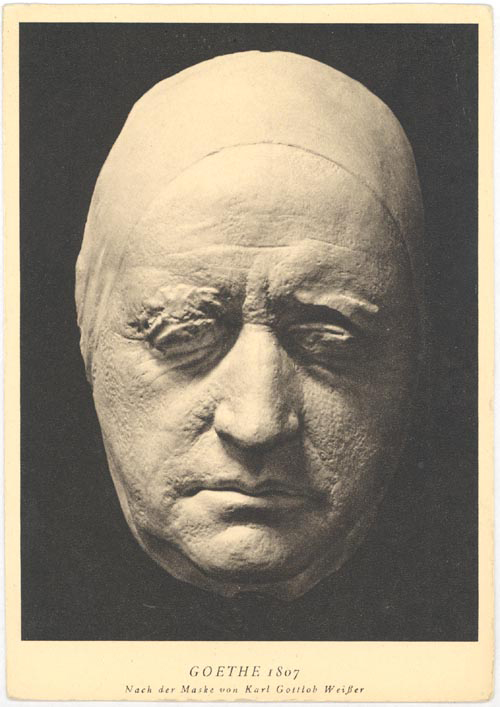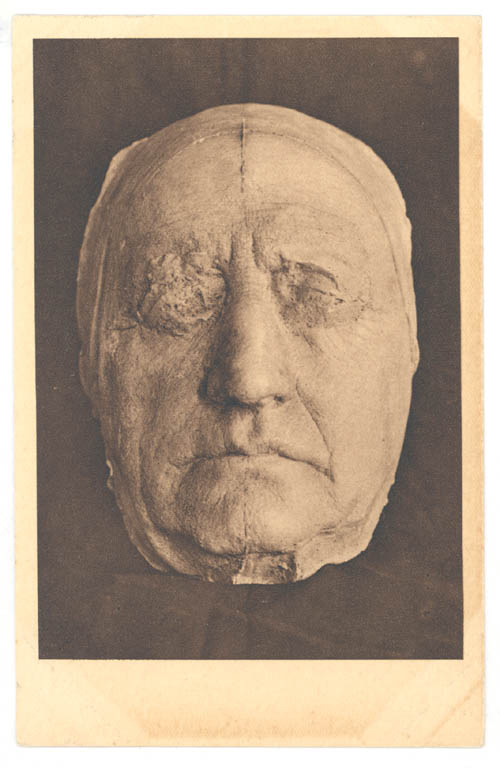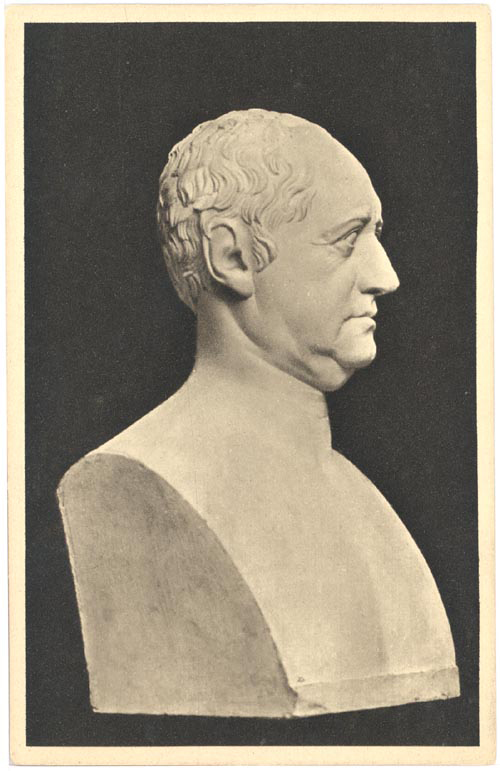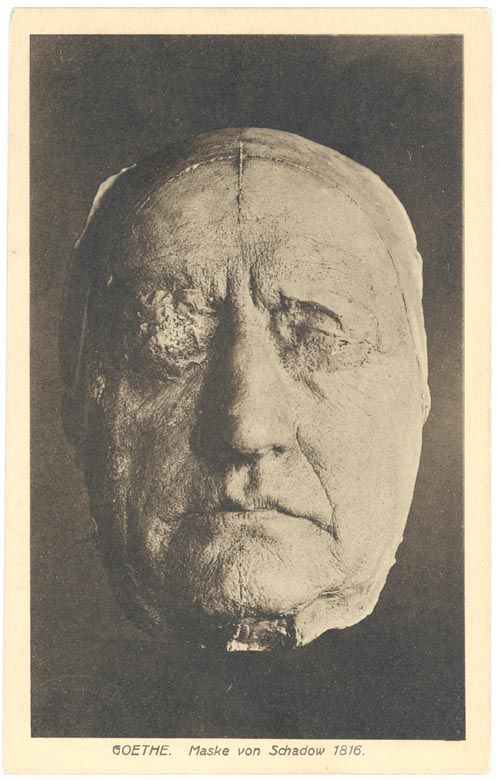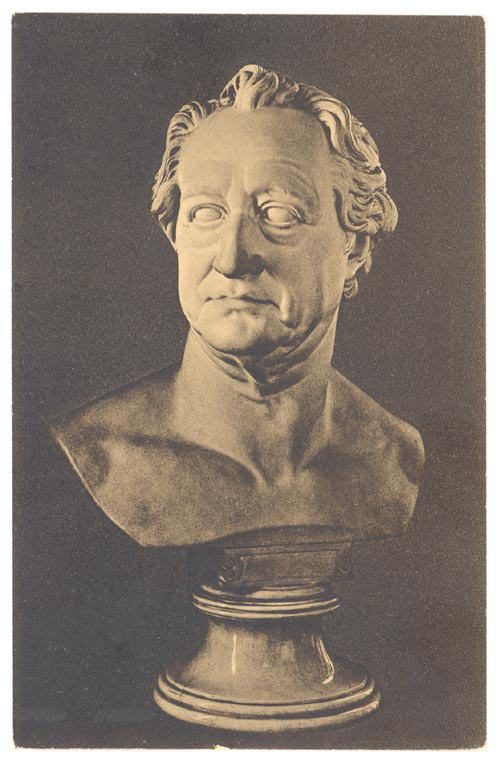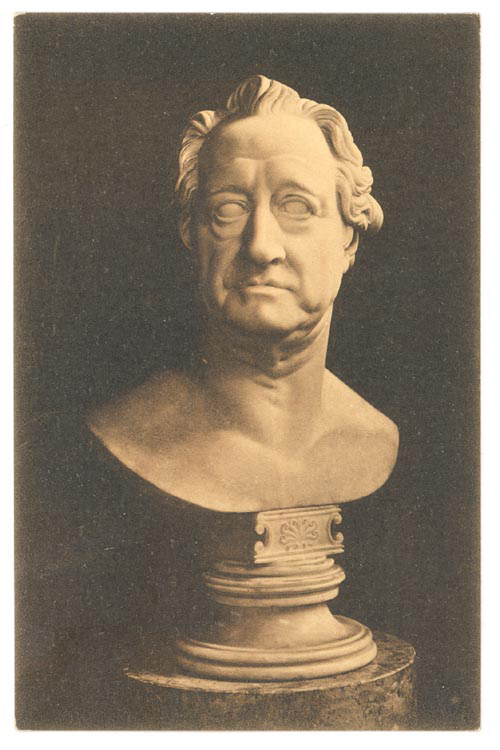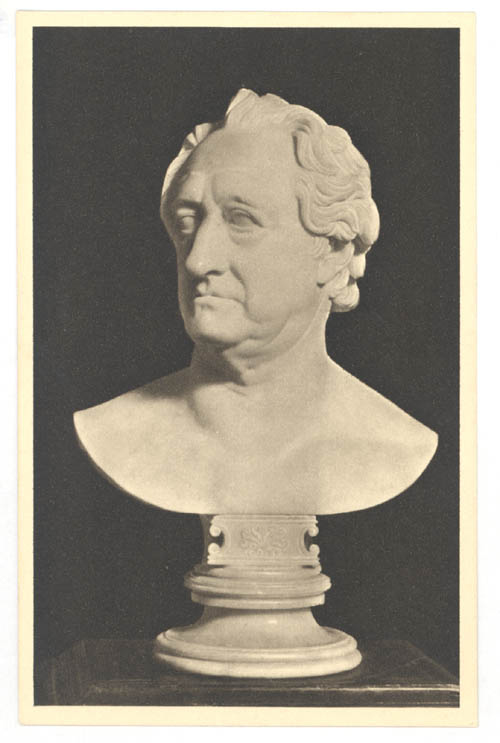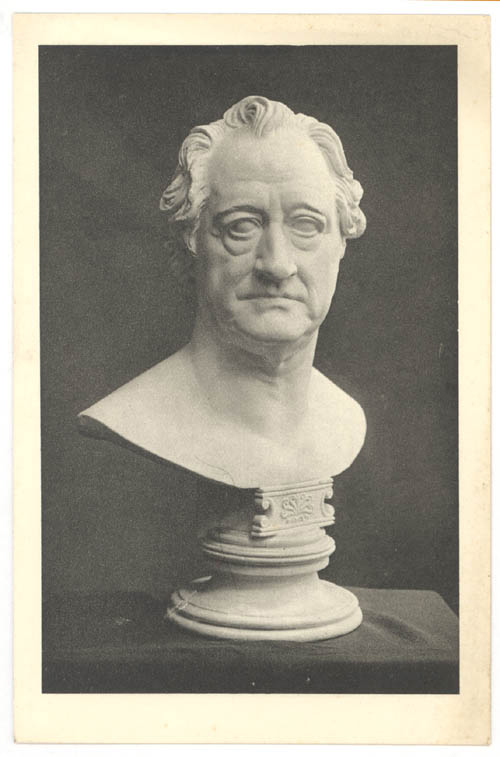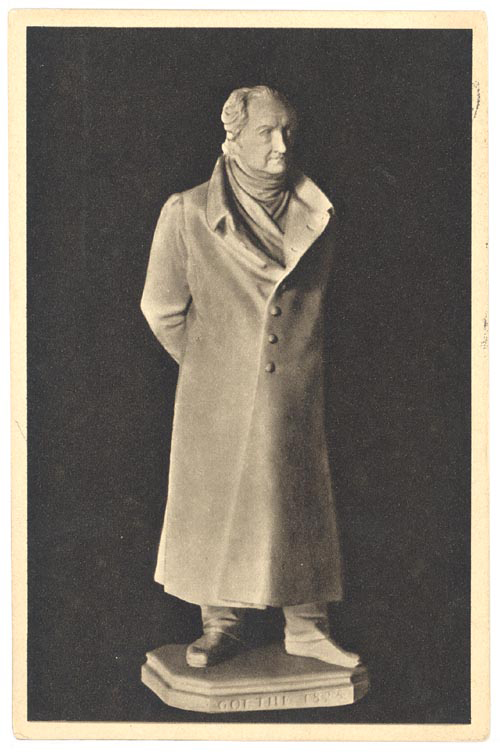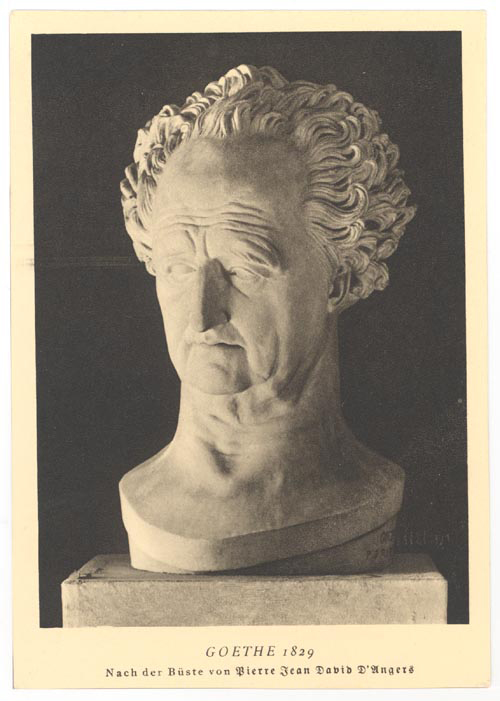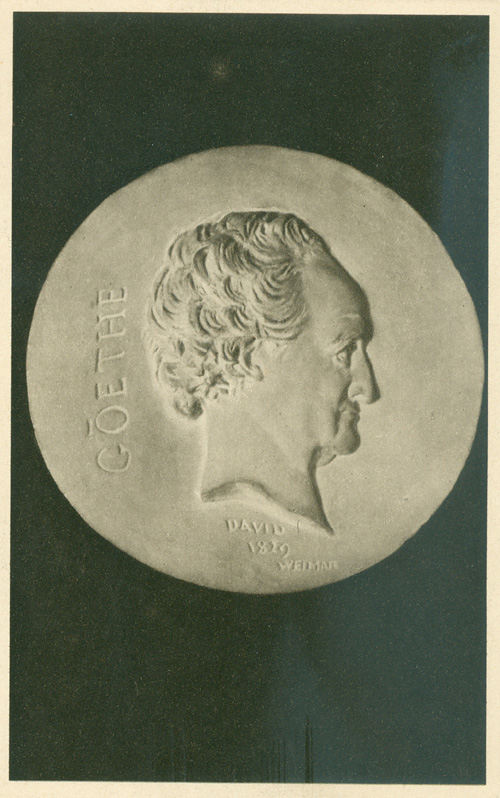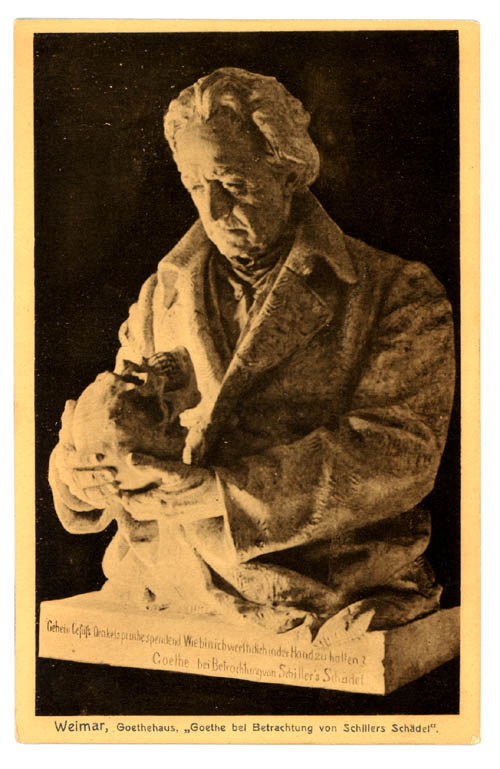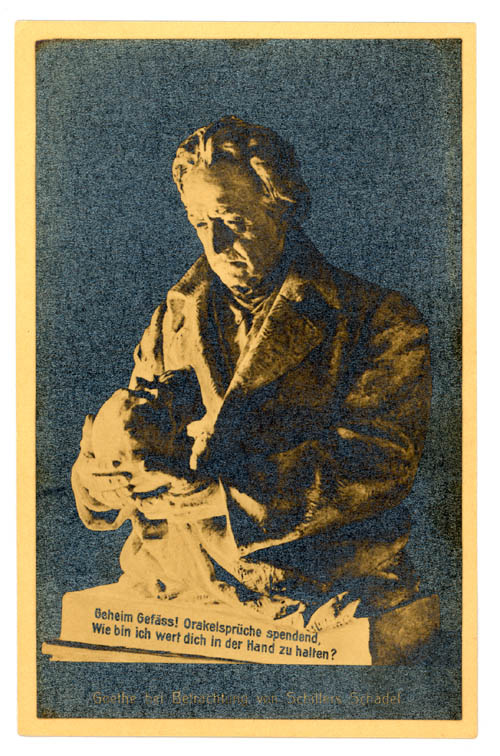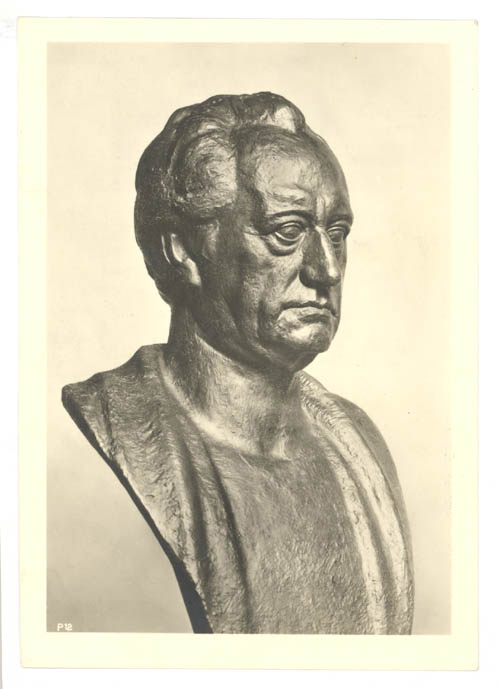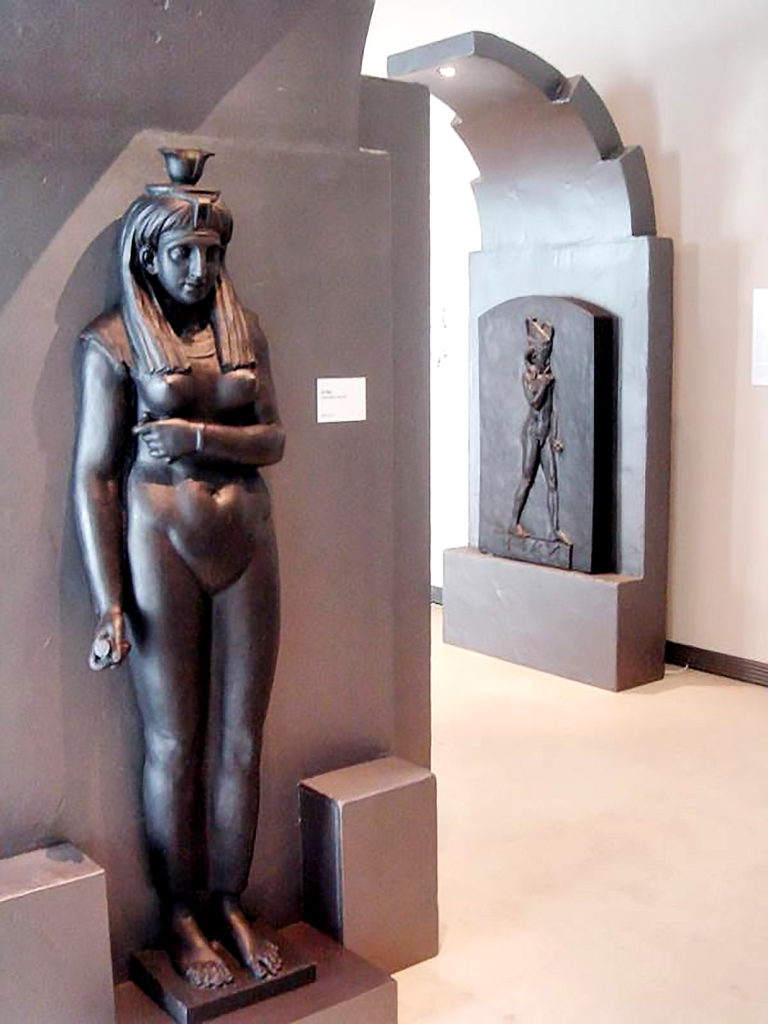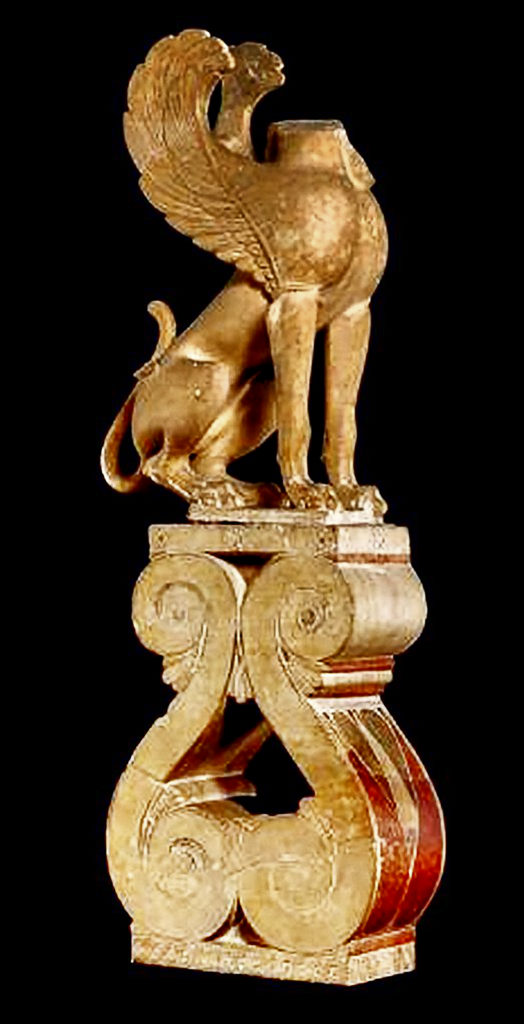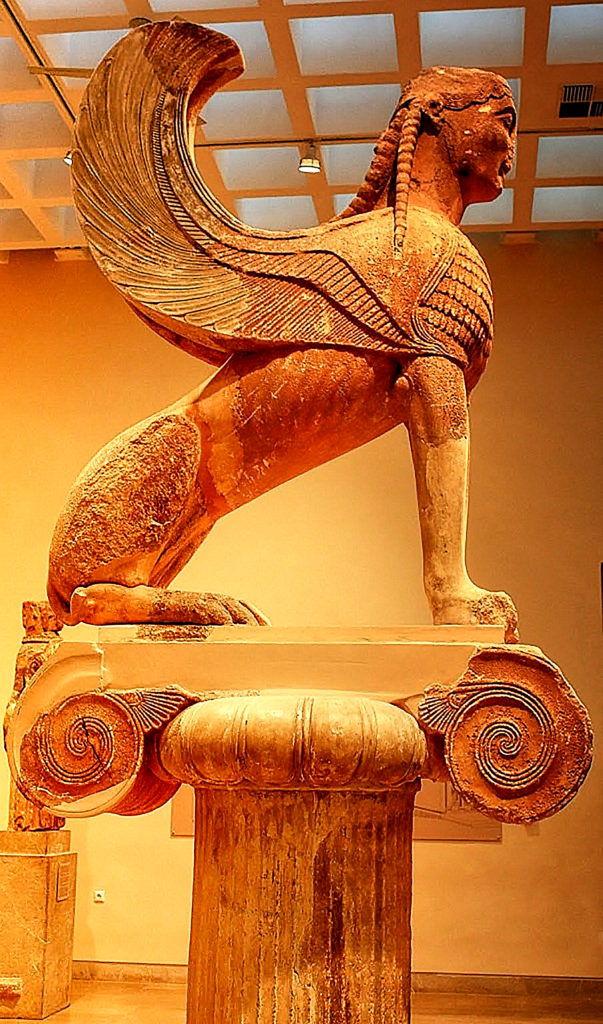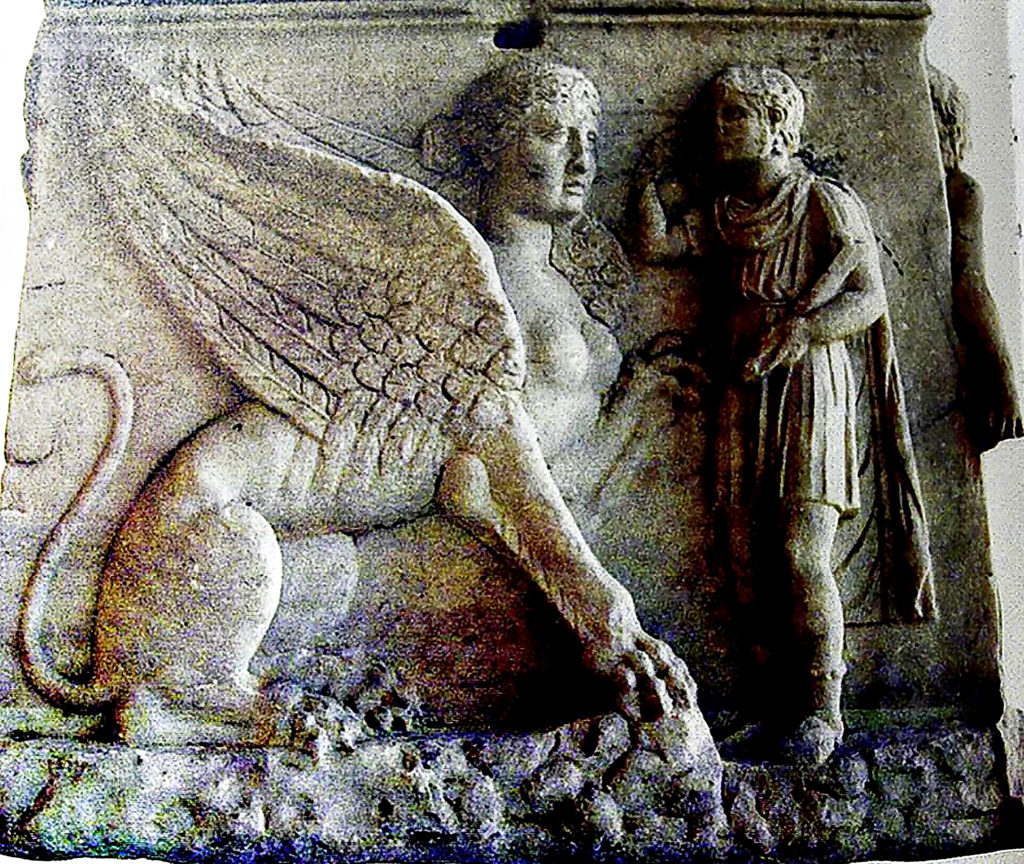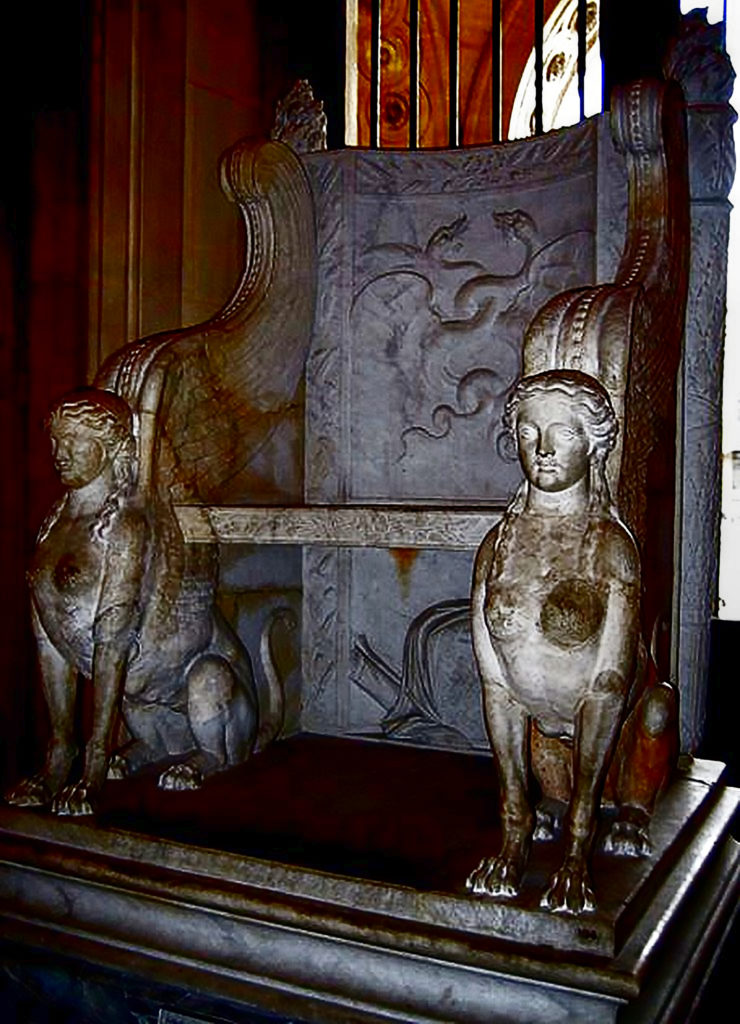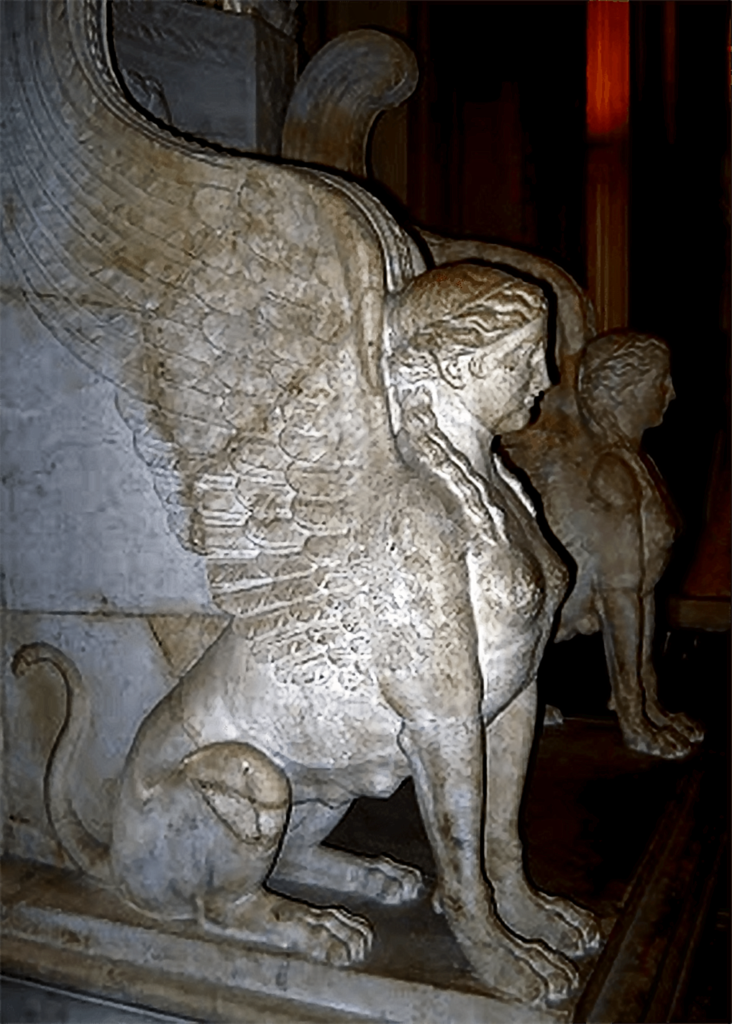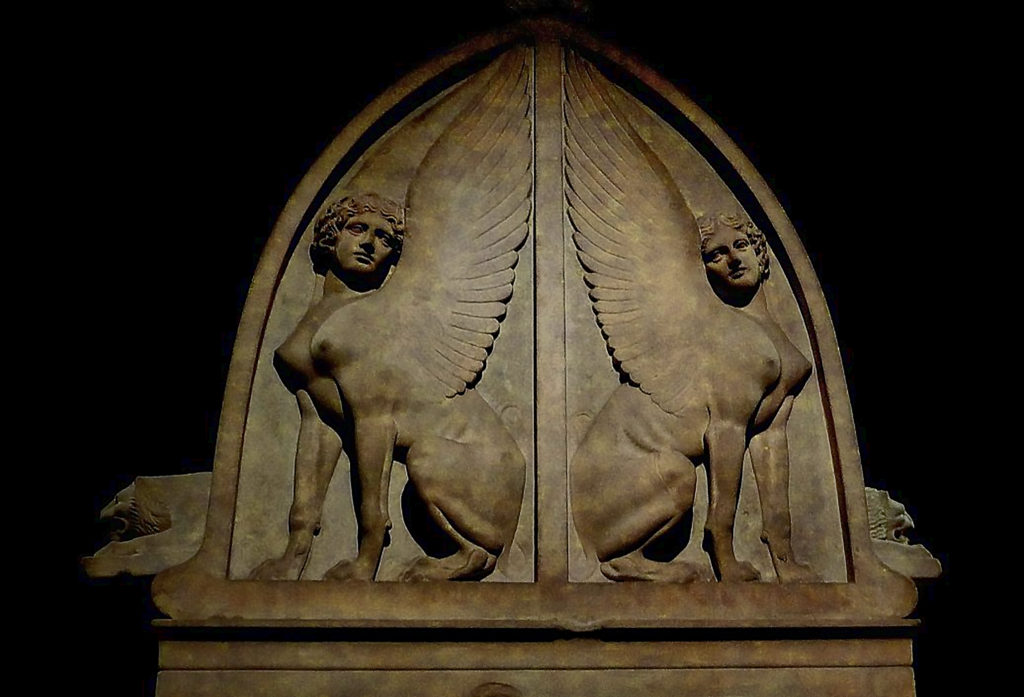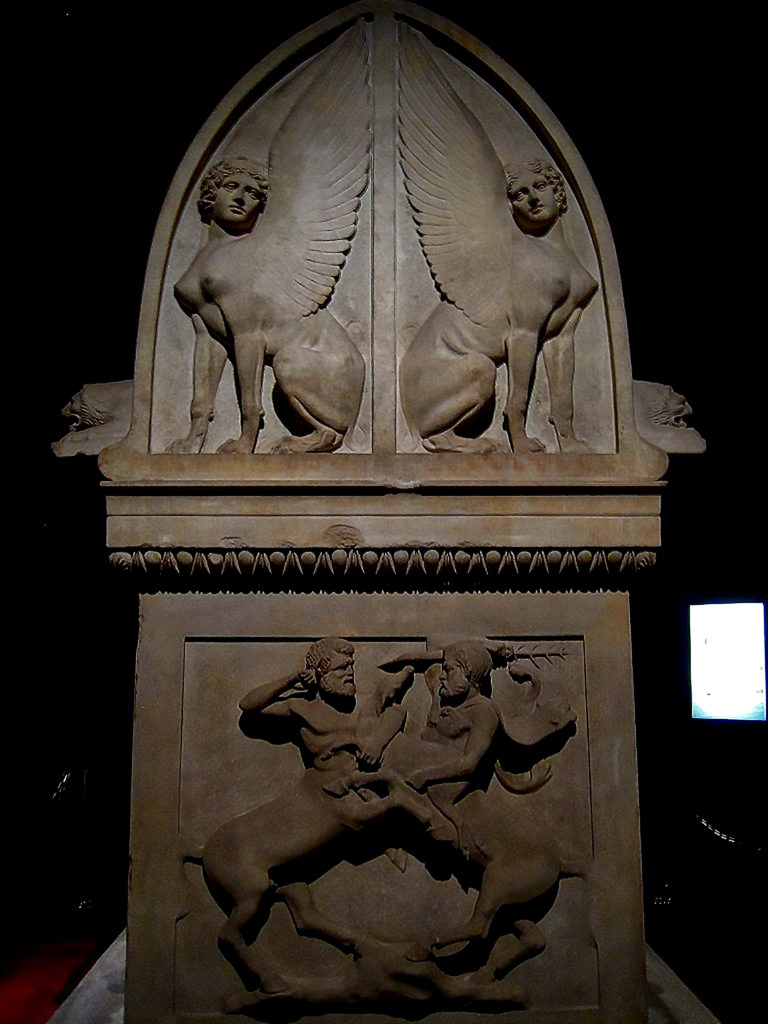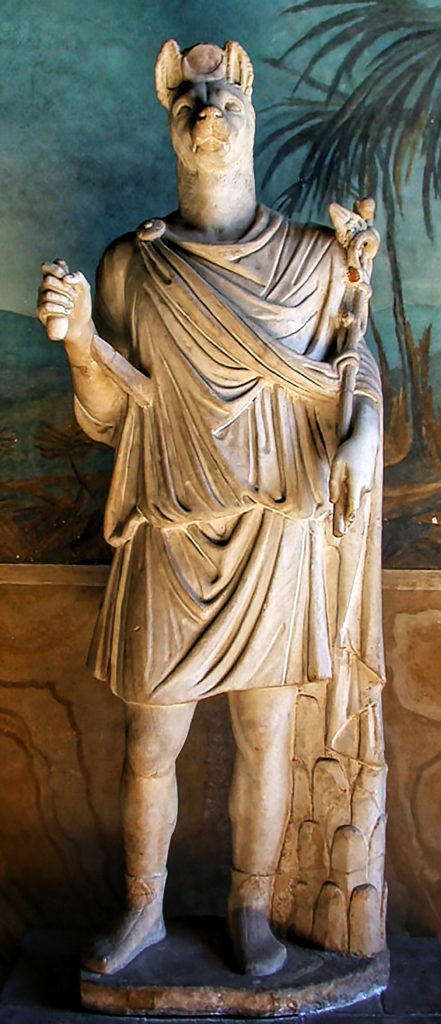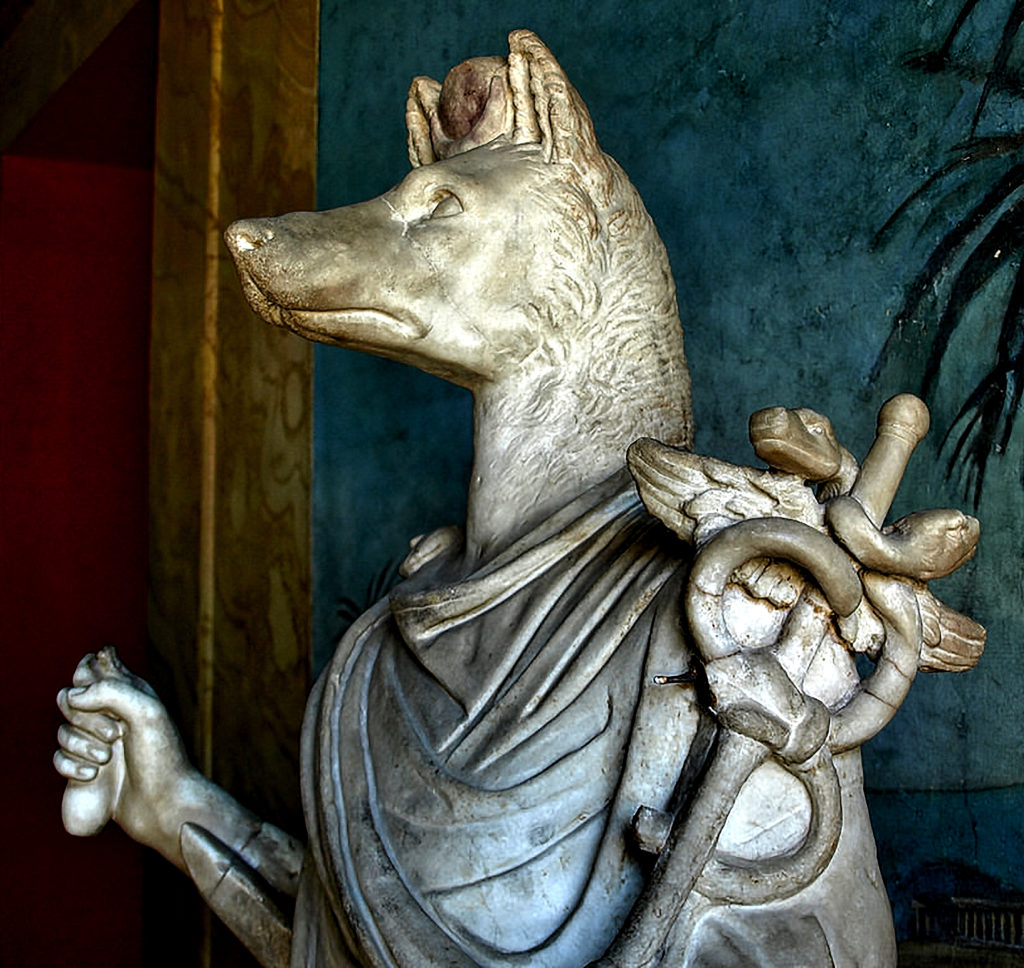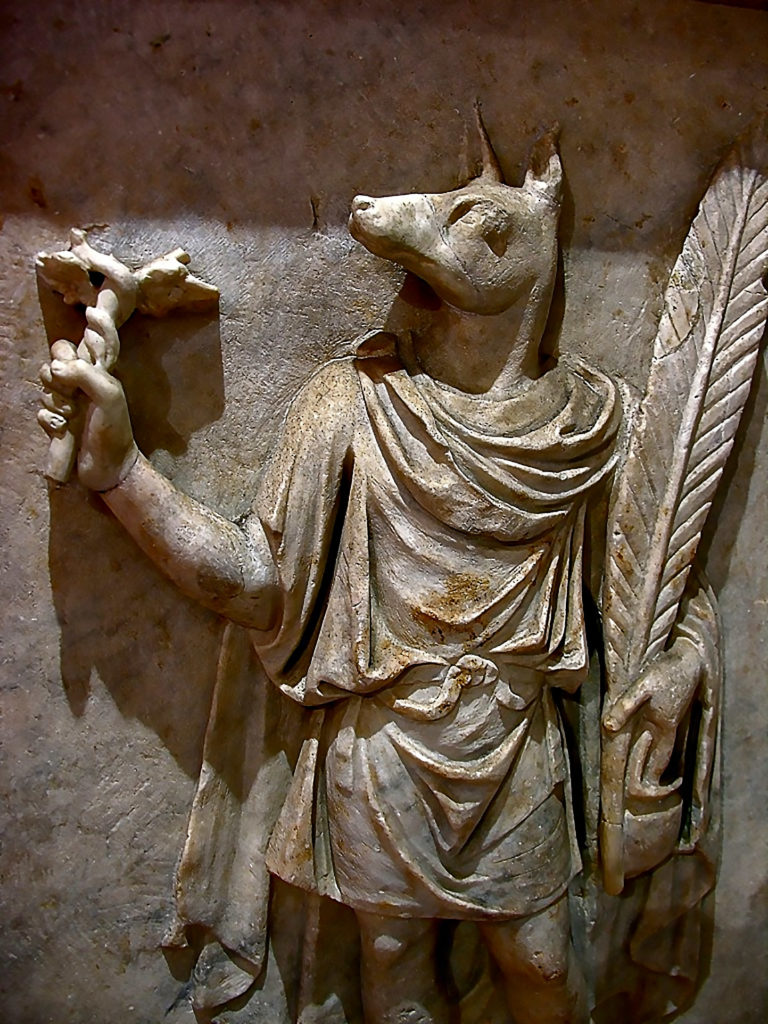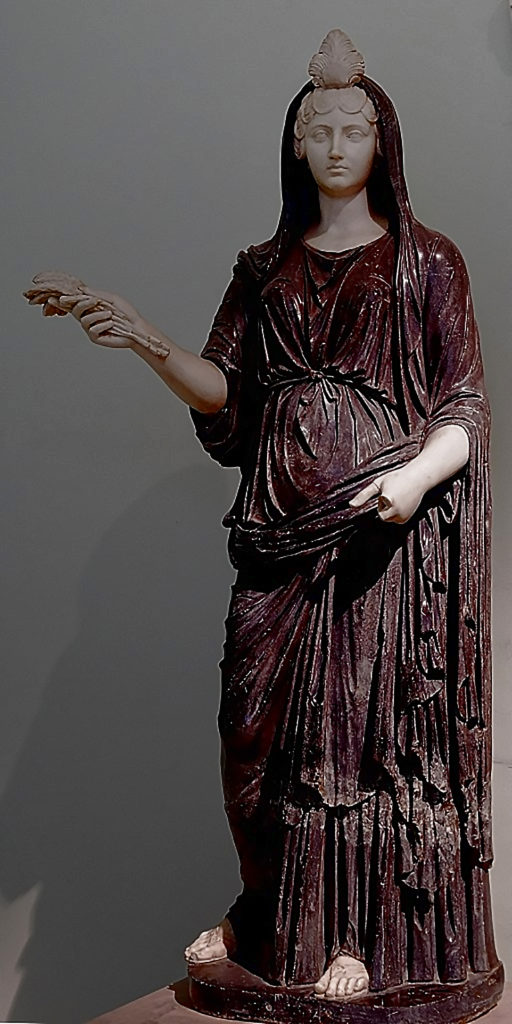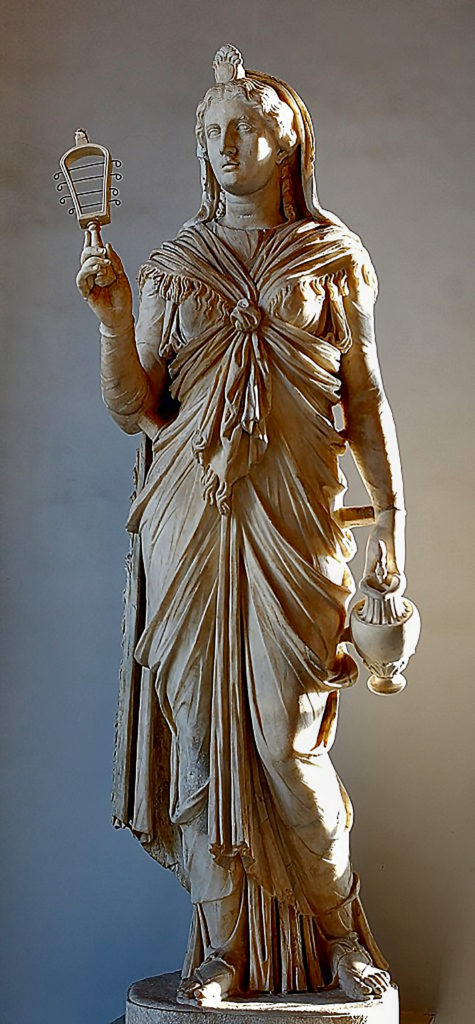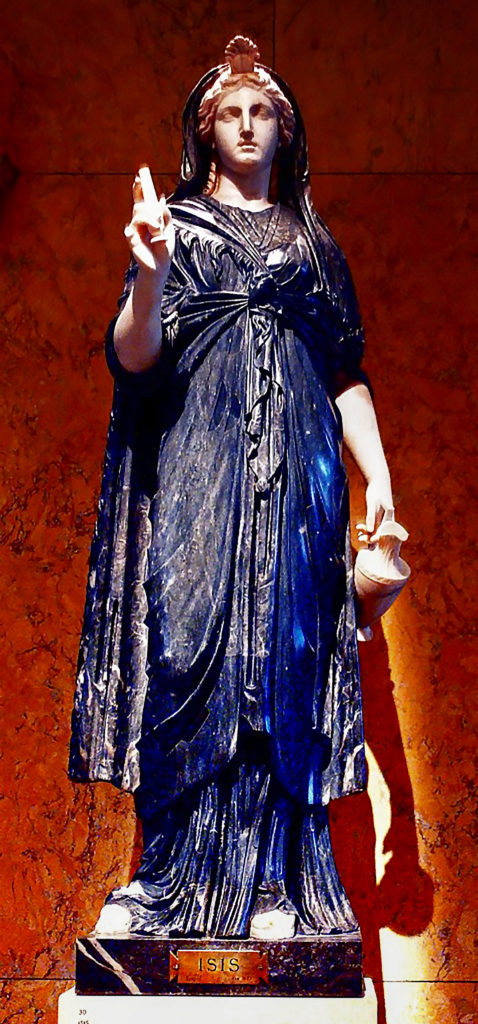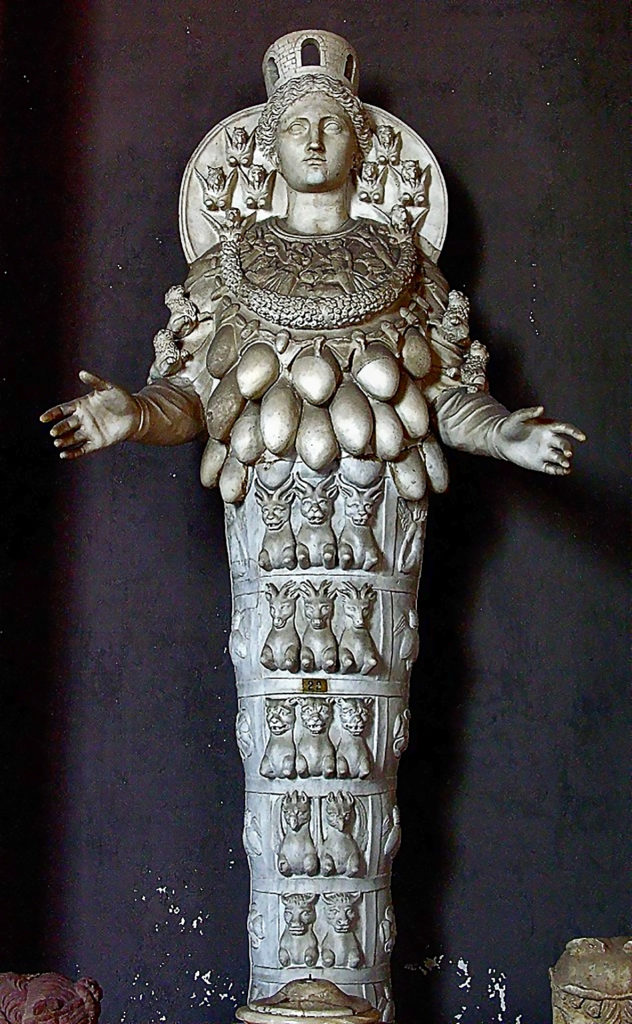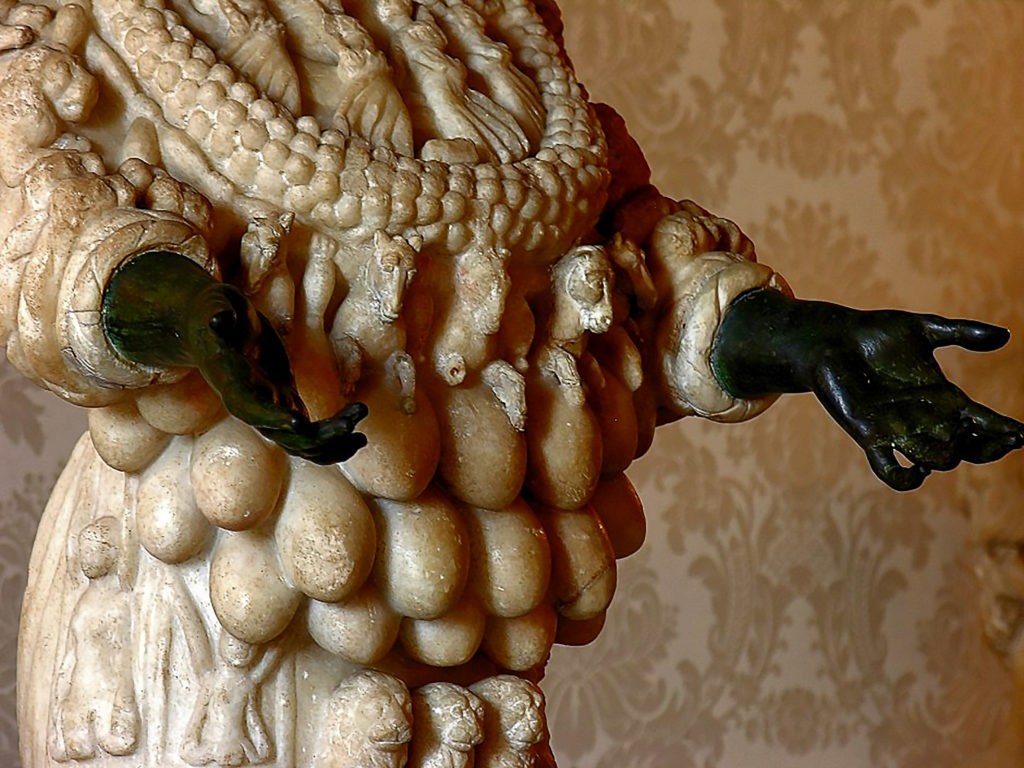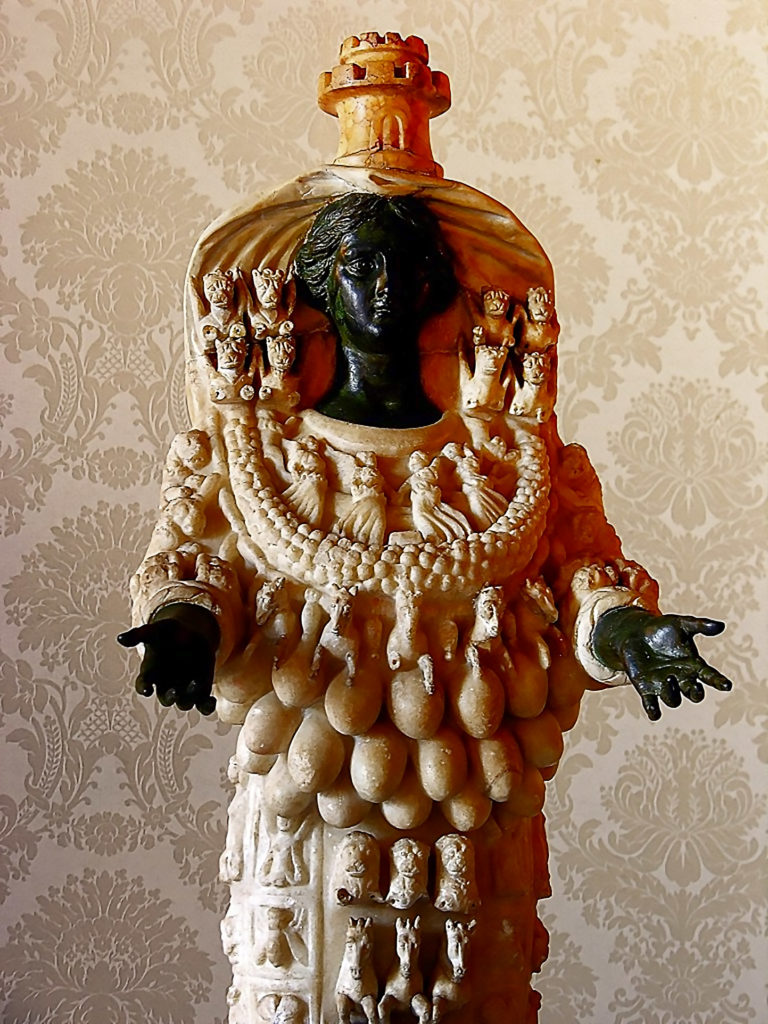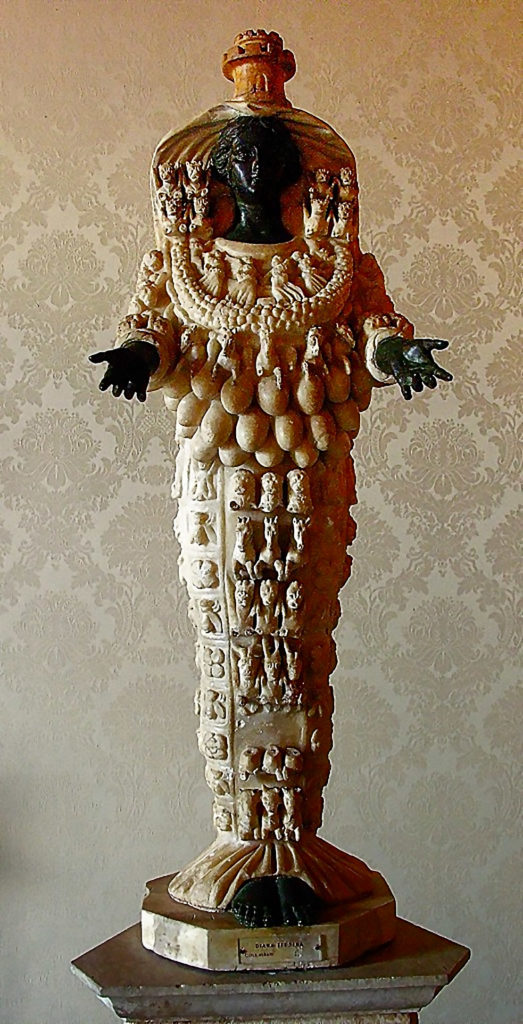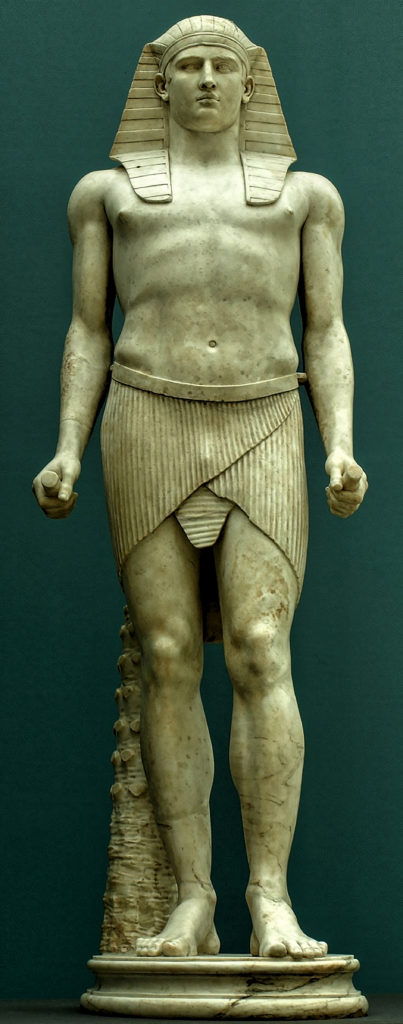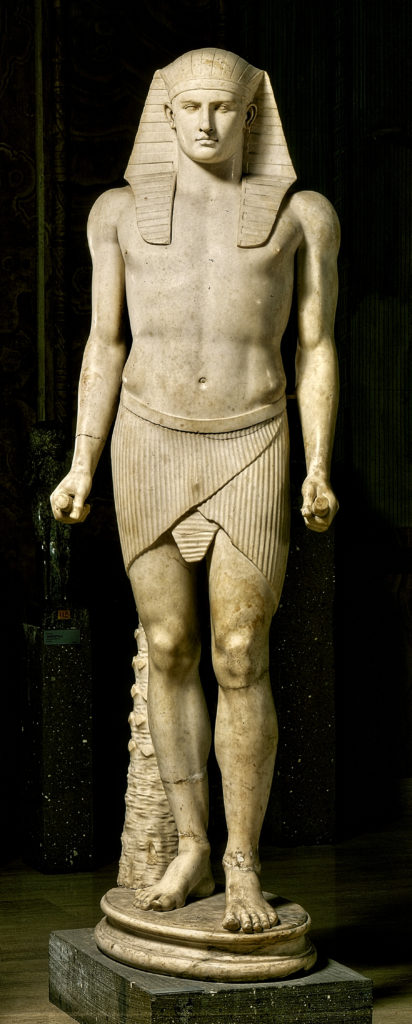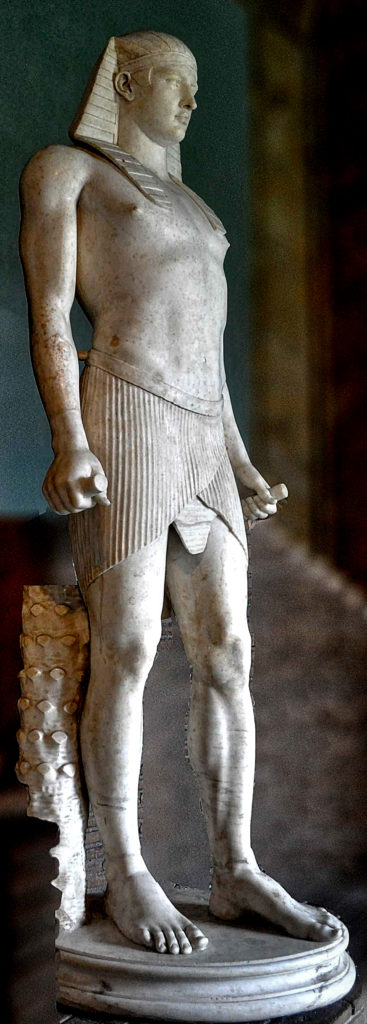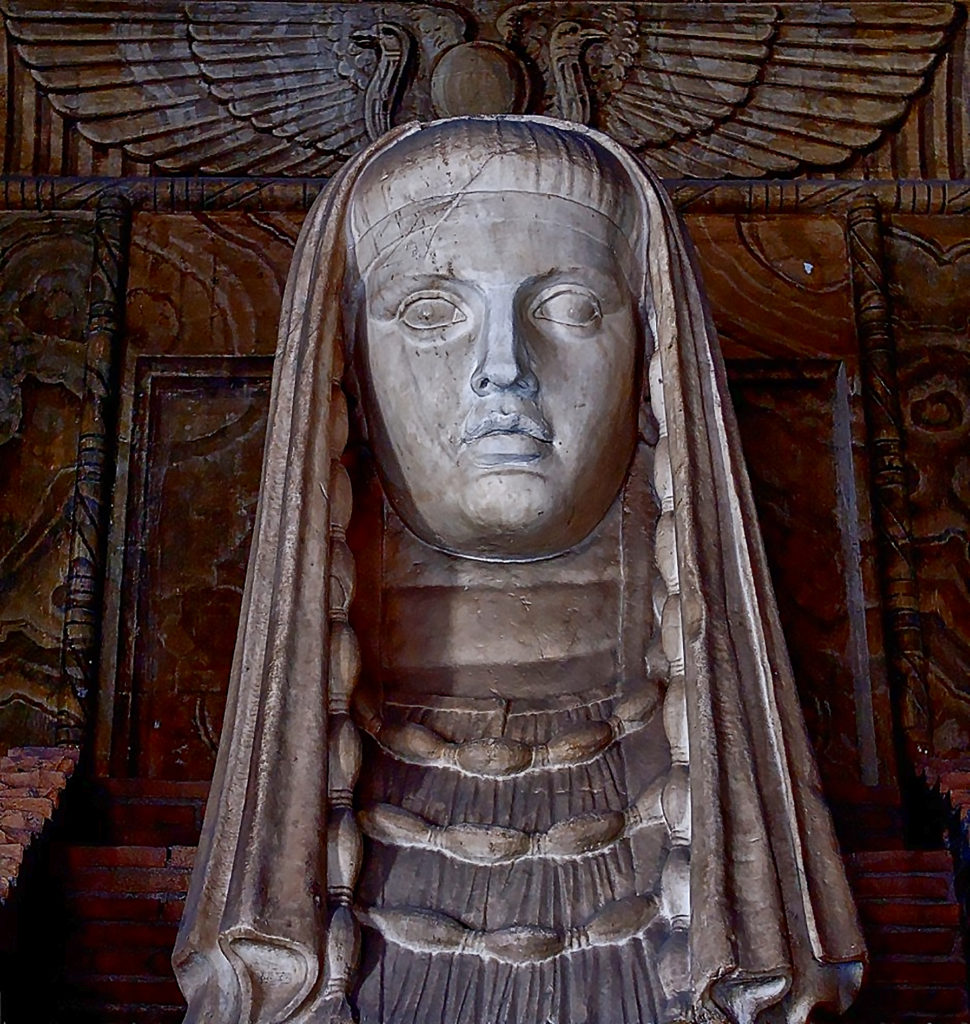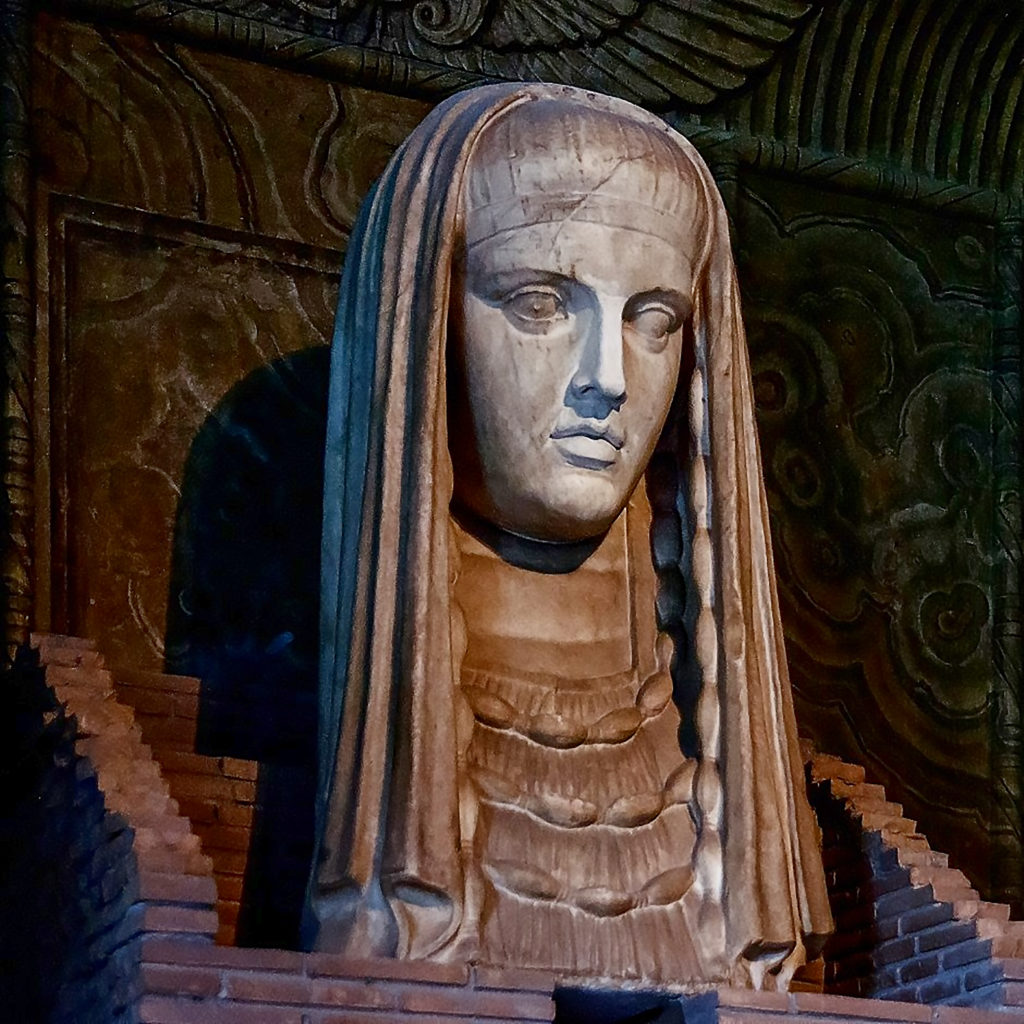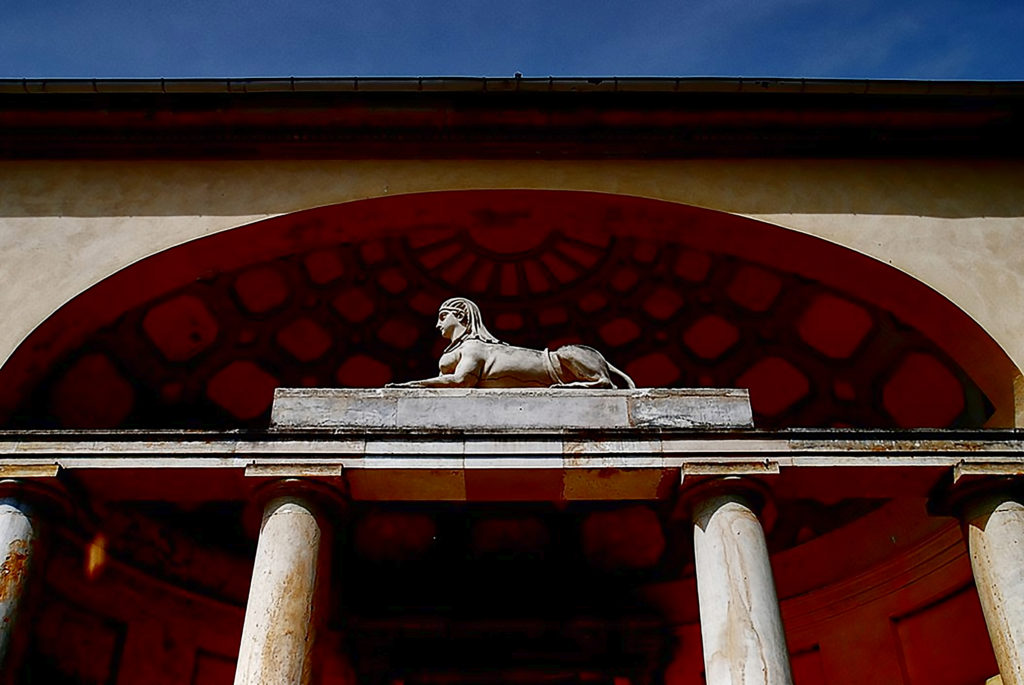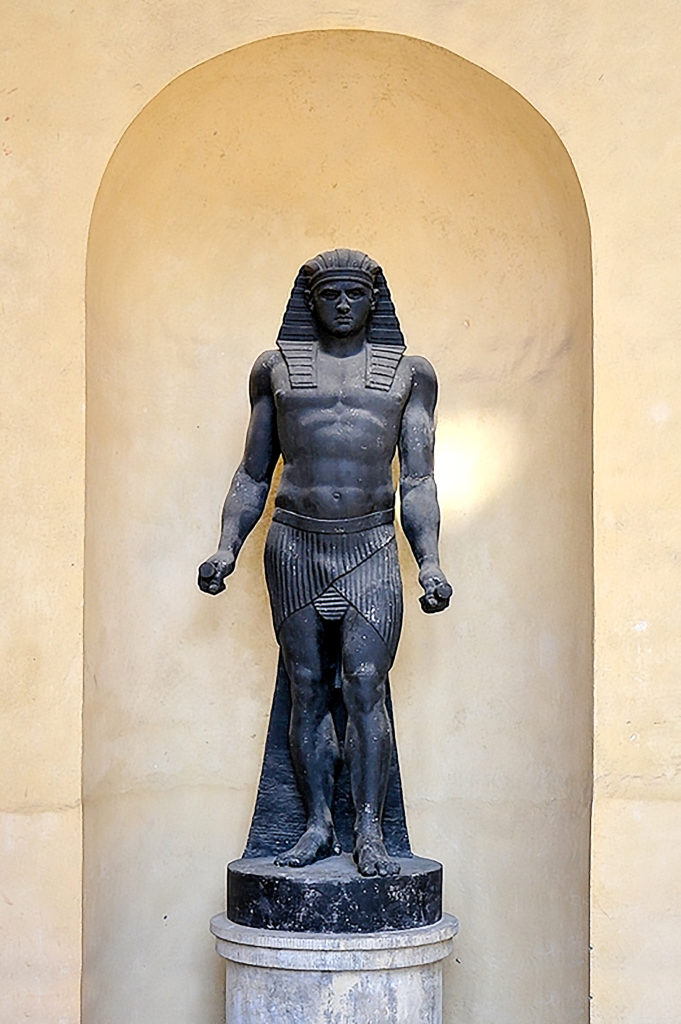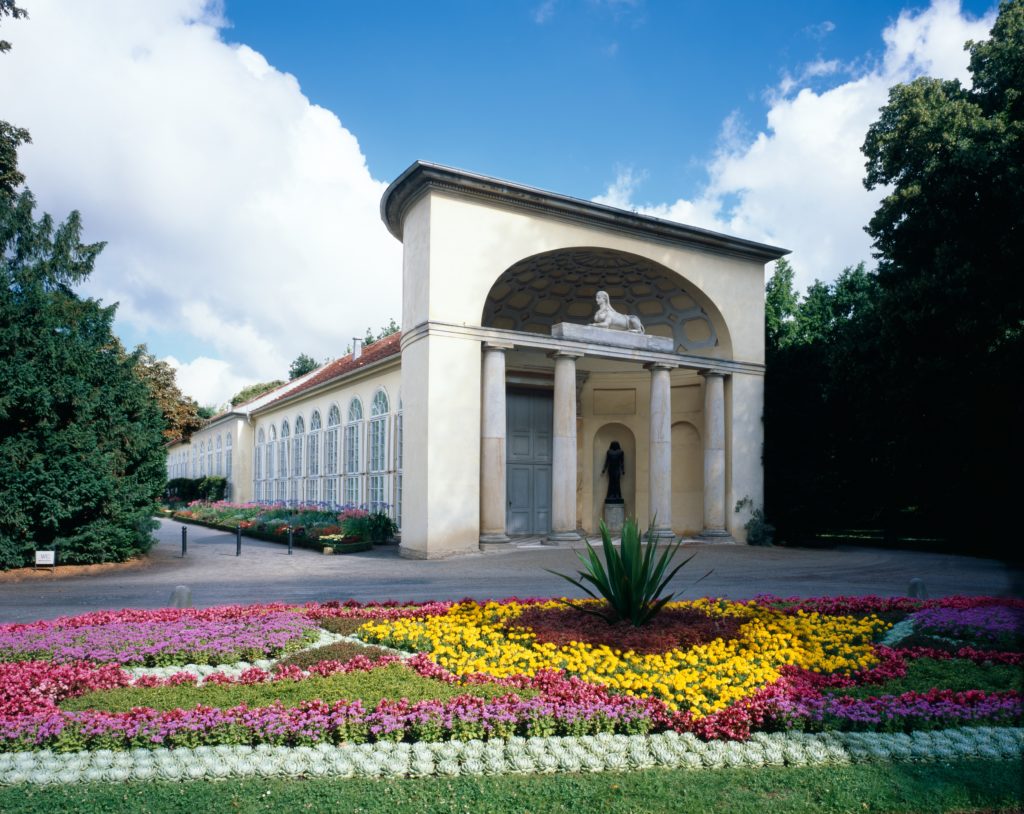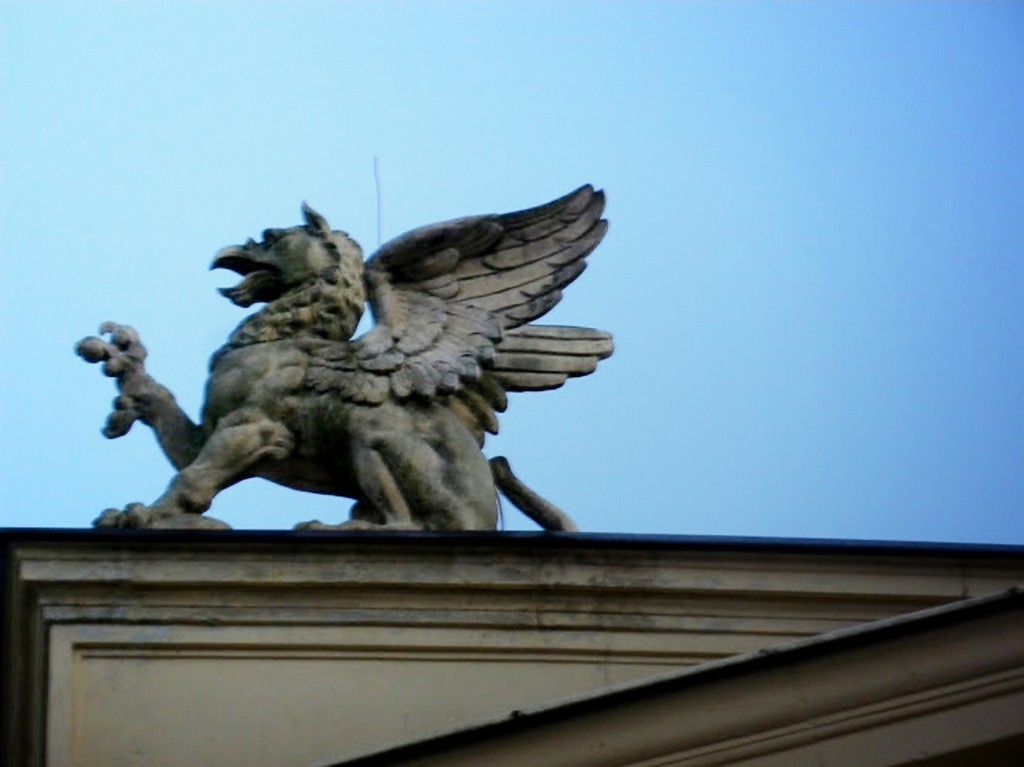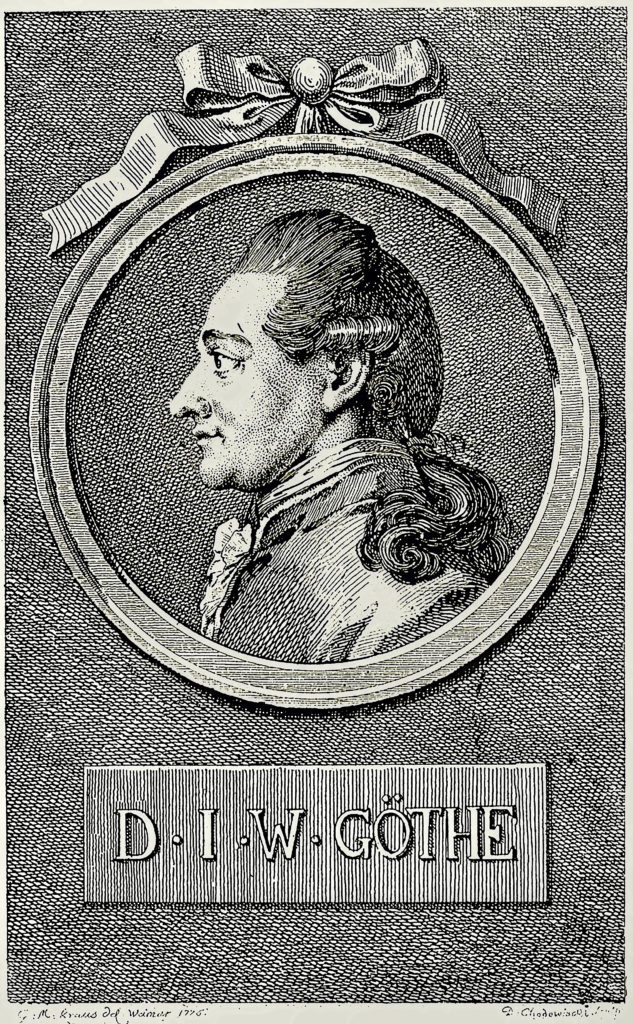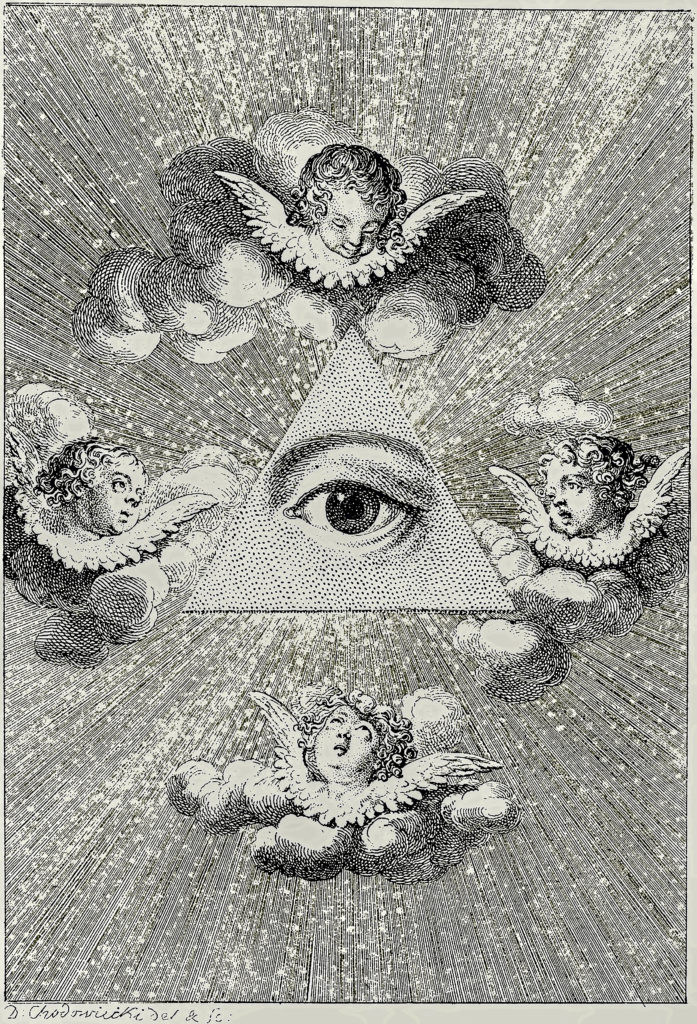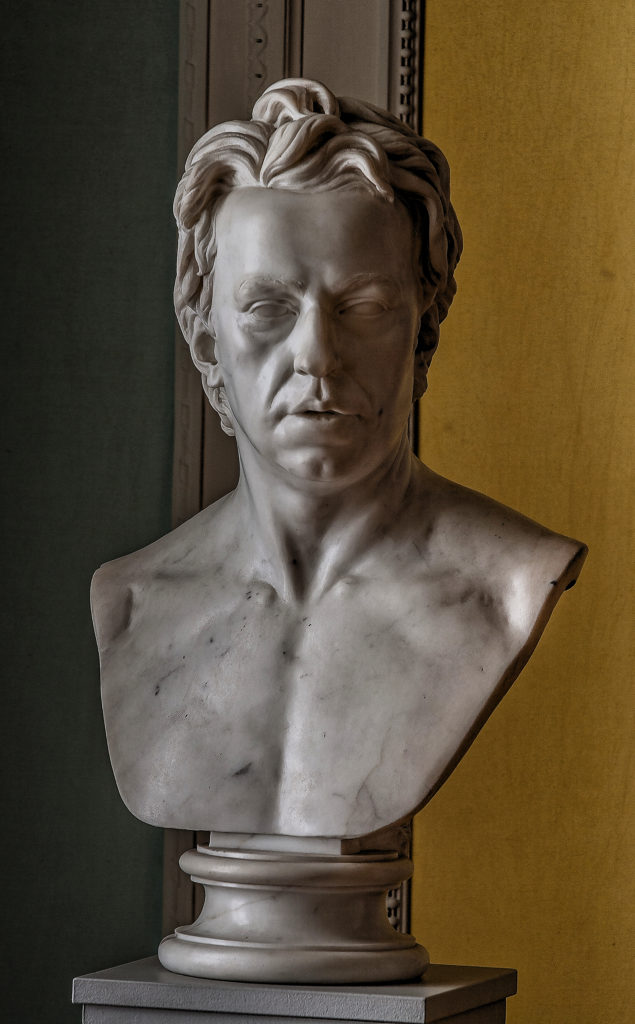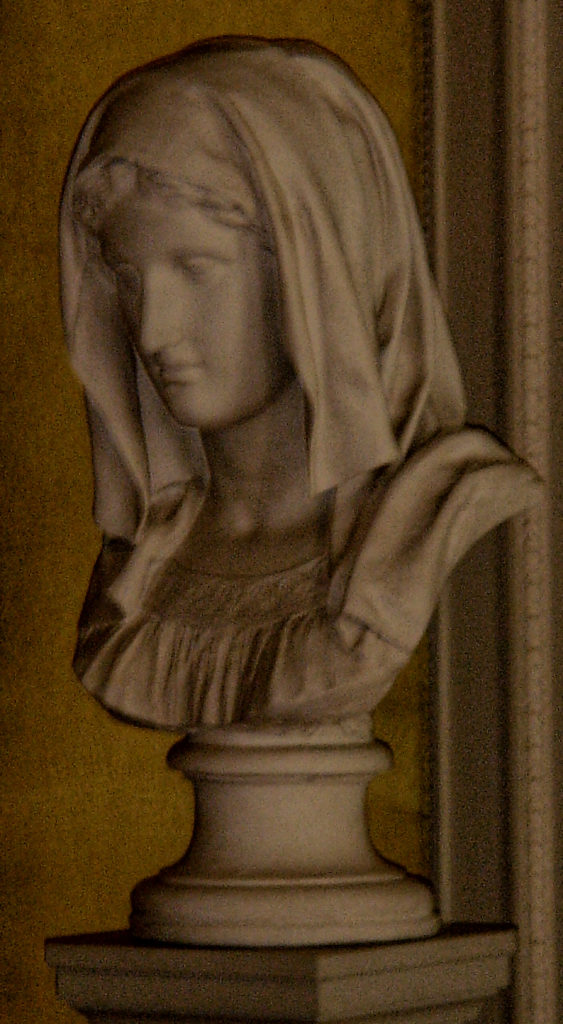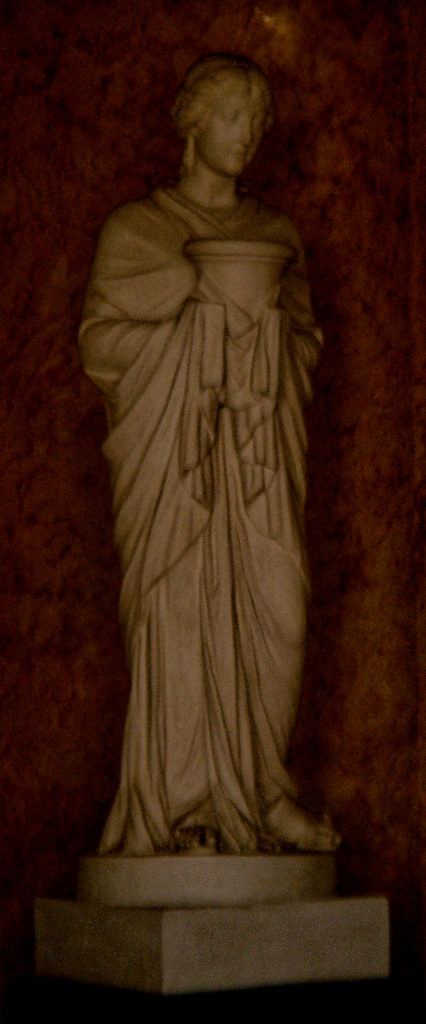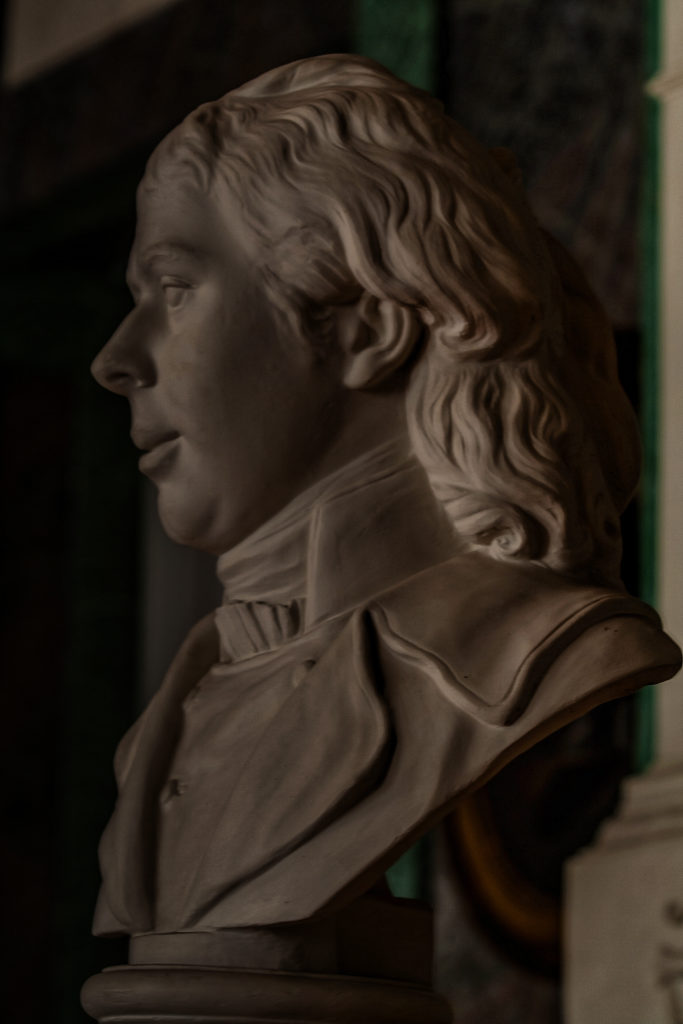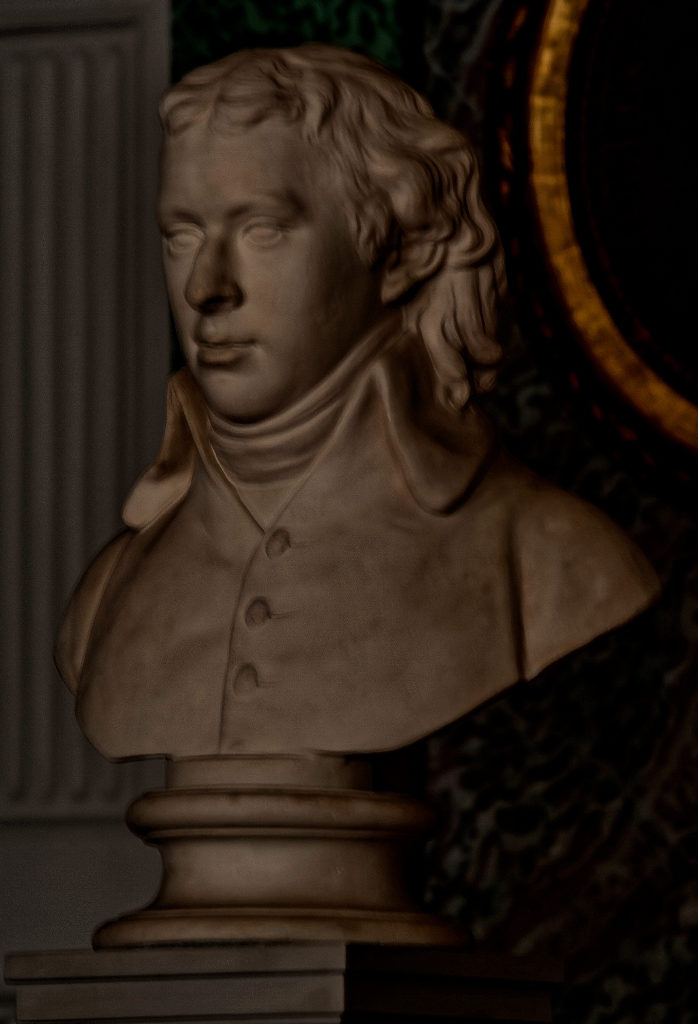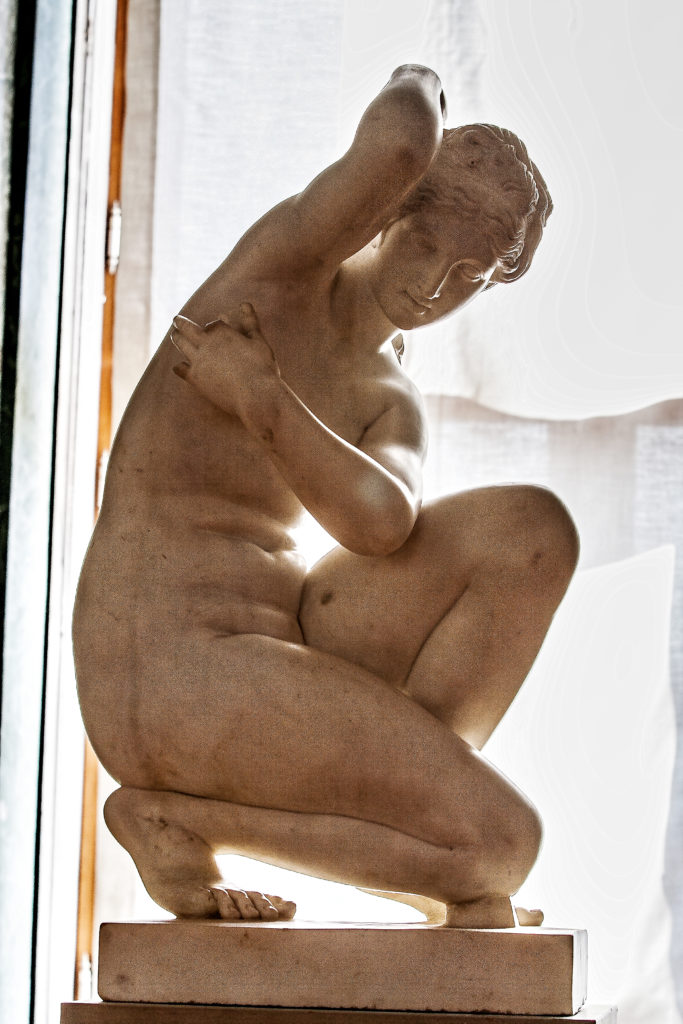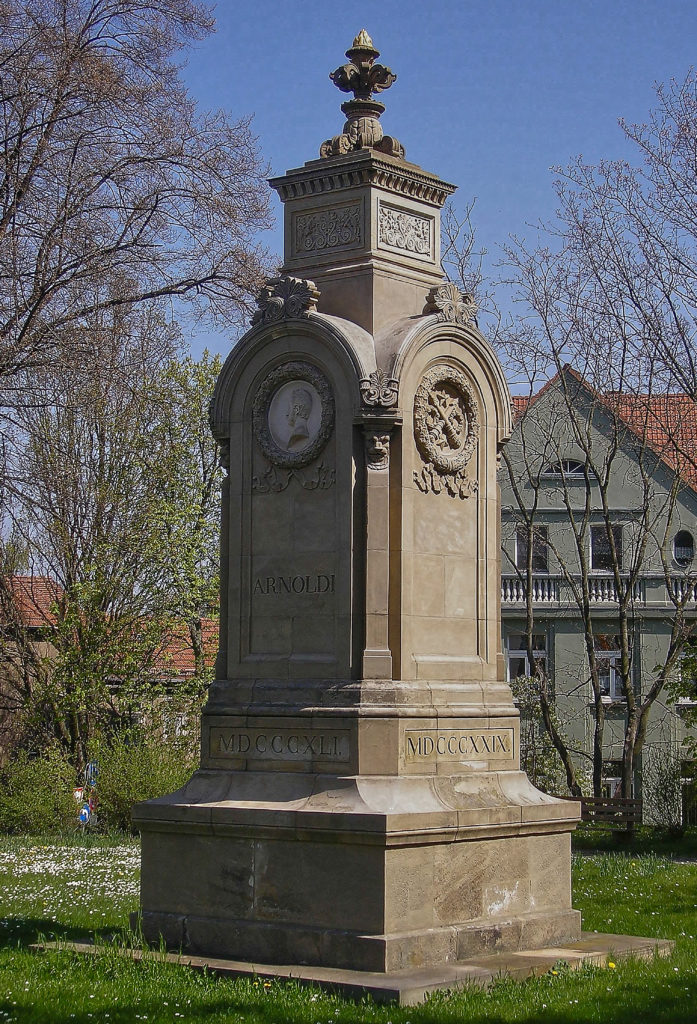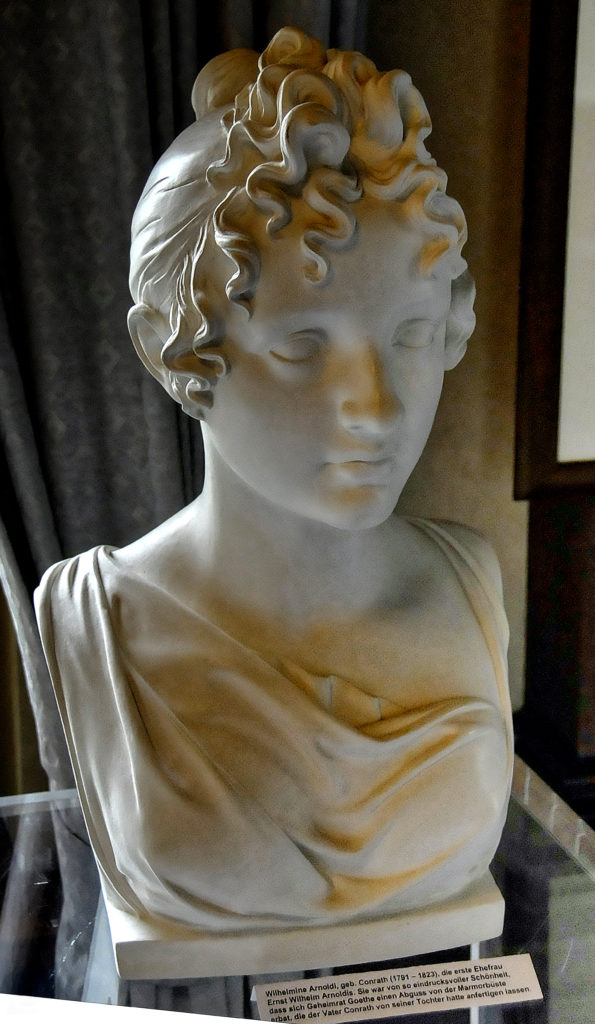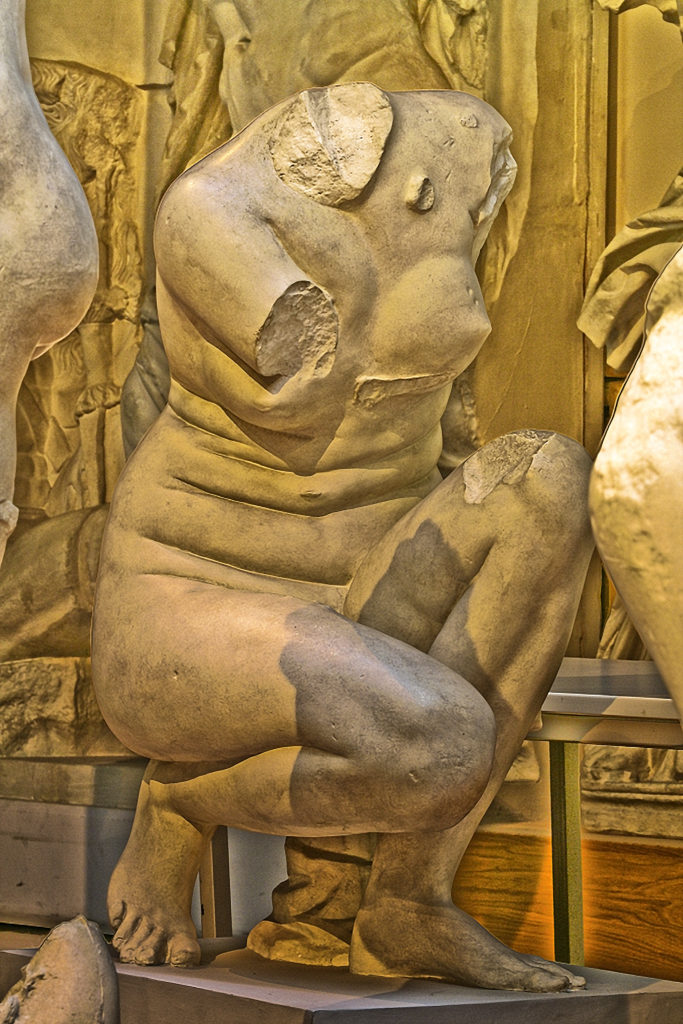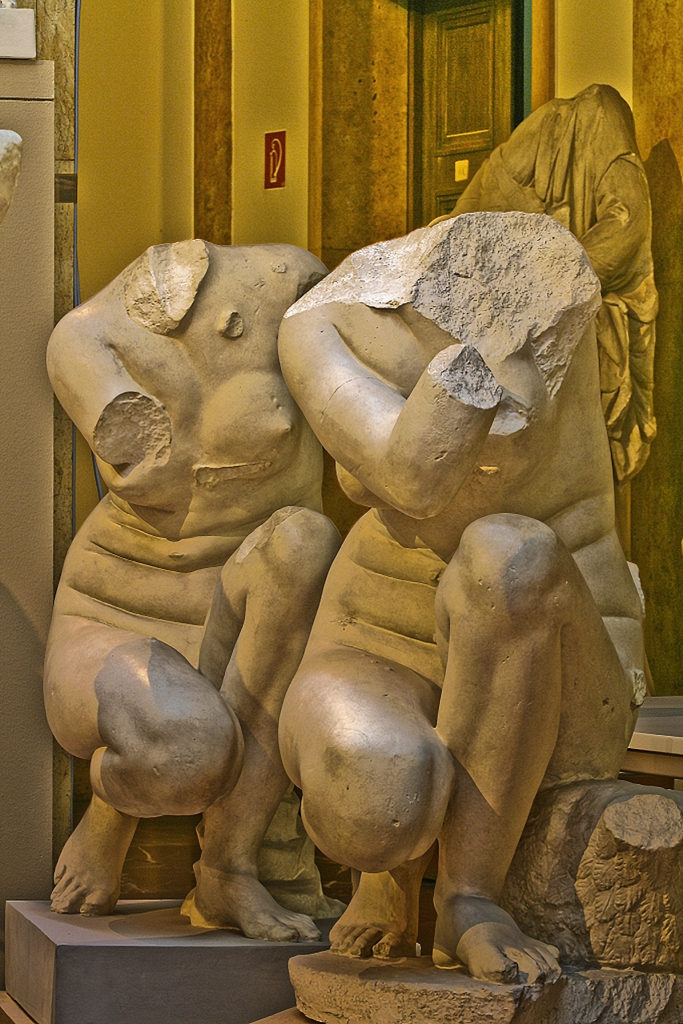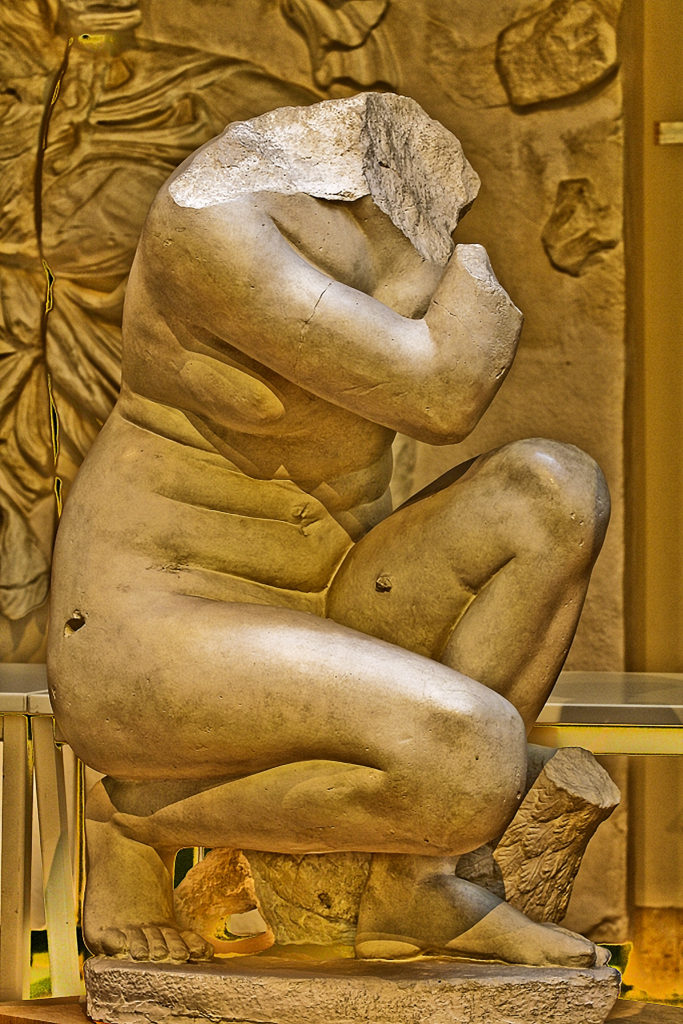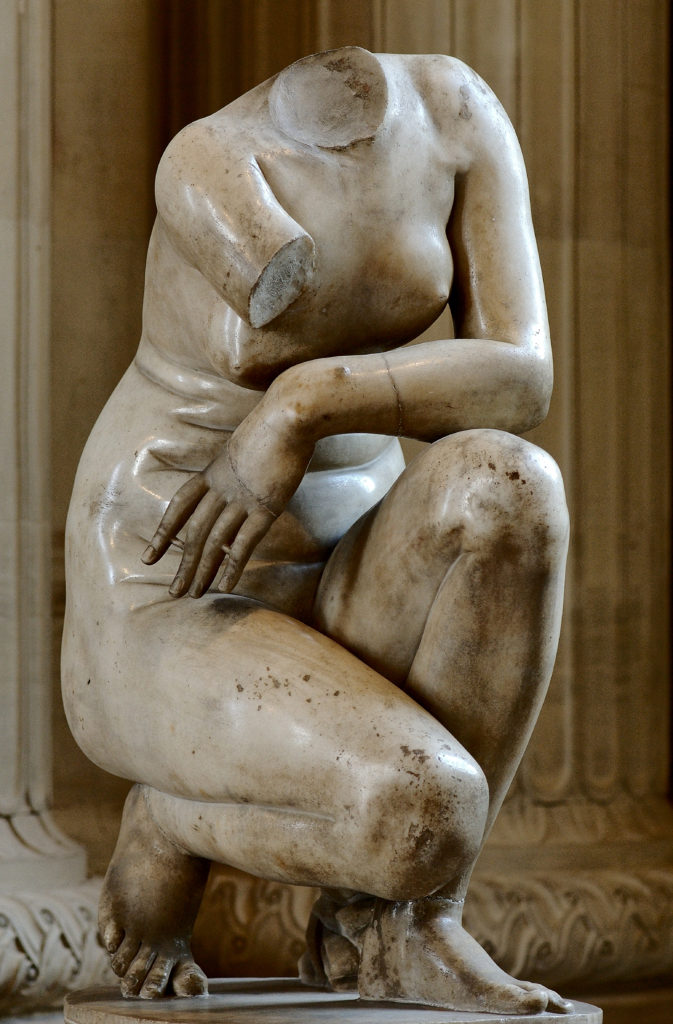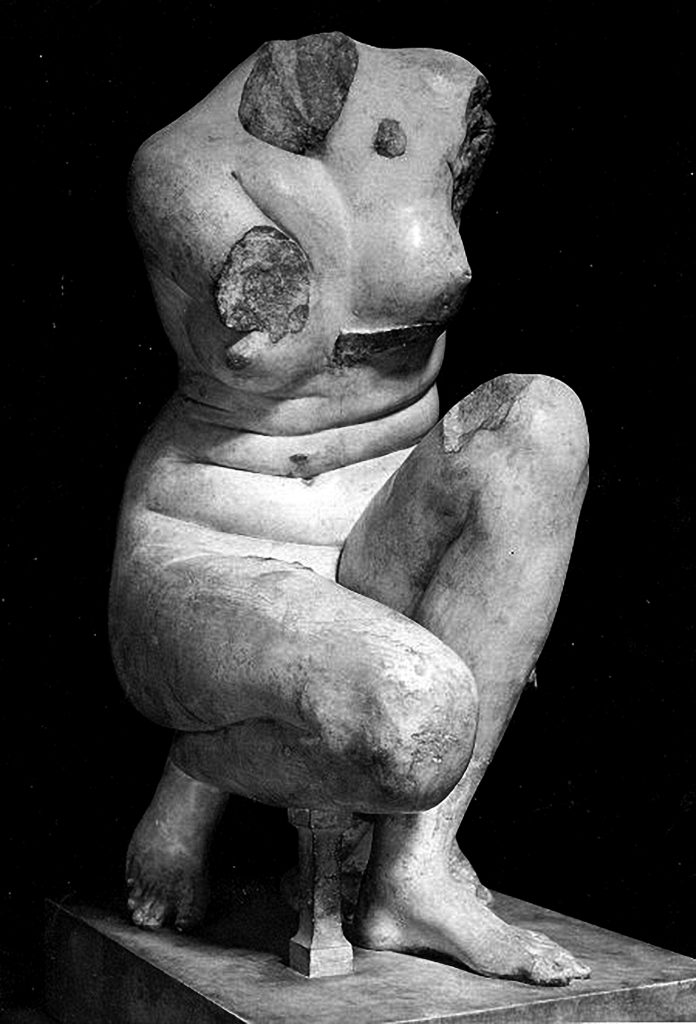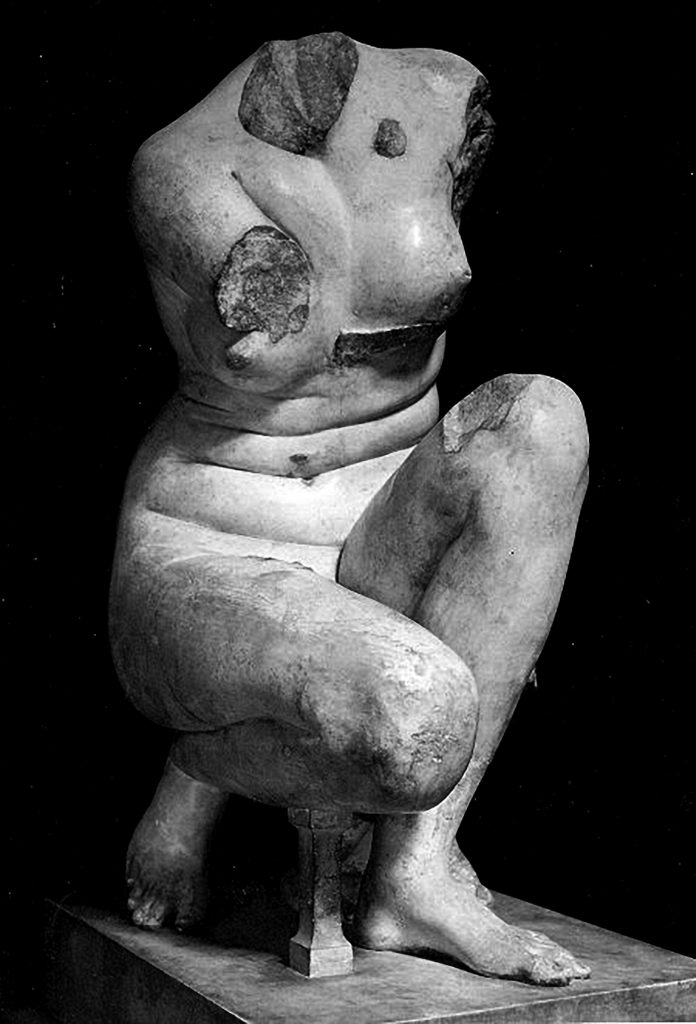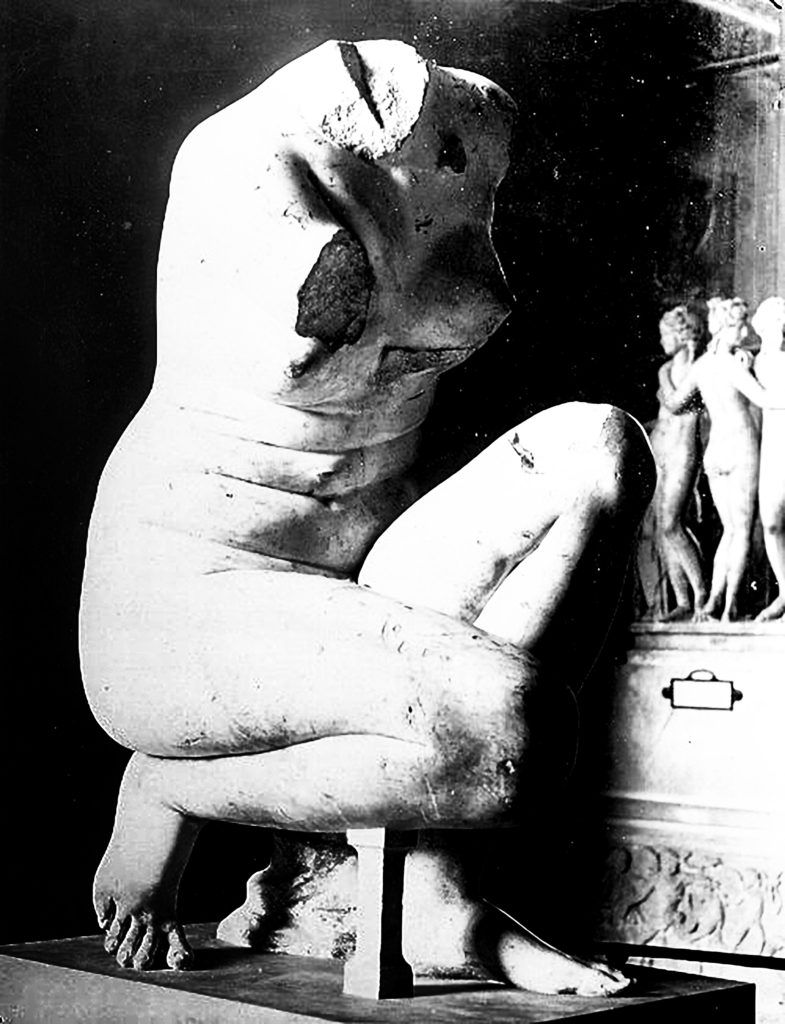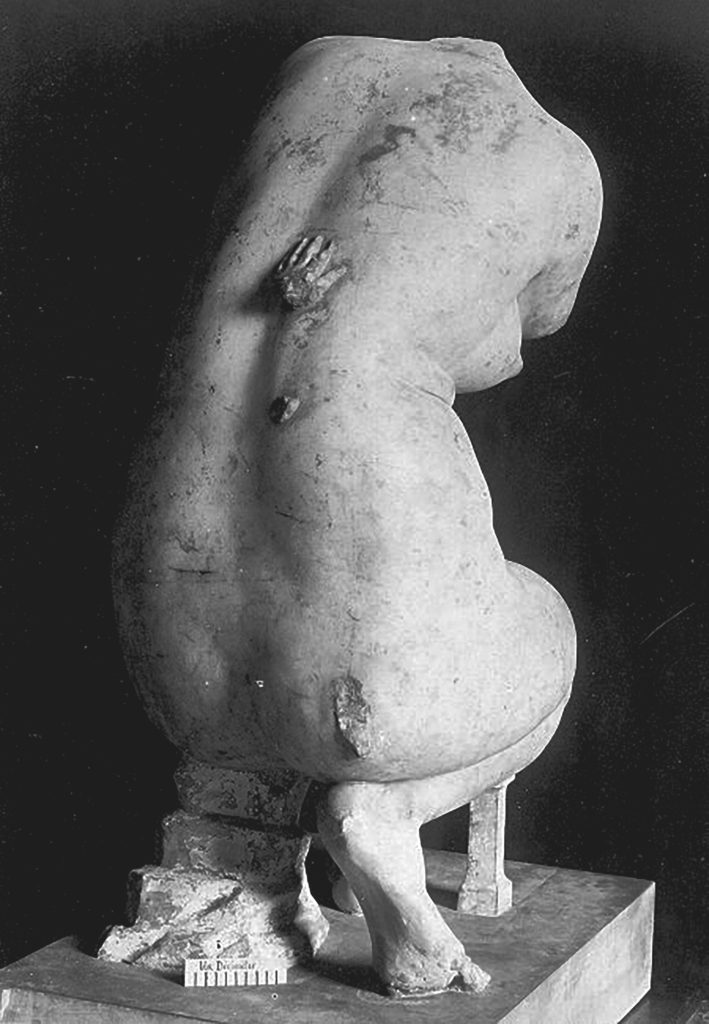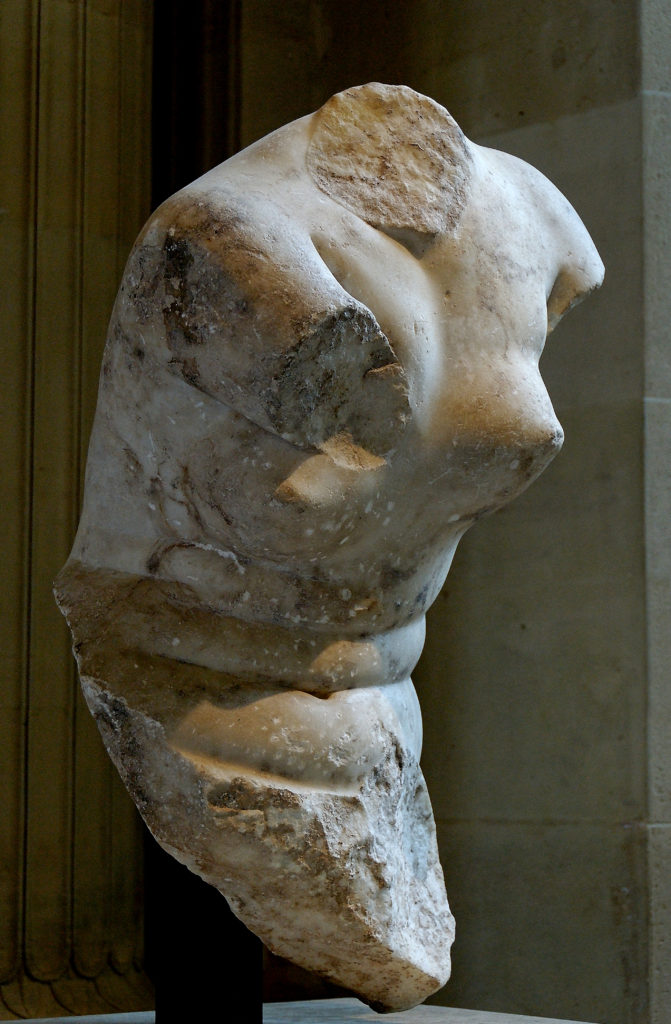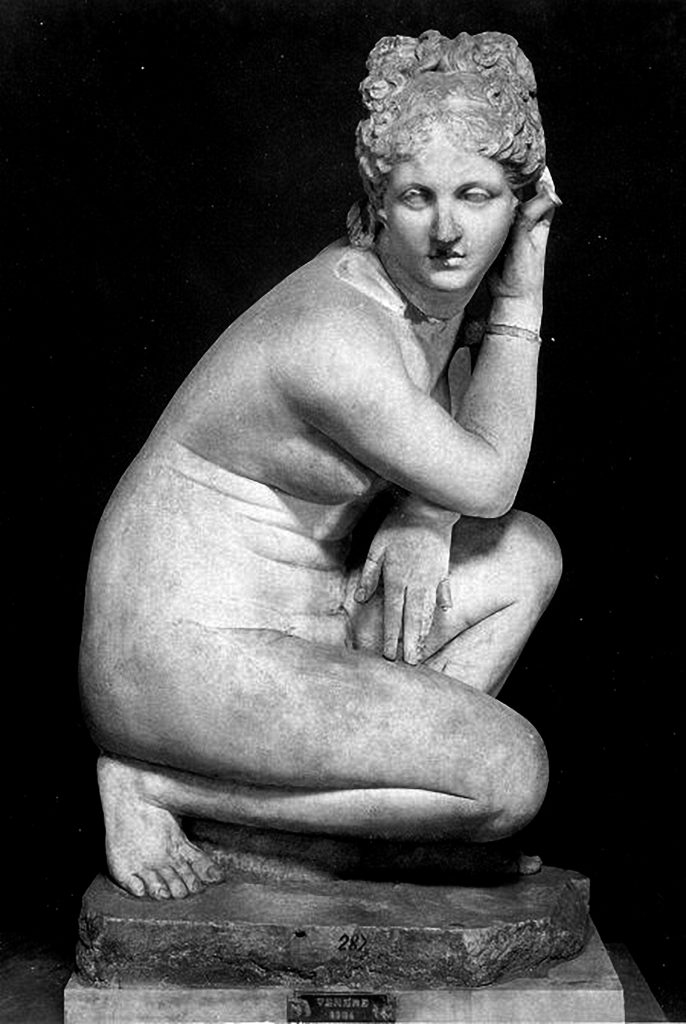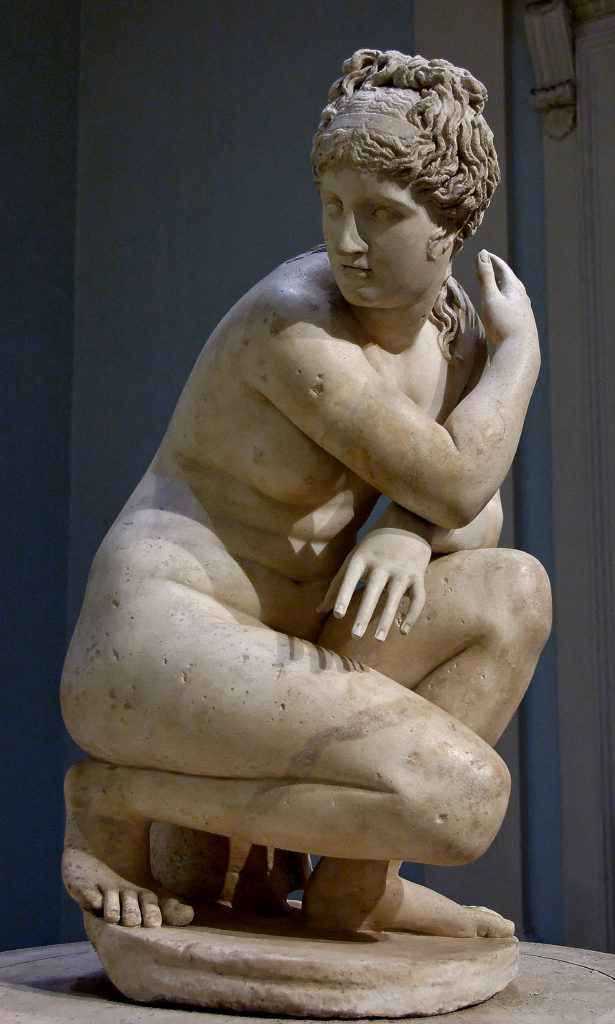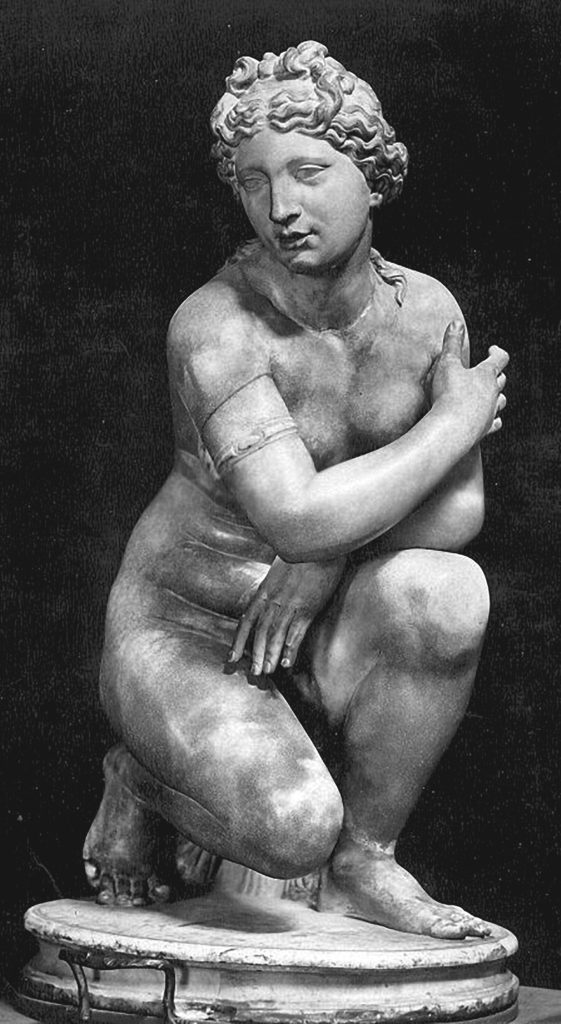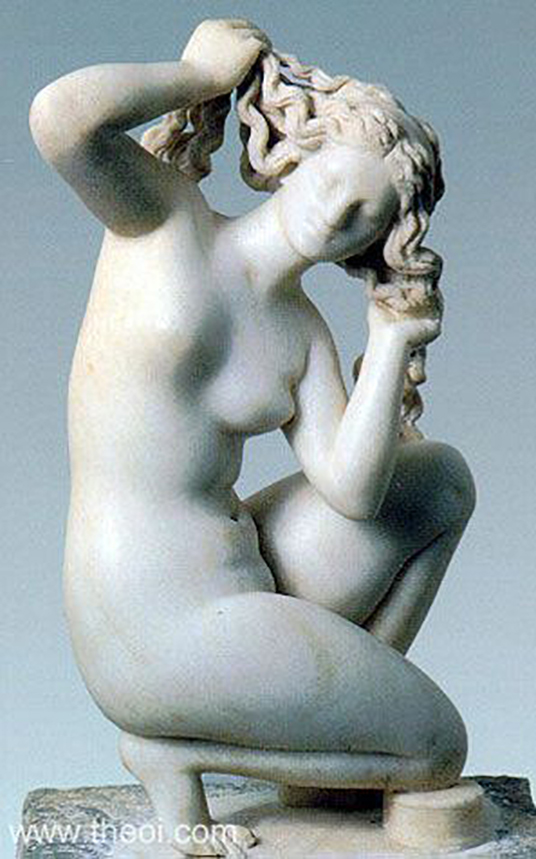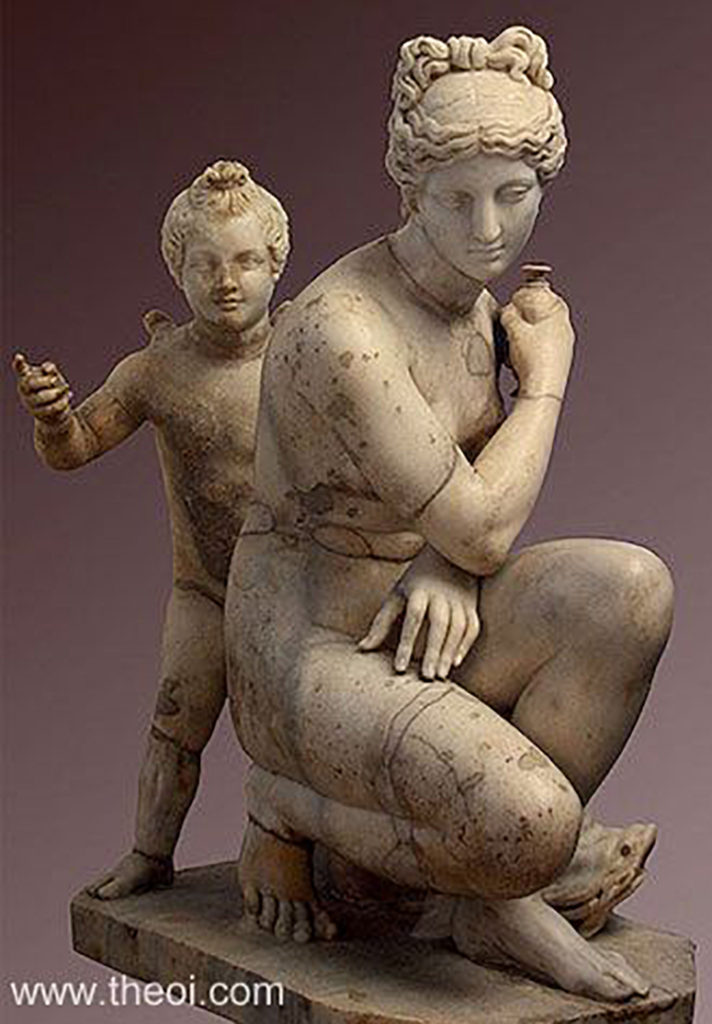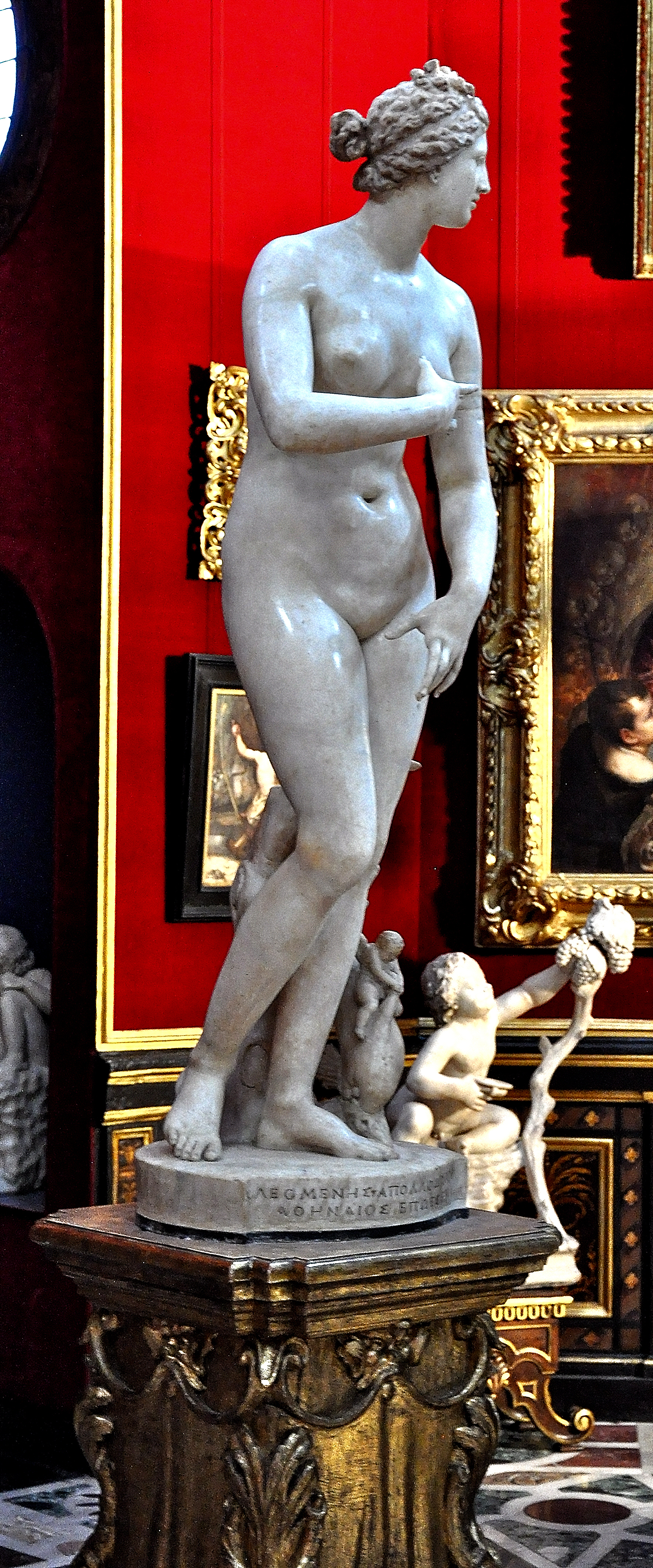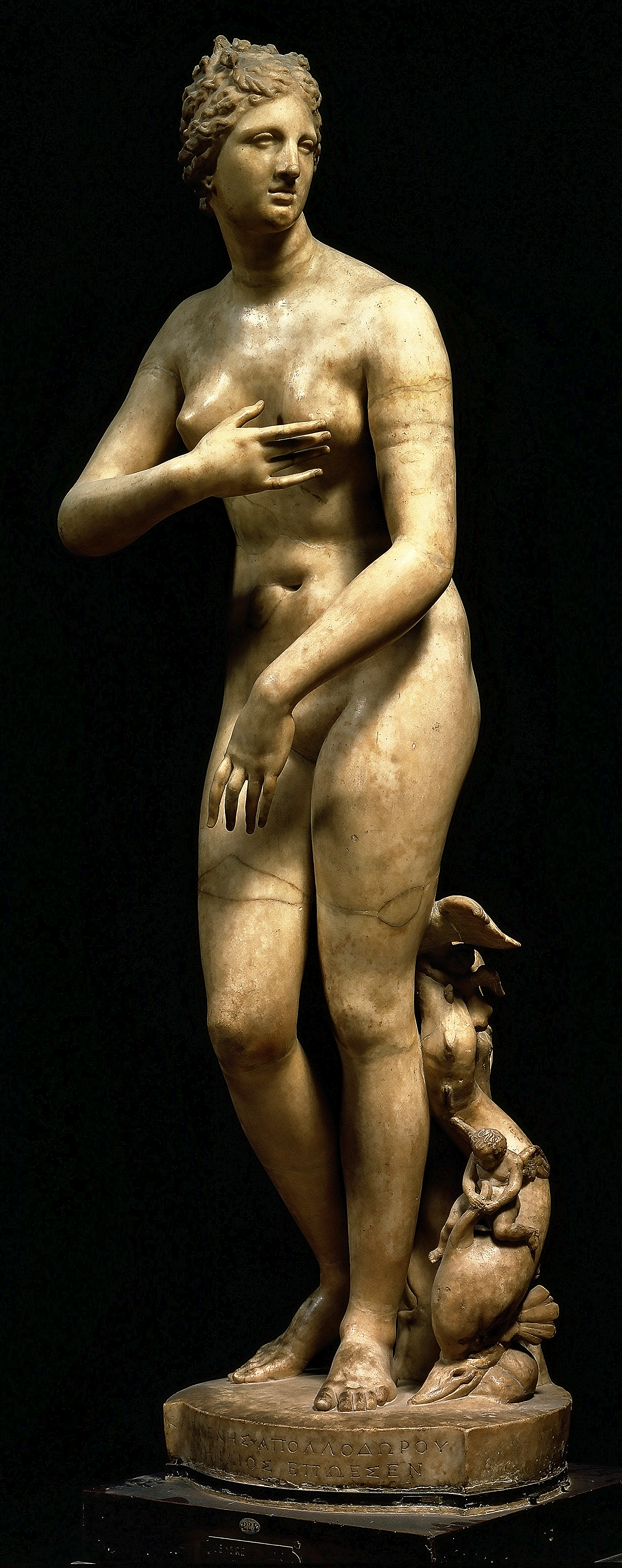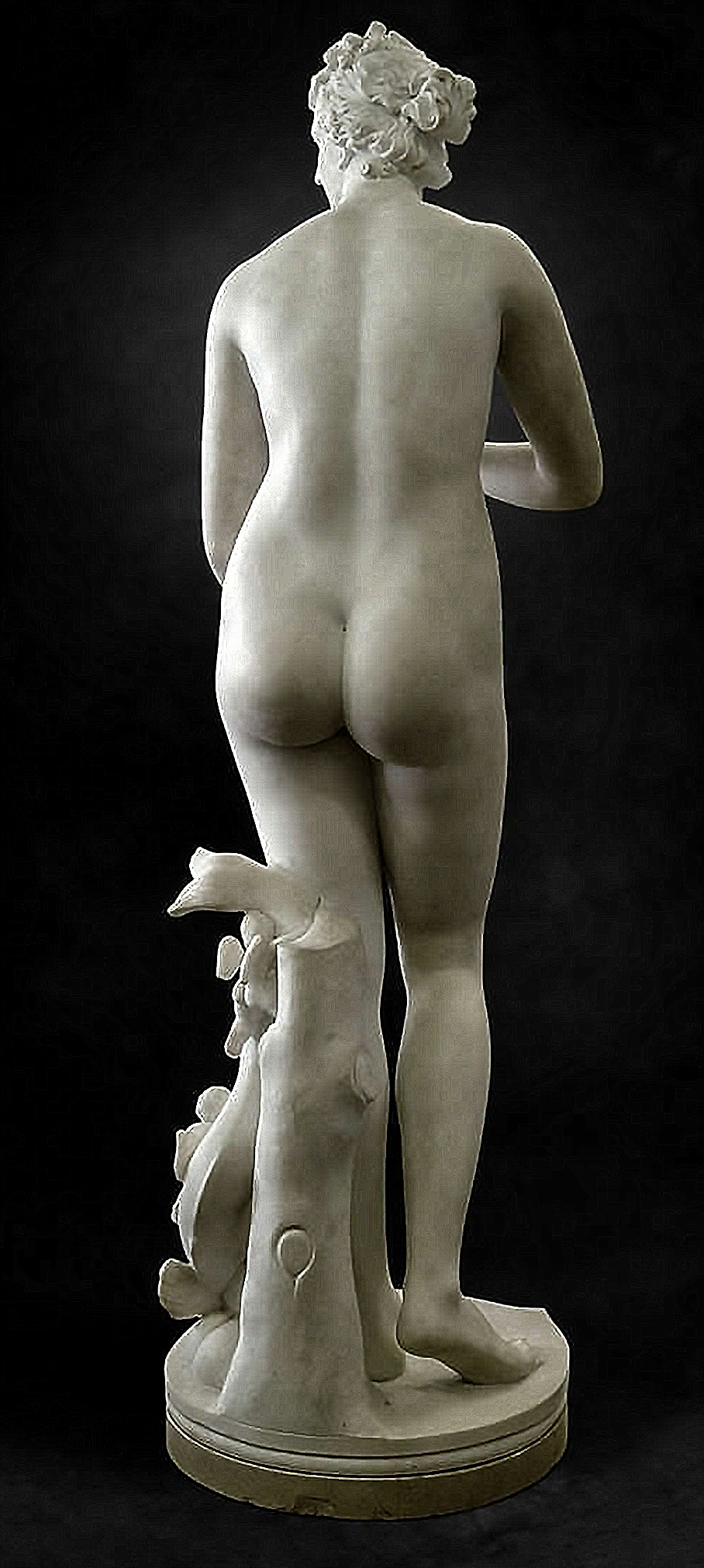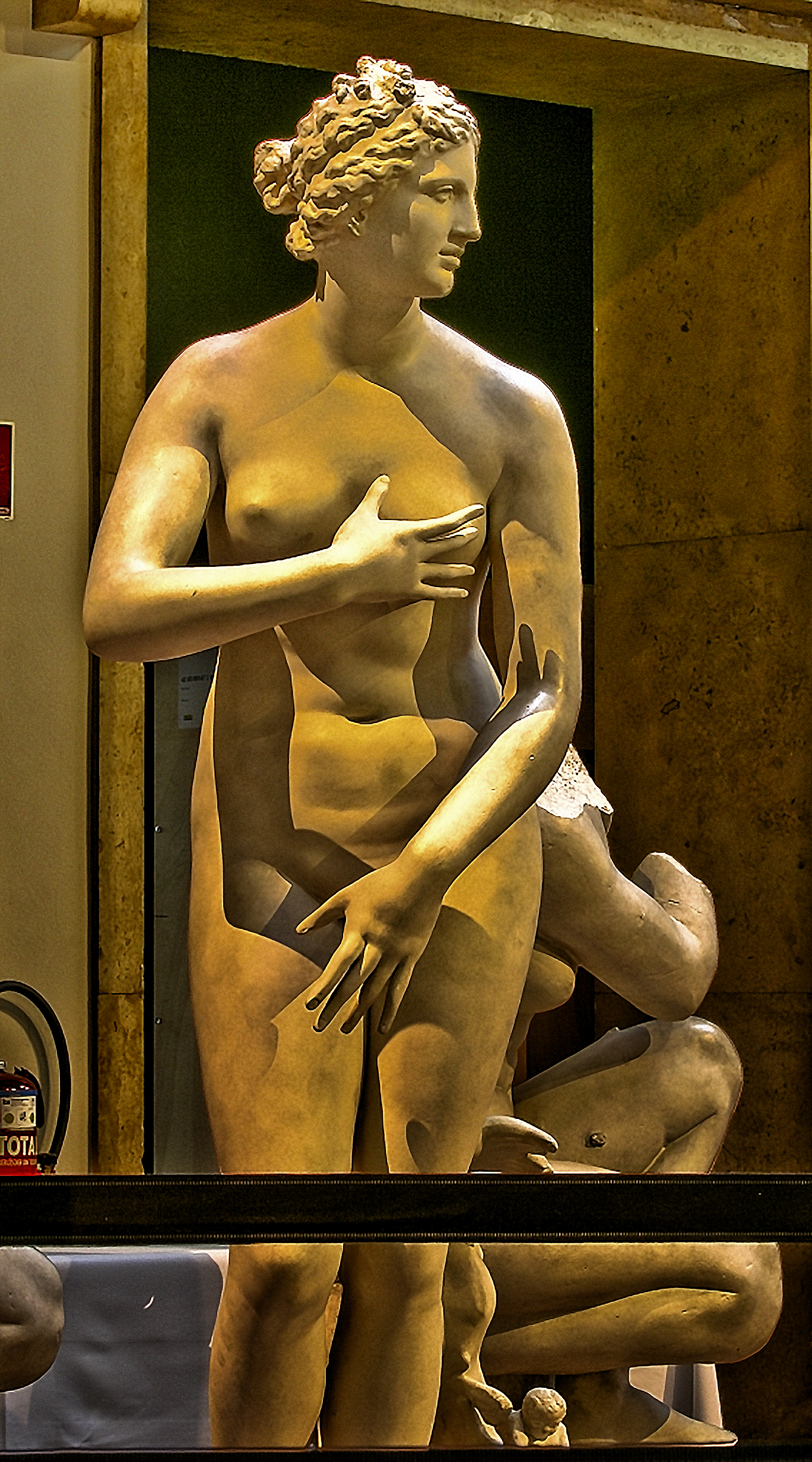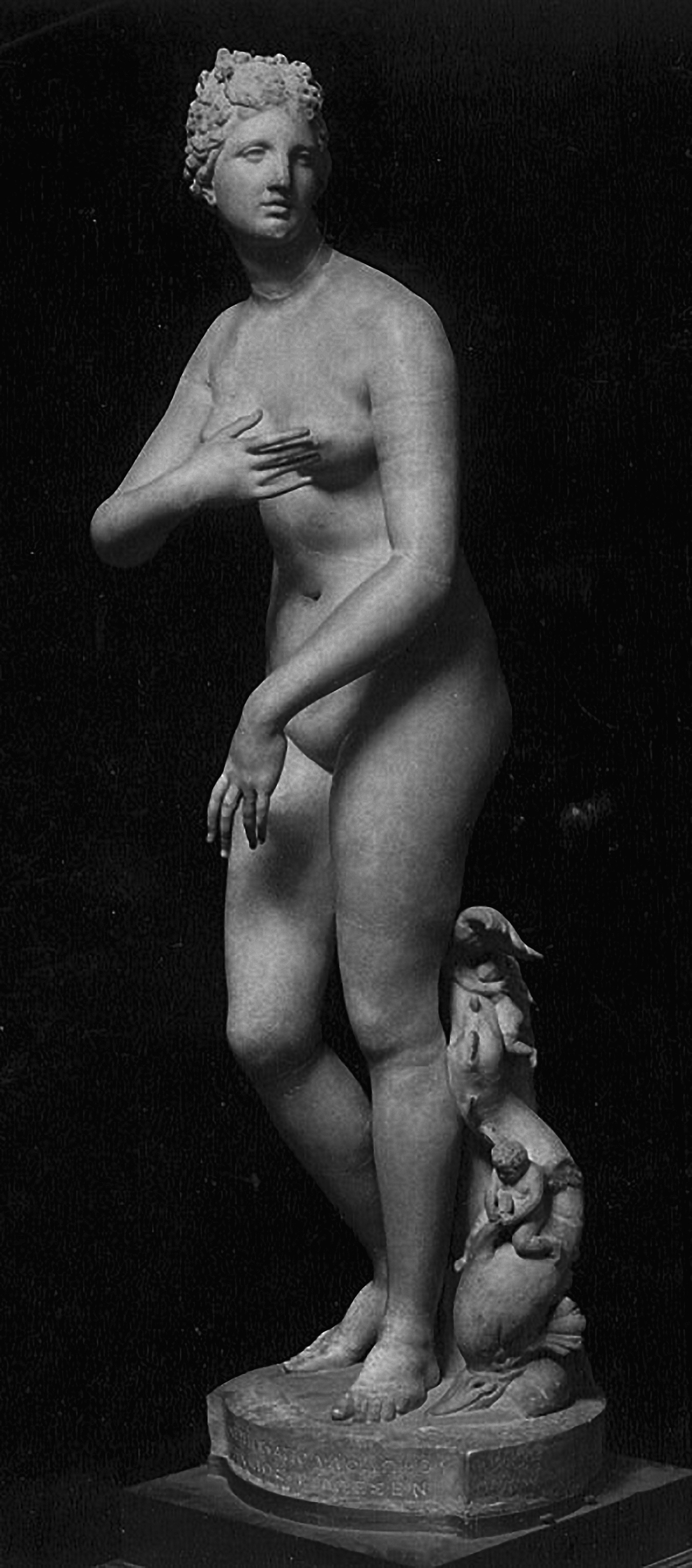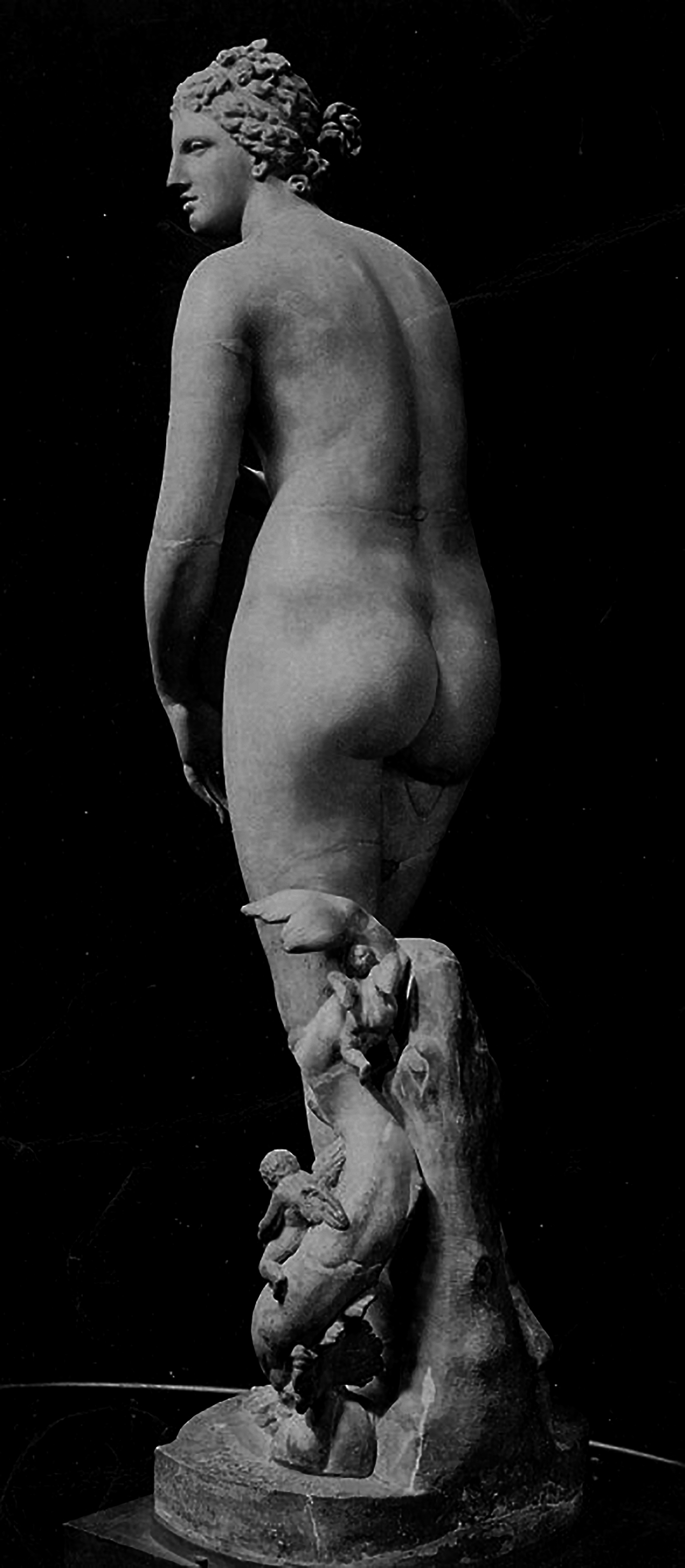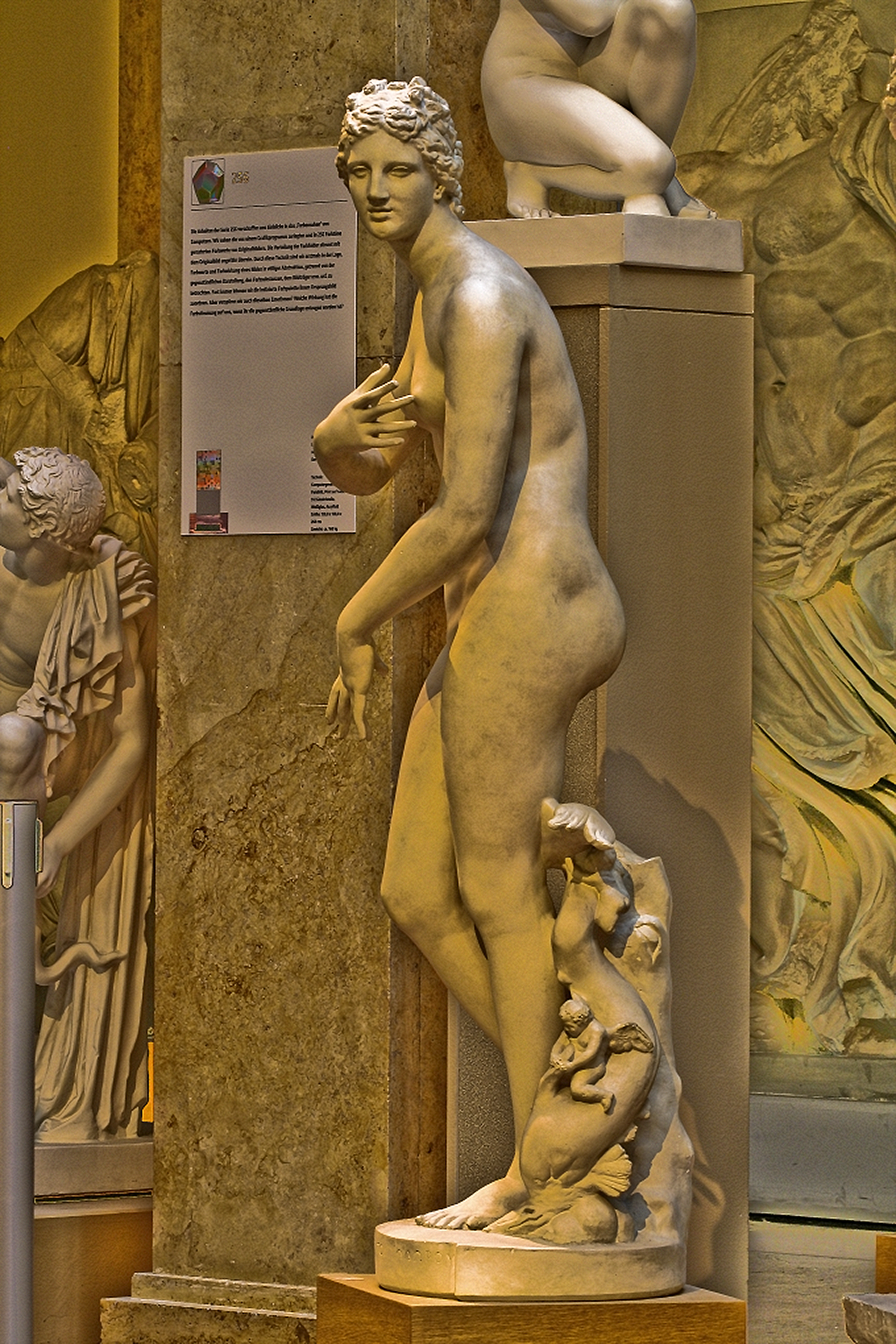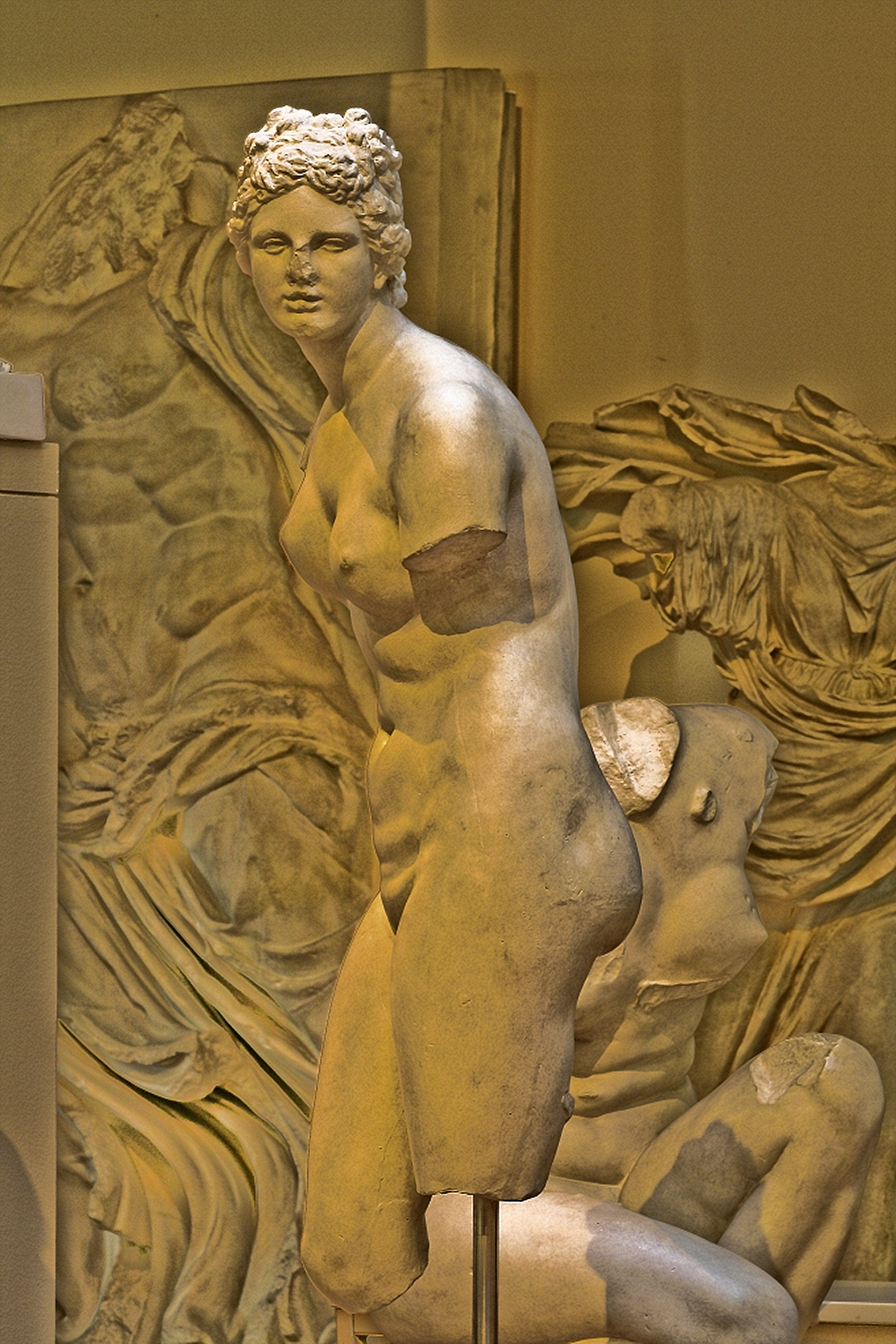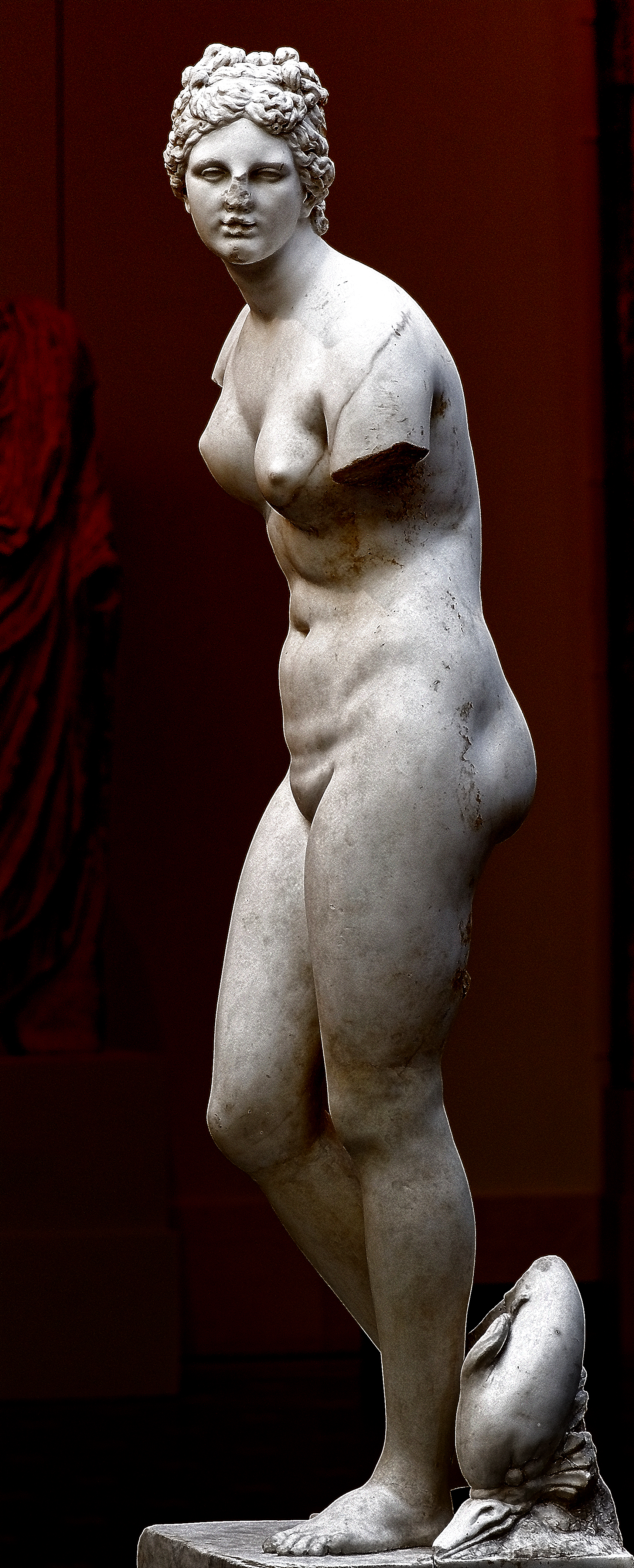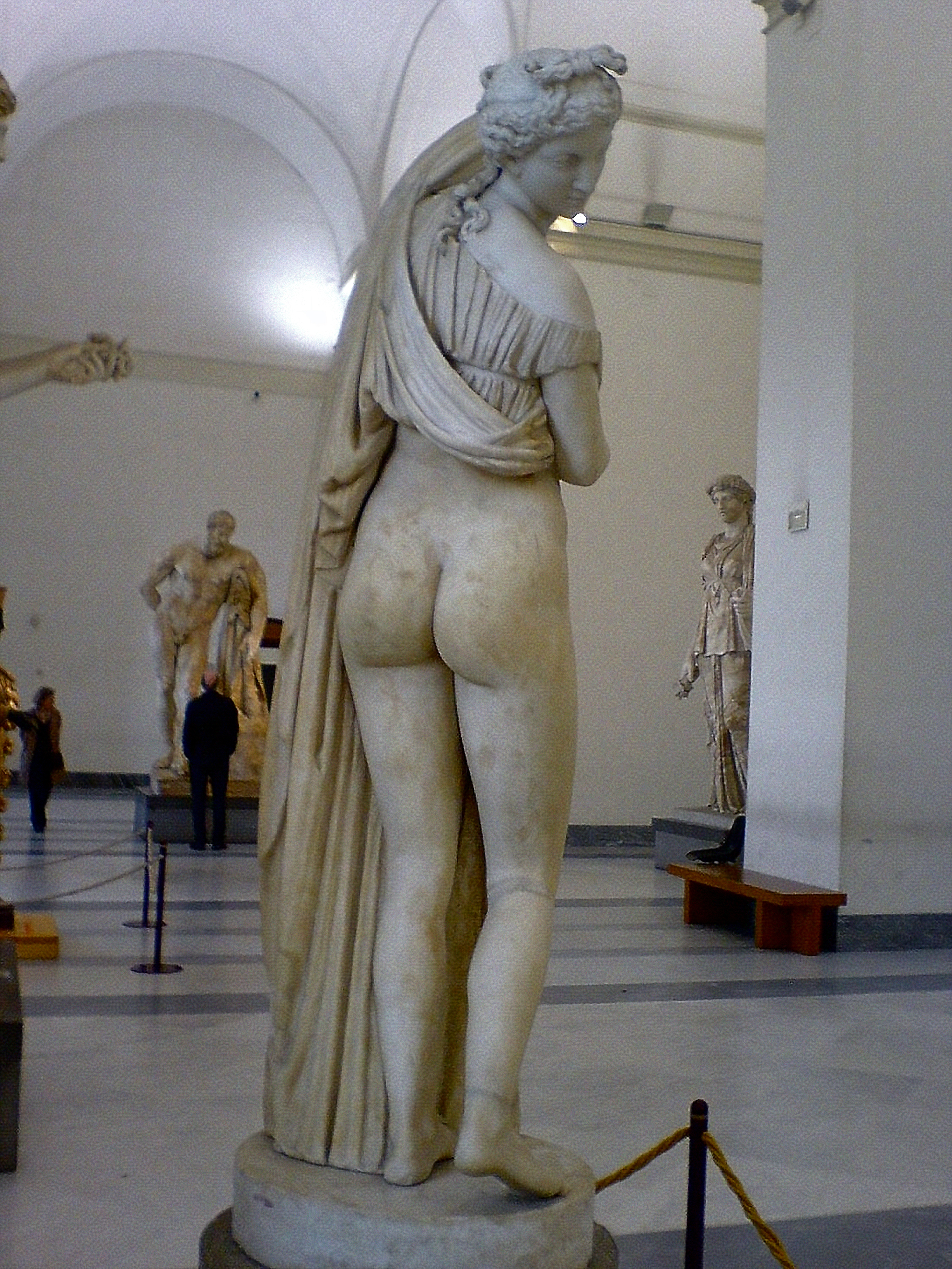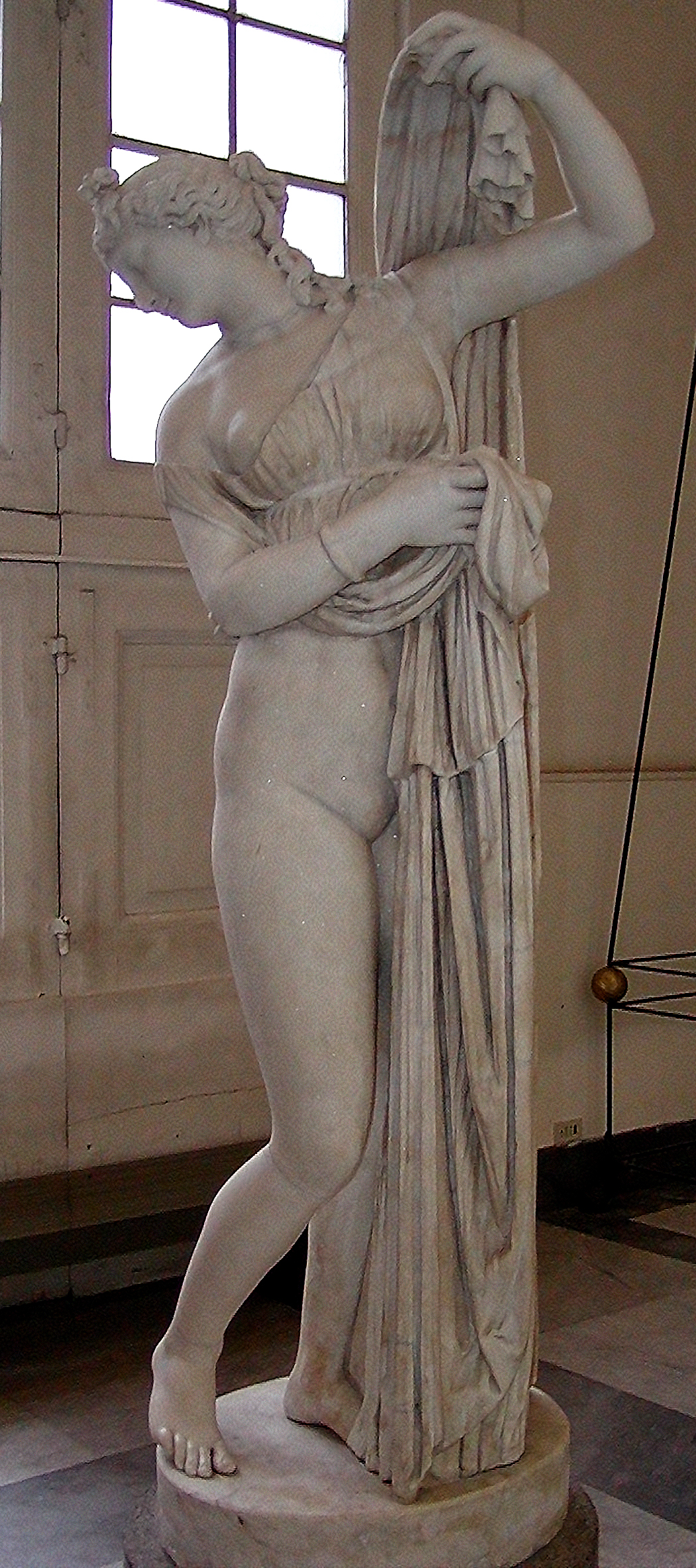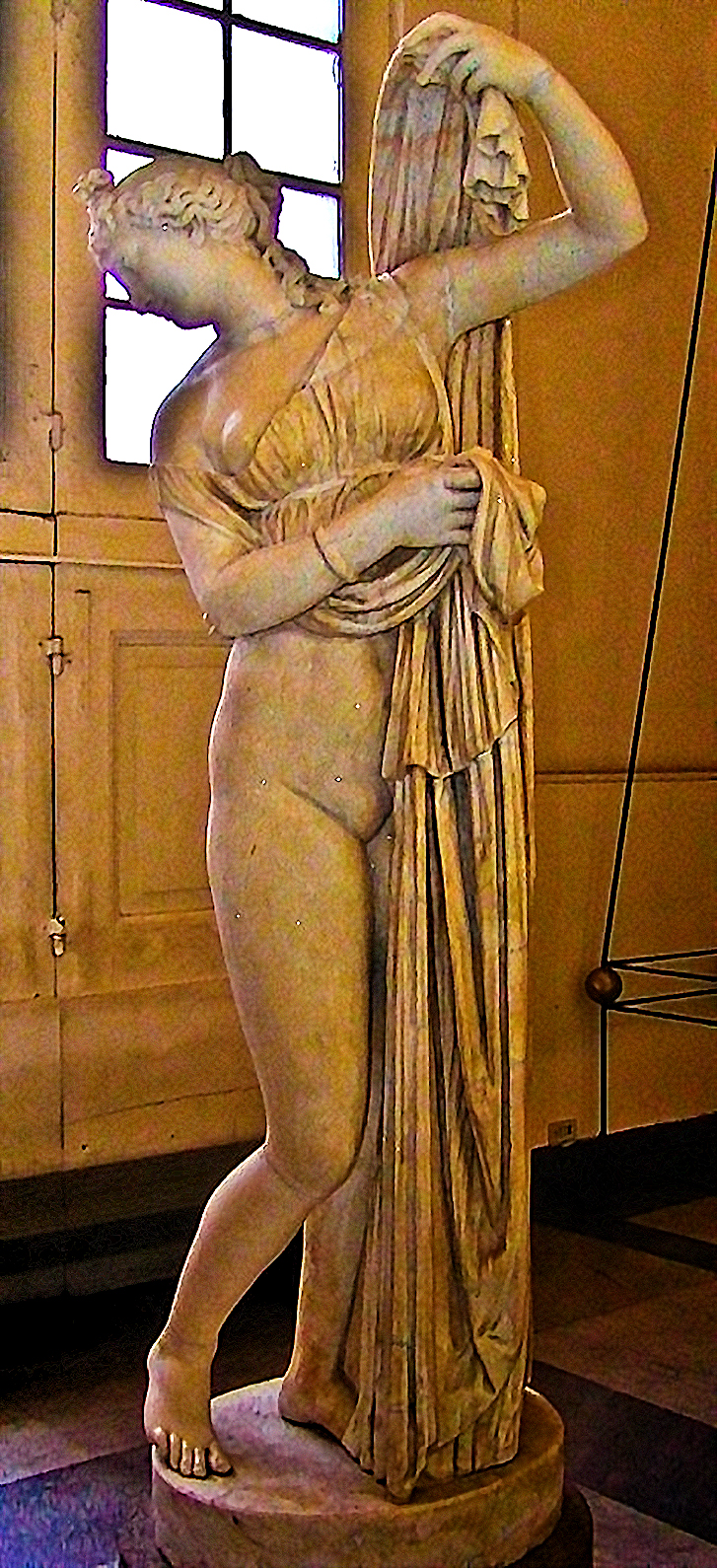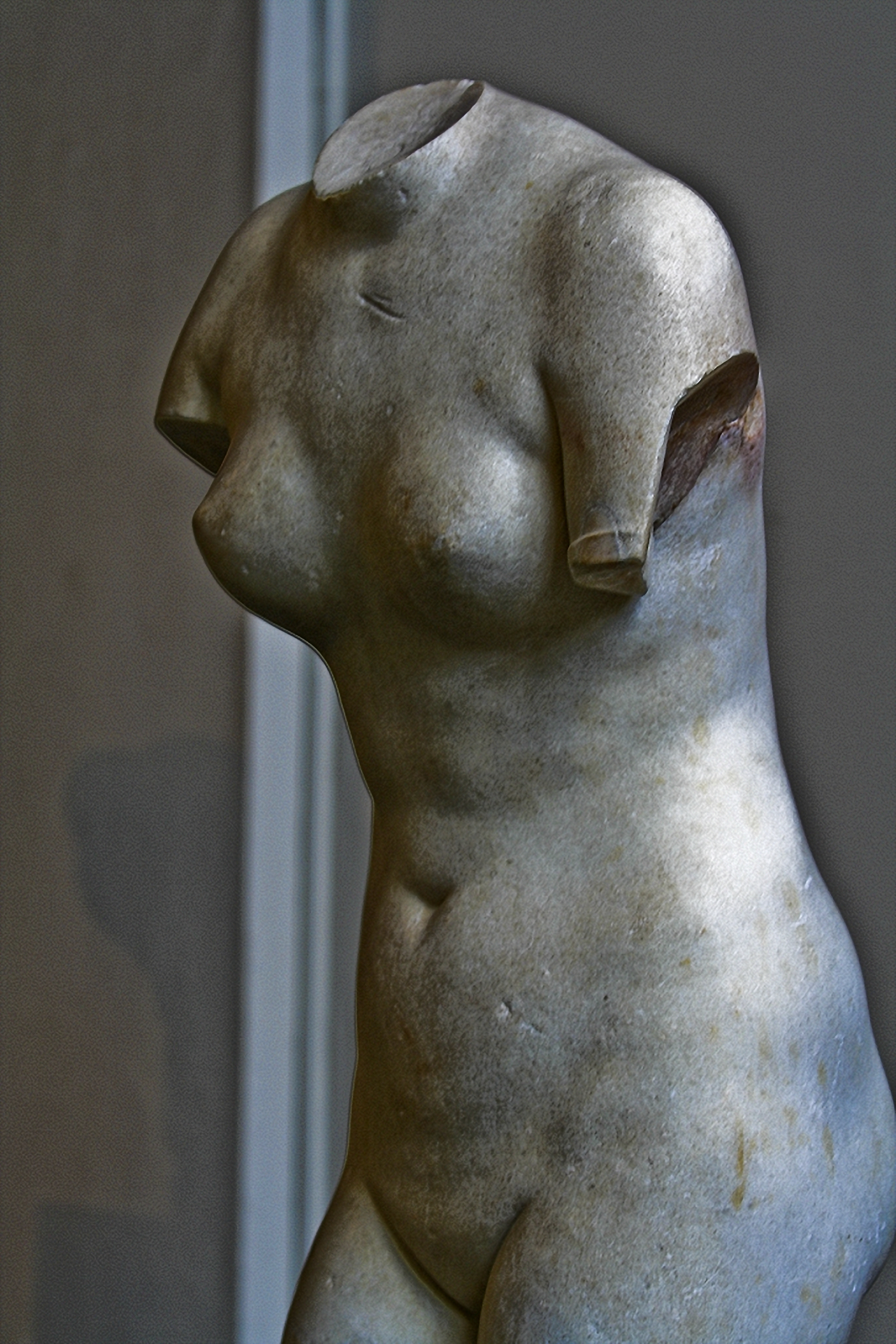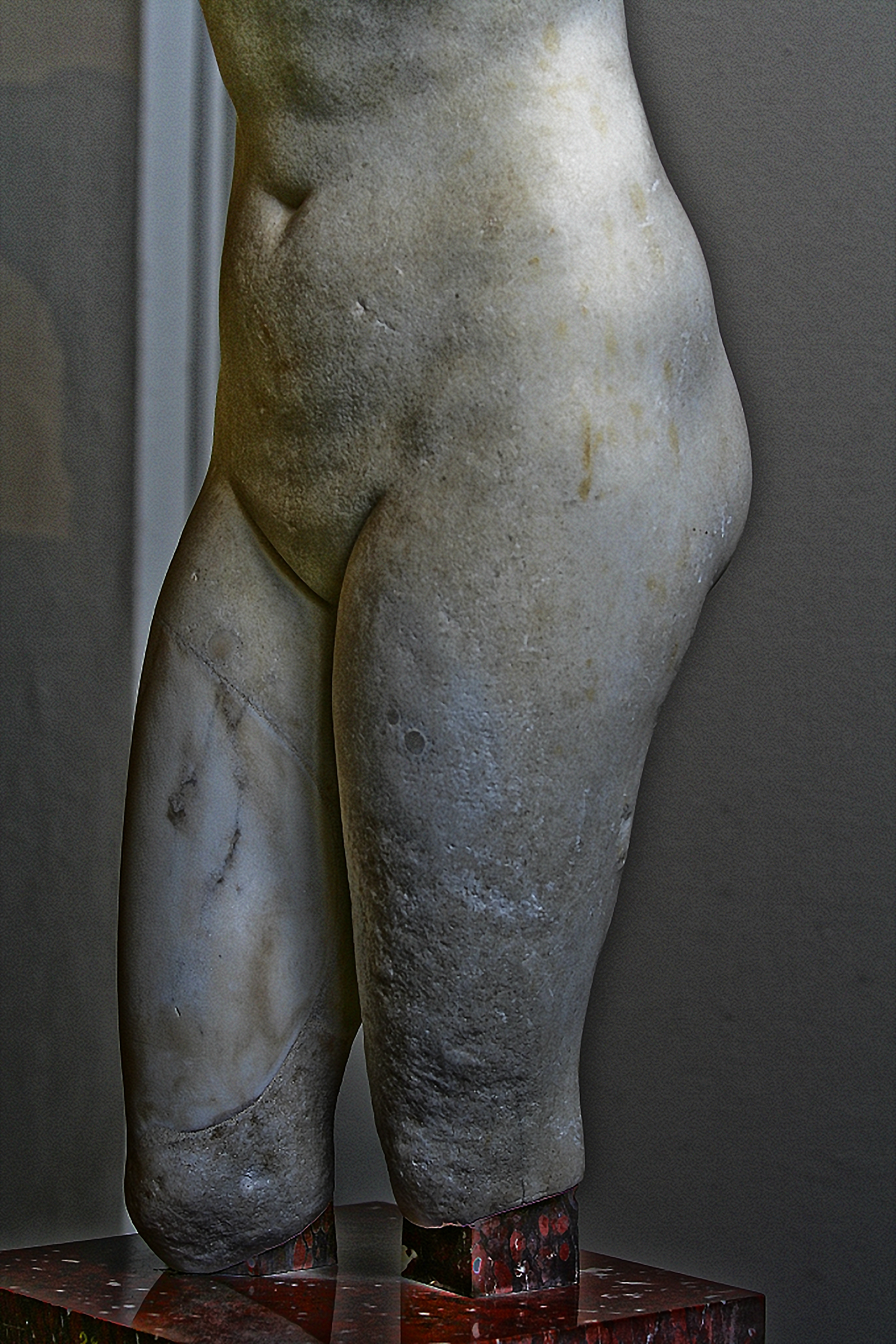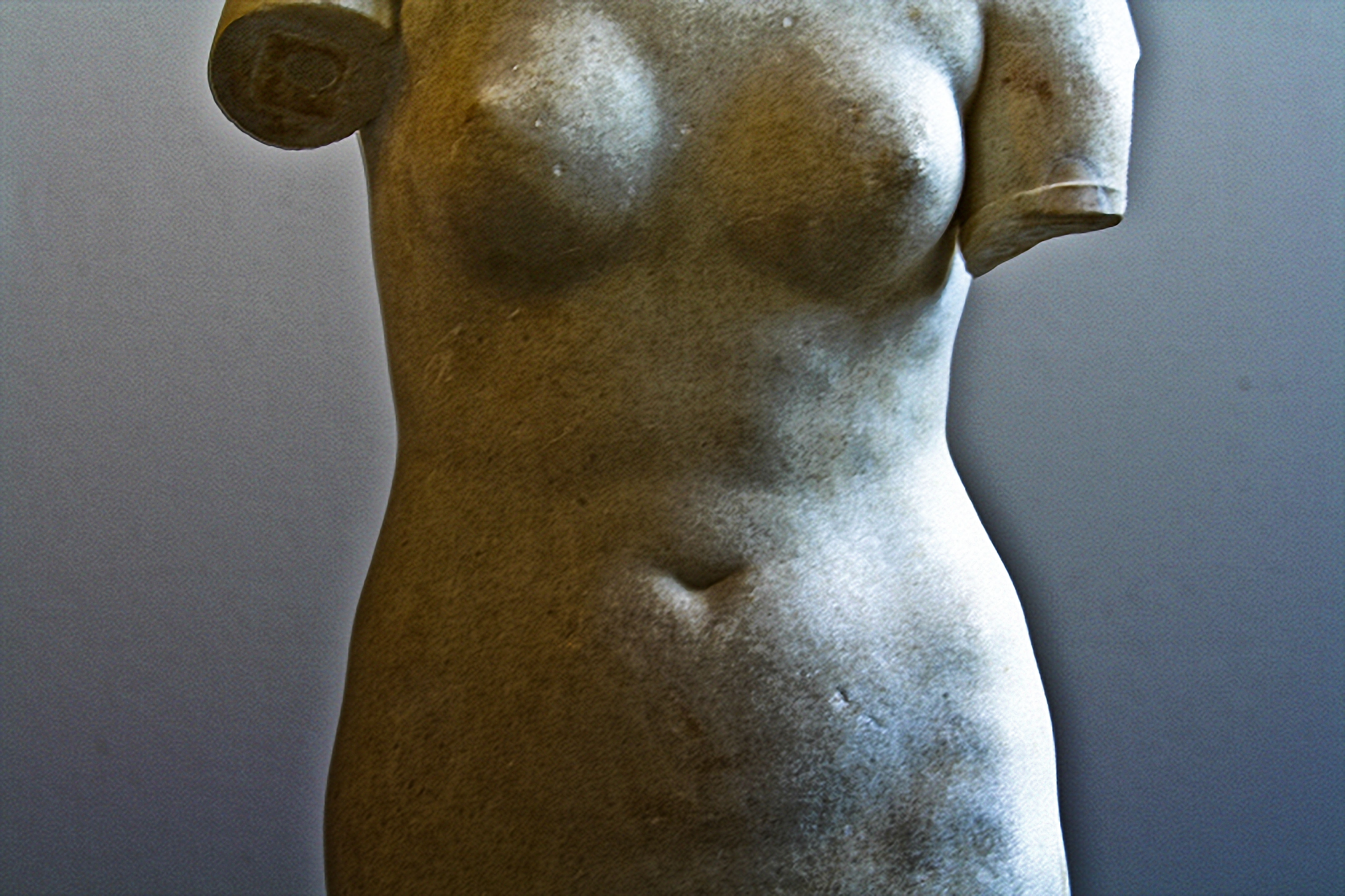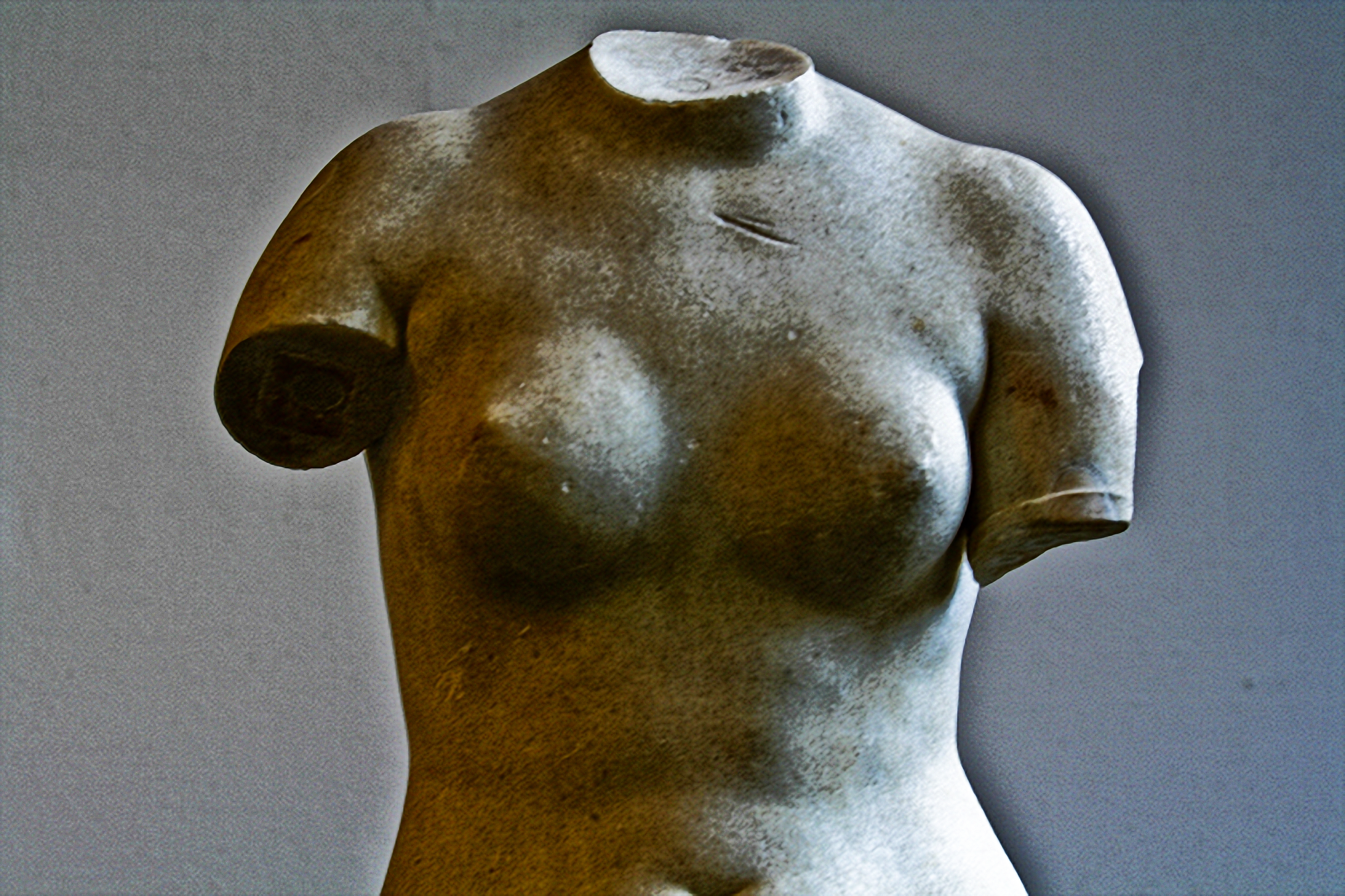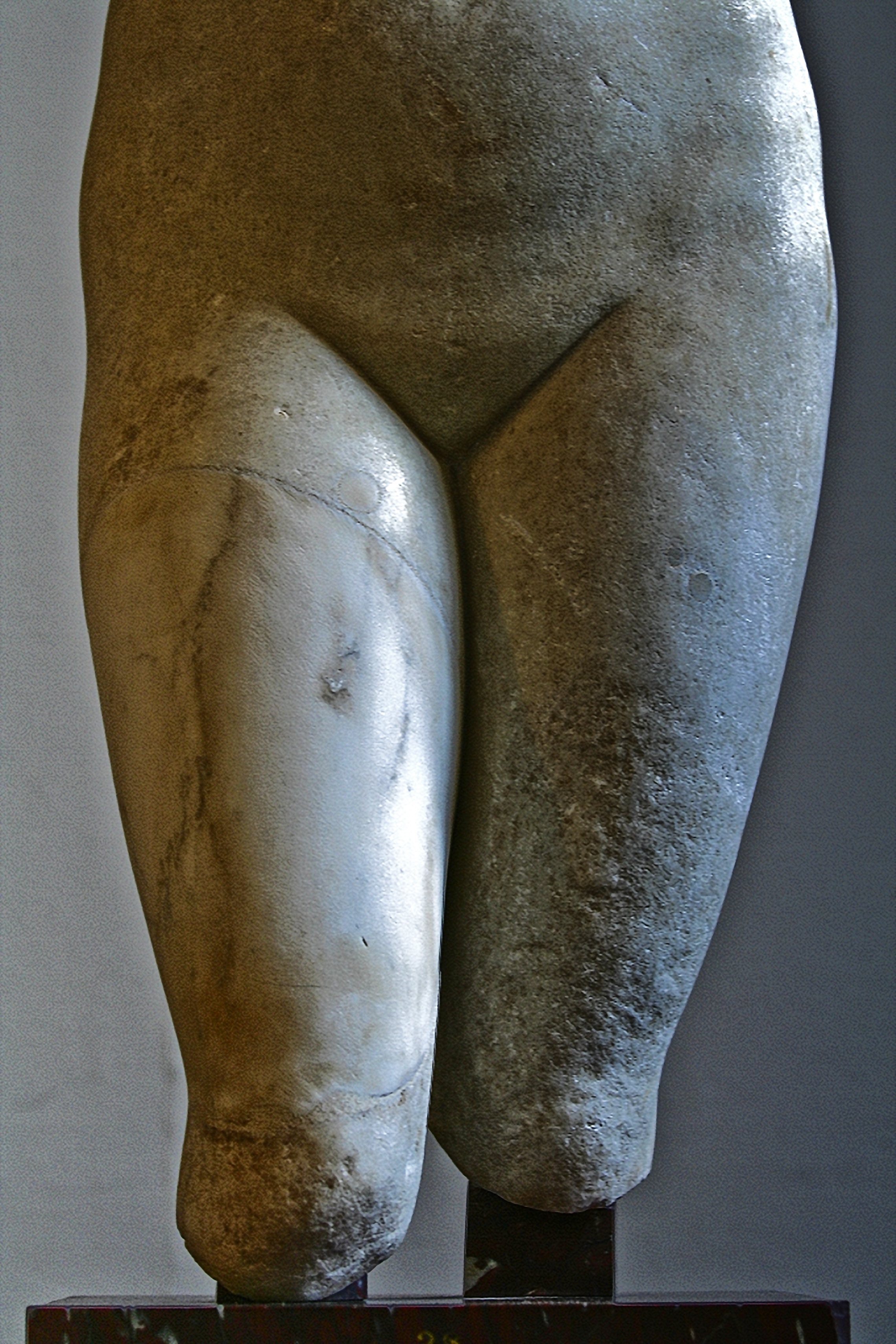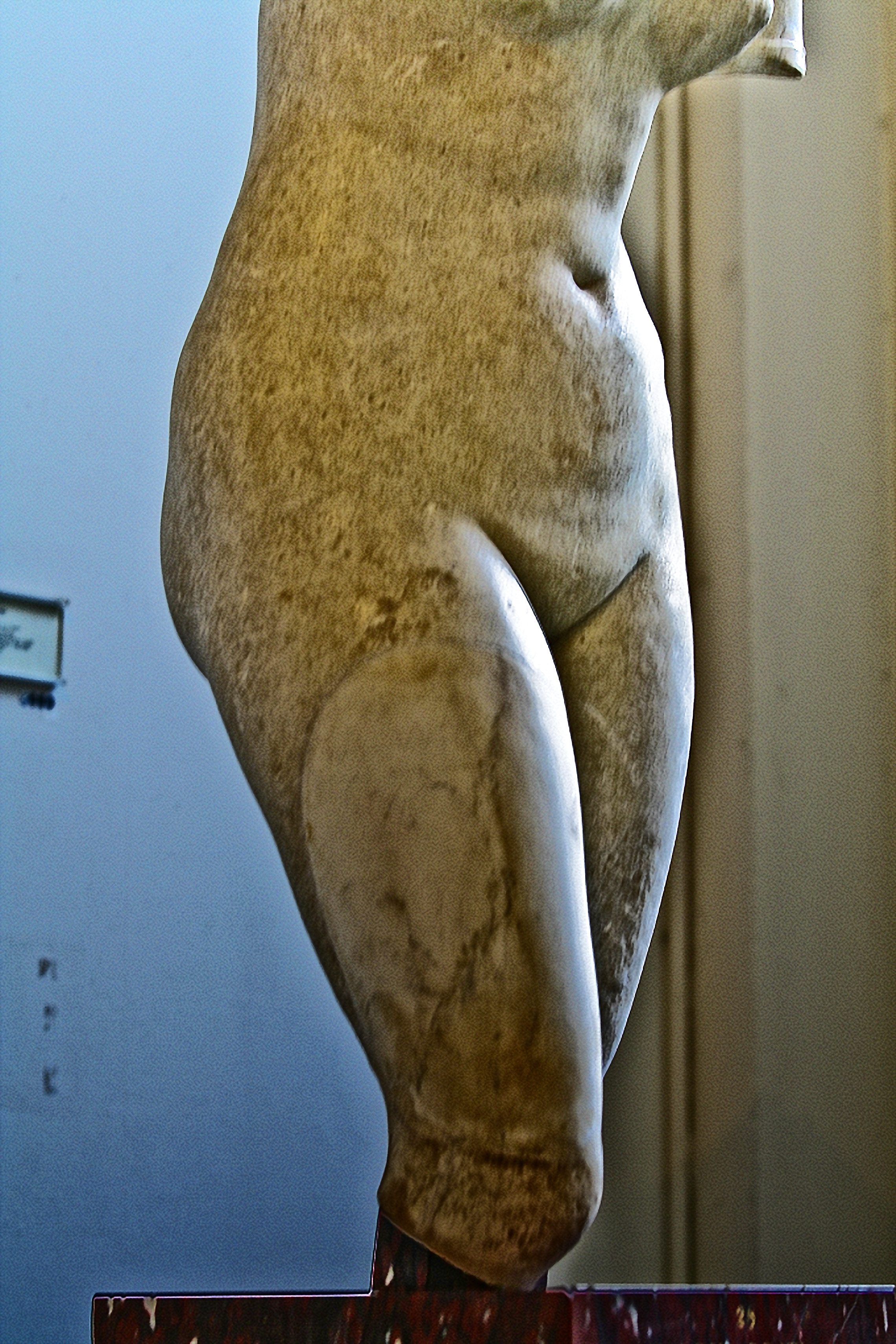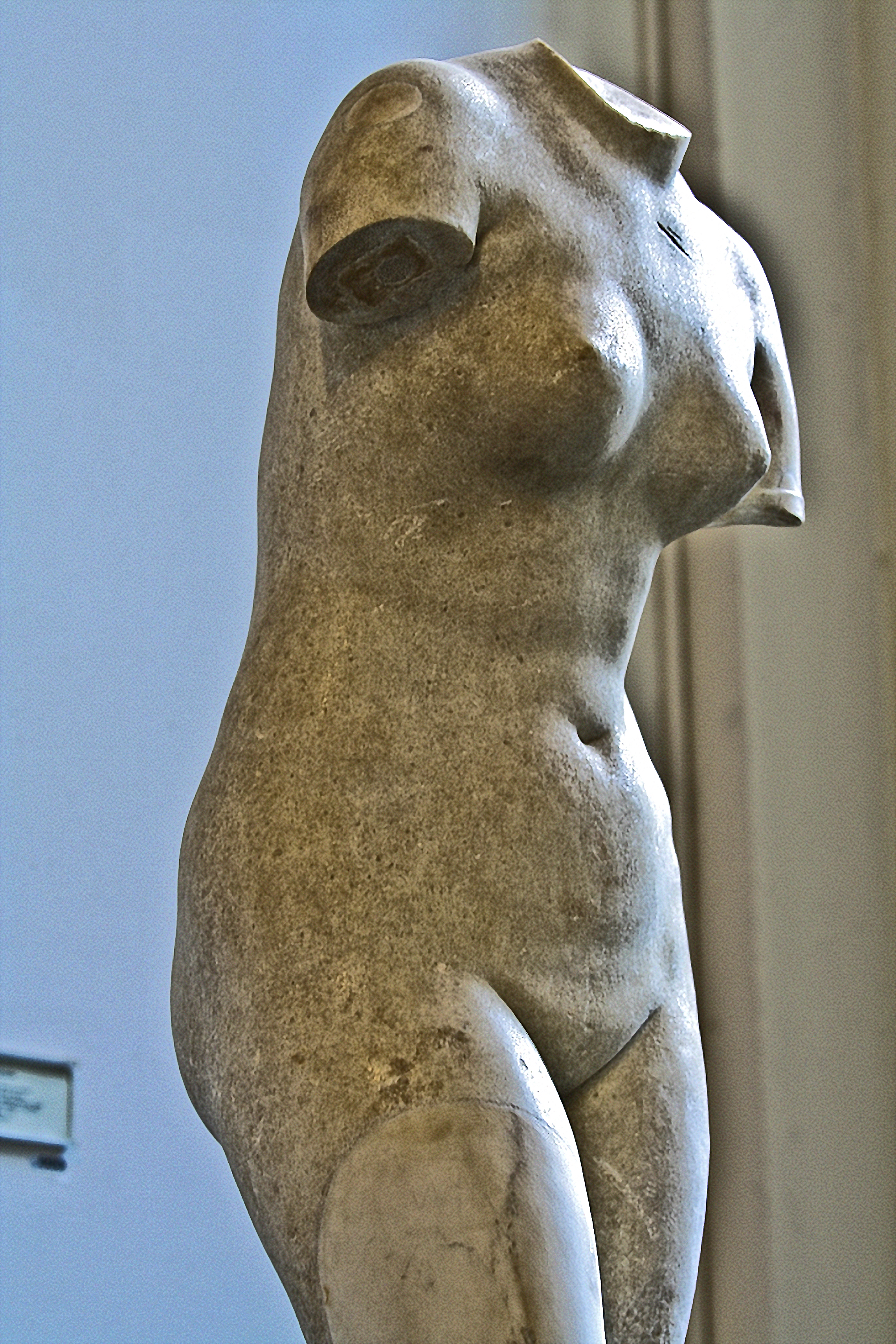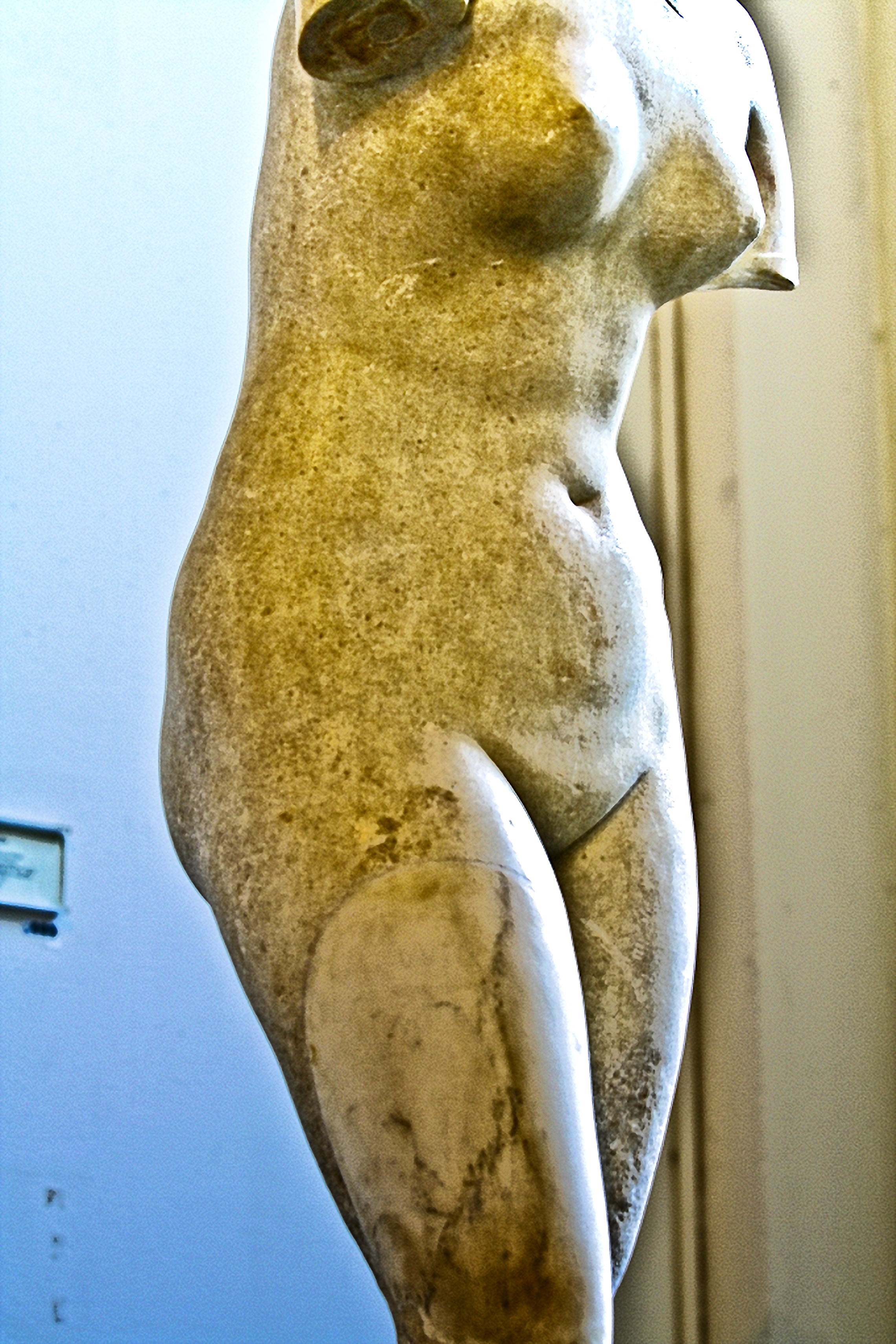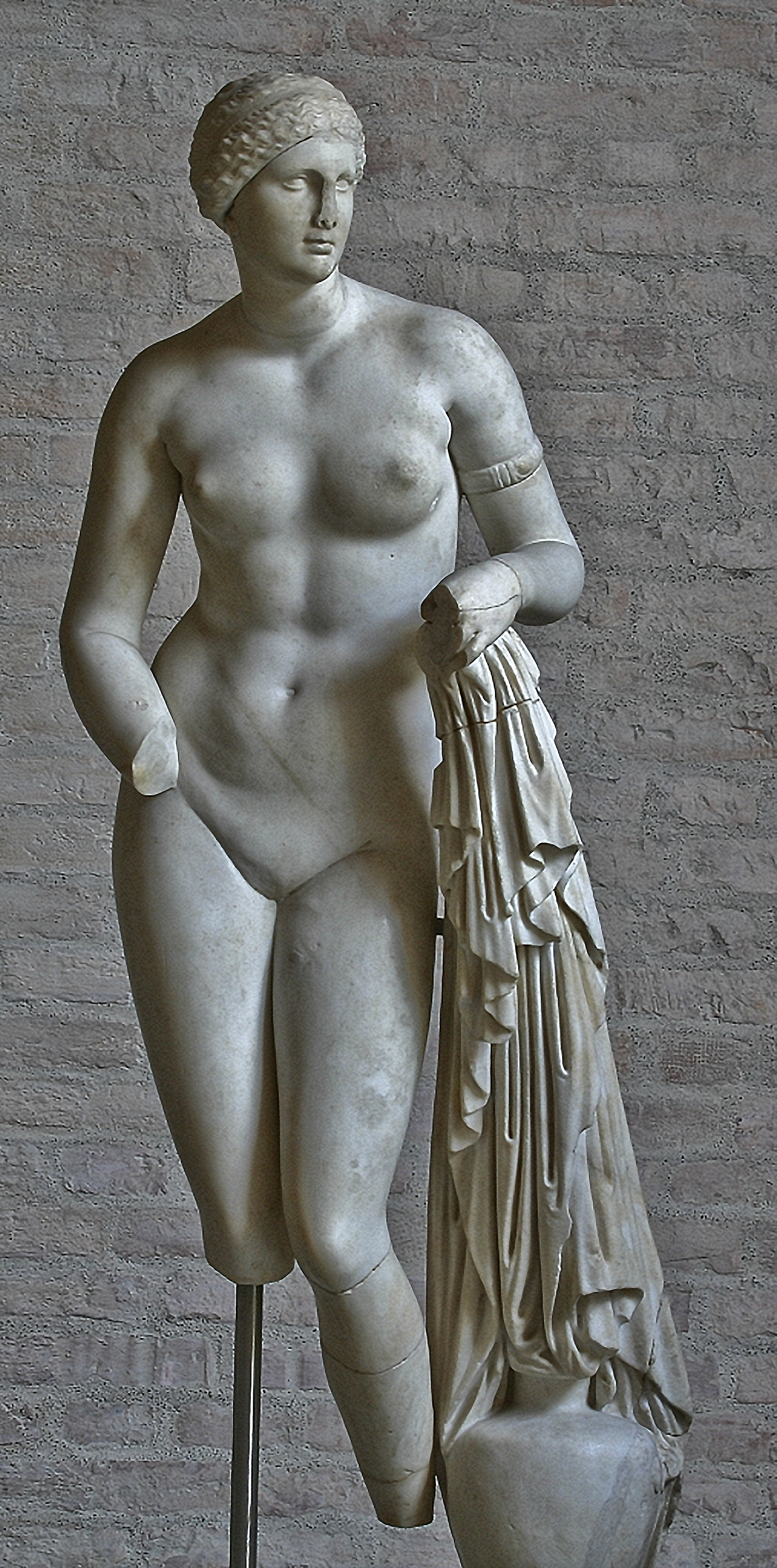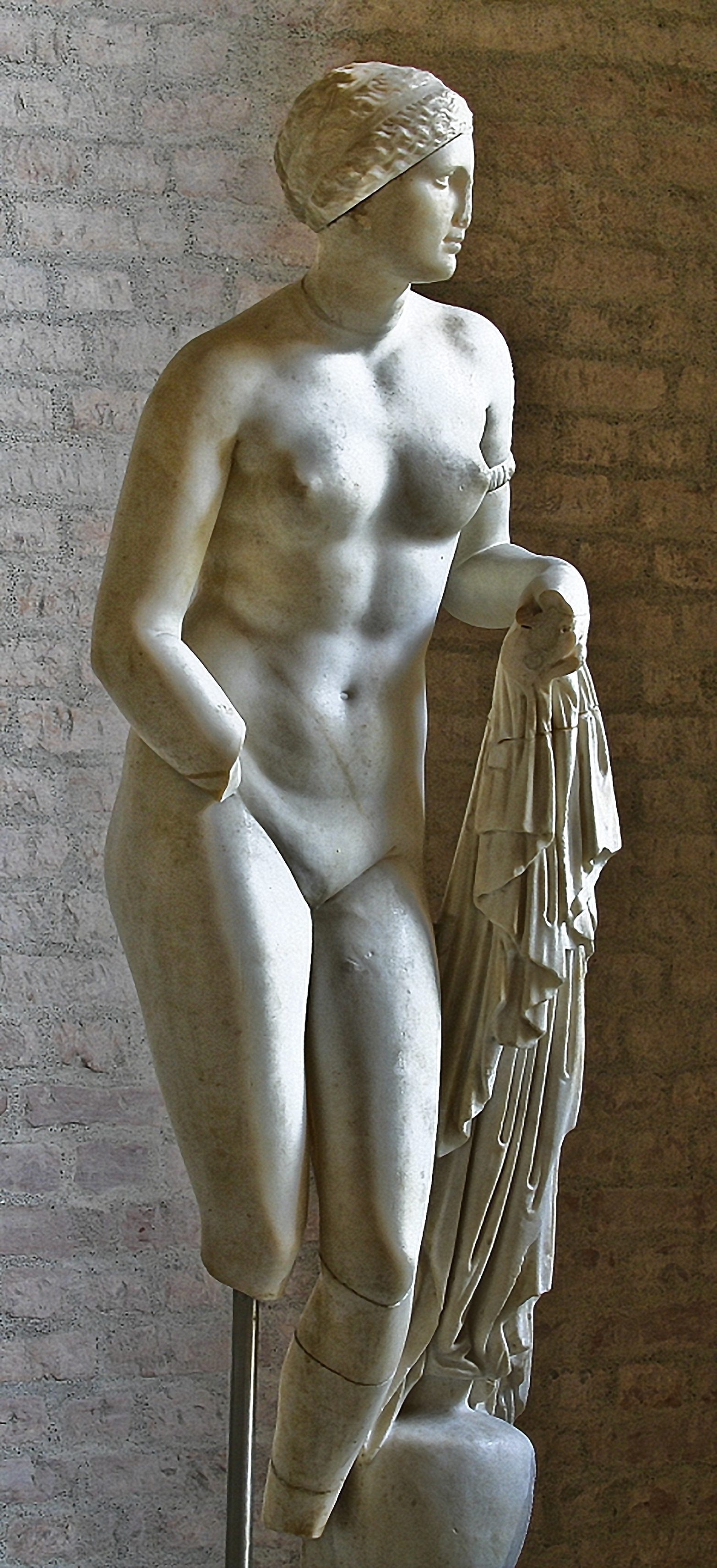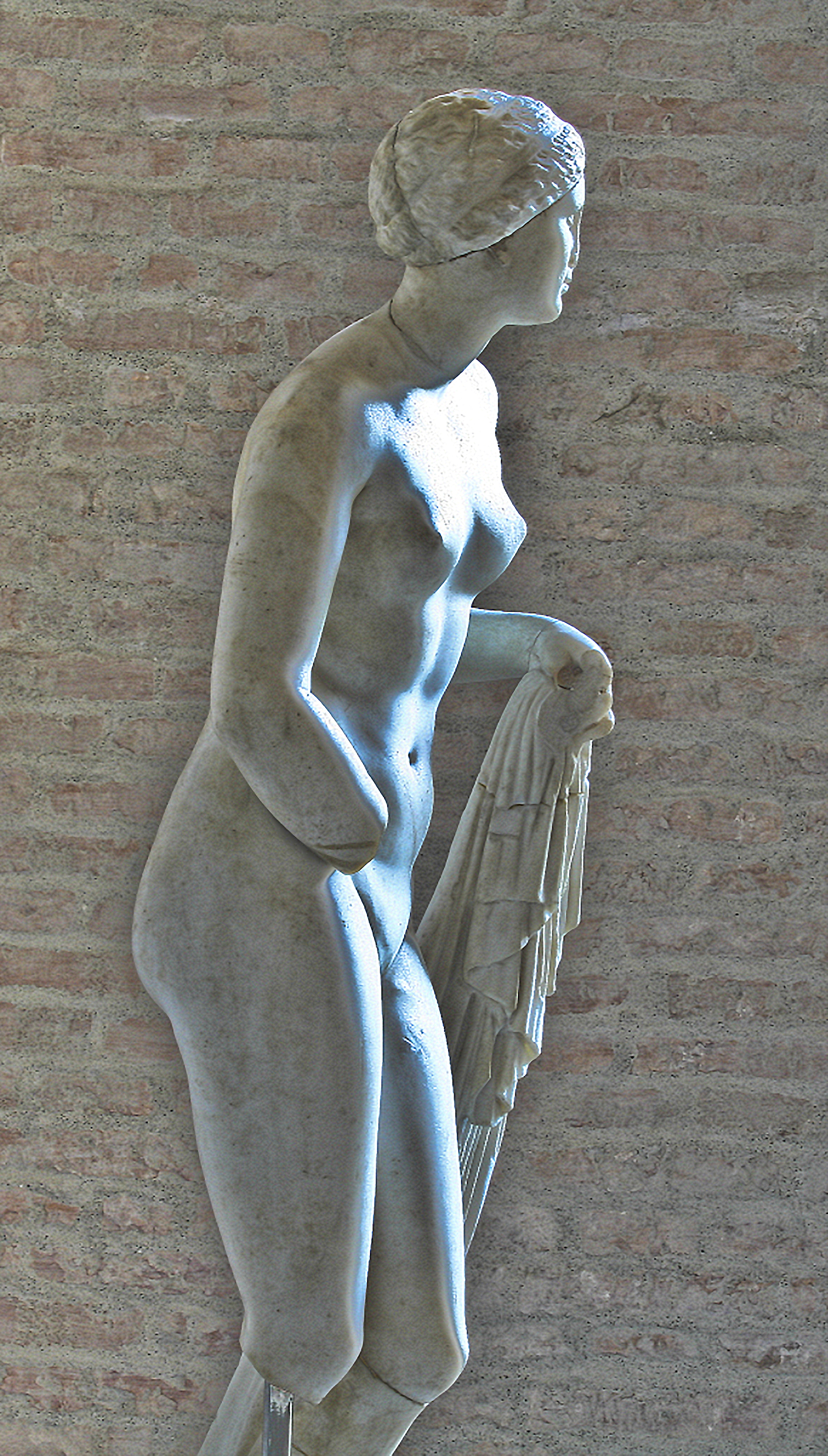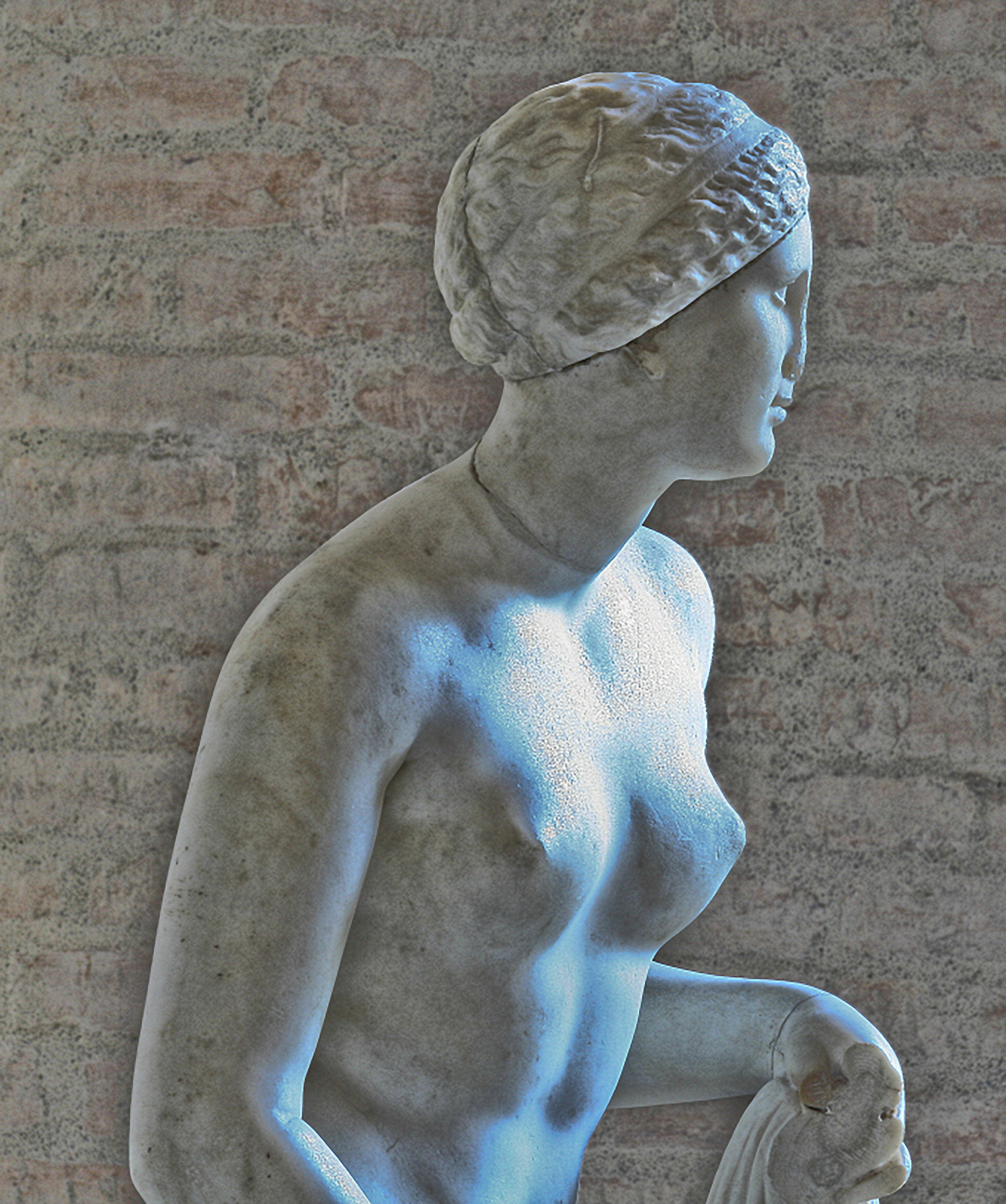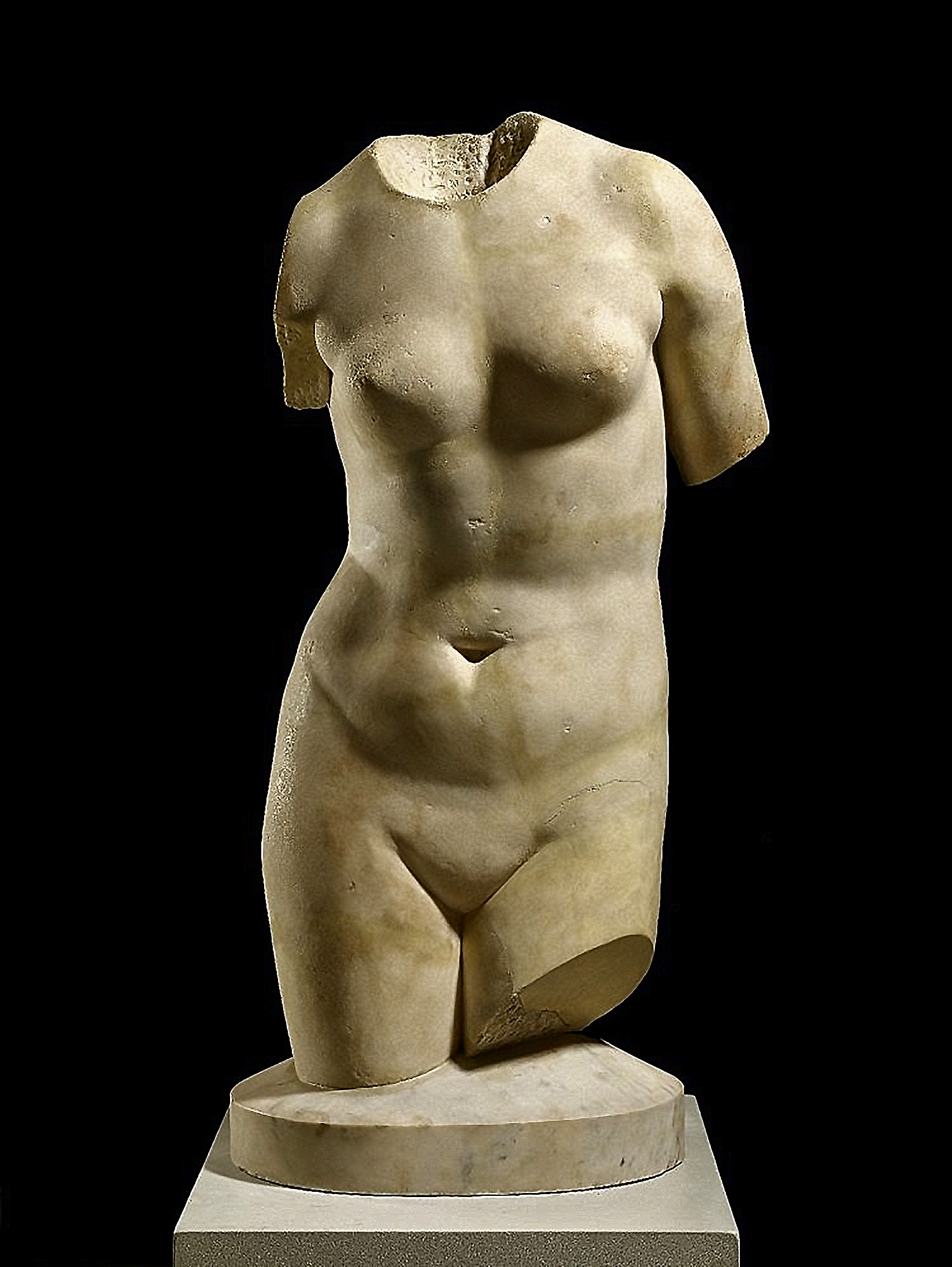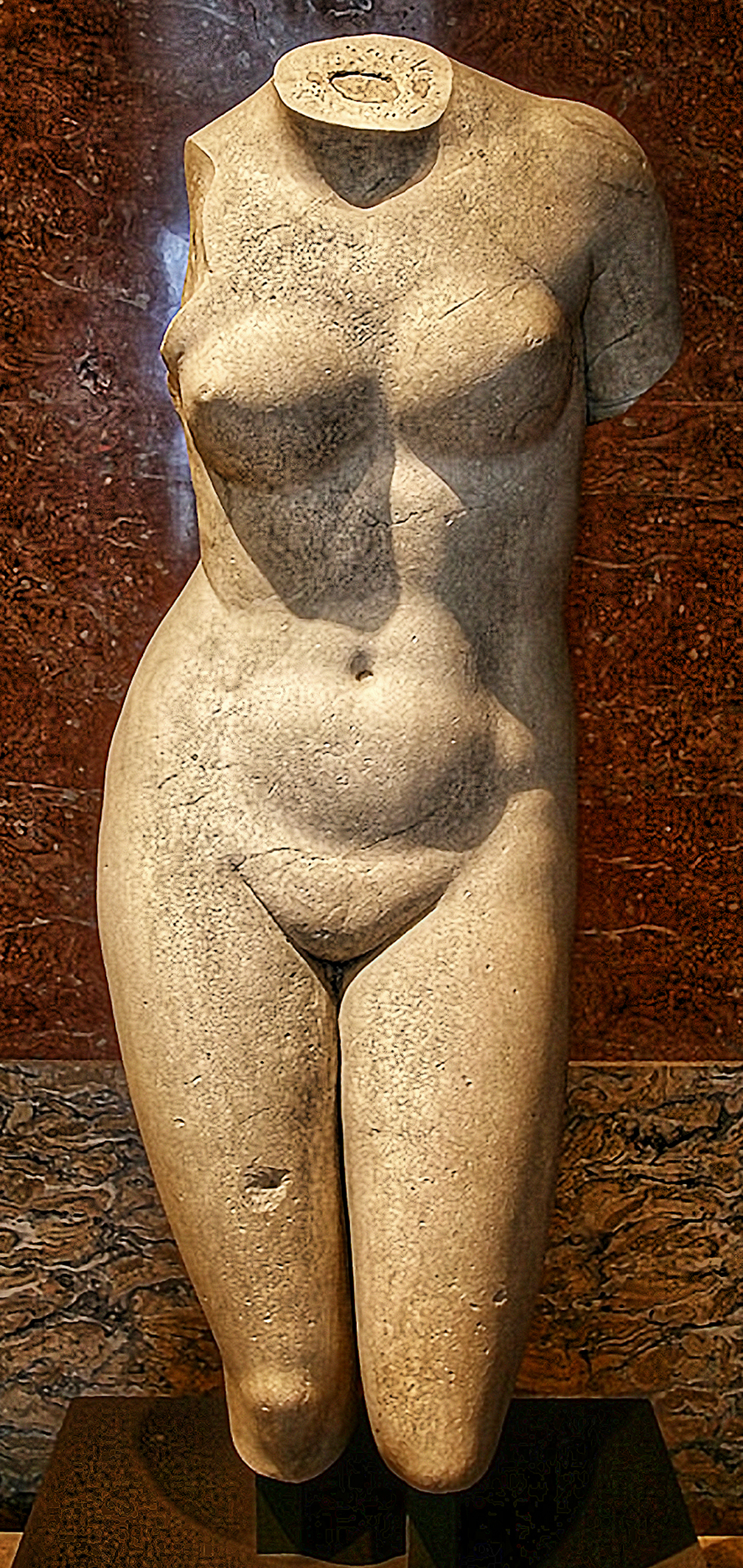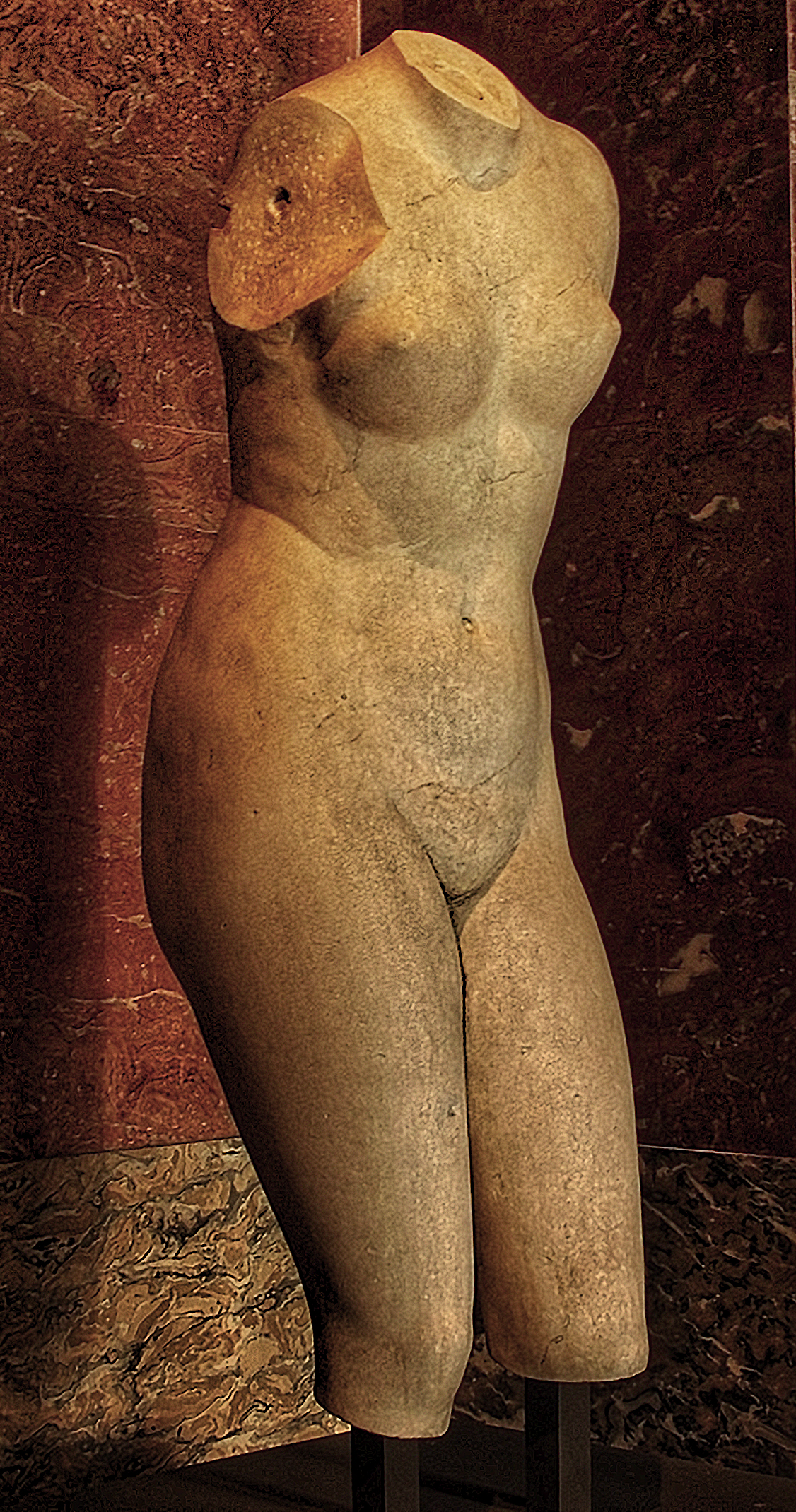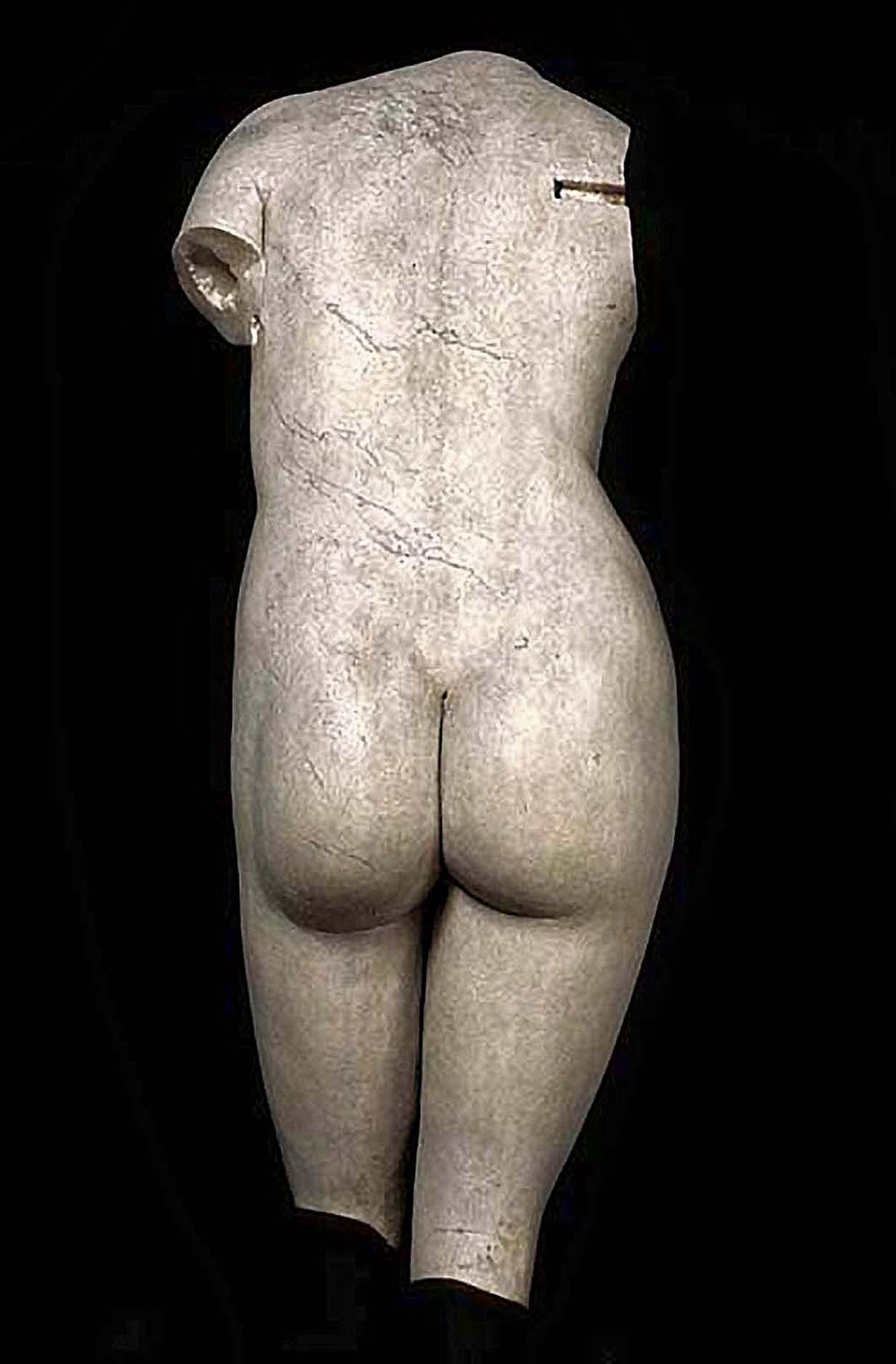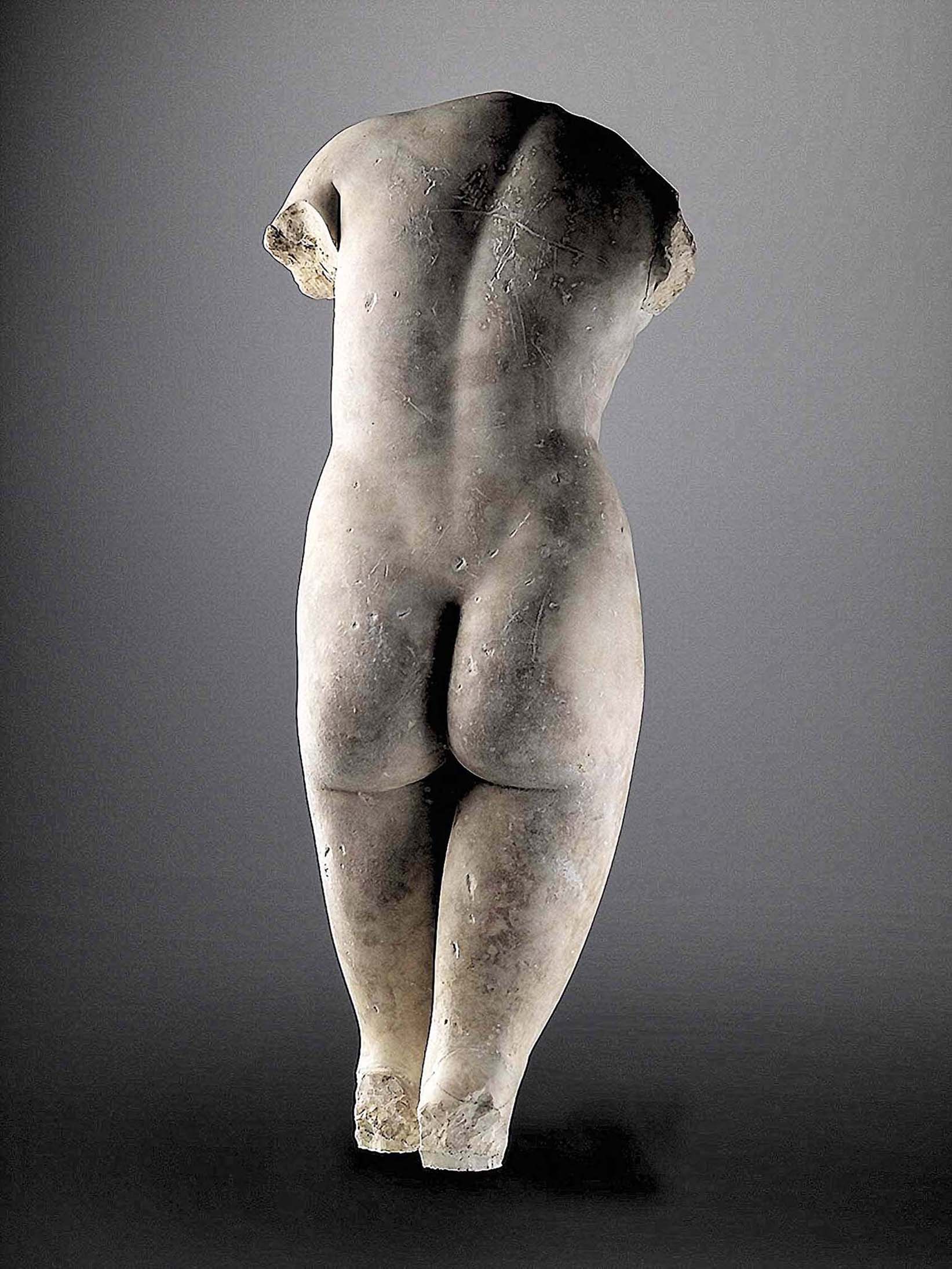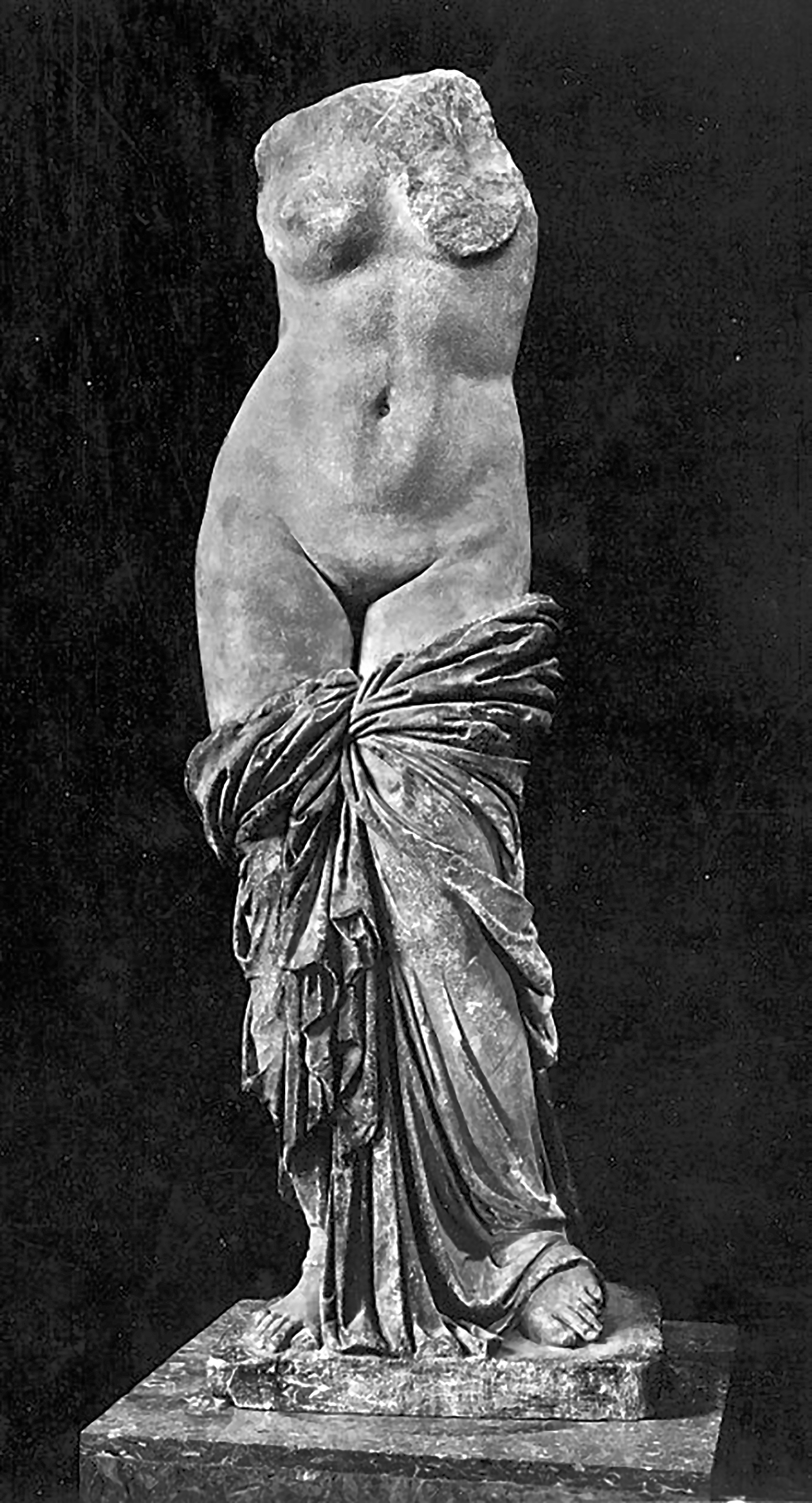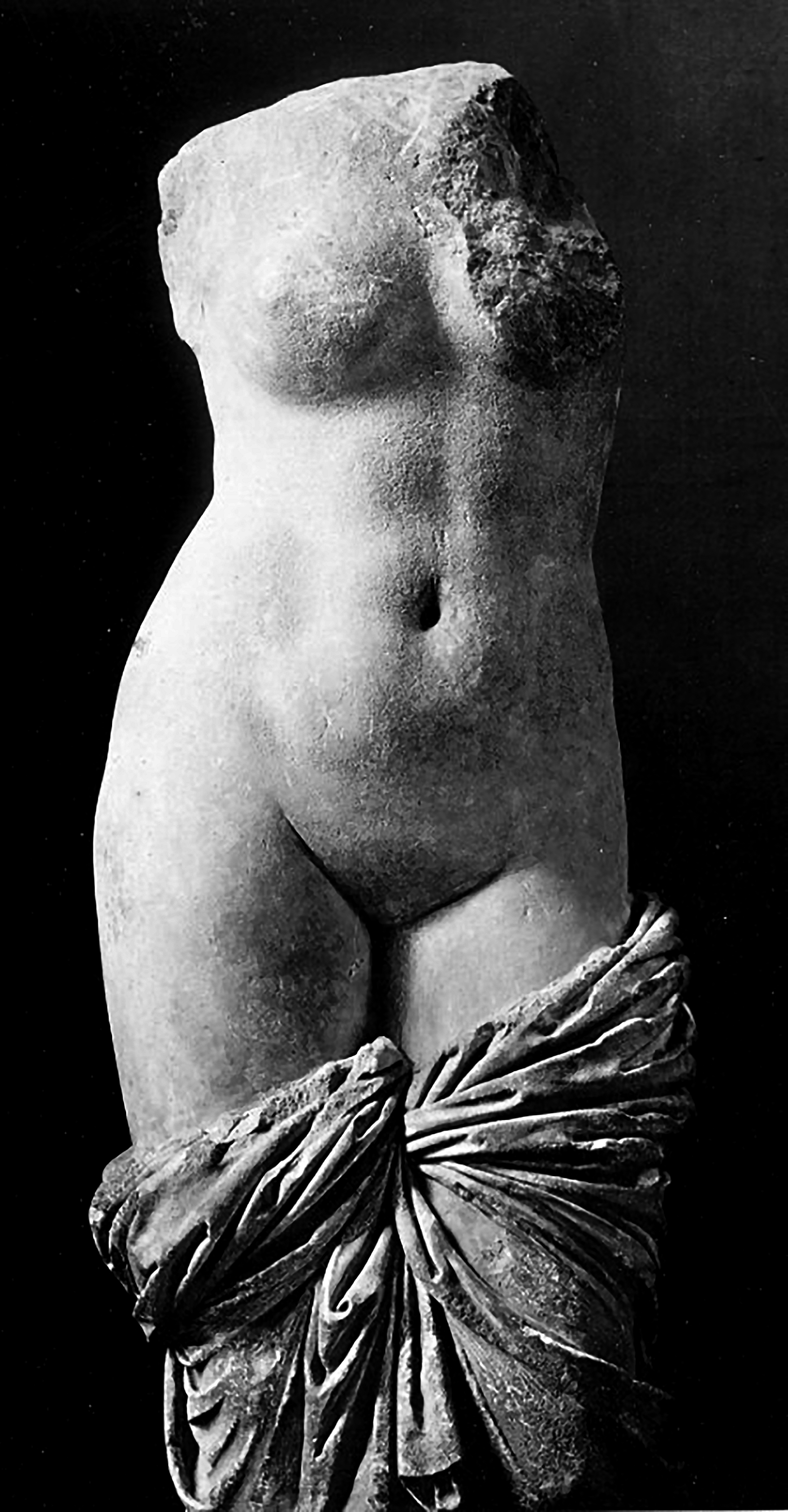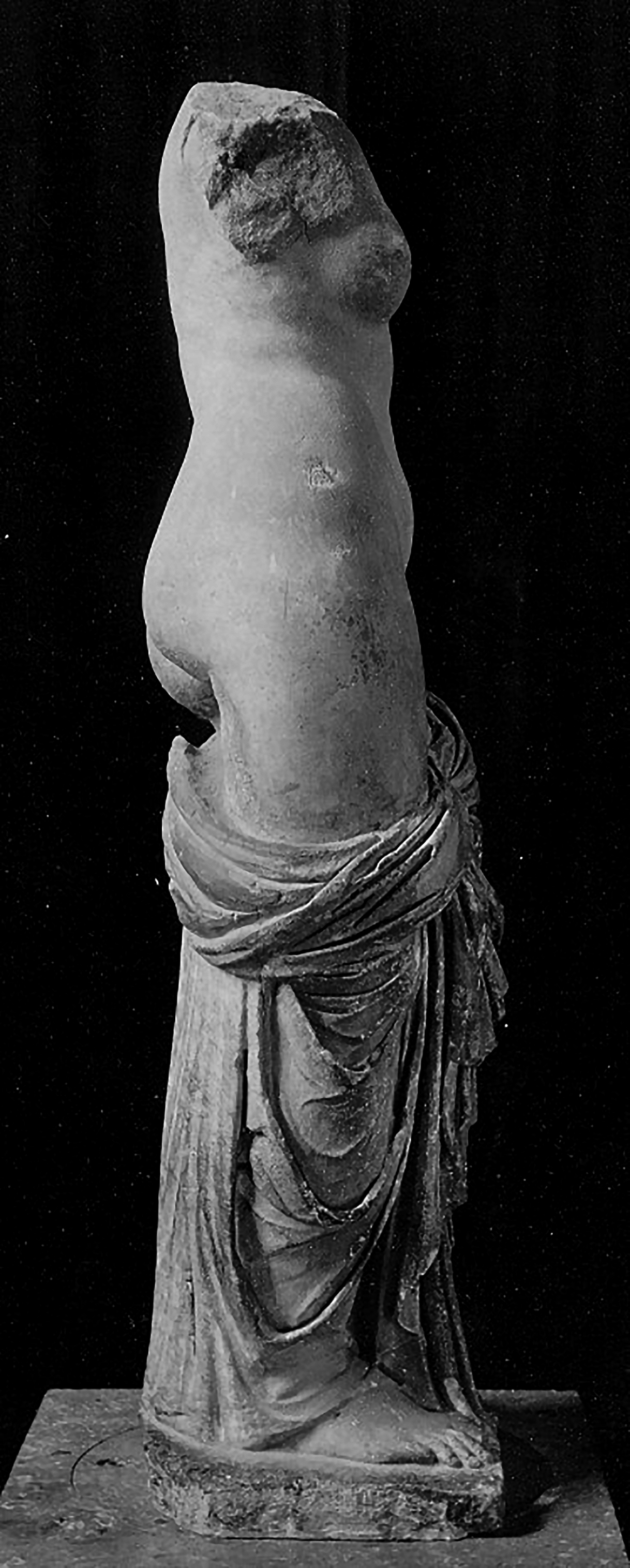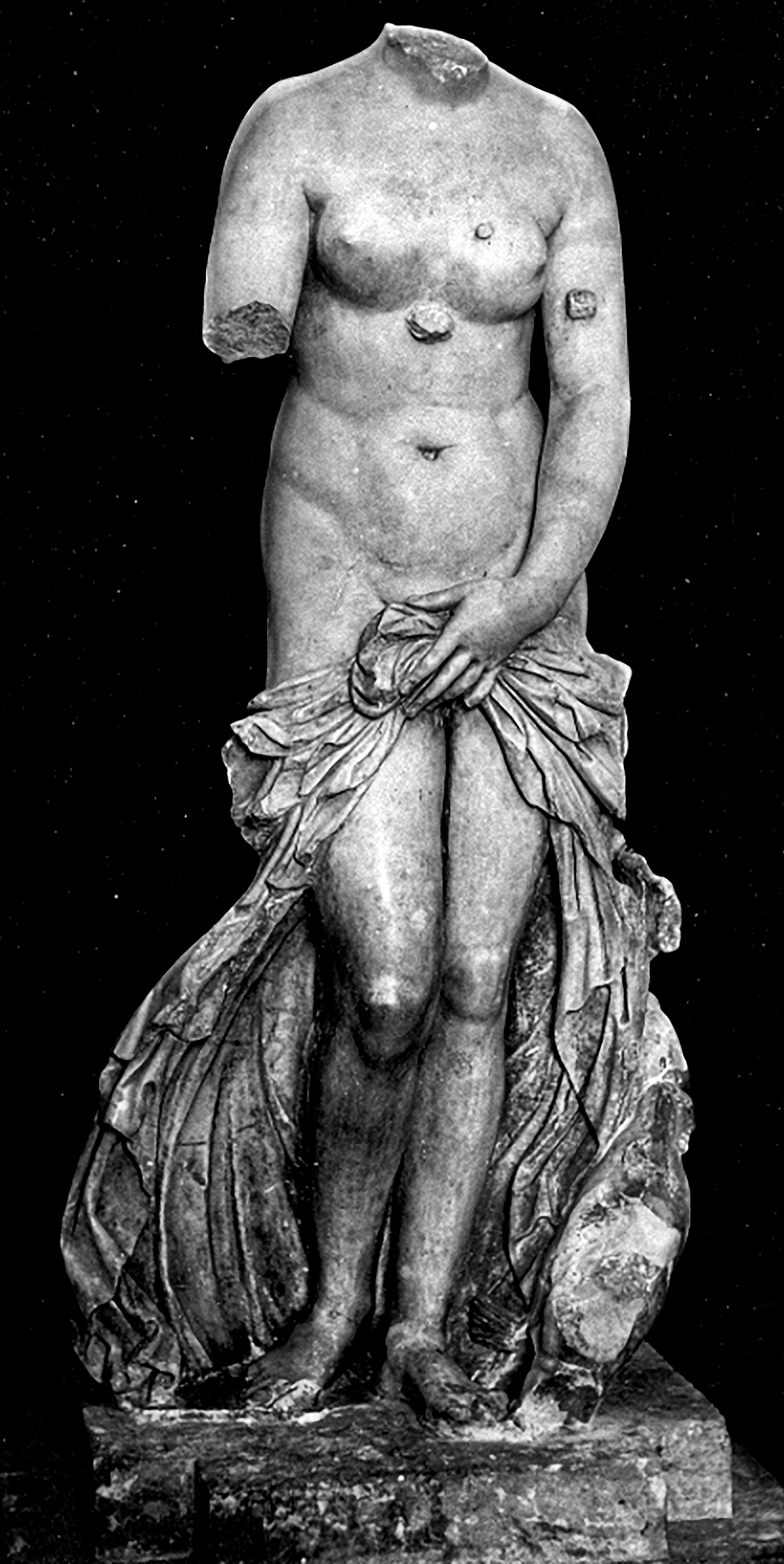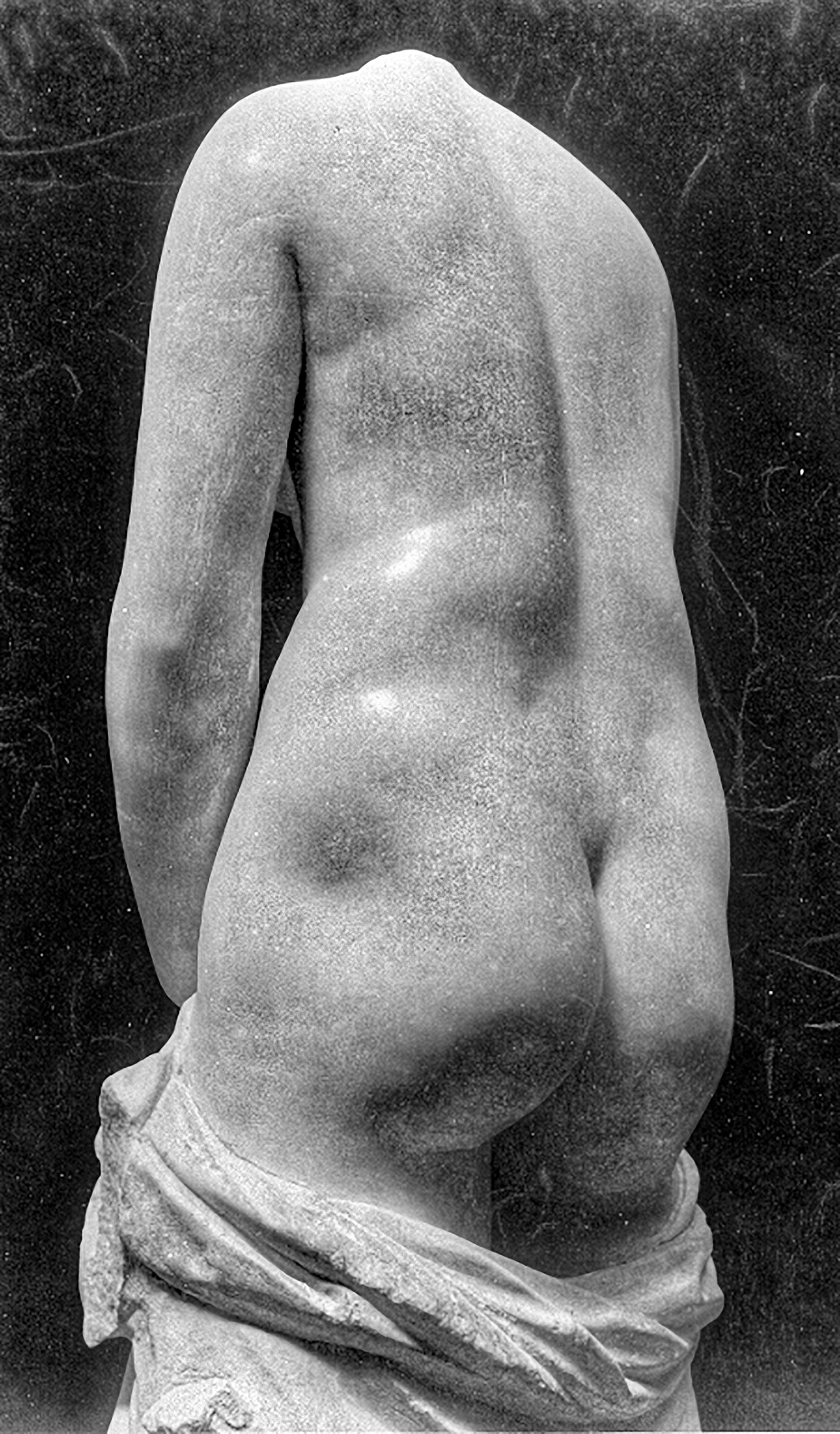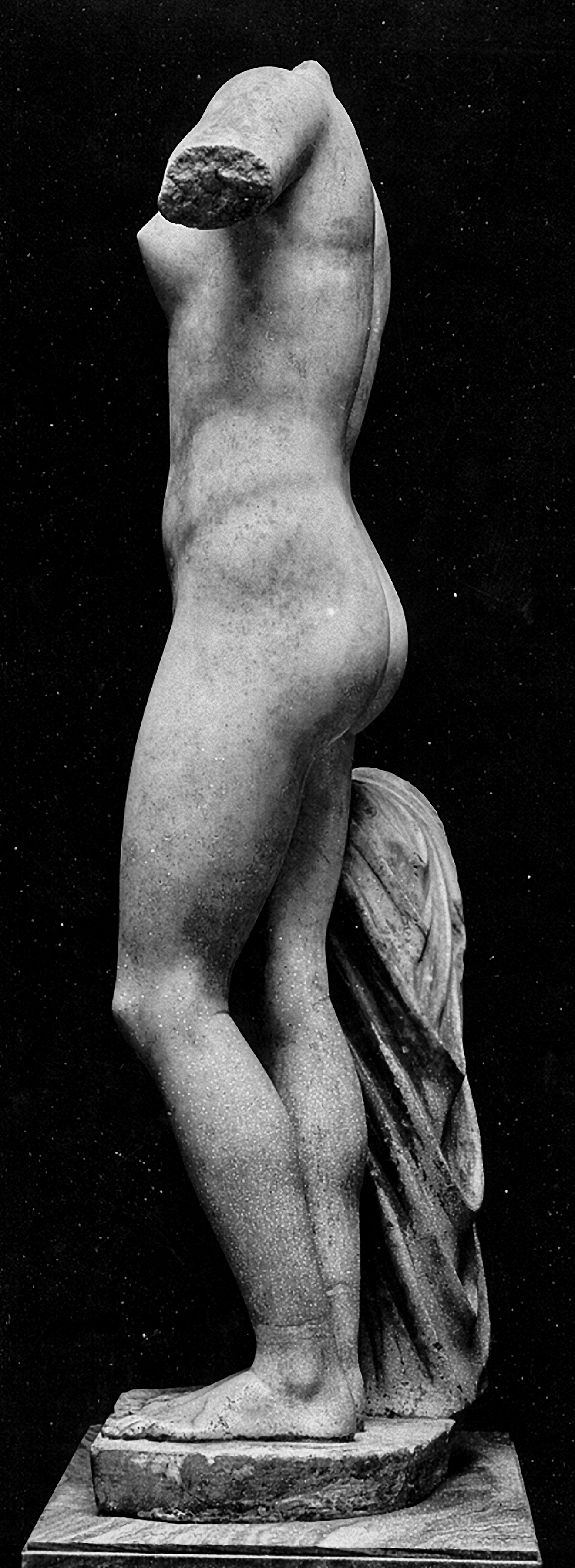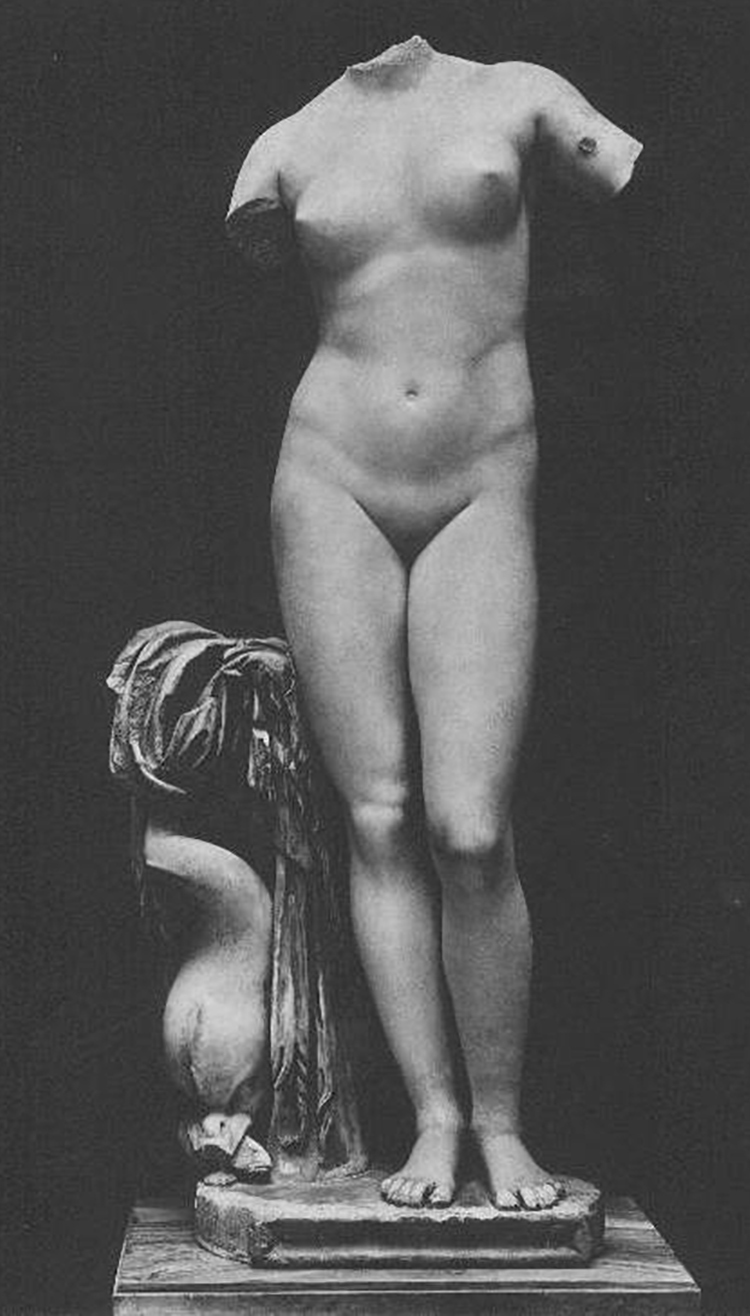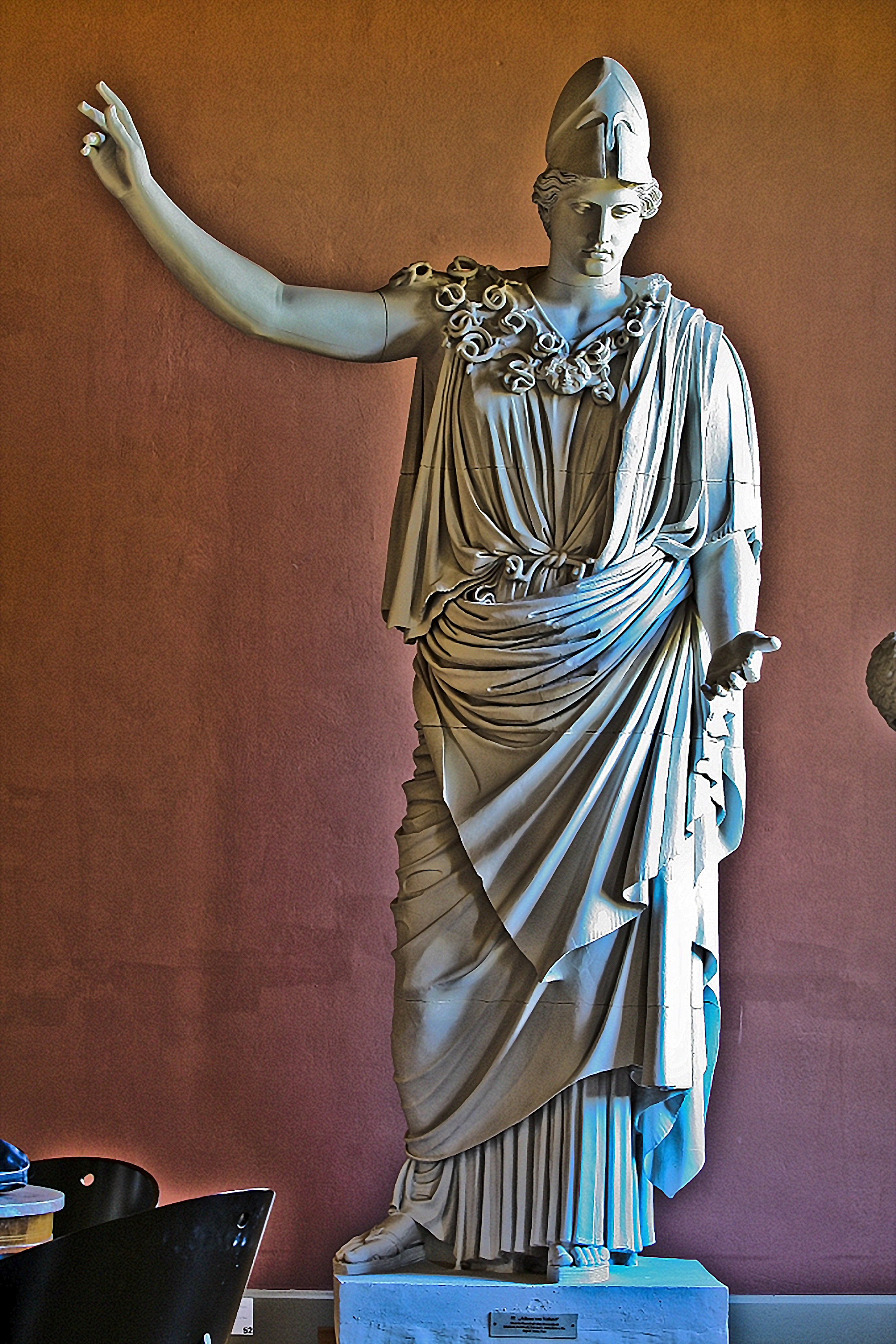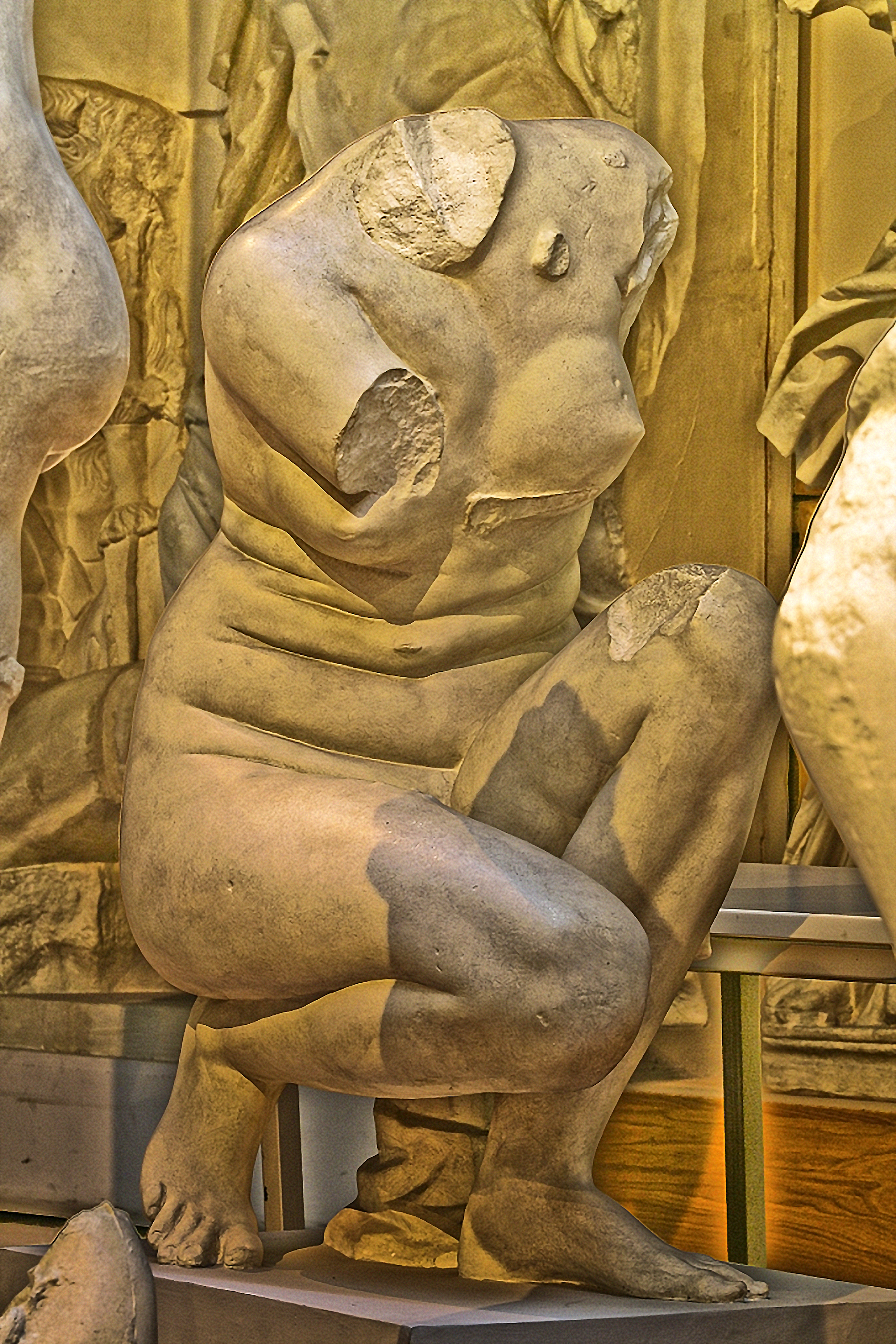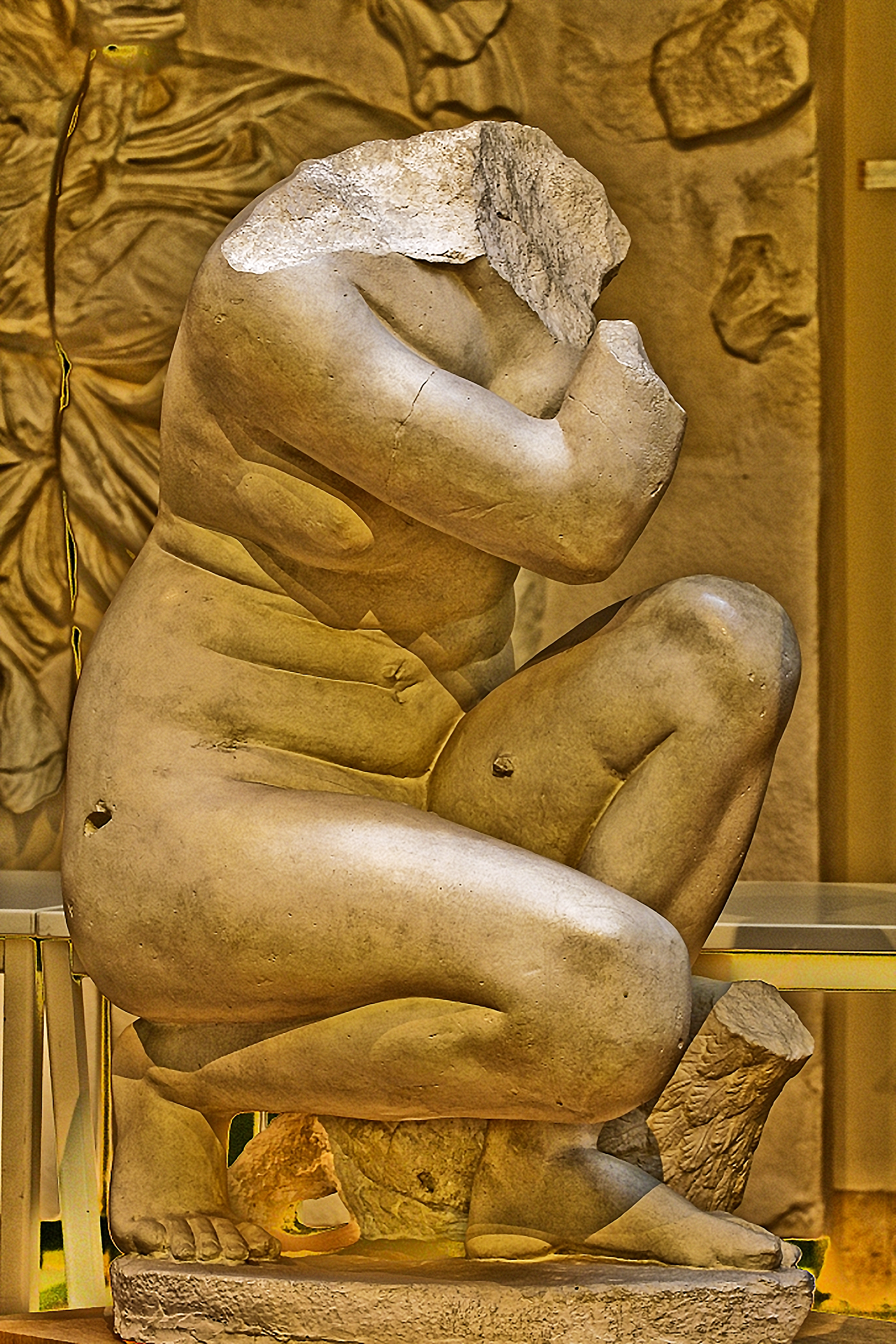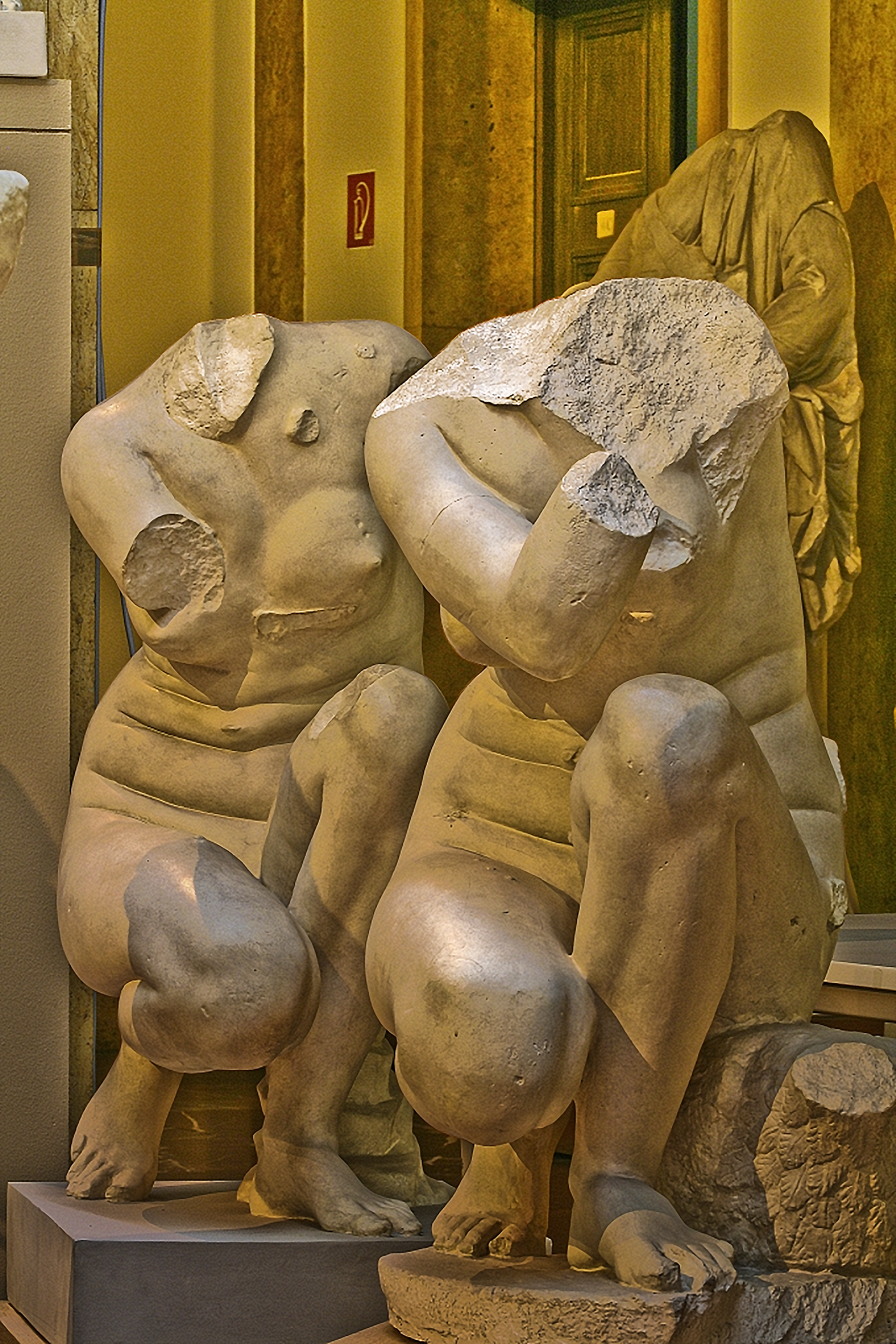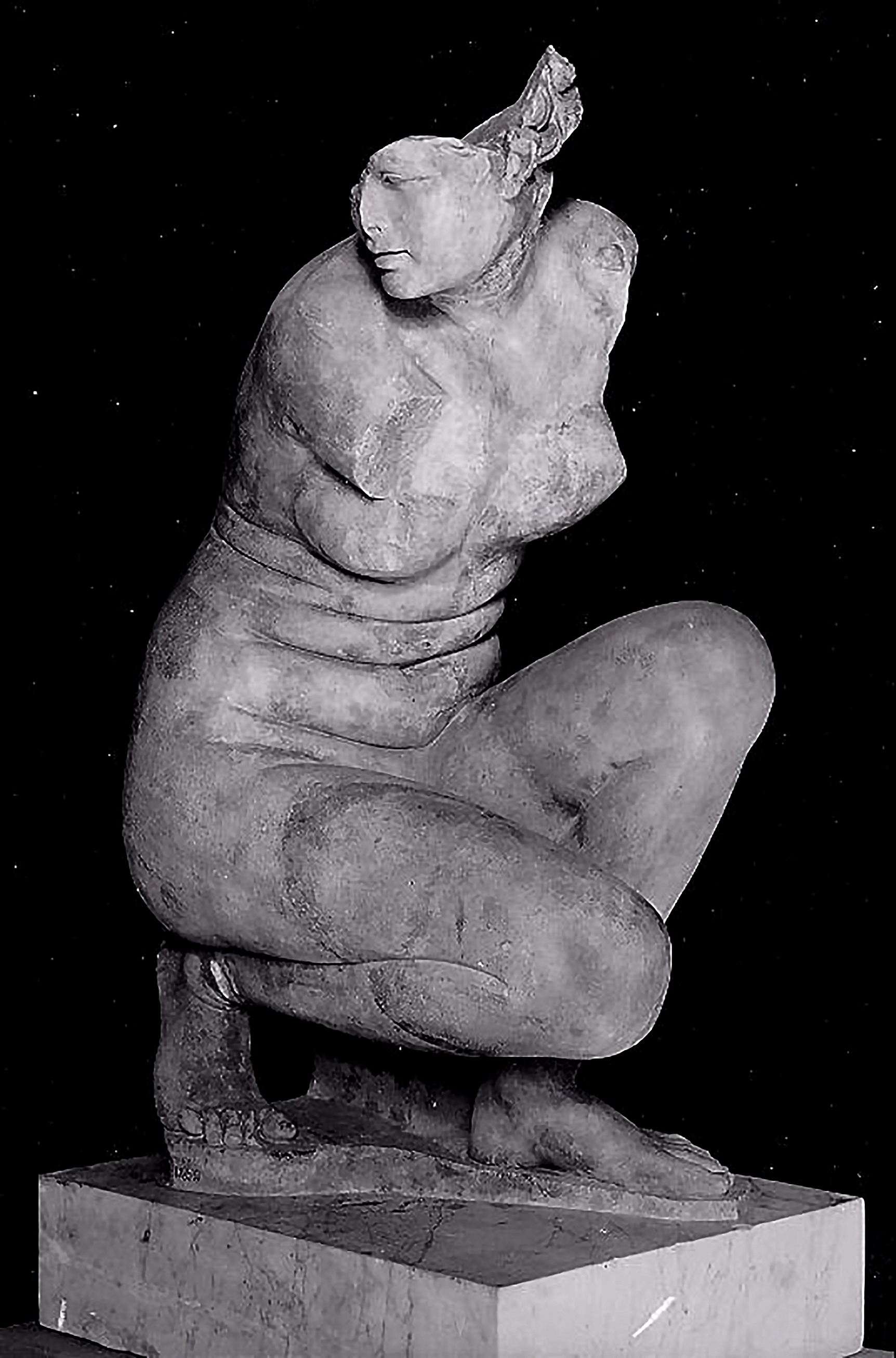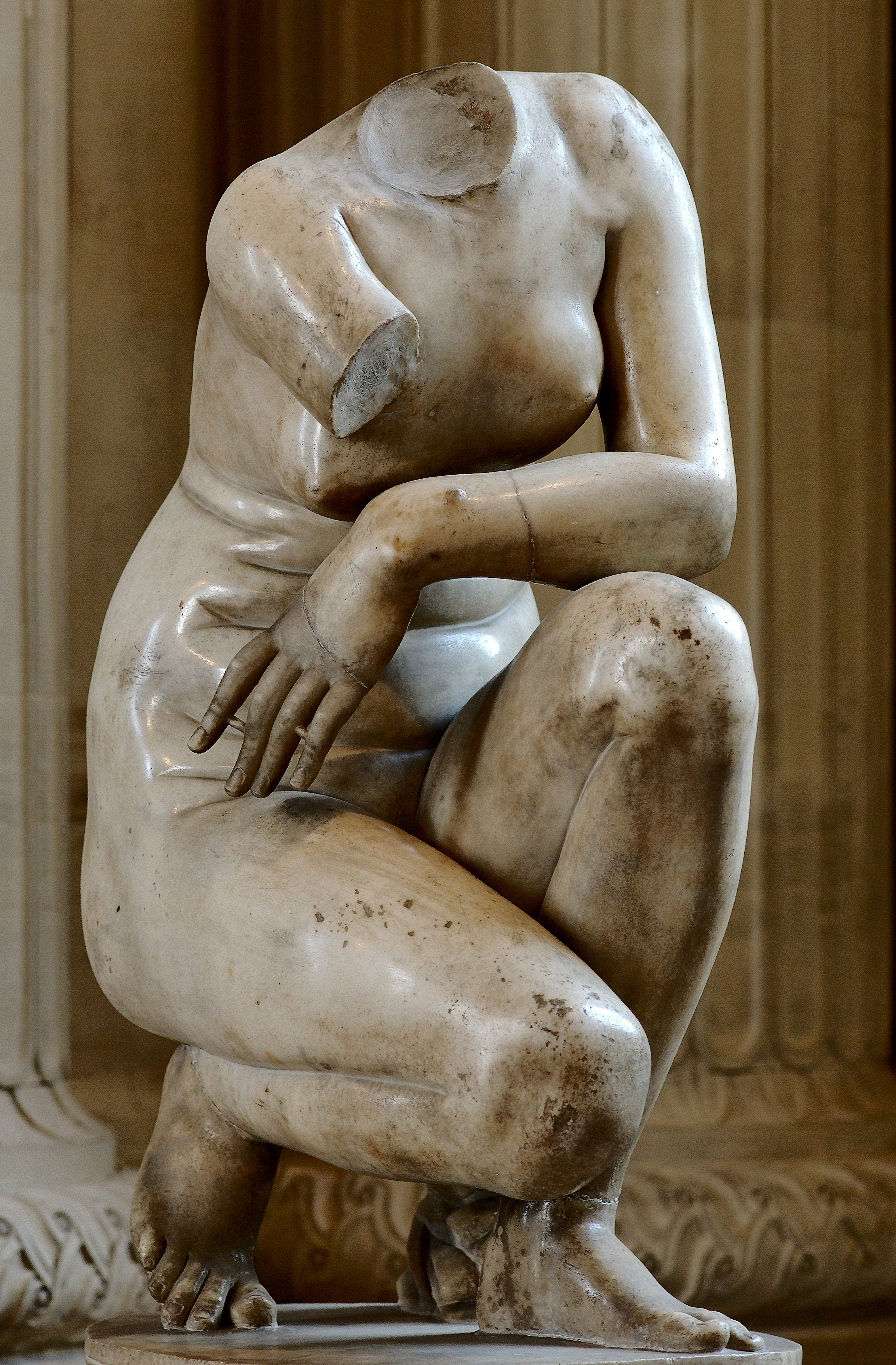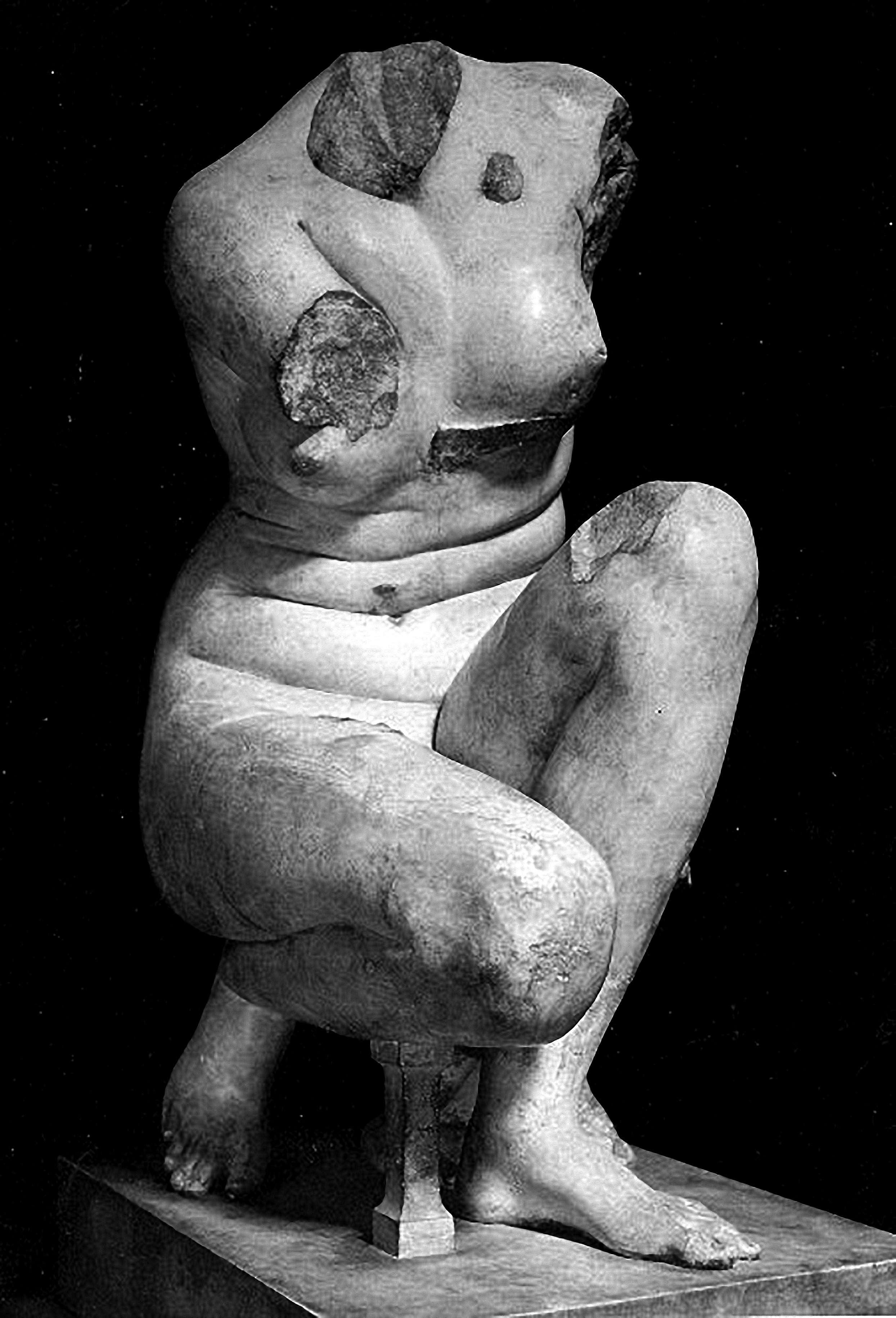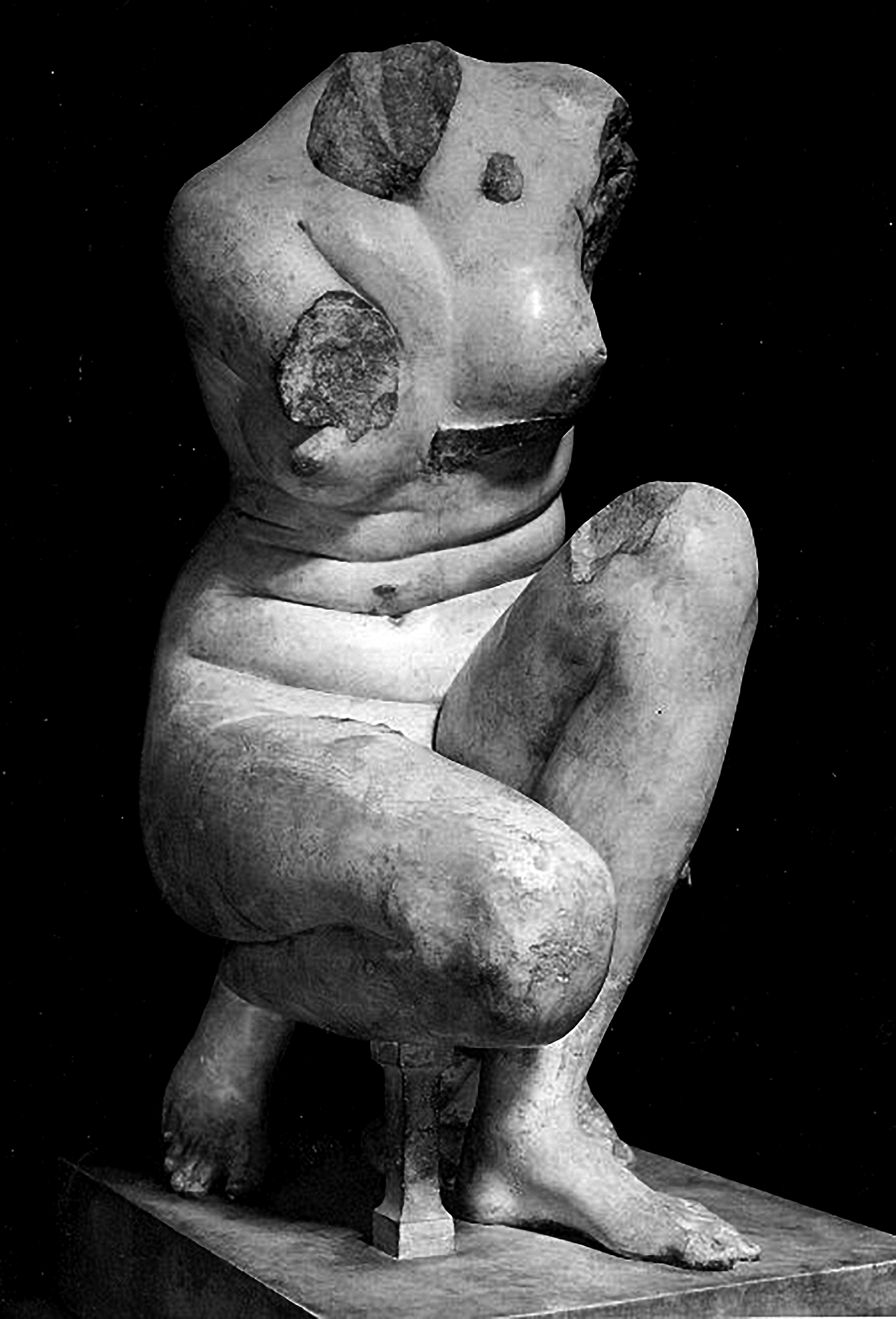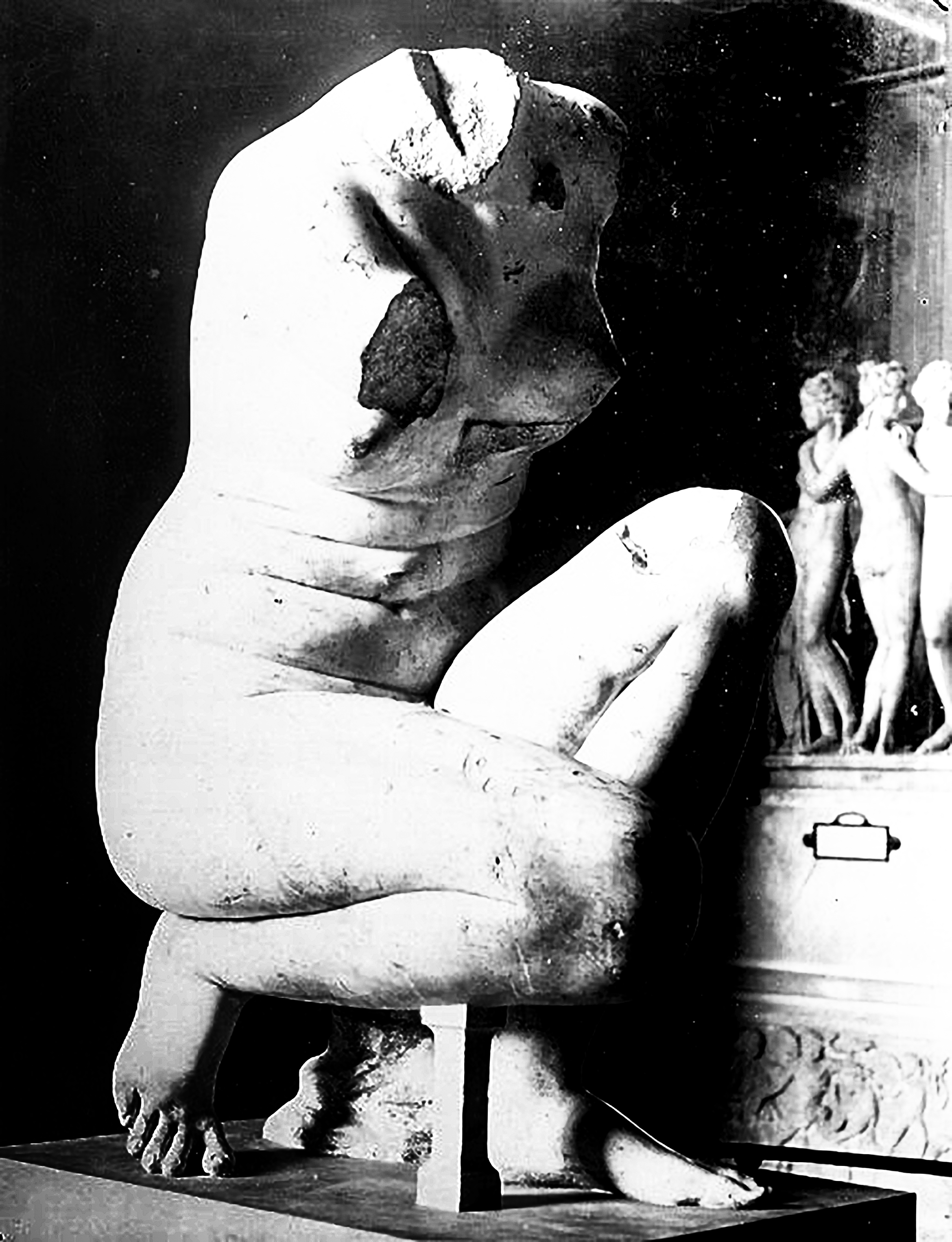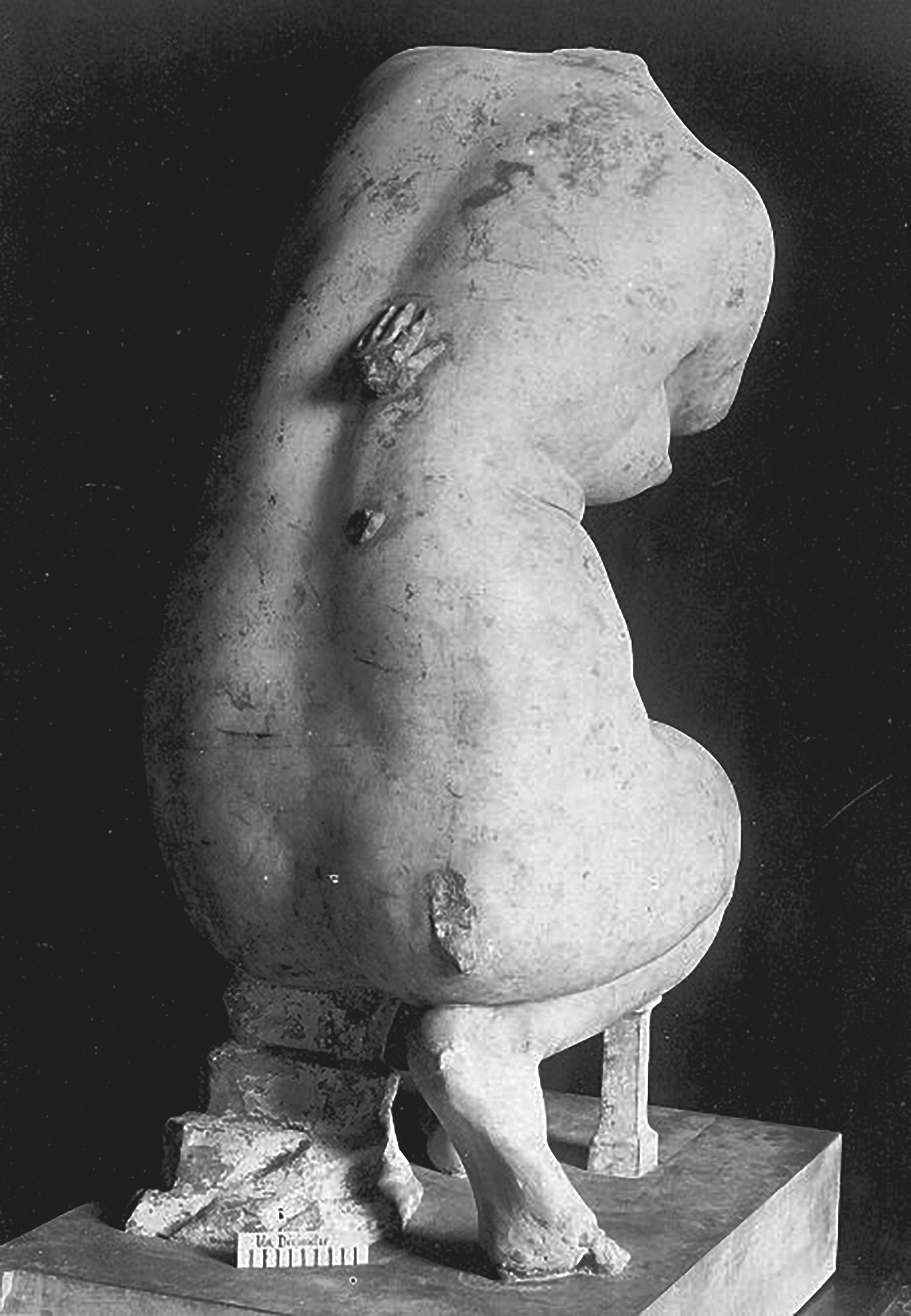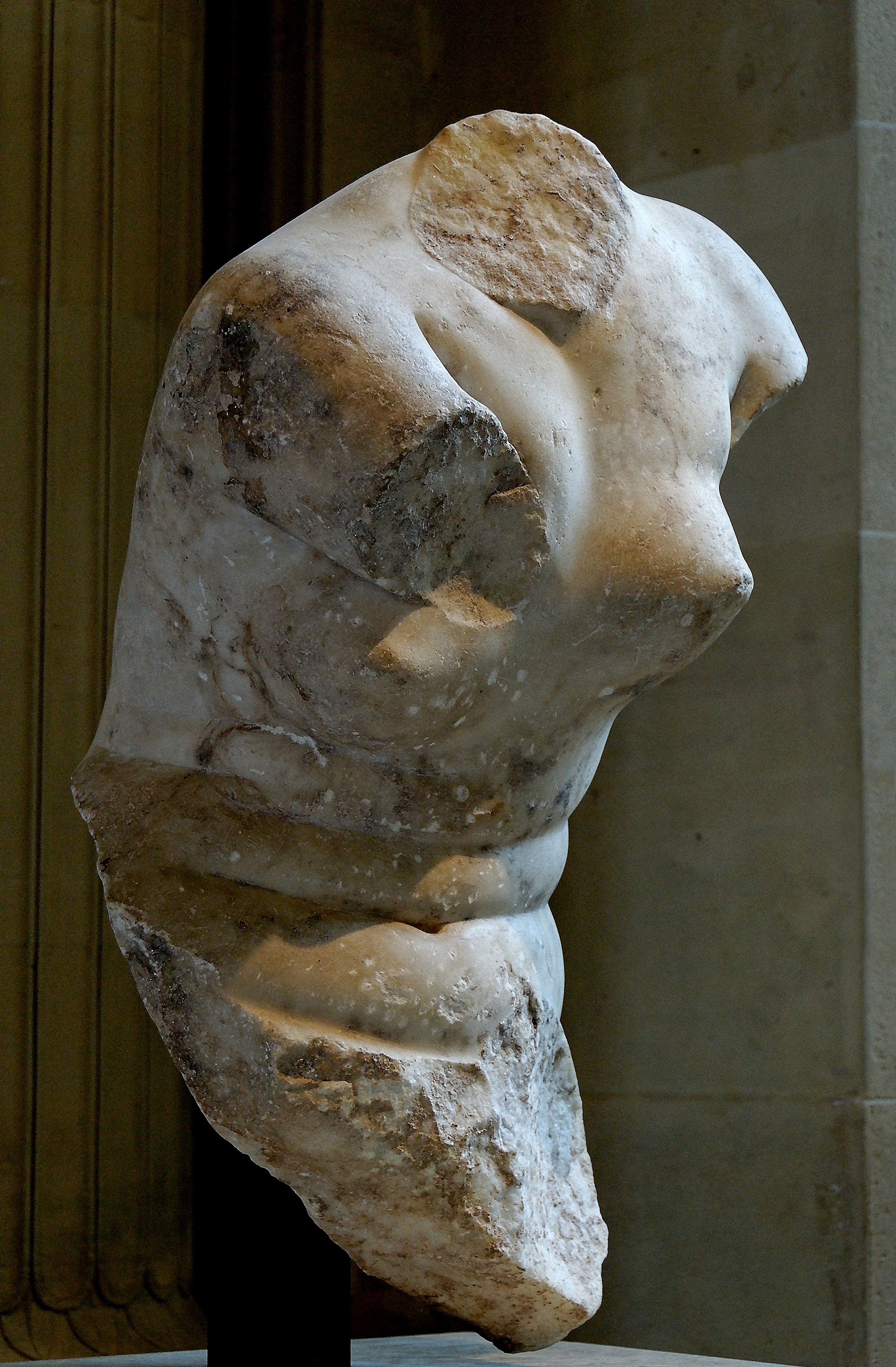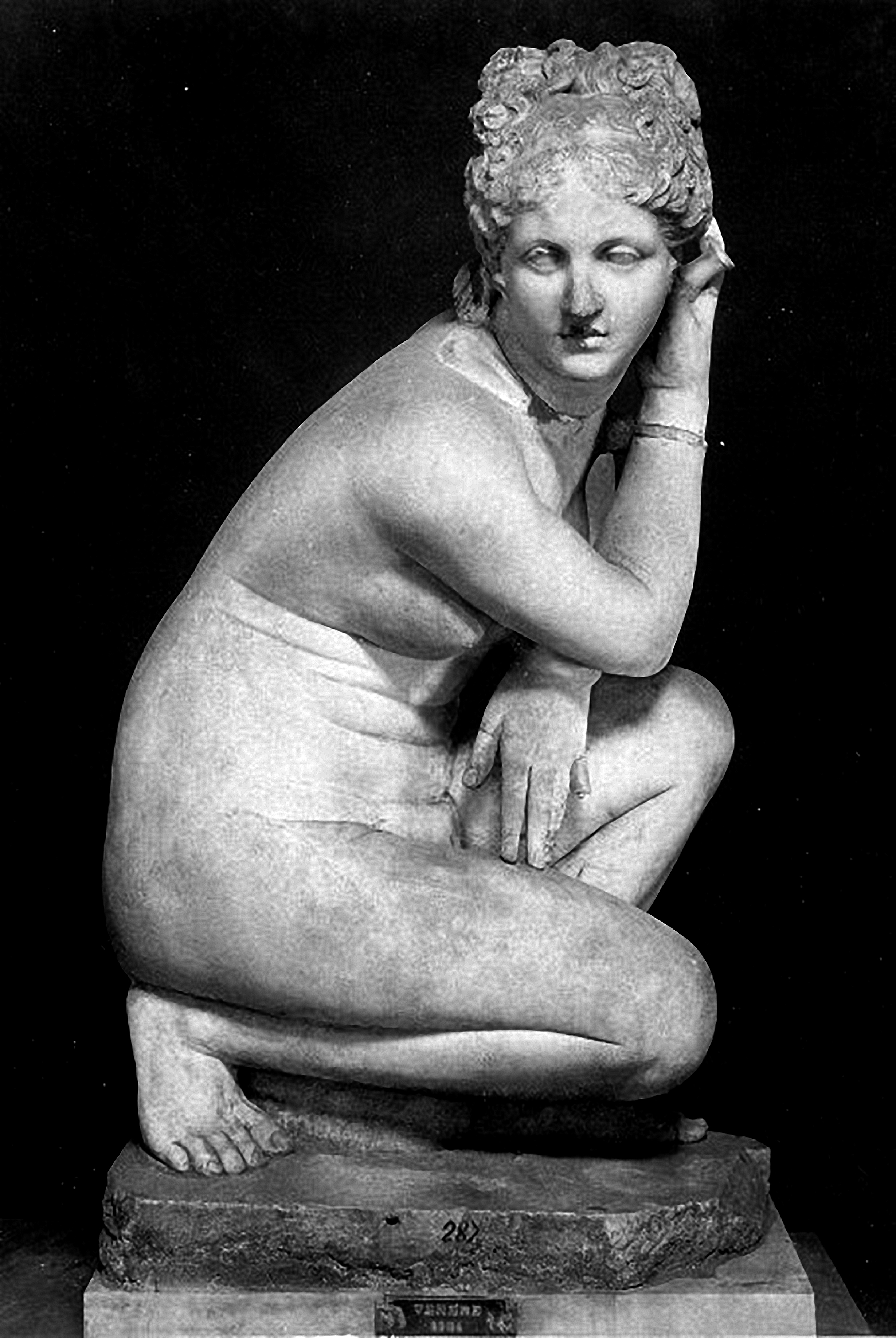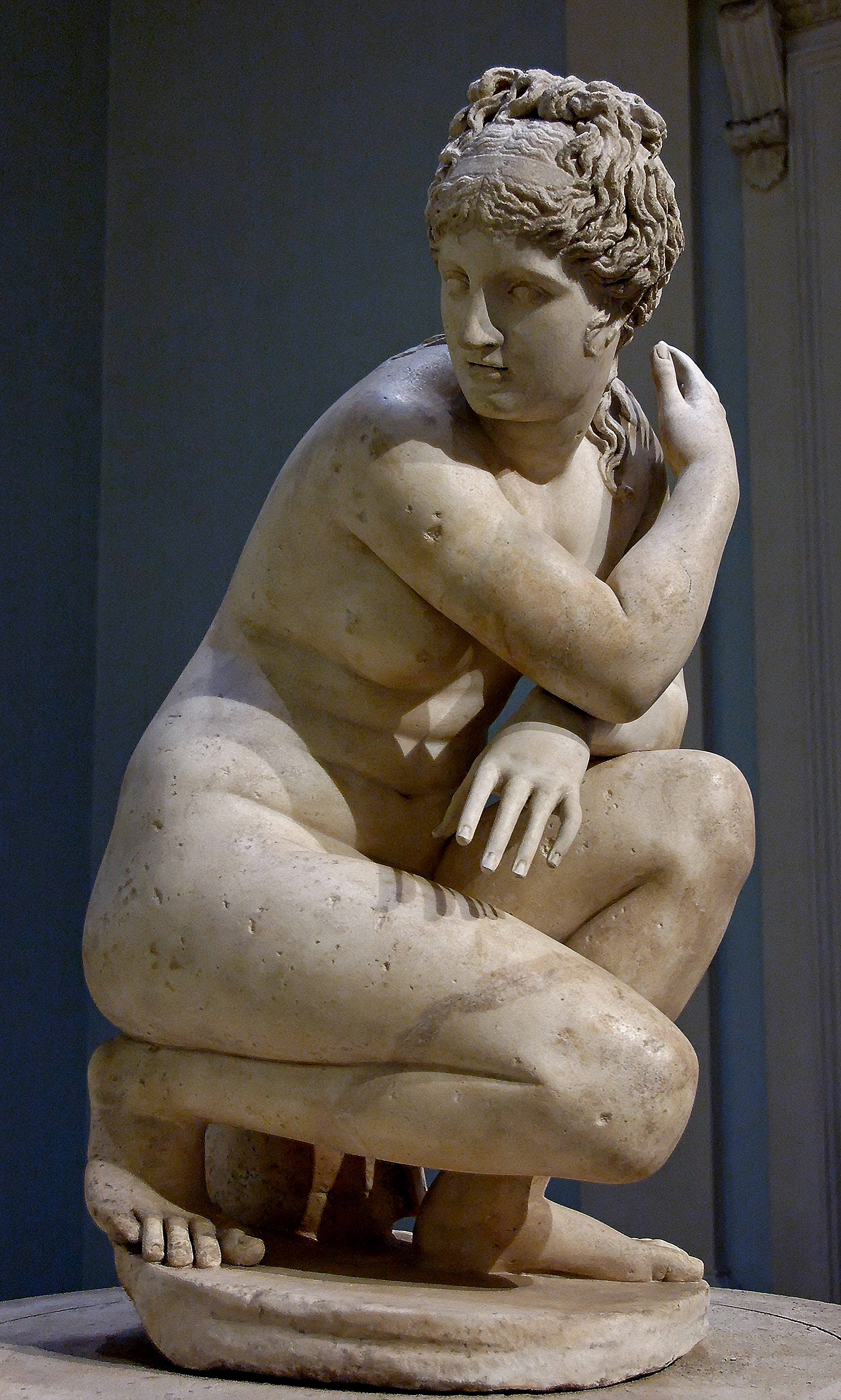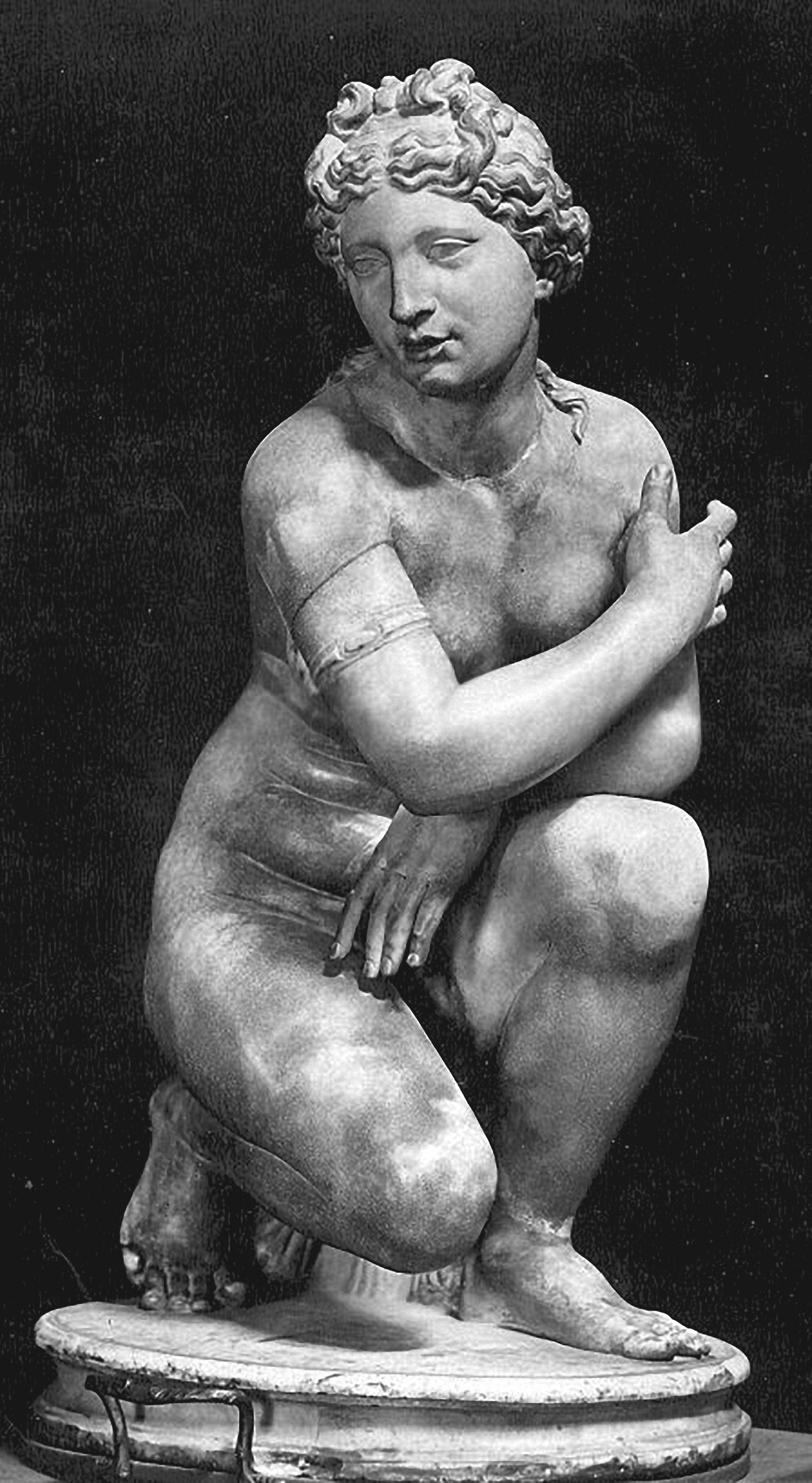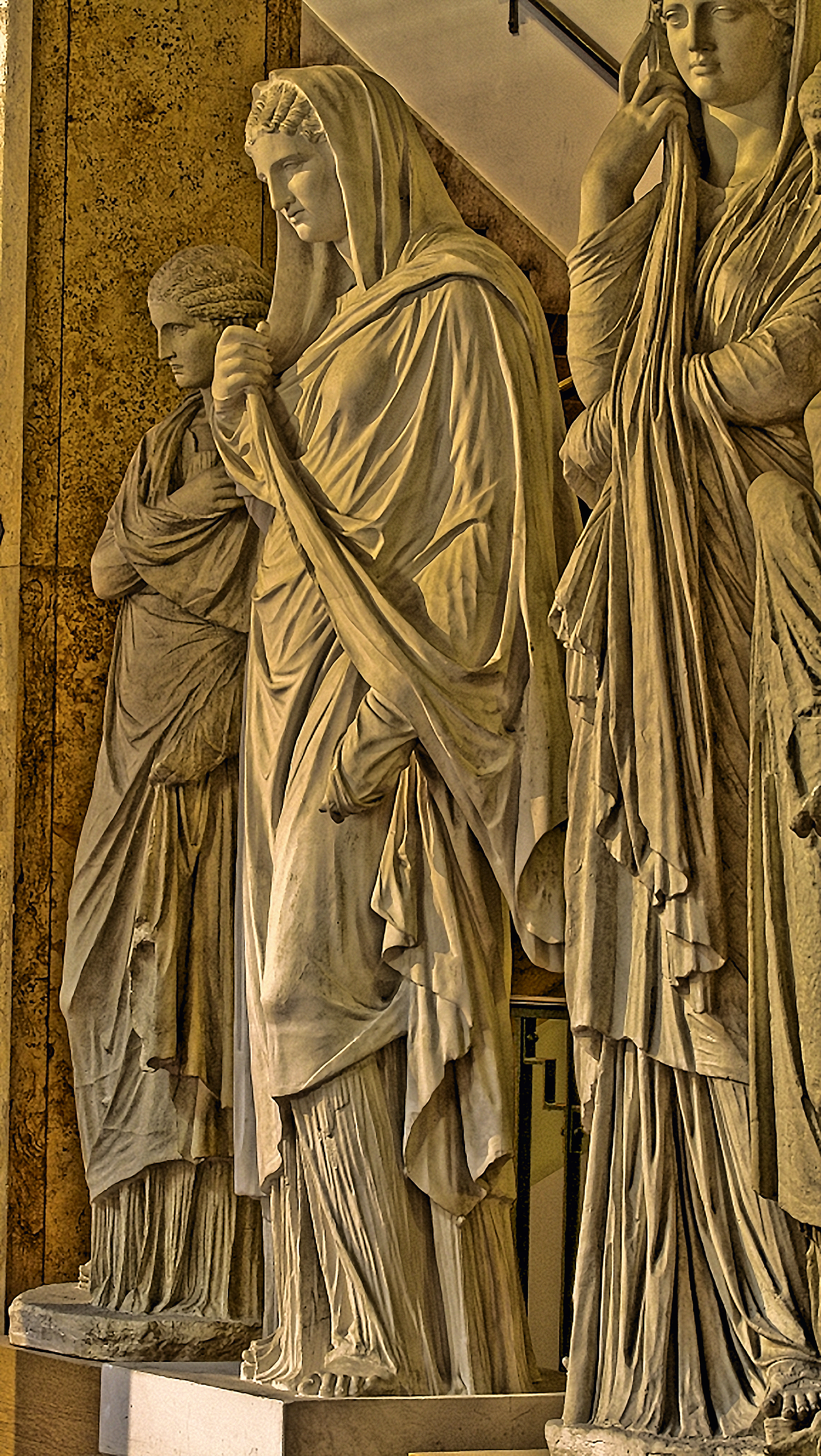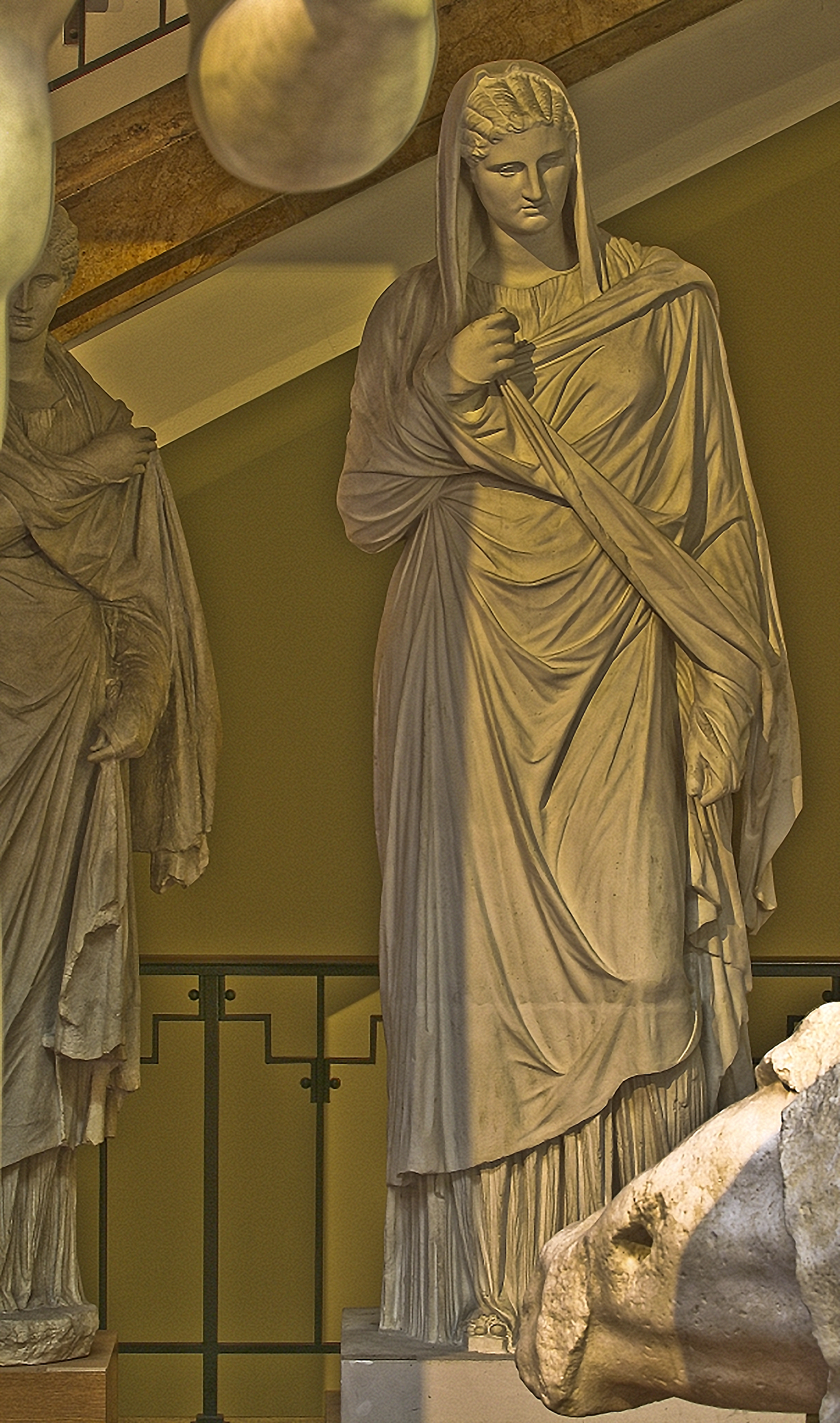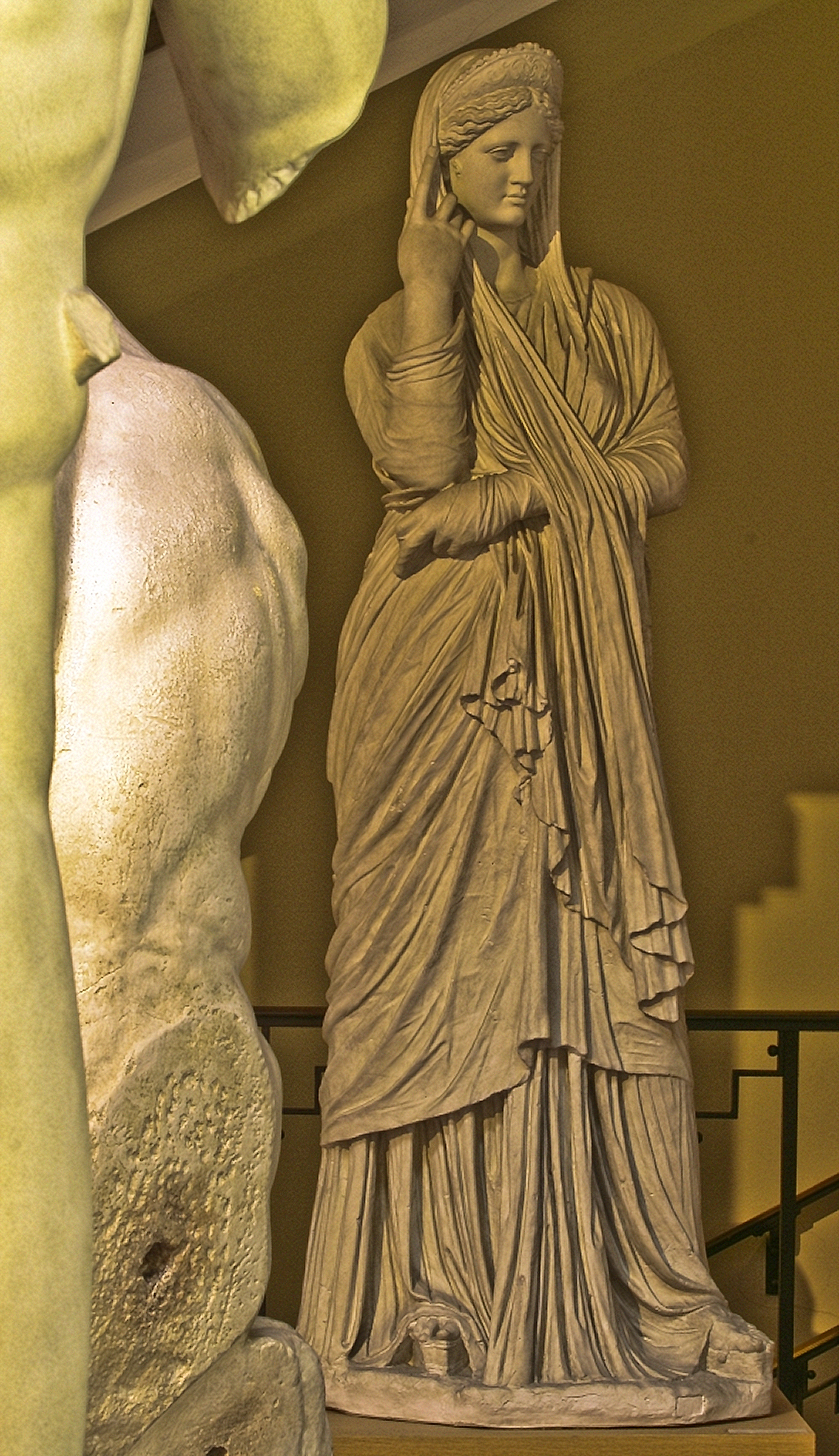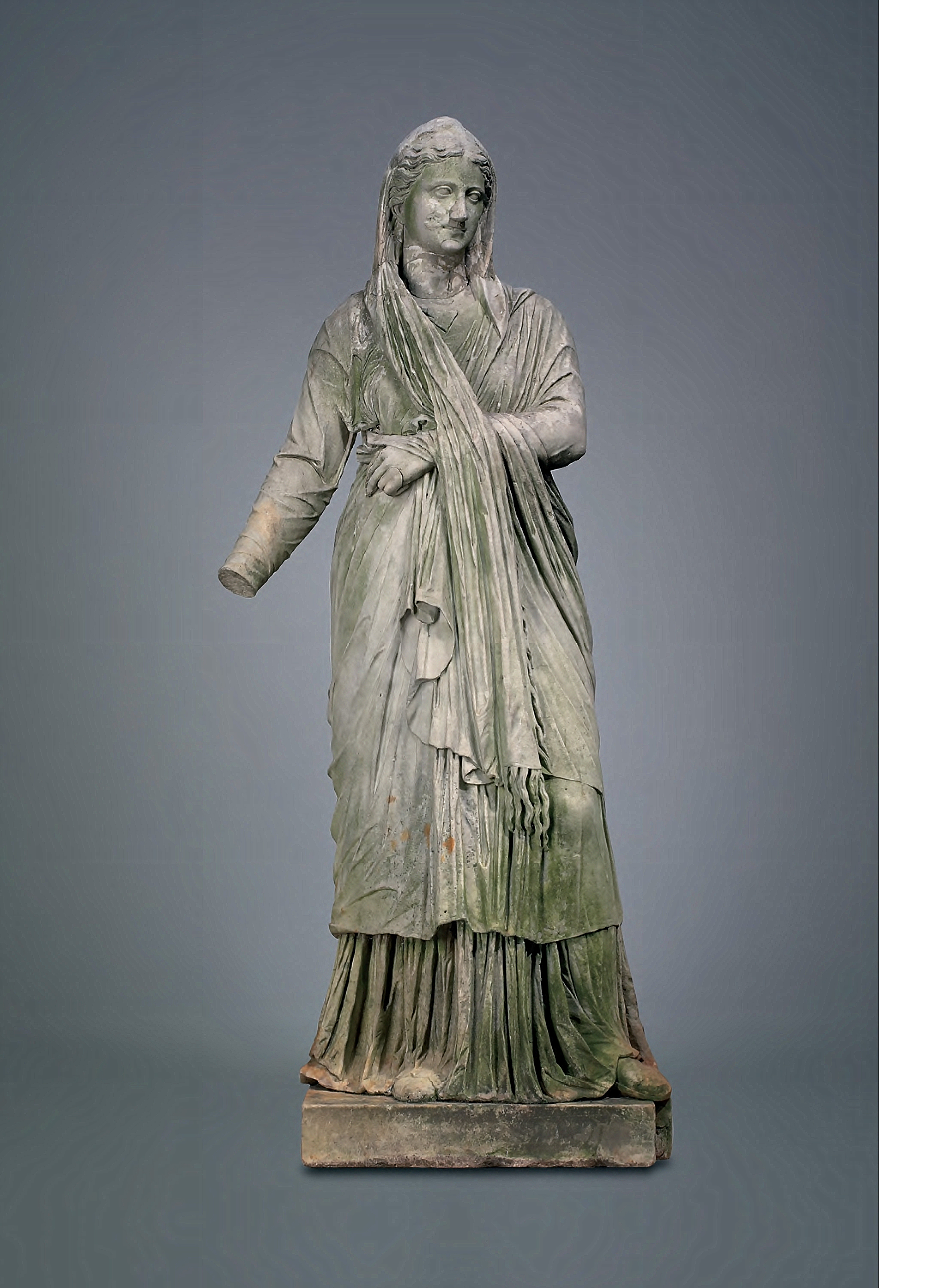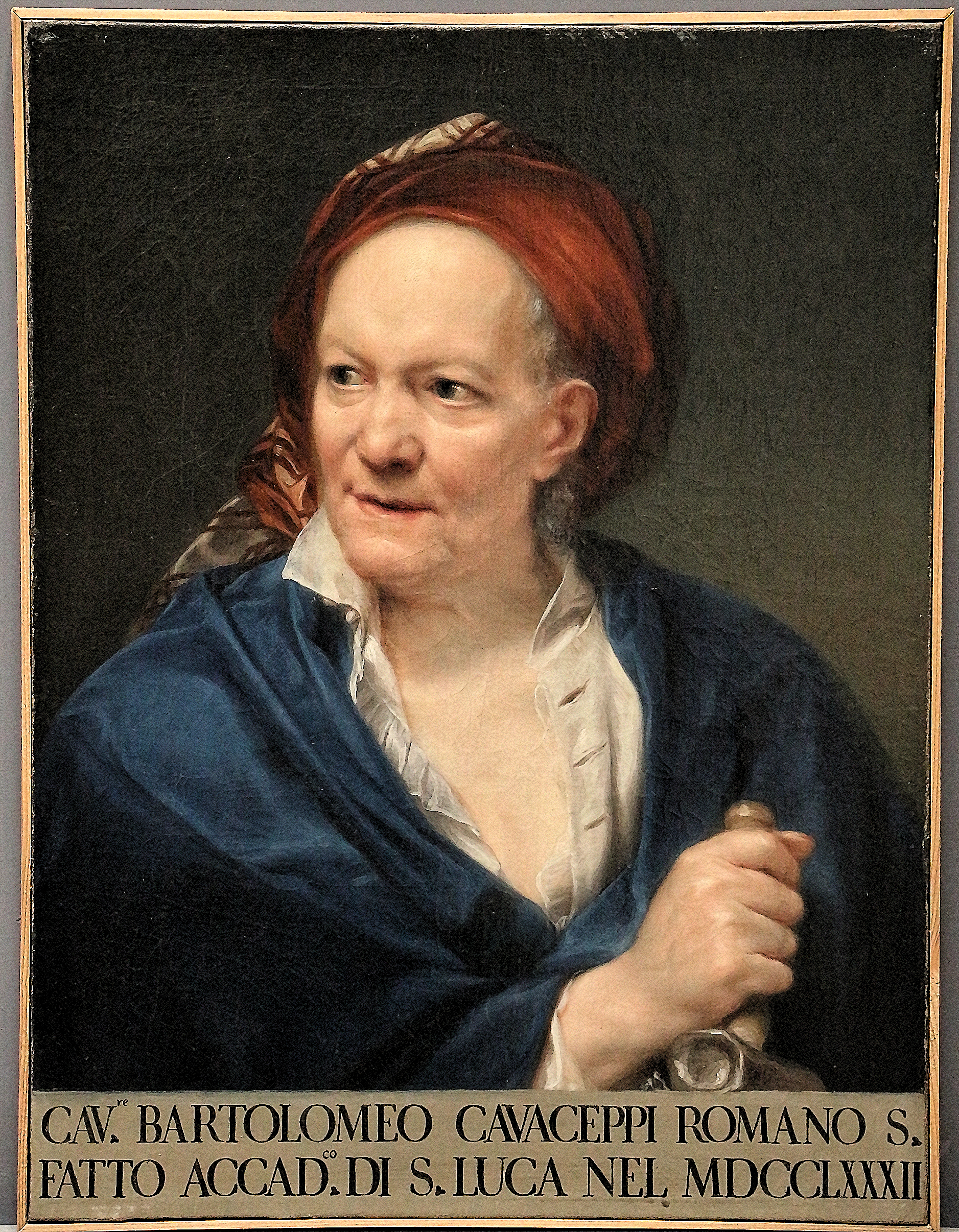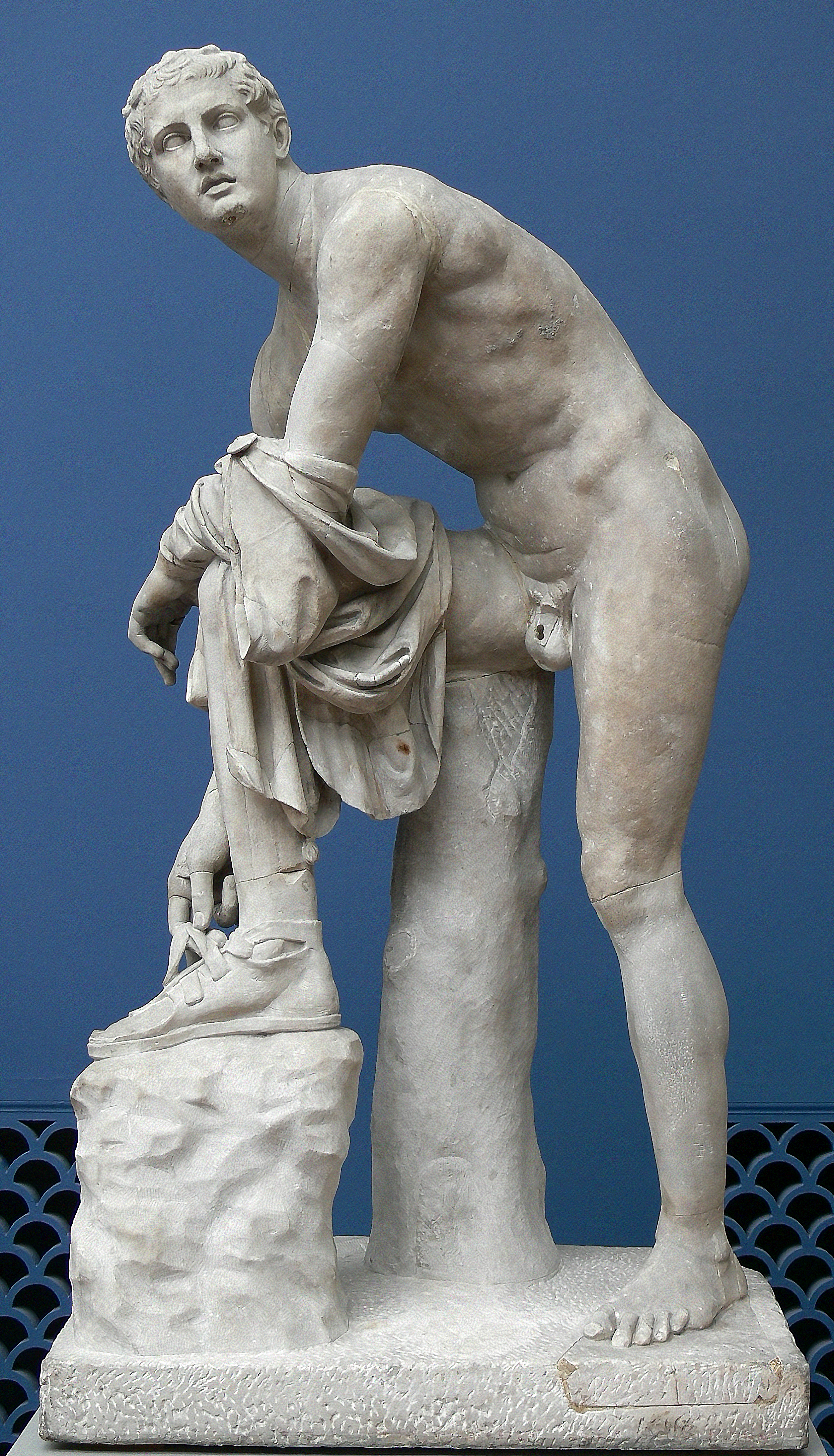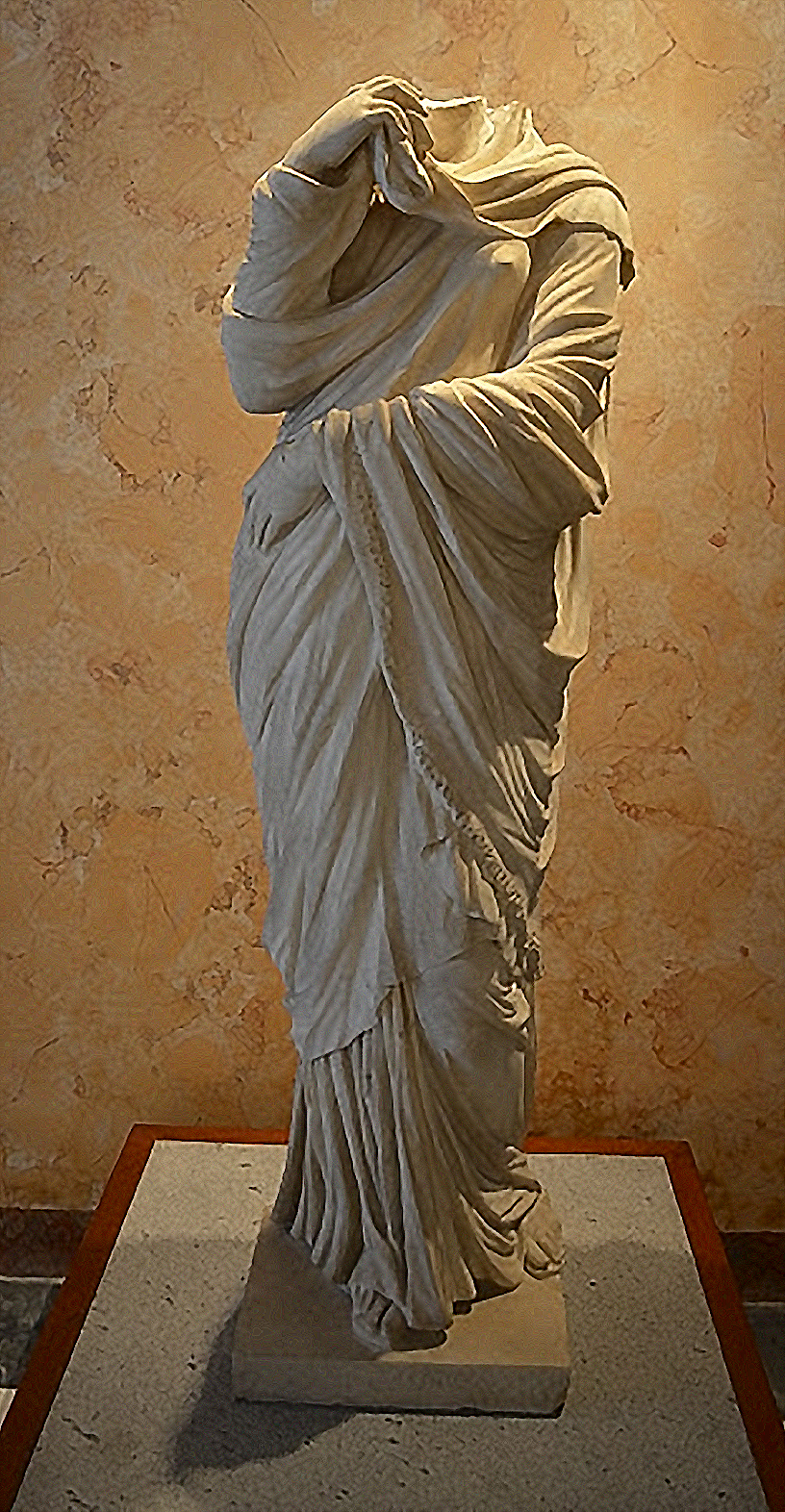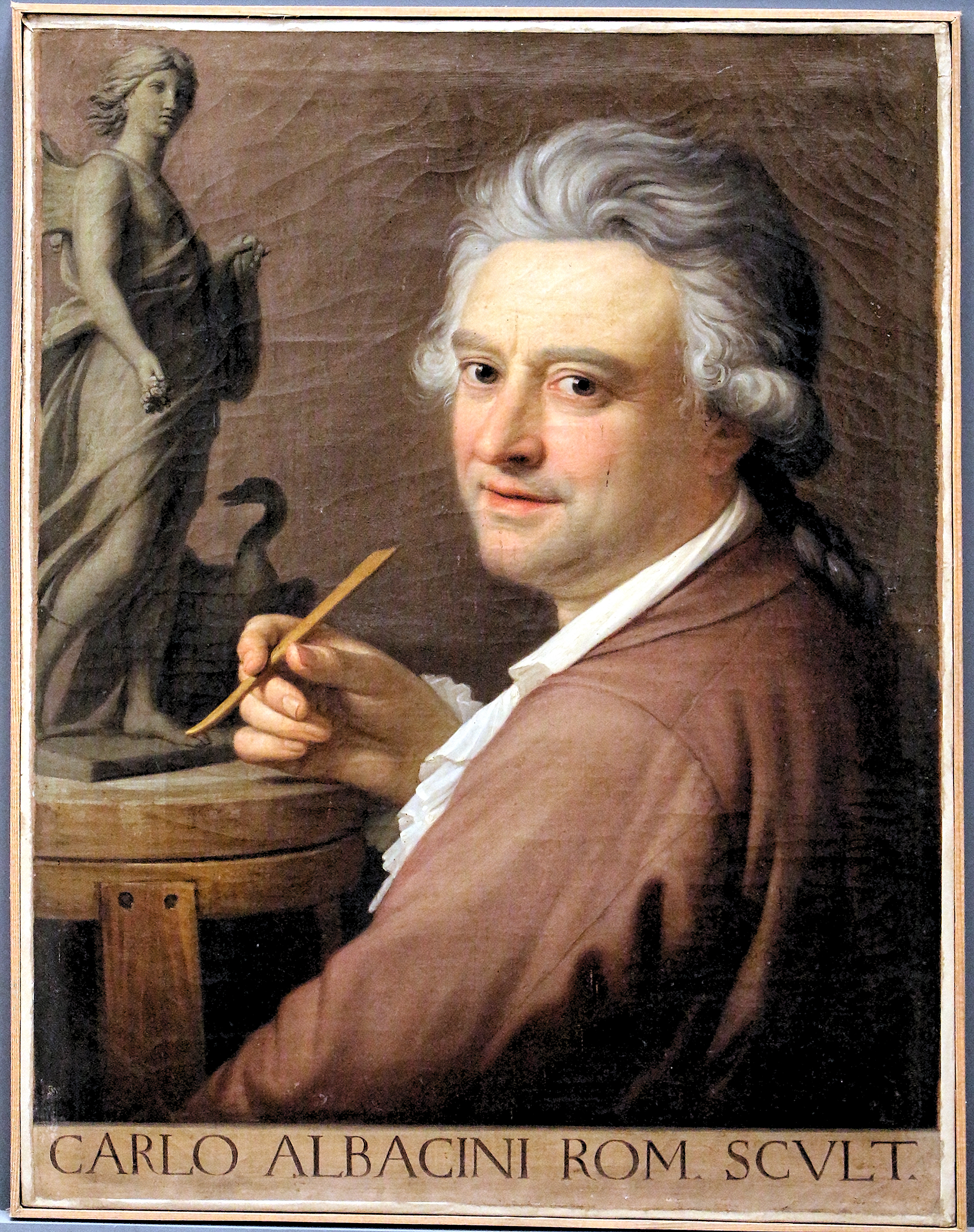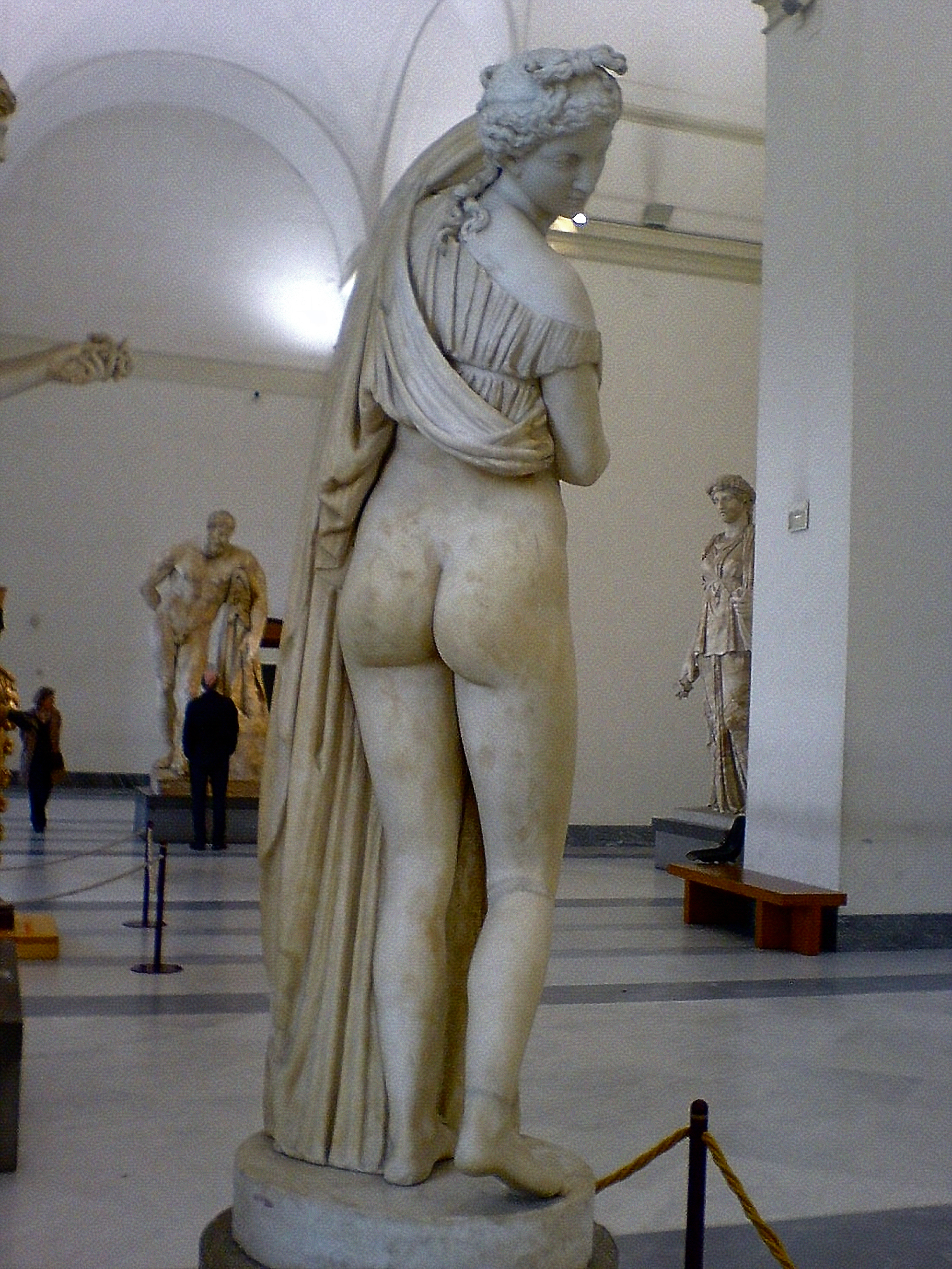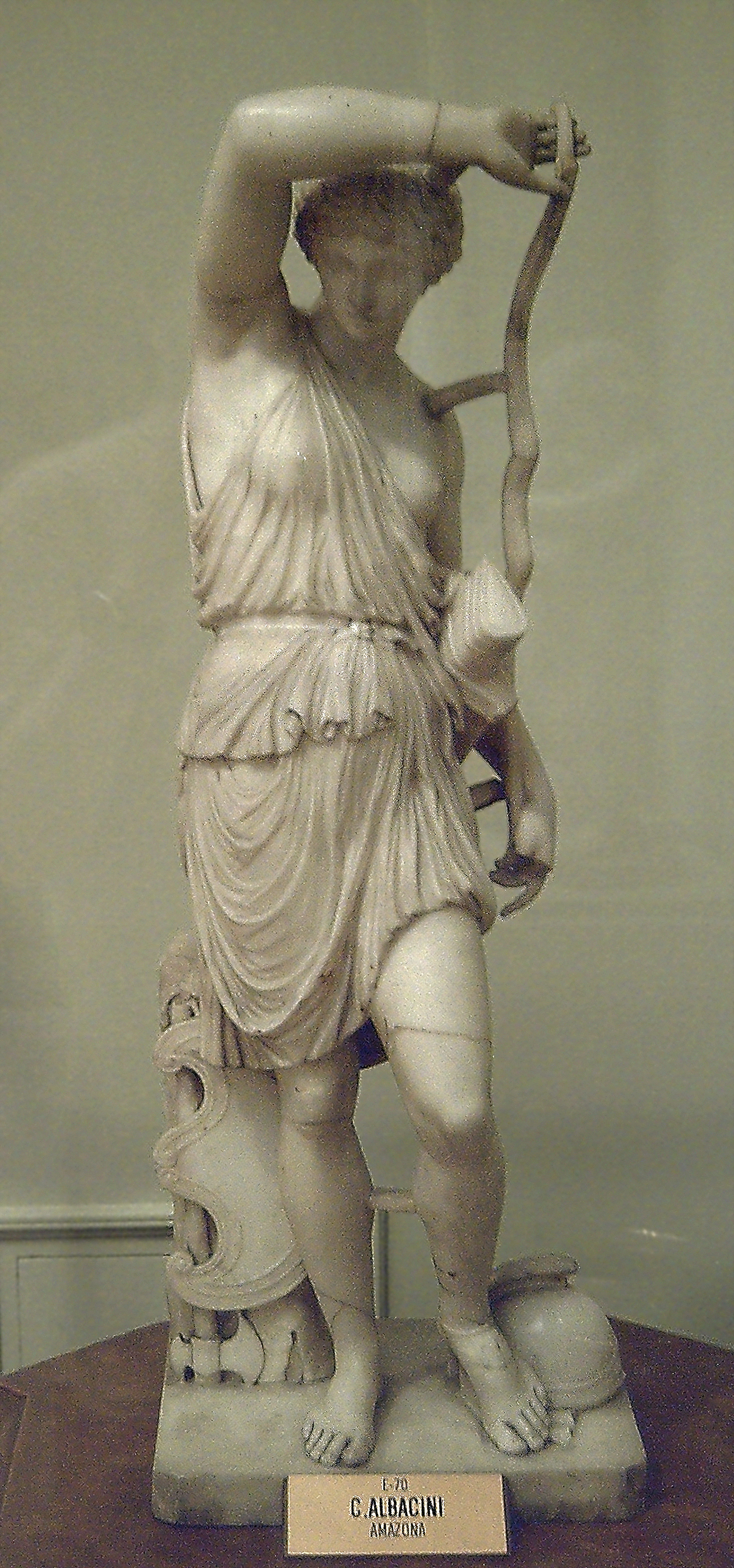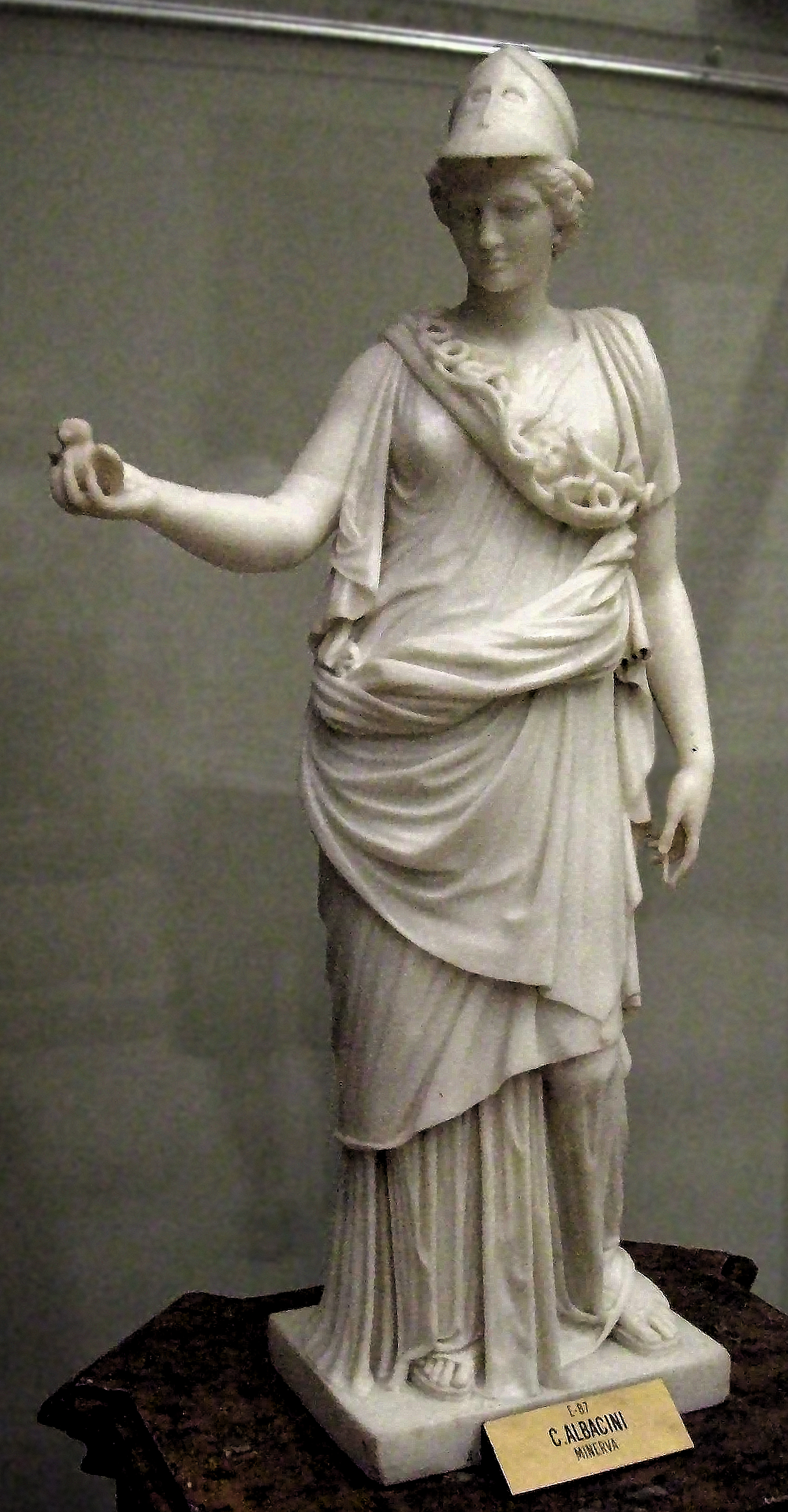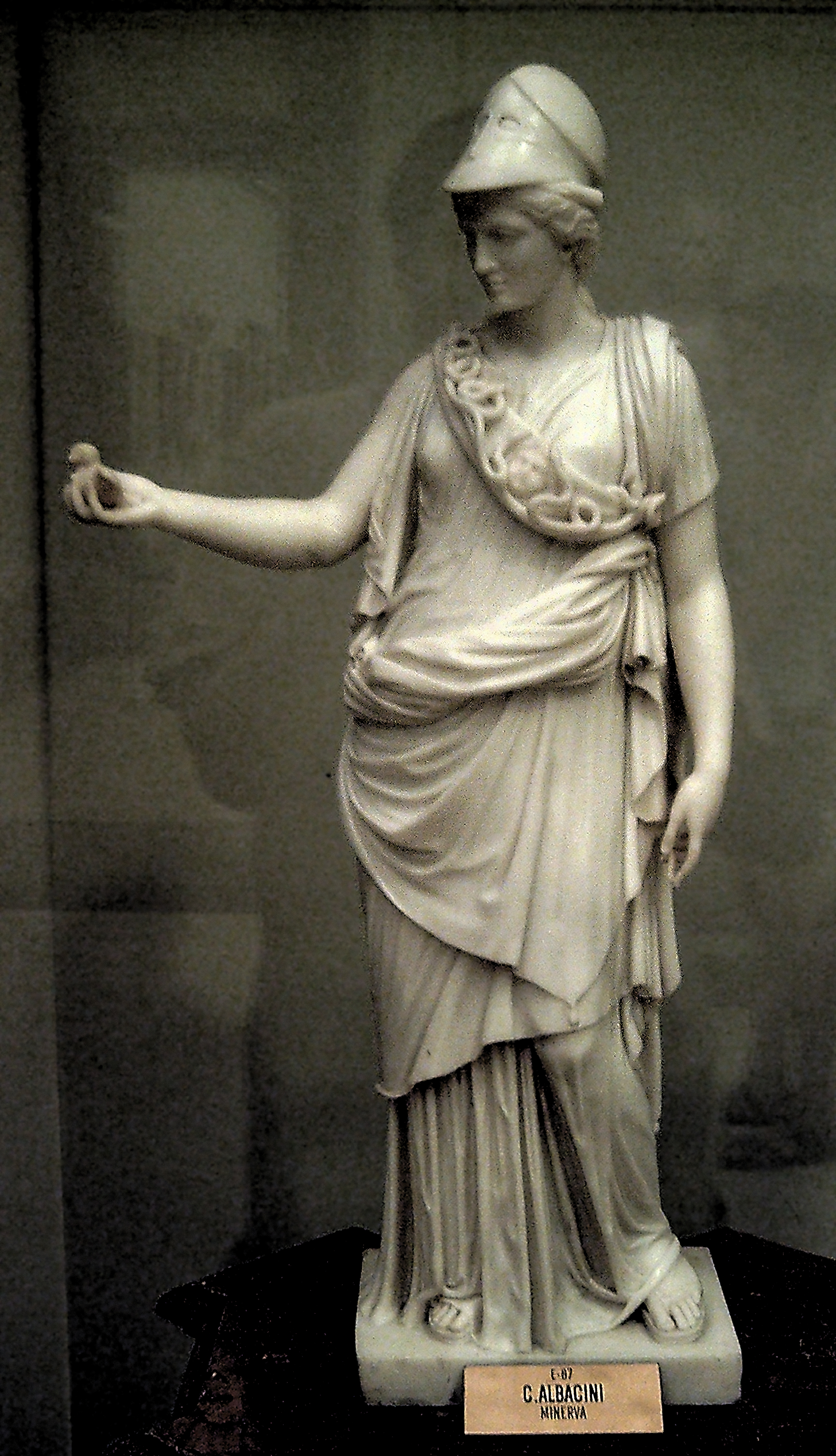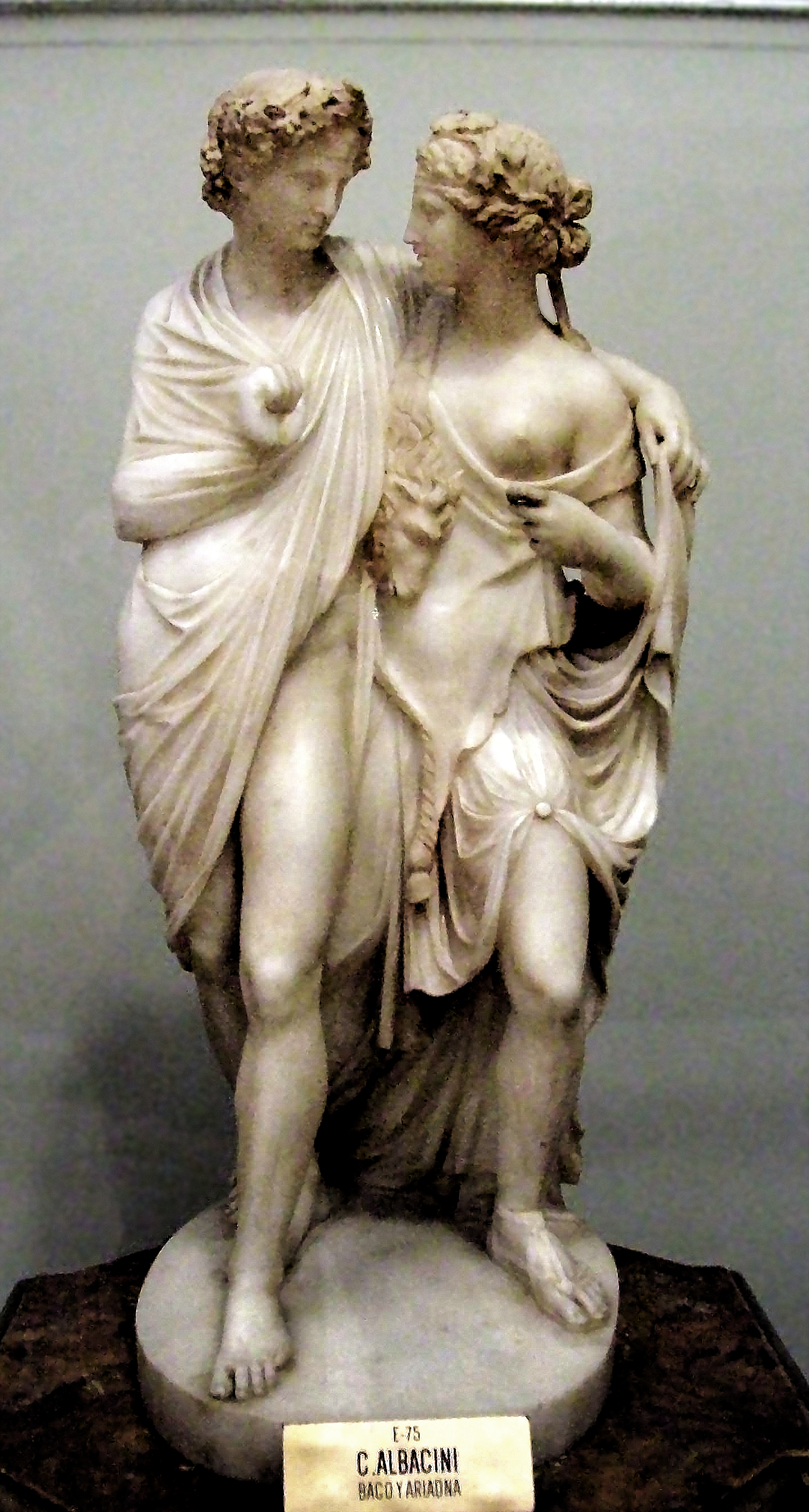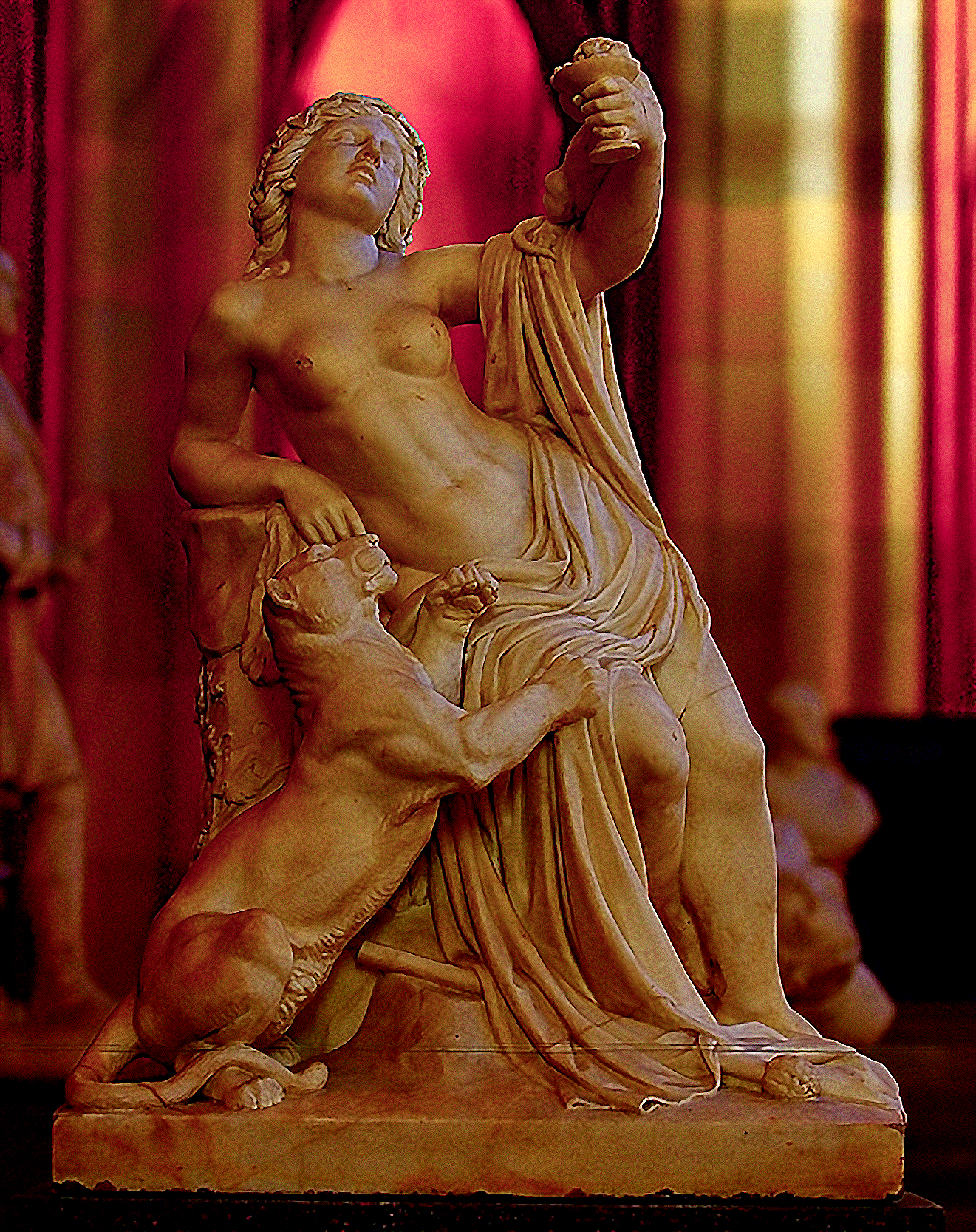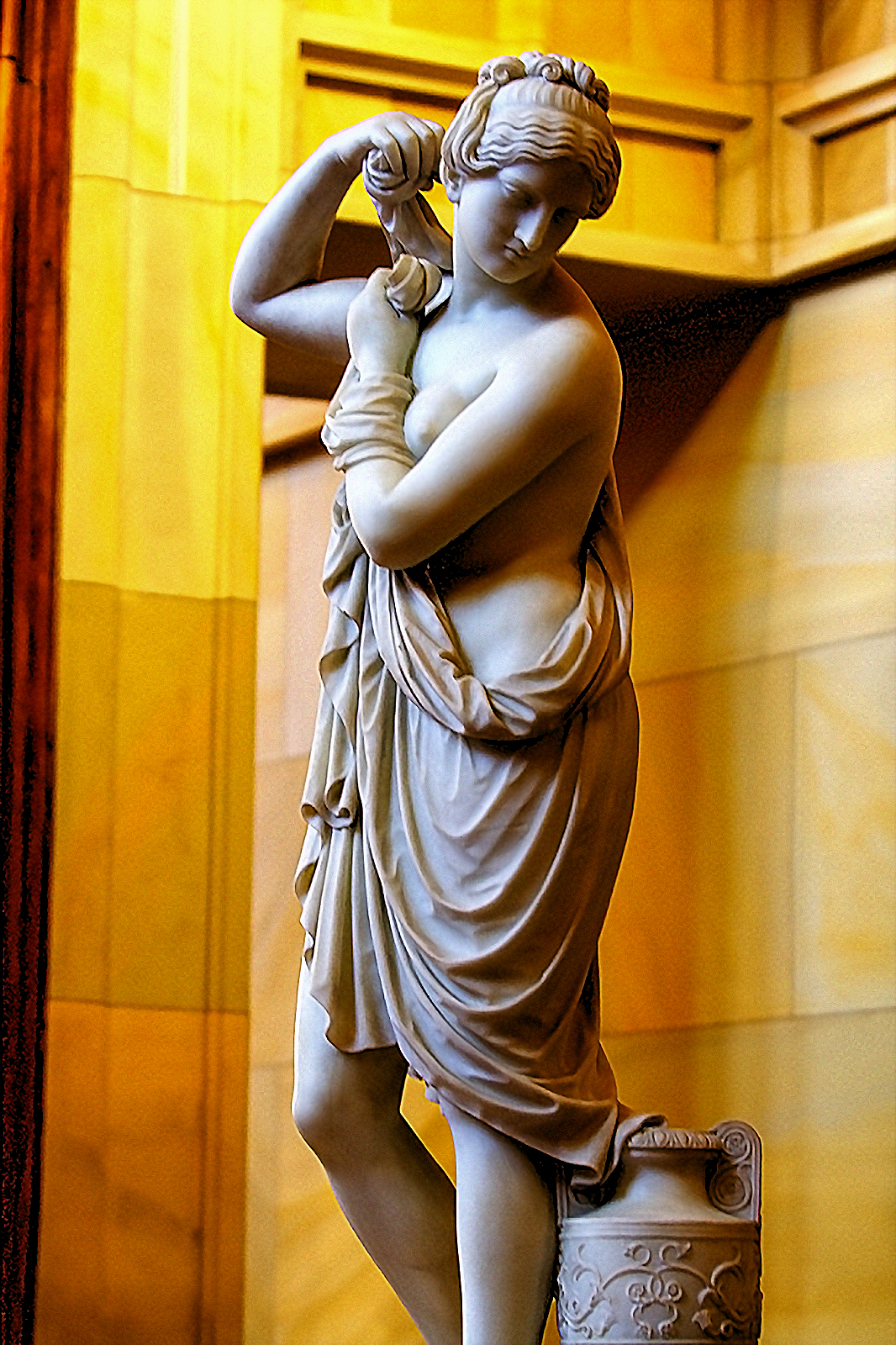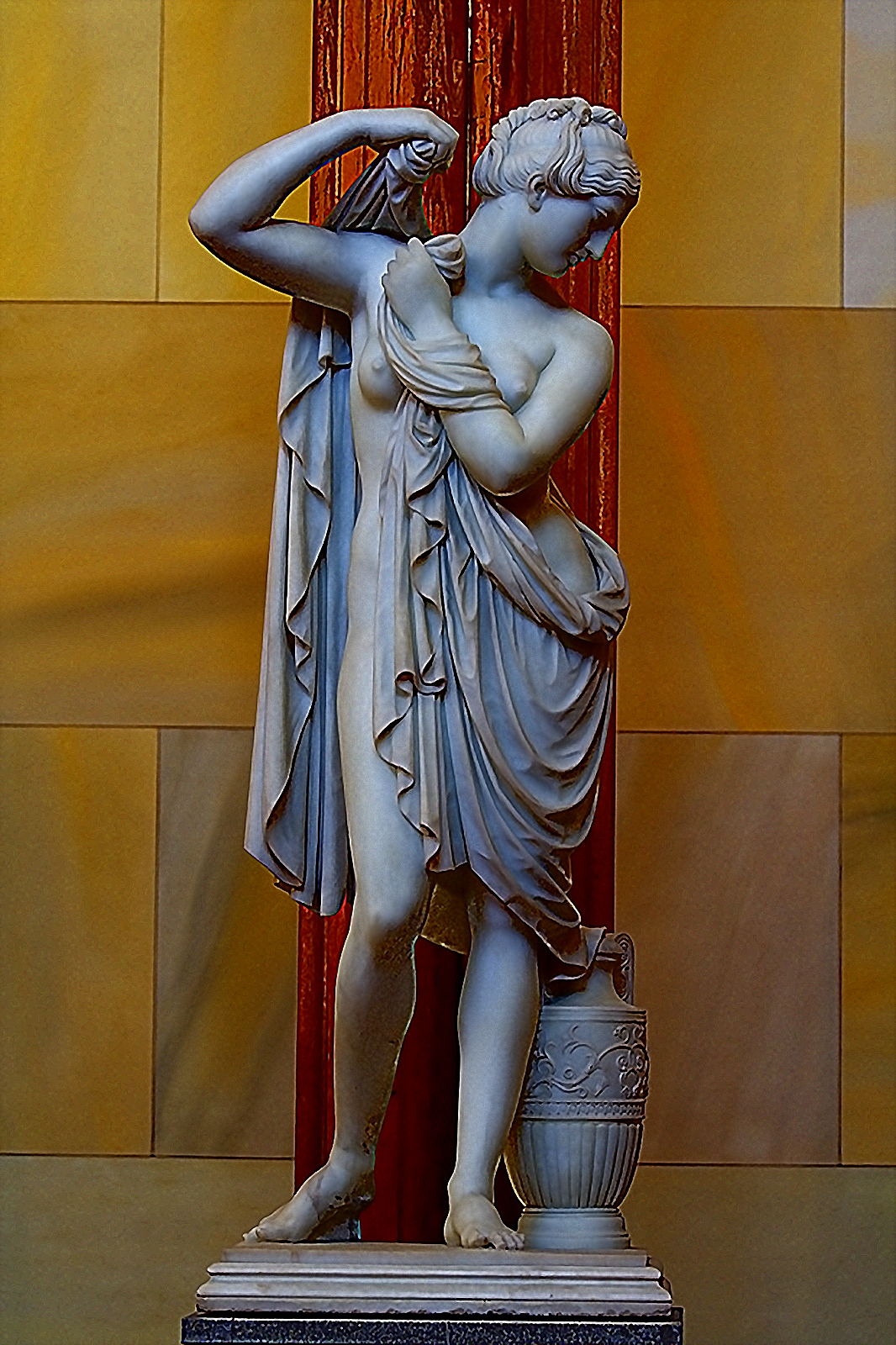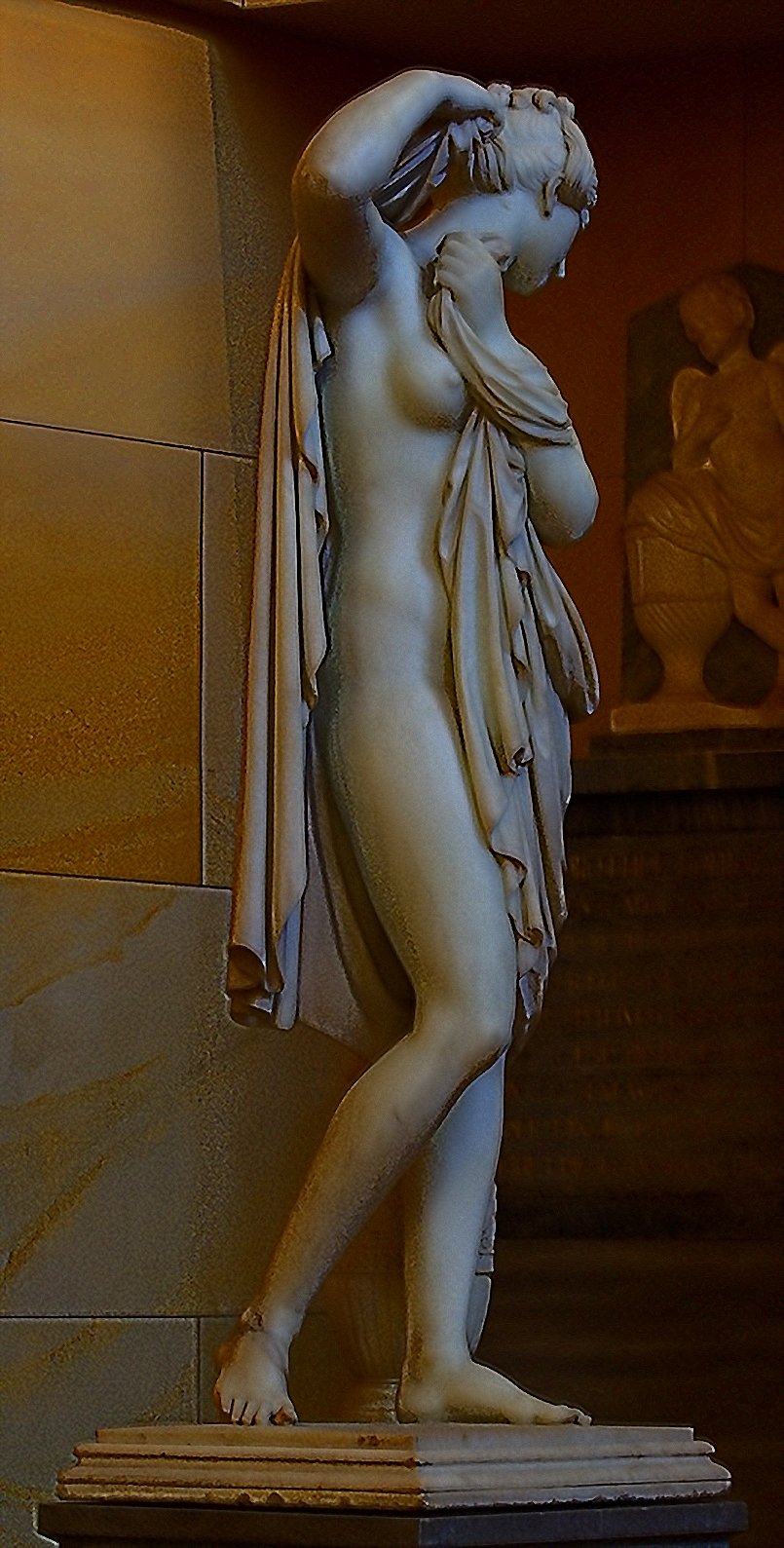Philosophy & History related to Hellenistic Influenced Art

Aristotle
First entry below is from,
Information:
St. John’s College, Annapolis
Aristotle (384-322 BCE.): Ethics
Standard interpretations of Aristotle’s Nichomachean Ethics usually maintain that Aristotle emphasizes the role of habit in conduct. It is commonly thought that virtues, according to Aristotle, are habits and that the good life is a life of mindless routine. These interpretations of Aristotle’s ethics are the result of imprecise translations from the ancient Greek text. Aristotle uses the word hexis to denote moral virtue. But the word does not merely mean passive habituation. Rather, hexis is an active condition, a state in which something must actively hold itself. Virtue, therefore, manifests itself in action. More explicitly, an action counts as virtuous, according to Aristotle, when one holds oneself in a stable equilibrium of the soul, in order to choose the action knowingly and for its own sake. This stable equilibrium of the soul is what constitutes character. Similarly, Aristotle’s concept of the mean is often misunderstood. In the Nichomachean Ethics, Aristotle repeatedly states that virtue is a mean. The mean is a state of clarification and apprehension in the midst of pleasures and pains that allows one to judge what seems most truly pleasant or painful. This active state of the soul is the condition in which all the powers of the soul are at work in concert. Achieving good character is a process of clearing away the obstacles that stand in the way of the full efficacy of the soul. For Aristotle, moral virtue is the only practical road to effective action. What the person of good character loves with right desire and thinks of as an end with right reason must first be perceived as beautiful. Hence, the virtuous person sees truly and judges rightly, since beautiful things appear as they truly are only to a person of good character. It is only in the middle ground between habits of acting and principles of action that the soul can allow right desire and right reason to make their appearance, as the direct and natural response of a free human being to the sight of the beautiful.
Table of Contents (Clicking on the links below will take you to those parts of this article)
1. Habit
In many discussions, the word habit is attached to the Ethics as though it were the answer to a multiple-choice question on a philosophy achievement test. Hobbes’ Leviathan? Self-preservation. Descartes’ Meditations? Mind-body problem. Aristotle’s Ethics? Habit. A faculty seminar I attended a few years ago was mired in the opinion that Aristotle thinks the good life is one of mindless routine. More recently, I heard a lecture in which some very good things were said about Aristotle’s discussion of choice, yet the speaker still criticized him for praising habit when so much that is important in life depends on openness and spontaneity. Can it really be that Aristotle thought life is lived best when thinking and choosing are eliminated? On its face this belief makes no sense. It is partly a confusion between an effect and one of its causes. Aristotle says that, for the way our lives turn out, “it makes no small difference to be habituated this way or that way straight from childhood, but an enormous difference, or rather all the difference.” (1103b, 23-5) Is this not the same as saying those lives are nothing but collections of habits? If this is what sticks in your memory, and leads you to that conclusion, then the cure is easy, since habits are not the only effects of habituation, and a thing that makes all the difference is indispensable but not necessarily the only cause of what it produces.
We will work through this thought in a moment, but first we need to notice that another kind of influence may be at work when you recall what Aristotle says about habit, and another kind of medicine may be needed against it. Are you thinking that no matter how we analyze the effects of habituation, we will never get around the fact that Aristotle plainly says that virtues are habits? The reply to that difficulty is that he doesn’t say that at all. He says that moral virtue is a hexis. Hippocrates Apostle, and others, translate hexis as habit, but that is not at all what it means. The trouble, as so often in these matters, is the intrusion of Latin. The Latin habitus is a perfectly good translation of the Greek hexis, but if that detour gets us to habit in English we have lost our way. In fact, a hexis is pretty much the opposite of a habit.
The word hexis becomes an issue in Plato’s Theaetetus. Socrates makes the point that knowledge can never be a mere passive possession, stored in the memory the way birds can be put in cages. The word for that sort of possession, ktÎsis, is contrasted with hexis, the kind of having-and-holding that is never passive but always at work right now. Socrates thus suggests that, whatever knowledge is, it must have the character of a hexis in requiring the effort of concentrating or paying attention. A hexis is an active condition, a state in which something must actively hold itself, and that is what Aristotle says a moral virtue is.
Some translators make Aristotle say that virtue is a disposition, or a settled disposition. This is much better than calling it a habit, but still sounds too passive to capture his meaning. In De Anima, when Aristotle speaks of the effect produced in us by an object of sense perception, he says this is not a disposition (diathesis) but a hexis. (417b, 15-17) His whole account of sensing and knowing depends on this notion that receptivity to what is outside us depends on an active effort to hold ourselves ready. In Book VII of the Physics, Aristotle says much the same thing about the way children start to learn: they are not changed, he says, nor are they trained or even acted upon in any way, but they themselves get straight into an active state when time or adults help them settle down out of their native condition of disorder and distraction. (247b, 17-248a, 6) Curtis Wilson once delivered a lecture here at St. John’s College, in which he asked his audience to imagine what it would be like if we had to teach children to speak by deliberately and explicitly imparting everything they had to do. We somehow set them free to speak, and give them a particular language to do it in, but they–Mr. Wilson called them little geniuses–they do all the work.
Everyone at St. John’s has thought about the kind of learning that does not depend on the authority of the teacher and the memory of the learner. In the Meno it is called recollection; Aristotle says that it is an active knowing that is always already at work in us. In Plato’s image we draw knowledge up out of ourselves; in Aristotle’s metaphor we settle down into knowing. In neither account is it possible for anyone to train us, as Gorgias has habituated Meno into the mannerisms of a knower. Habits can be strong but they never go deep. Authentic knowledge does engage the soul in its depths, and with this sort of knowing Aristotle links virtue. In the passage cited from Book VII of the Physics, he says that, like knowledge, virtues are not imposed on us as alterations of what we are; that would be, he says, like saying we alter a house when we put a roof on it. In the Categories, knowledge and virtue are the two examples he gives of what hexis means (8b, 29); there he says that these active states belong in the general class of dispositions, but are distinguished by being lasting and durable. The word disposition by itself, he reserves for more passive states, easy to remove and change, such as heat, cold, and sickness.
In the Ethics, Aristotle identifies moral virtue as a hexis in Book II, chapter 4. He confirms this identity by reviewing the kinds of things that are in the soul, and eliminating the feelings and impulses to which we are passive and the capacities we have by nature, but he first discovers what sort of thing a virtue is by observing that the goodness is never in the action but only in the doer. This is an enormous claim that pervades the whole of the Ethics, and one that we need to stay attentive to. No action is good or just or courageous because of any quality in itself. Virtue manifests itself in action, Aristotle says, only when one acts while holding oneself in a certain way. This is where the word hexis comes into the account, from pÙs echÙn, the stance in which one holds oneself when acting. The indefinite adverb is immediately explained: an action counts as virtuous when and only when one holds oneself in a stable equilibrium of the soul, in order to choose the action knowingly and for its own sake. I am translating as “in a stable equilibrium” the words bebaiÙs kai ametakinÍtÙs; the first of these adverbs means stably or after having taken a stand, while the second does not mean rigid or immovable, but in a condition from which one can’t be moved all the way over into a different condition. It is not some inflexible adherence to rules or duty or precedent that is conveyed here, but something like a Newton’s wheel weighted below the center, or one of those toys that pops back upright whenever a child knocks it over. This stable equilibrium of the soul is what we mean by having character. It is not the result of what we call conditioning. There is a story told about B. F. Skinner, the psychologist most associated with the idea of behavior modification, that a class of his once trained him to lecture always from one corner of the room, by smiling and nodding whenever he approached it, but frowning and faintly shaking their heads when he moved away from it. That is the way we acquire habits. We slip into them unawares, or let them be imposed on us, or even impose them on ourselves. A person with ever so many habits may still have no character. Habits make for repetitive and predictable behavior, but character gives moral equilibrium to a life. The difference is between a foolish consistency wholly confined to the level of acting, and a reliability in that part of us from which actions have their source. Different as they are, though, character and habit sound to us like things that are linked, and in Greek they differ only by the change of an epsilon to an eta, making Íthos from ethos We are finally back to Aristotle’s claim that character, Íthos, is produced by habit, ethos. It should now be clear though, that the habit cannot be any part of that character, and that we must try to understand how an active condition can arise as a consequence of a passive one, and why that active condition can only be attained if the passive one has come first. So far we have arranged three notions in a series, like rungs of a ladder: at the top are actives states, such as knowledge, the moral virtues, and the combination of virtues that makes up a character; the middle rung, the mere dispositions, we have mentioned only in passing to claim that they are too shallow and changeable to capture the meaning of virtue; the bottom rung is the place of the habits, and includes biting your nails, twisting your hair, saying “like” between every two words, and all such passive and mindless conditions. What we need to notice now is that there is yet another rung of the ladder below the habits.
We all start out life governed by desires and impulses. Unlike the habits, which are passive but lasting conditions, desires and impulses are passive and momentary, but they are very strong. Listen to a child who can’t live without some object of appetite or greed, or who makes you think you are a murderer if you try to leave her alone in a dark room. How can such powerful influences be overcome? To expect a child to let go of the desire or fear that grips her may seem as hopeless as Aristotle’s example of training a stone to fall upward, were it not for the fact that we all know that we have somehow, for the most part, broken the power of these tyrannical feelings. We don’t expel them altogether, but we do get the upper hand; an adult who has temper tantrums like those of a two-year old has to live in an institution, and not in the adult world. But the impulses and desires don’t weaken; it is rather the case that we get stronger.
Aristotle doesn’t go into much detail about how this happens, except to say that we get the virtues by working at them: in the give-and-take with other people, some become just, others unjust; by acting in the face of frightening things and being habituated to be fearful or confident, some become brave and others cowardly; and some become moderate and gentle, others spoiled and bad-tempered, by turning around from one thing and toward another in the midst of desires and passions. (1103 b, 1422) He sums this up by saying that when we are at-work in a certain way, an active state results. This innocent sentence seems to me to be one of the lynch-pins that hold together the Ethics, the spot that marks the transition from the language of habit to the language appropriate to character. If you read the sentence in Greek, and have some experience of Aristotle’s other writings, you will see how loaded it is, since it says that a hexis depends upon an energeia. The latter word, that can be translated as being-at-work, cannot mean mere behavior, however repetitive and constant it may be. It is this idea of being-at-work, which is central to all of Aristotle’s thinking, that makes intelligible the transition out of childhood and into the moral stature that comes with character and virtue. (See
Aristotle on Motion and its Place in Nature for as discussion energeia. -ed.)
The moral life can be confused with the habits approved by some society and imposed on its young. We at St. John’s College still stand up at the beginning and end of Friday-night lectures because Stringfellow Barr — one of the founders of the current curriculum — always stood when anyone entered or left a room. What he considered good breeding is for us mere habit; that becomes obvious when some student who stood up at the beginning of a lecture occasionally gets bored and leaves in the middle of it. In such a case the politeness was just for show, and the rudeness is the truth. Why isn’t all habituation of the young of this sort? When a parent makes a child repeatedly refrain from some desired thing, or remain in some frightening situation, the child is beginning to act as a moderate or brave person would act, but what is really going on within the child? I used to think that it must be the parent’s approval that was becoming stronger than the child’s own impulse, but I was persuaded by others in a study group that this alone would be of no lasting value, and would contribute nothing to the formation of an active state of character. What seems more likely is that parental training is needed only for its negative effect, as a way of neutralizing the irrational force of impulses and desires.
We all arrive on the scene already habituated, in the habit, that is, of yielding to impulses and desires, of instantly slackening the tension of pain or fear or unfulfilled desire in any way open to us, and all this has become automatic in us before thinking and choosing are available to us at all. This is a description of what is called human nature, though in fact it precedes our access to our true natural state, and blocks that access. This is why Aristotle says that “the virtues come about in us neither by nature nor apart from nature” (1103a, 24-5). What we call human nature, and some philosophers call the state of nature, is both natural and unnatural; it is the passive part of our natures, passively reinforced by habit. Virtue has the aspect of a second nature, because it cannot develop first, nor by a continuous process out of our first condition. But it is only in the moral virtues that we possess our primary nature, that in which all our capacities can have their full development. The sign of what is natural, for Aristotle, is pleasure, but we have to know how to read the signs. Things pleasant by nature have no opposite pain and no excess, because they set us free to act simply as what we are (1154b, 15-21), and it is in this sense that Aristotle calls the life of virtue pleasant in its own right, in itself (1099a, 6-7, 16-17). A mere habit of acting contrary to our inclinations cannot be a virtue, by the infallible sign that we don’t like it.
Our first or childish nature is never eradicated, though, and this is why Aristotle says that our nature is not simple, but also has in it something different that makes our happiness assailable from within, and makes us love change even when it is for the worse. (1154b, 21-32) But our souls are brought nearest to harmony and into the most durable pleasures only by the moral virtues. And the road to these virtues is nothing fancy, but is simply what all parents begin to do who withhold some desired thing from a child, or prevent it from running away from every irrational source of fear. They make the child act, without virtue, as though it had virtue. It is what Hamlet describes to his mother, during a time that is out of joint, when a son must try to train his parent (III, Ìv,181-9):
Assume a virtue if you have it not. That monster, custom, who all sense doth eat Of habits evil, is angel yet in this, That to the use of actions fair and good He likewise gives a frock or livery, That aptly is put on. Refrain tonight, And that shall lend a kind of easiness To the next abstinence; the next more easy; For use almost can change the stamp of nature…
Hamlet is talking to a middle-aged woman about lust, but the pattern applies just as well to five-year-olds and candy. We are in a position to see that it is not the stamp of nature that needs to be changed but the earliest stamp of habit. We can drop Hamlet’s “almost” and rid his last quoted line of all paradox by seeing that the reason we need habit is to change the stamp of habit. A habit of yielding to impulse can be counteracted by an equal and opposite habit. This second habit is no virtue, but only a mindless inhibition, an automatic repressing of all impulses. Nor do the two opposite habits together produce virtue, but rather a state of neutrality. Something must step into the role previously played by habit, and Aristotle’s use of the word energeia suggests that this happens on its own, with no need for anything new to be imposed. Habituation thus does not stifle nature, but rather lets nature make its appearance. The description from Book VII of the Physics of the way children begin to learn applies equally well to the way human character begins to be formed: we settle down, out of the turmoil of childishness, into what we are by nature.
We noticed earlier that habituation is not the end but the beginning of the progress toward virtue. The order of states of the soul given by Aristotle went from habit to being-at-work to the hexis or active state that can give the soul moral stature. If the human soul had no being-at-work, no inherent and indelible activity, there could be no such moral stature, but only customs. But early on, when first trying to give content to the idea of happiness, Aristotle asks if it would make sense to think that a carpenter or shoemaker has work to do, but a human being as such is inert. His reply, of course, is that nature has given us work to do, in default of which we are necessarily unhappy, and that work is to put into action the power of reason. (1097b, 24-1098a, 4) Note please that he does not say that everyone must be a philosopher, nor even that human life is constituted by the activity of reason, but that our work is to bring the power of logos forward into action. Later, Aristotle makes explicit that the irrational impulses are no less human than reasoning is. (1111 b, 1-2) His point is that, as human beings, our desires need not be mindless and random, but can be transformed by thinking into choices, that is desires informed by deliberation. (1113a, 11) The characteristic human way of being-at-work is the threefold activity of seeing an end, thinking about means to it, and choosing an action. Responsible human action depends upon the combining of all the powers of the soul: perception, imagination, reasoning, and desiring. These are all things that are at work in us all the time. Good parental training does not produce them, or mold them, or alter them, but sets them free to be effective in action. This is the way in which, according to Aristotle, despite the contributions of parents, society, and nature, we are the co-authors of the active states of our own souls. (1114b, 23-4)
2. The Mean
Now this discussion has shown that habit does make all the difference to our lives without being the only thing shaping those lives and without being the final form they take. The same discussion also points to a way to make some sense of one of the things that has always puzzled me most in the Ethics, the insistence that moral virtue is always in its own nature a mean condition. Quantitative relations are so far from any serious human situation that they would seem to be present only incidentally or metaphorically, but Aristotle says that “by its thinghood and by the account that unfolds what it is for it to be, virtue is a mean.” (1107a, 7-8) This invites such hopeless shallowness as in the following sentences that I quote from a recent article in a journal called Ancient Philosophy (Vol. 8, pp. 101-4): “To illustrate …0 marks the mean (e.g. Courage); …Cowardice is -3 while Rashness is 3…In our number language…’Always try to lower the absolute value of your vice.’ ” This scholar thinks achieving courage is like tuning in a radio station on an analog dial. Those who do not sink this low might think instead that Aristotle is praising a kind of mediocrity, like that found in those who used to go to college to get gentlemen’s C’s. But what sort of courage could be found in these timid souls, whose only aim in life is to blend so well into their social surroundings that virtue can never be chosen in preference to a fashionable vice? Aristotle points out twice that every moral virtue is an extreme (1107a, 8-9, 22-4), but he keeps that observation secondary to an over-riding sense in which it is a mean. Could there be anything at all to the notion that we hone in on a virtue from two sides? There is a wonderful image of this sort of thing in the novel Nop’s Trials by Donald McCaig. The protagonist is not a human being, but a border collie named Nop. The author describes the way the dog has to find the balance point, the exact distance behind a herd of sheep from which he can drive the whole herd forward in a coherent mass. When the dog is too close, the sheep panic and run off in all directions; when he is too far back, the sheep ignore him, and turn in all directions to graze. While in motion, a good working dog keeps adjusting his pace to maintain the exact mean position that keeps the sheep stepping lively in the direction he determines. Now working border collies are brave, tireless, and determined. They have been documented as running more than a hundred miles in a day, and they love their work. There is no question that they display virtue, but it is not human virtue and not even of the same form. Some human activities do require the long sustained tension a sheep dog is always holding on to, an active state stretched to the limit, constantly and anxiously kept in balance. Running on a tightrope might capture the same flavor. But constantly maintained anxiety is not the kind of stable equilibrium Aristotle attributes to the virtuous human soul.
I think we may have stumbled on the way that human virtue is a mean when we found that habits were necessary in order to counteract other habits. This does accord with the things Aristotle says about straightening warped boards, aiming away from the worse extreme, and being on guard against the seductions of pleasure. (1109a, 30- b9) The habit of abstinence from bodily pleasure is at the opposite extreme from the childish habit of yielding to every immediate desire. Alone, either of them is a vice, according to Aristotle. The glutton, the drunkard, the person enslaved to every sexual impulse obviously cannot ever be happy, but the opposite extremes, which Aristotle groups together as a kind of numbness or denial of the senses (1107b, 8), miss the proper relation to bodily pleasure on the other side. It may seem that temperance in relation to food, say, depends merely on determining how many ounces of chocolate mousse to eat. Aristotle’s example of Milo the wrestler, who needs more food than the rest of us do to sustain him, seems to say this, but I think that misses the point. The example is given only to show that there is no single action that can be prescribed as right for every person and every circumstance, and it is not strictly analogous even to temperance with respect to food. What is at stake is not a correct quantity of food but a right relation to the pleasure that comes from eating.
Suppose you have carefully saved a bowl of chocolate mousse all day for your mid-evening snack, and just as you are ready to treat yourself, a friend arrives unexpectedly to visit. If you are a glutton, you might hide the mousse until the friend leaves, or gobble it down before you open the door. If you have the opposite vice, and have puritanically suppressed in yourself all indulgence in the pleasures of food, you probably won’t have chocolate mousse or any other treat to offer your visitor. If the state of your soul is in the mean in these matters, you are neither enslaved to nor shut out from the pleasure of eating treats, and can enhance the visit of a friend by sharing them. What you are sharing is incidentally the 6 ounces of chocolate mousse; the point is that you are sharing the pleasure, which is not found on any scale of measurement. If the pleasures of the body master you, or if you have broken their power only by rooting them out, you have missed out on the natural role that such pleasures can play in life. In the mean between those two states, you are free to notice possibilities that serve good ends, and to act on them. It is worth repeating that the mean is not the 3 ounces of mousse on which you settled, since if two friends had come to visit you would have been willing to eat 2 ounces. That would not have been a division of the food but a multiplication of the pleasure. What is enlightening about the example is how readily and how nearly universally we all see that sharing the treat is the right thing to do. This is a matter of immediate perception, but it is perception of a special kind, not that of any one of the five senses, Aristotle says, but the sort by which we perceive that a triangle is the last kind of figure into which a polygon can be divided. (1142a, 28-30) This is thoughtful and imaginative perceiving, but it has to be perceived. The childish sort of habit clouds our sight, but the liberating counter-habit clears that sight. This is why Aristotle says that the person of moral stature, the spoudaios, is the one to whom things appear as they truly are. (1113a, 30-1) Once the earliest habits are neutralized, our desires are disentangled from the pressure for immediate gratification, we are calm enough to think, and most important, we can see what is in front of us in all its possibility. The mean state here is not a point on a dial that we need to fiddle up and down; it is a clearing in the midst of pleasures and pains that lets us judge what seems most truly pleasant and painful.
Achieving temperance toward bodily pleasures is, by this account, finding a mean, but it is not a simple question of adjusting a single varying condition toward the more or the less. The person who is always fighting the same battle, always struggling like the sheep dog to maintain the balance point between too much and too little indulgence, does not, according to Aristotle, have the virtue of temperance, but is at best self restrained or continent. In that case, the reasoning part of the soul is keeping the impulses reined in. But those impulses can slip the reins and go their own way, as parts of the body do in people with certain disorders of the nerves. (1102b, 14-22) Control in self-restrained people is an anxious, unstable equilibrium that will lapse whenever vigilance is relaxed. It is the old story of the conflict between the head and the emotions, never resolved but subject to truces. A soul with separate, self-contained rational and irrational parts could never become one undivided human being, since the parties would always believe they had divergent interests, and could at best compromise. The virtuous soul, on the contrary, blends all its parts in the act of choice. This, I think, is the best way to understand the active state of the soul that constitutes moral virtue and forms character. It is the condition in which all the powers of the soul are at work together, making it possible for action to engage the whole human being. The work of achieving character is a process of clearing away the obstacles that stand in the way of the full efficacy of the soul. Someone who is partial to food or drink, or to running away from trouble or to looking for trouble, is a partial human being. Let the whole power of the soul have its influence, and the choices that result will have the characteristic look that we call courage or temperance or simply virtue. Now this adjective “characteristic” comes from the Greek word charactÍr, which means the distinctive mark scratched or stamped on anything, and which to my knowledge is never used in the Nicomachean Ethics. In the sense of character of which we are speaking, the word for which is Íthos, we see an outline of the human form itself. A person of character is someone you can count on, because there is a human nature in a deeper sense than that which refers to our early state of weakness. Someone with character has taken a stand in that fully mature nature, and cannot be moved all the way out of it.
But there is also such a thing as bad character, and this is what Aristotle means by vice, as distinct from bad habits or weakness. It is possible for someone with full responsibility and the free use of intellect to choose always to yield to bodily pleasure or to greed. Virtue is a mean, first because it can only emerge out of the stand-off between opposite habits, but second because it chooses to take its stand not in either of those habits but between them. In this middle region, thinking does come into play, but it is not correct to say that virtue takes its stand in principle; Aristotle makes clear that vice is a principled choice that following some extreme path toward or away from pleasure is right. (1146b, 22-3) Principles are wonderful things, but there are too many of them, and exclusive adherence to any one of them is always a vice.
In our earlier example, the true glutton would be someone who does not just have a bad habit of always indulging the desire for food, but someone who has chosen on principle that one ought always to yield to it. In Plato’s Gorgias, Callicles argues just that, about food, drink, and sex. He is serious, even though he is young and still open to argument. But the only principled alternative he can conceive is the denial of the body, and the choice of a life fit only for stones or corpses. (492E) This is the way most attempts to be serious about right action go astray. What, for example, is the virtue of a seminar leader? Is it to ask appropriate questions but never state an opinion? Or is it to offer everything one has learned on the subject of discussion? What principle should rule?–that all learning must come from the learners, or that without prior instruction no useful learning can take place? Is there a hybrid principle? Or should one try to find the mid-way point between the opposite principles? Or is the virtue some third kind of thing altogether?
Just as habits of indulgence always stand opposed to habits of abstinence, so too does every principle of action have its opposite principle. If good habituation ensures that we are not swept away by our strongest impulses, and the exercise of intelligence ensures that we will see two worthy sides to every question about action, what governs the choice of the mean? Aristotle gives this answer: “such things are among particulars, and the judgment is in the act of sense-perception.” (1109b, 23-4) But this is the calmly energetic, thought-laden perception to which we referred earlier. The origin of virtuous action is neither intellect nor appetite, but is variously described as intellect through-and-through infused with appetite, or appetite wholly infused with thinking, or appetite and reason joined for the sake of something; this unitary source is called by Aristotle simply anthropos. (1139a, 34, b, S-7) But our thinking must contribute right reason (ho orthos logos) and our appetites must contribute right desire (hÍ orthÍ orexis) if the action is to have moral stature. (1114b, 29, 1139a, 24-6, 31-2) What makes them right can only be the something for the sake of which they unite, and this is what is said to be accessible only to sense perception. This brings us to the third word we need to think about.
Back to Table of Contents3. Noble
Aristotle says plainly and repeatedly what it is that moral virtue is for the sake of, but the translators are afraid to give it to you straight. Most of them say it is the noble. One of them says it is the fine. If these answers went past you without even registering, that is probably because they make so little sense. To us, the word noble probably connotes some sort of high-minded naivetÈ, something hopelessly impractical. But Aristotle considers moral virtue the only practical road to effective action. The word fine is of the same sort but worse, suggesting some flimsy artistic soul who couldn’t endure rough treatment, while Aristotle describes moral virtue as the most stable and durable condition in which we can meet all obstacles. The word the translators are afraid of is to kalon, the beautiful. Aristotle singles out as the distinguishing mark of courage, for example, that it is always “for the sake of the beautiful, for this is the end of virtue.” (111 S b, 12-13) Of magnificence, or large-scale philanthropy, he says it is “for the sake of the beautiful, for this is common to the virtues.” (1122 b, 78) What the person of good character loves with right desire and thinks of as an end with right reason must first be perceived as beautiful.
The Loeb translator explains why he does not use the word beautiful in the Nicomachean Ethics. He tells us to kalon has two different uses, and refers both to “(1) bodies well shaped and works of art …well made, and (2) actions well done.” (p. 6) But we have already noticed that Aristotle says the judgment of what is morally right belongs to sense-perception. And he explicitly compares the well made work of art to an act that springs from moral virtue. Of the former, people say that it is not possible add anything to it or take anything from it, and Aristotle says that virtue differs from art in that respect only in being more precise and better. (1106b, 10-15) An action is right in the same way a painting might get everything just right. Antigone contemplates in her imagination the act of burying her brother, and says “it would be a beautiful thing to die doing this.” (Antigone, line 72) This is called courage. Neoptolemus stops Philoctetes from killing Odysseus with the bow he has just returned, and says “neither for me nor for you is this a beautiful thing.” (Philoctetes, line 1304) This is a recognition that the rightness of returning the bow would be spoiled if it were used for revenge. This is not some special usage of the Greek language, but one that speaks to us directly, if the translators let it. And it is not a kind of language that belongs only to poetic tragedy, since the tragedians find their subjects by recognizing human virtue in circumstances that are most hostile to it.
In the most ordinary circumstances, any mother might say to a misbehaving child, in plain English, “don’t be so ugly.” And any of us, parent, friend, or grudging enemy, might on occasion say to someone else, “that was a beautiful thing you did.” Is it by some wild coincidence that twentieth-century English and fourth-century BC Greek link the same pair of uses under one word? Aristotle is always alert to the natural way that important words have more than one meaning. The inquiry in his Metaphysics is built around the progressive narrowing of the word being until its primary meaning is discovered. In the Physics the various senses of motion and change are played on like the keyboard of a piano, and serve to uncover the double source of natural activity. The inquiry into ethics is not built in this fashion; Aristotle asks about the way the various meanings of the good are organized, but he immediately drops the question, as being more at home in another sort of philosophic inquiry. (1096b, 26-32) It is widely claimed that Aristotle says there is no good itself, or any other form at all of the sort spoken of in Plato’s dialogues. This is a misreading of any text of Aristotle to which it is referred. Here in the study of ethics it is a failure to see that the idea of the good is not rejected simply, but only held off as a question that does not arise as first for us. Aristotle praises Plato for understanding that philosophy does not argue from first principles but toward them. (1095a, 31-3) But while Aristotle does not make the meanings of the good an explicit theme that shapes his inquiry, he nevertheless does plainly lay out its three highest senses, and does narrow down the three into two and indirectly into one. He tells us there are three kinds of good toward which our choices look, the pleasant, the beautiful, and the beneficial or advantageous. (1104b, 31-2) The last of these is clearly subordinate to the other two, and when the same issue comes up next, it has dropped out of the list. The goods sought for their own sake are said to be of only two kinds, the pleasant and the beautiful. (1110b, 9-12) That the beautiful is the primary sense of the good is less obvious, both because the pleasant is itself resolved into a variety of senses, and because a whole side of virtue that we are not considering in this lecture aims at the true, but we can sketch out some ways in which the beautiful emerges as the end of human action. Aristotle’s first description of moral virtue required that the one acting choose an action knowingly, out of a stable equilibrium of the soul, and for its own sake. The knowing in question turned out to be perceiving things as they are, as a result of the habituation that clears our sight. The stability turned out to come from the active condition of all the powers of the soul, in the mean position opened up by that same habituation, since it neutralized an earlier, opposite, and passive habituation to self-indulgence. In the accounts of the particular moral virtues, an action’s being chosen for its own sake is again and again specified as meaning chosen for no reason other than that it is beautiful. In Book III, chapter 8, Aristotle refuses to give the name courageous to anyone who acts bravely for the sake of honor, out of shame, from experience that the danger is not as great as it seems, out of spiritedness or anger or the desire for revenge, or from optimism or ignorance. Genuinely courageous action is in no obvious way pleasant, and is not chosen for that reason, but there is according to Aristotle a truer pleasure inherent in it. It doesn’t need pleasure dangled in front of it as an extra added attraction. Lasting and satisfying pleasure never comes to those who seek pleasure, but only to the philokalos, who looks past pleasure to the beautiful. (1099a, 15-17, 13)
In our earlier example of temperance, I think most of us would readily agree that the one who had his eye only the chocolate mousse found less pleasure than the one who saw that it would be a better thing to share it. And Aristotle does say explicitly that the target the temperate person looks to is the beautiful. (1119b, 15-17) But since there are three primary moral virtues, courage, temperance, and justice, it is surprising that in the whole of Book V, which discusses justice, Aristotle never mentions the beautiful. It must somehow be applicable, since he says it is common to all the moral virtues, but in that case it would seem that the account of justice could not be complete if it is not connected to the beautiful. I think this does happen, but in an unexpected way. Justice seems to be not only a moral virtue, but in some pre-eminent way the moral virtue. And Aristotle says that there is a sense of the word in which the one we call just is the person who has all moral virtue, insofar as it affects other people. (1129b, 26-7) In spite of all this, I believe that Aristotle treats justice as something inherently inadequate, a condition of the soul that cannot ever achieve the end at which it aims.
Justice concerns itself with the right distribution of rewards and punishments within a community. This would seem to be the chief aim of the lawmakers, but Aristotle says that they do not take justice as seriously as friendship. They accord friendship a higher moral stature than justice. (1155a, 23-4) It seems to me now that Aristotle does too, and that the discussion of friendship in Books VIII and IX replaces that of justice.
What is the purpose of reward and punishment? I take Aristotle’s answer to be homonoia, the like-mindedness that allows a community to act in concord. For the sake of this end, he says, it is not good enough that people be just, while if they are friends they have no need to be just: (1155a, 24-9) So far, this sounds as though friendship is merely something advantageous for the social or political good, but Aristotle immediately adds that it is also beautiful. The whole account of friendship, you will recall, is structured around the threefold meaning of the good. Friendships are distinguished as being for use, for pleasure, or for love of the friend’s character.
Repeatedly, after raising questions about the highest kind of friendship, Aristotle resolves them by looking to the beautiful: it is a beautiful thing to do favors for someone freely, without expecting a return (1163a, 1, 1168a, 10-13); even in cases of urgent necessity, when there is a choice about whom to benefit, one should first decide whether the scale tips toward the necessary or the beautiful thing (1165a, 4-5 ); to use money to support our parents is always more beautiful than to use it for ourselves (1165a, 22-4); someone who strives to achieve the beautiful in action would never be accused of being selfish (1168b, 25-8). These observations culminate in the claim that, “if all people competed for the beautiful, and strained to do the most beautiful things, everything people need in common, and the greatest good for each in particular, would be achieved …for the person of moral stature will forego money, honor, and all the good things people fight over to achieve the beautiful for himself.” (1169a, 8-11, 20-22) This does not mean that people can do without such things as money and honor, but that the distribution of such things takes care of itself when people take each other seriously and look to something higher.
The description of the role of the beautiful in moral virtue is most explicit in the discussion of courage, where the emphasis is on the great variety of things that resemble courage but fail to achieve it because they are not solely for the sake of the beautiful. That discussion is therefore mostly negative. We can now see that the discussion of justice was also of a negative character, since justice itself resembles the moral virtue called friendship without achieving it, again because it does not govern its action by looking to the beautiful. The discussion of friendship contains the largest collection of positive examples of actions that are beautiful. There is something of a tragic feeling to the account of courage, pointing to the extreme situation of war in which nothing might be left to choose but a beautiful death. But the account of friendship points to the healthy community, in which civil war and other conflicts are driven away by the choice of what is beautiful in life. (1155a, 24-7) By the end of the ninth book, there is no doubt that Aristotle does indeed believe in a primary sense of the good, at least in the human realm, and that the name of this highest good is the beautiful.
And it should be noticed that the beautiful is at work not only in the human realm. In De Anima, Aristotle argues that, while the soul moves itself in the act of choice, the ultimate source of its motion is the practical good toward which it looks, which causes motion while it is itself motionless. (433a, 29-30, b, 11-13) This structure of the motionless first mover is taken up in Book XII of the Metaphysics, where Aristotle argues that the order of the cosmos depends on such a source, which causes motion in the manner of something loved; he calls this source, as one of its names, the beautiful, that which is beautiful not in seeming but in being. (1072a, 26-b, 4) Like Diotima in Plato’s Symposium, Aristotle makes the beautiful the good itself. I want to add just one more word, on the fact that the beautiful in the Ethics is not an object of contemplation simply, but the source of action. In an article on the
Poetics I discussed the intimate connection of beauty with the experience of wonder. The sense of wonder seems to me to be the way of seeing which allows things to appear as what they are, since it holds off our tendencies to make things fit into theories or opinions we already hold, or use things for purposes that have nothing to do with them. But this is what Aristotle says repeatedly is the ultimate effect of moral virtue, that the one who has it sees truly and judges rightly, since only to someone of good character do the things that are beautiful appear as they truly are (1113 a, 29-35), that practical wisdom depends on moral virtue to make its aim right (1144a, 7-9), and that the eye of the soul that sees what is beautiful as the end or highest good of action gains its active state only with moral virtue (1144a, 26-33). It is only in the middle ground between habits of acting and between principles of action that the soul can allow right desire and right reason to make their appearance, as the direct and natural response of a free human being to the sight of the beautiful.
4. References and Further Reading
Aristotle, Metaphysics, Joe Sachs (trans.), Green Lion Press,
1999.Aristotle, Nicomachean Ethics, Joe Sachs (trans.), Focus
Philosophical Library, Pullins Press, 2002.
Aristotle, On the Soul, Joe Sachs (trans.), Green Lion Press, 2001.
Aristotle, Poetics, Joe Sachs (trans.), Focus Philosophical Library,
Pullins Press, 2006.
Aristotle, Physics, Joe Sachs (trans.), Rutgers U. P., 1995.
Author Information:
St. John’s College, Annapolis
///////////////////////////////////////////////////////////////////////////
AESTHETICS,
branch of philosophy concerned with the essence and perception of beauty and ugliness. Aesthetics also deals with the question of whether such qualities are objectively present in the things they appear to qualify or whether they exist only in the mind of the individual; hence, whether objects are perceived by a particular mode, the aesthetic mode, or whether instead the objects have, in themselves, special qualities—aesthetic qualities.
Criticism and the psychology of art, although independent disciplines, are related to aesthetics. The psychology of art is concerned with such elements of the arts as human responses to color, sound, line, form, and words and with the ways in which the emotions condition such responses. Criticism confines itself to particular works of art, analyzing their structures, meanings, and problems, comparing them with other works, and evaluating them.
The term aesthetics was introduced in 1753 by the German philosopher Alexander Gottlieb Baumgarten, but the study of the nature of beauty had been pursued for centuries. In the past it was chiefly a subject for philosophers. Since the 19th century, artists also have contributed their views.
Classical Theories.
The first aesthetic theory of any scope is that of Plato, who believed that reality consists of archetypes, or forms, beyond human sensation, which are the models for all things that exist in human experience. The objects of such experience are examples, or imitations, of those forms. The philosopher tries to reason from the object experienced to the reality it imitates; the artist copies the experienced object, or uses it as a model for the work. Thus, the artist’s work is an imitation of an imitation.
Plato’s thinking had a marked ascetic strain. In his Republic Plato went so far as to banish some types of artists from his ideal society because he thought their work encouraged immorality or portrayed base characters, and that certain musical compositions caused languidness or incited people to immoderate actions. Aristotle also spoke of art as imitation, but not in the Platonic sense. One could imitate “things as they ought to be,” he wrote, and “art partly completes what nature cannot bring to a finish.” The artist separates the form from the matter of some objects of experience, such as the human body or a tree, and imposes that form on another matter, such as canvas or marble. Thus, imitation is not just copying an original model, nor is it devising a symbol for the original; rather, it is a particular representation of an aspect of things, and each work is an imitation of the universal whole.
Aesthetics was as inseparable from morality and politics for Aristotle as for Plato. The former wrote about music in his Politics, maintaining that art affects human character, and hence the social order. Because Aristotle held that happiness is the aim of life, he believed that the major function of art is to provide human satisfaction. In the Poetics, his great work on the principles of drama, Aristotle argued that tragedy so stimulates the emotions of pity and fear, which he considered morbid and unhealthful, that by the end of the play the spectator is purged of them. This catharsis makes the audience psychologically healthier and thus more capable of happiness. Neoclassical drama since the 17th century has been greatly influenced by Aristotle’s Poetics. The works of the French dramatists Jean Baptiste Racine, Pierre Corneille, and Molière, in particular, advocate its doctrine of the three unities: time, place, and action. This concept dominated literary theories up to the 19th century. ‘
Other Early Approaches.
The 3d-century philosopher Plotinus, born in Egypt and trained in philosophy at Alexandria, although a Neoplatonist, gave far more importance to art than did Plato. In Plotinus’s view, art reveals the form of an object more clearly than ordinary experience does, and it raises the soul to contemplation of the universal. According to Plotinus, the highest moments of life are mystical, which is to say that the soul is united, in the world of forms, with the divine, which Plotinus spoke of as “the One.” Aesthetic experience comes closest to mystical experience, for one loses oneself while contemplating the aesthetic object.
Art in the Middle Ages was primarily an expression of religion, with an aesthetic principle based largely on Neoplatonism. During the Renaissance in the 15th and 16th centuries, art became more secular, and its aesthetics were classical rather than religious. The great impetus to aesthetic thought in the modern world occurred in Germany during the 18th century. The German critic Gotthold Ephraim Lessing, in his Laocoön (1766), argued that art is self-limiting and reaches its apogee only when these limitations are recognized. The German critic and classical archaeologist Johann Joachim Winckelmann maintained that, in accordance with the ancient Greeks, the best art is impersonal, expressing ideal proportion and balance rather than its creator’s individuality. The German philosopher Johann Gottlieb Fichte considered beauty a moral virtue. The artist creates a world in which beauty, as much as truth, is an end, foreshadowing that absolute freedom which is the goal of the human will. For Fichte, art is individual, not social, but it fulfills a great human purpose.
////////////////////////////////////////////////////////////////////////////
Plotinus
Plotinus–On the Intellectual Beauty Plotinus defends art against the Platonic charge of being 3x removed from reality (and therefore not only useless, but dangerous). In his view, despite the removal, or distance, of art from the One (the source of ideas/forms) it is “not to be slighted on the ground that they [the artists] create by imitation of natural objects.” Instead, the art objects “give no bare reproduction of the thing seen but go back to the reason-principles from which nature itself derives.” Art may actually improve upon the natural world: “they [art objects] are holders of beauty and add where nature is lacking.” Plotinus compares the function of the One as the ultimate source of all things to the function of the artist as a “maker”: “All that comes to be, work of nature or of craft, some wisdom has made: everywhere a wisdom presides as a making.” The artist is not simply imitating objects which are themselves imitations of the ideas springing from the One. The artist has some concept of the idea available to him: “the artist himself goes back, after all, to that wisdom in nature which is embodied in himself.” This statement sounds much like the biological justification made for the Jungian formulation of psychological archetypes; the natural world is itself a reflection of the ideas of the One–we are part of that world, and therefore we are a reflection of the ideas of the One. The artist need not merely copy a bed made by a craftsman; he has the concept of “bedness” available to him already, not through philosophy, but through his very being, his participation in nature. In Plotinus, ultimate knowledge lies in the soul’s ability to contemplate and grasp the world of forms. OK, here we are still with Plato. Here is the essential difference: Plato sees the world and its products as being separated from the One, mere copies of the ideas of the One. Plotinus–if I am understanding him–sees the world and its products as being part of the One, thus not separated from the One and not to be regarded as valueless distractions from the One. In fact a contemplation of the world’s beauty can be the first step toward an eventual contemplation of, and union with, the One. The philosophy is ultimately one of transcendence which does not reify that which is transcended. Art–including poetry–can be a perfectly legitimate path to transcendence. The Plotinian metaphysic is hierarchical. Matter emanates from the Soul, which in turn emanates from the realm of intellect or nouV (nous); at the source of all of these things is the One. Matter, as it looks away from the realm of soul, tends to become disorganized matter (the Plotinian roots of Teilhard de Chardin’s evolutionary theology are clear to me now); when matter is subject to the direction of soul, it exemplifies harmony and order to the highest degree it is capable of attaining (this is why the physical world is not to be despised in the Plotinian system). To the extent that the soul’s attention is focused on matter, it tends to forget itself and become wrapped up in physical desires; but to the extent that the soul turns its attention to the realm of intellect, it is drawn away from merely physical concerns and becomes absorbed in contemplation. The soul, by looking to itself (and here the point Plotinus makes about the artist looking to the forms already present within himself becomes clear) and discovering its higher nature, is led away from the realm of matter to matter’s source–the One.
Michael Bryson;
1.6. Plotinus (205-270 AD)
Plotinus was the founder and main figure of the neoplatonic school. His contribution is not to the theory of literature but to aesthetics in general, underlining the cognitive value of art and its metaphysical implications. His theory of art is accordingly found in his work on metaphysics, the Enneads.
Being is an emanation from and a return to the Divine One. There is this world, an appearance as for Plato, and then Reality, above it. Its grades form a kind of Trinity: Soul , Intellect, and Oneness. “The One expresses itself in a triad, the Good, the Intellect and its return to it. Beauty, as Plotinus laboriously defines it, is central to his system, since the more beautiful a thing is, the closer it is to the One” (Adams 105). The principle which produces Beauty is itself beautiful and close to the One. Wisdom itself is the highest form of beauty. And both are eternal, above the changes in Nature. The Gods do not contemplate processes, but being. Nature, change, process, are the manifestation of the One and of the intellectual realm, of Being. The One is too lofty to be thought of in terms of “beauty”. Beauty belongs rather to the second hypostasis, to the Intellectual realm. Intelligence itself is below the level of the One: Proclus, a disciple of Plotinus, will remark that knowing involves a duality, subject and object. The One can only be reached by negation of differences and not knowing. Beauty lies in the imposition of the artist’s mental form on materials with a struggle. Beauty in art comes from form, and not from the materials. This form is present in the mind of the artist, and is transferred (derivatively and not wholly) to the work. So, the works of art “give no base reproduction of the thing seen but go back to the reason-principles from which Nature itself derives.” Art can provide a valuable, though imperfect, spiritual insight. It improves Nature. Beauty in natural objects comes from the same principles: it is present in the idea, rather than in the actual matter. In the realm of literary criticism, these ideas will contribute to the growth of allegorical interpretation: what is important in the literary work, the neoplatonic critics will argue, is not its matter, its literal meaning, but the idea which organizes the whole and gives the work a spiritual meaning (cf. 1.8).
Art is not a wholly rational kind of knowledge, in the sense that it leads beyond human reason. The way to the One is through inner vision, through the mystical shedding of self. The role of the artist is important, but in the last analysis he is only a channel for Beauty to express itself. The principles of beauty are not dependent on him; they are high above the artist and nature: No doubt the vision of the artist may be the quid of the work; it is sufficient explanation of the wisdom exhibited in the arts; but the artist himself goes back, after all, to that wisdom in nature which is embodied in himself; and this is not a wisdom consisting of a manifold detail coordinated into a unity but rather a unity working out into detail.
The role of the artist is not to create, but to reveal or to reconstruct a unity which is already existent in the realm of ideas. This goes against some of the ideas on unity which we have seen (the Stoics’, for instance, saw beauty in the relationship of parts imposed by the artist). In Plotinian aesthetics, “sheer symmetry is not necessarily, as in earlier Greek aesthetics, a sign of beauty” (Adams 105). Plotinus says that each part of the whole must be a whole in itself, just as each part of the Universe mirrors the structure of the whole. Beauty is often linked to brightness . Good, unity and brightness are in eternal association in the human mind. But true beauty is invisible, it no longer needs sensory beauty.
The aesthetic theory expounded by Plotinus opens the way of the “musician” to the realm of ideas, a way which was closed in the original Platonic theory. Art is for the neoplatonists a cognitive, beneficial, and even divine activity. Neoplatonic philosophy was absorbed by the early Fathers of the Church, and therefore the neoplatonic approach to aesthetics and to the interpretation of literary works was an important influence on Christian thought about art and literature all through the Middle Ages. There are neoplatonic revivals in the Renaissance and in the Romantic age. This mystical and ideal conception of art will reappear in some Romantic poets such as Schlegel, Shelley or Keats.
This quote from “Contemplation” says everything to me about what it means to make art: Were one to ask Nature why it produces, it might-if willing-thus reply:”You should never have put the question. Silently, as I am silent and little given to talk, you should have tried to understand…that what comes to be is the object of my silent contemplation: mine is a contemplative nature. The contemplative in me produces the object contemplated much as geometricians draw their figures while contemplating. I do not draw. But, contemplating, I drop within me the lines constitutive of bodily forms. Within me I preserve traces of my source that brought me into being. They too were born of contemplation and without action on their own part gave birth to me.
Section 1
1. It is a principle with us that one who has attained to the vision of the Intellectual Beauty and grasped the beauty of the Authentic Intellect will be able also to come to understand the Father and Transcendent of that Divine Being. It concerns us, then, to try to see and say, for ourselves and as far as such matters may be told, how the Beauty of the divine Intellect and of the Intellectual Kosmos may be revealed to contemplation.
Let us go to the realm of magnitudes: Suppose two blocks of stone lying side by side: one is unpatterned, quite untouched by art; the other has been minutely wrought by the craftsman’s hands into some statue of god or man, a Grace or a Muse, or if a human being, not a portrait but a creation in which the sculptor’s art has concentrated all loveliness.
Now it must be seen that the stone thus brought under the artist’s hand to the beauty of form is beautiful not as stone- for so the crude block would be as pleasant- but in virtue of the form or idea introduced by the art. This form is not in the material; it is in the designer before ever it enters the stone; and the artificer holds it not by his equipment of eyes and hands but by his participation in his art. The beauty, therefore, exists in a far higher state in the art; for it does not come over integrally into the work; that original beauty is not transferred; what comes over is a derivative and a minor: and even that shows itself upon the statue not integrally and with entire realization of intention but only in so far as it has subdued the resistance of the material.
Art, then, creating in the image of its own nature and content, and working by the Idea or Reason-Principle of the beautiful object it is to produce, must itself be beautiful in a far higher and purer degree since it is the seat and source of that beauty, indwelling in the art, which must naturally be more complete than any comeliness of the external. In the degree in which the beauty is diffused by entering into matter, it is so much the weaker than that concentrated in unity; everything that reaches outwards is the less for it, strength less strong, heat less hot, every power less potent, and so beauty less beautiful.
Then again every prime cause must be, within itself, more powerful than its effect can be: the musical does not derive from an unmusical source but from music; and so the art exhibited in the material work derives from an art yet higher.
Still the arts are not to be slighted on the ground that they create by imitation of natural objects; for, to begin with, these natural objects are themselves imitations; then, we must recognize that they give no bare reproduction of the thing seen but go back to the Ideas from which Nature itself derives, and, furthermore, that much of their work is all their own; they are holders of beauty and add where nature is lacking. Thus Pheidias wrought the Zeus upon no model among things of sense but by apprehending what form Zeus must take if he chose to become manifest to sight.
Plotinus was the founder of Neoplatonism, the dominant philosophical movement of the Graeco-Roman world in late antiquity, and the most significant thinker of the movement. He is sometimes described as the last great pagan philosopher. His writings, the so called
Enneads, are preserved as whole. While an earnest follower of Plato, he reveals other philosophical influences as well, in particular those of Aristotle and Stoicism. Plotinus developed a metaphysics of intelligible causes of the sensible world and the human soul. The ultimate cause of everything is ‘the One’ or ‘the Good’. It is absolutely simple and cannot be grasped by thought or given any positive determination. The One has as its external act the universal mind or ‘Intellect’. The Intellect’s thoughts are the Platonic Forms, the eternal and unchanging paradigms of which sensible things are imperfect images. This thinking of the forms is Intellect’s internal activity. Its external act is a level of cosmic soul, which produces the sensible realm and gives life to the embodied organisms in it. Soul is thus the lowest intelligible cause that immediately is immediately in contact with the sensible realm. Plotinus, however, insists that the soul retains its intelligible character such as nonspatiality and unchangeability through its dealings with the sensible. Thus he is an ardent soul-body dualist. Human beings stand on the border between the realms: through their bodily life they belong to the sensible, but the human soul has its roots in the intelligible realm. Plotinus sees philosophy as the vehicle of the soul’s return to its intelligible roots. While standing firmly in the tradition of Greek rationalism and being a philosopher of unusual abilities himself, Plotinus shares some of the spirit of the religious salvation movements characteristic of his epoch.
6. Human beings
A noteworthy feature of Plotinus’ psychology is his use of Aristotelian machinery to defend what is unmistakably Platonic dualism. For instance he uses the Aristotelian distinctions between rational, perceptive and vegetative soul much more than the tripartition of Plato’s Republic (see
Psych ). He employs the Aristotelian notions of power (dynamis) and act (energeia), and sense perception is described very much in Aristotelian terms as the reception of the form (eidos) of the object perceived (see
Aristotle §18). However, he never slavishly follows Aristotle and the reader should be prepared for some modifications even where Plotinus sounds most Aristotelian.
Plotinus identifies human beings with their higher soul, reason. The soul, being essentially a member of the intelligible realm, is distinct from the body and survives it. It has a counterpart in Intellect which Plotinus sometimes describes as the real human being and real self. As a result of communion with the body and through it with the sensible world, we may also identify ourselves with the body and the sensible. Thus, human beings stand on the border between two worlds, the sensible and the intelligible, and may incline towards and identify themselves with either one. For those who choose the intelligible life, philosophy (dialectic) is the tool of purification and ascent. As noted previously, however, it is possible to ascend beyond the level of philosophy and arrive at a mystical reunion with the source of all, the One. In contrast with the post-Porphyrian Neoplatonists, who maintained theurgy as an alternative, Plotinus stands firmly with classical Greek rationalism in holding that philosophical training and contemplation are the means by which we can ascend to the intelligible realm.
Plotinus’ account of sense perception is an interesting example of how he can be original while relying on tradition. Sense perception is the soul’s recognition of something in the external sensible world. The soul alone only knows intelligibles and not sensibles. If it is to come to know an external physical object it must somehow appropriate that object. On the other hand, action of a lower level on a higher is generally ruled out and a genuine affection of the soul is impossible because the soul is not subject to change. Plotinus proposes as a solution that what is affected from the outside is an ensouled sense organ, not the soul itself. The affection of the sense organ is not the perception itself however, but something like a mere preconceptual sensation. The perception properly speaking belongs to the soul. It is a judgment (krisis) or reception of the form of the external object without its matter. This judgment does not constitute a genuine change in the soul for it is an actualization of a power already present. In formulating this problem Plotinus’ dualism becomes sharper, and in some respects closer to Cartesian dualism, than anything found in Plato or previous ancient thinkers. Plotinus contrasts sense perception as a form of cognition with Intellect’s thought, which is the paradigm and source of all other forms of cognition. Sense perception is in fact a mode of thought but it is obscure. This is because the senses do not grasp the ‘things themselves’, the thoughts on the level of Intellect, but mere images. Since they are images they also fail to reveal the grounds of their being and necessary connections.
As the preceding account may suggest, Plotinus sees the goal of human life in the soul’s liberation from the body and from concerns with the sensible realm and identification with the unchanging intelligible world. This is in outline the doctrine of Plato’s middle dialogues. There are noteworthy elaborations, however. Plato holds that the soul’s ability to know the Forms shows its kinship with them (Phaedo 79c-e). Plotinus agrees and presents a doctrine about the nature of this kinship which is left unclear in Plato. For as we have seen the whole realm of Forms is for Plotinus the thought of Intellect. The human soul has a counterpart in Intellect, a partial mind which in fact is the true self and is that on which the soul depends. This has two interesting consequences for the doctrine of spiritual ascent: (1) the soul’s ascent may be correctly described as the search after oneself and, if successful, as true self-knowledge, as fully becoming what one essentially is; (2) on account of Plotinus’ doctrine about the interconnectedness of Intellect as a whole, gaining this self-knowledge and self-identity would also involve gaining knowledge of the realm of Forms as a whole.
Plotinus’ views on classical Greek ethical topics such as virtues (see
Aret) and happiness (see
Eudaimonia) are determined by his general position that intellectual life is the true life and proper goal of human beings. He devotes one treatise,
I 2(19), to the virtues. The suggestion in Plato’s Theaetetus (176a-b) that the virtues assimilate us with the divine is central to his views on them, and serves as his point of departure. The question arises how to reconcile this doctrine with the doctrine of the four cardinal virtues in the Republic. Plotinus distinguishes between political virtues, purgative virtues and the paradigms of the virtues at the level of Intellect. These form a hierarchy of virtues. The function of the political virtues (the lowest grade) is to give order to the desires. It is not clear, however, how these can be said to assimilate us to god (Intellect), for the divine does not have any desires that must be ordered and hence cannot possess the political virtues. Plotinus’ answer is that although god does not possess the political virtues, there is something in god answering to them and from which they are derived. Furthermore, the similarity that holds between an image and the original is not reciprocal. Thus, the political virtues may be images of something belonging to the divine without the divine possessing the political virtues.
There are two treatises dealing with happiness or wellbeing: I 4(46) and I 5(36). In the former treatise Plotinus rests his own position on Platonic and Aristotelian doctrines, while criticizing the Epicureans and Stoics. He rejects the view that happiness consists at all in pleasure, a sensation of a particular sort: one can be happy without being aware of it. He also rejects the Stoic account of happiness as rational life. His own position is that happiness applies to life as such, not to a certain sort of life. There is a supremely perfect and self-sufficient life, that of the Intellect, upon which every other sort of life depends. Happiness pertains primarily to this perfect life that is in need of no external good. Since all other kinds of life are reflections of this one, all living beings are capable of at least a reflection of happiness according to the kind of life they have. Human beings are capable however of attaining the perfect kind of life, that of Intellect. In the latter treatise Plotinus holds with the Stoics that none of the so-called ‘external evils’ can deprive a happy person of their happiness and that none of the so-called ‘goods’ pertaining to the sensible world are necessary for human happiness (see
Stoicism §§15-17). In I 5 he argues that the length of a person’s life is not relevant to happiness. This is because happiness, consisting in a good life, is the life of Intellect and this life is not dispersed in time but is in eternity, which here means outside time.
7. Influence
Plotinus is one of the most influential of ancient philosophers. He shaped the outlook of the later pagan Neoplatonic tradition, including such thinkers as Porphyry and
Proclus, and he left clear traces in Christian thinkers such as Gregory of Nyssa (see
Patristic philosophy §5),
Augustine and
Boethius. Since all these were extremely influential in their own right, Plotinus has had great indirect impact. He clearly played a significant role in preparing for medieval philosophical theology. A forged extract from the
Enneads was known in the Islamic world as the
Theology of Aristotle. The supposed Aristotelian origin of this text helped the fusion of Aristotelianism and Neoplatonism that characterizes much of Arabic philosophy. Neoplatonism saw a revival in Europe during the Renaissance. A Latin translation of the
Enneads by Marsilio
Ficino first appeared in 1492 and gained wide distribution. Plotinus exerted considerable direct influence on many sixteenth-and seventeenth-century intellectuals. Even if the popularity of Neoplatonism and Plotinus receded in the seventeenth century, many individual thinkers since have read and been influenced by Plotinus, for instance
Berkeley,
Schelling and
Bergson.
EYJÓLFUR KJALAR EMILSSONCopyright © 1998, Routledge.;
///////////////////////////////////////////////////////////////////////////
Modern Aesthetics
The German philosopher Immanuel Kant was concerned with judgments of taste. Objects are judged beautiful, he proposed, when they satisfy a disinterested desire: one that does not involve personal interests or needs. It follows from this that beautiful objects have no specific purpose and that judgments of beauty are not expressions of mere personal preference but are universal. Although one cannot be certain that others will be satisfied by objects he or she judges to be beautiful, one can at least say that others ought to be satisfied. The basis for one’s response to beauty exists in the structure of one’s mind.
Art should give the same disinterested satisfaction as natural beauty. Paradoxically, art can accomplish one thing nature cannot. It can offer ugliness and beauty in one and the same object. A fine painting of an ugly face is nonetheless beautiful.
According to the 19th-century German philosopher G. W. F. Hegel, art, religion, and philosophy are the bases of the highest spiritual development. Beauty in nature is everything that the human spirit finds pleasing and congenial to the exercise of spiritual and intellectual freedom. Certain things in nature can be made more congenial and pleasing, and it is these natural objects that are reorganized by art to satisfy aesthetic demands.
The German philosopher Arthur Schopenhauer believed that the forms of the universe, like the eternal Platonic forms, exist beyond the worlds of experience, and that aesthetic satisfaction is achieved by contemplating them for their own sakes, as a means of escaping the painful world of daily experience.
Fichte, Kant, and Hegel are in a direct line of development. Schopenhauer attacked Hegel but was influenced by Kant’s view of disinterested contemplation. The German philosopher Friedrich Nietzsche followed Schopenhauer at first, then disagreed with him. Nietzsche concurred that life is tragic, but thought that this should not preclude acceptance of the tragic with joyous affirmation, the full realization of which is art. Art confronts the terrors of the universe and is therefore only for the strong. Art can transform any experience into beauty, and by so doing transforms its horrors in such a way that they may be contemplated with enjoyment. Although much modern aesthetics is rooted in German thought, German thinking was subject to other Western influences. Lessing, a founder of German romanticism, was affected by the aesthetic writings of the British statesman Edmund Burke.
Aesthetics and Art
Traditional aesthetics in the 18th and 19th centuries was dominated by the concept of art as imitation of nature. Novelists such as Jane Austen and Charles Dickens in England and dramatists such as Carlo Goldoni in Italy and Alexandre Dumas fils in France presented realistic accounts of middle-class life. Painters, whether neoclassical, such as J. A. D. Ingres, romantic, such as Eugène Delacroix, or realist, such as Gustave Courbet, rendered their subjects with careful attention to lifelike detail.
In traditional aesthetics it was also frequently assumed that art objects are useful as well as beautiful. Paintings might commemorate historical events or encourage morality. Music might inspire piety or patriotism. Drama, especially in the hands of Dumas and Henrik Ibsen, a Norwegian, might serve to criticize society and so lead to reform.
In the 19th century, however, avant-garde concepts of aesthetics began to challenge traditional views. The change was particularly evident in painting. French impressionists, such as Claude Monet, denounced academic painters for depicting what they thought they should see rather than what they actually saw—that is, surfaces of many colors and wavering forms caused by the distorting play of light and shadow as the sun moves.
In the late 19th century, postimpressionists such as Paul Cézanne, Paul Gauguin, and Vincent van Gogh were more concerned with the structure of a painting and with expressing their own psyche than with representing objects in the world of nature. In the early 20th century this structural interest was developed further by cubist painters such as Pablo Picasso, and the expressionist concern was reflected in the work of Henri Matisse and other Fauves and by the German expressionists such as E. L. Kirchner. The literary aspects of expressionism can be seen in the plays of August Strindberg, a Swede, and Frank Wedekind, a German.
Closely connected with these relatively nonrepresentational approaches to art was the principle of “art for art’s sake,” which was derived from Kant’s view that art has its own reason for being. The phrase was first used by the French philosopher Victor Cousin in 1818. This doctrine, sometimes called aestheticism, was espoused in England by the critic Walter Pater, by the Pre-Raphaelite painters, and by the expatriate American painter J. A. M. Whistler. In France it was the credo of such symbolist poets as Charles Baudelaire. The “art for art’s sake” principle underlies most of avant-garde Western art of the 20th century.
An article from Funk & Wagnalls® New Encyclopedia. © 2006
World Almanac Education Group. A WRC Media Company. All rights reserved. Except as otherwise permitted by written agreement, uses of the work inconsistent with U.S. and applicable foreign copyright and related laws are prohibited.
///////////////////////////////////////////////////////////////////////////
Dr. Wong Kwok Kui
Nietzsche, Plato and Aristotle on Mimesis
Lingnan University of Hong Kong
Introduction
An attempt to relate Nietzsche’s The Birth of Tragedy to Plato’s and Aristotle’s theory of mimesis would inevitably bring out a series of questions: why Nietzsche? Why mimesis? What do they have to do with each other? For it is a fact that Nietzsche never set out for a confrontation with the Greek idea of mimesis by Plato and Aristotle in his first important work on Greek tragedy – a concept which is supposed to be a foundation of Greek theory of tragedy. Nietzsche has only mentioned mimesis four times in this book, among which only three times refer to Aristotle’s alleged saying that “art is the mimesis of nature”. All in all, he has not engaged in a serious confrontation with this idea, and seems then that any attempt to establish any relation between the two would end in vain.The reason for Nietzsche’s lack of interest in Plato’s and Aristotle’s mimesis theory lies probably in that he want to avoid this idea on purpose in order to strike a new direction in the interpretation of Greek aesthetics. His two art sponsoring deities, Apollo and Dionysus, are by no means “mimetic”, i.e. they are not gods for a “imitation of reality”, but are grounded on principles that must be understood as the opposite of “mundane reality” (Tageswirklichkeit). Nietzsche can even be understood as an opponent of Plato and Aristotle in terms of aesthetics, in that he discovers the “irrational” side of this art form vis-à-vis Plato’s and Aristotle’s “rational” understanding
[1]. On the one hand, his aesthetics has placed strong emphasis on art as an “illusion”, which is the reason for Plato’s objection to it. On the other hand, his criticism against Aristotle’s idea of mimesis are sometimes so vehement that one may draw the conclusion that his position was formulated exactly by means of direct opposition to Aristotle’s understanding of tragedy
[2]: first, he understands tragedy as a representation of pathos – which is for Aristotle something rather to be purged – rather than plot; second, in his fragments he has also something very critical to say about Aristotle’s catharsis theory
[3]. These all drive one to the conclusion that any study in the role of “mimesis” in Nietzsche’s aesthetic thinking could only result in a series of critical remarks which can only serve as the negative starting point for his own thought.However, a closer look into the matter will produce something different. There are three reasons to revise the above conclusion: first, though Nietzsche has not discussed mimesis in The Birth of Tragedy, his numerous fragments and notes which were written when he was preparing for this book show that he had not ignored this subject. He had, for example, thought of a writing project of a criticism of Aristotelian catharsis-theory
[4], although it is not clear what role would mimesis play in it. Apart from that, his utterance on the Aristotelian concepts like “unity”
[5], “plot”
[6], “stagecraft”
[7], and above all “catharsis”
[8] in Poetics betray a consistent line of thought. One may then speculate which role this confrontation with Aristotle could have played for the genesis of Nietzsche’s thought, and such speculation is not unfounded: Nietzsche was the opinion that tragedy was developed as a representation of pathos of the characters instead of plot, and then developed his thesis that this art was born from music, an aspect of tragedy which is, in his opinion, neglected by Aristotle. On the other hand, given the interesting role played by pathos in Poetics, that catharsis is done by the means of the mimesis of pathos, the relation between Nietzsche, Aristotle, catharsis and mimesis would be an interesting topic. The second reason relates to the interpretations of “mimesis”. The traditional interpretation as “imitation” has undergone radical revision in light of new philological studies. Since the work of Koller
[9] and the discussions afterwards, new directions in the understanding of the meaning of this Greek word has been offered, or one may even say the “darker” side of mimesis is discovered which is closely related to Dionysian ecstasy. Philological studies have shown a cultural-historical relation between mimesis and Dionysus which the Nietzsche scholars cannot ignore. Even before Nietzsche, K.O. Müller has shown their interconnection and thus characterises the Aristotelian catharsis as an effect of the Dionysian liberation of human affects, which had probably influenced Nietzsche’s view
[10]. Since then there were a series of discussions which had thematised the relation between Dionysus and catharsis, above all Bernays, whom Nietzsche had read. Numerous other studies, from the earliest Cambridge Ritualist School’s claim that the tragedy is a mimetic “re-enactment” of the Dionysian ritual to recent discussions, had tried to establish the religious and aesthetic relation between Dionysus and mimesis. Furthermore, the history and evolution of the word “mimesis’ from pre-Platonic time to Aristotle has shown its inner contradictions, and this contradiction corresponds interestingly enough with the difference between the views Plato, Aristotle and Nietzsche, i.e. for the two Greek philosophers mimesis is more a literary poetry (Lesedichtung) and a copy of the origin where the artist keeps a distance from the imitated object, whereas for Nietzsche it means more a “performative”, dramatic representation where the artist takes aprt personally
[11].
Nietzsche on Mimesis and Individuum
Now let us first see what Nietzsche himself said above the subject. In a fragment which had been rarely discussed before, Nietzsche says: “Voraussetzung des mimischen Naturzustandes, daß man außer sich ist: dann wird man leicht auch in ein andres Wesen sich versetzt fühlen. Der Haupunterschied ist, daß der mimische Darsteller für sich spielt: daß er an keinen Zuschauer u. Zuhörer denkt. Der Glaube an die Verwandlung von Mensch u. Thieren ist eine Vorahnung des dramatischen.”
[12]In another fragment Nietzsche makes explicit reference or even criticism to Plato’s view on mimesis: „Es ist Unsinn von einer Vereinigung von Drama Lyrik und Epos im alten Heldenliede zu sprechen. Denn als das Dramatische wird hier genommen das Tragische: während das unterschiedliche Dramatische nur das Mimetische ist. Der erschütternde Ausgang, phobos und eleos haben gar nichts mit dem Drama zu thun: und sind der Tragödie zu eigen, nicht indem sie Drama ist. Jede Geschichte kann sie haben: die musikalische Lyrik aber am meisten. Wenn das langsame aber ruhige Entfalten von Bild um Bild Sache des Epos ist, so steht es als Kunstwerk überhapt höher. Alle Kunst verlangt ein ‘außer sich sein’, eine ekstasis; von hier aus geschieht der Schritt zum Drama, indem wir nicht in uns zurückkehren, sondern in fremdes Sein einkehren, in unserer ekstasis; indem wir uns als Verzauberte geberden. Daher das tiefe Erstaunen beim Anschauen des Dramas: der Boden wankt, der Glaube an die Unlöslichkeit des Individuums.Auch bei der Lyrik sind wir estaunt, unser eigenstes Fühlen wieder zu empfinden, es zurückgeworfen zu bekommen aus anderen Individuen.“
[1]Similar fragments relating to „mimesis“ can be found somewhere else, though the word „mimesis“ may not be used. There are two points in these two fragments we may pay attention to: first, Nietzsche distinguishes poems into different genres: lyric, epic, drama and tragedy, and the “mimetic” quality of each genre differs, from the lowest for lyric to the highest for tragedy. Similar view is also put forward, as we shall see soon, by Plato. Second, a certain kind of ecstasy or “geting-out-of-oneself” is a prerequisite for such mimesis, and therefore the level of “ecstasy” increases with the change of poetic genre, with drama and tragedy the highest. This is a point of great significance, and should provide a link between Nietzsche’s, Plato’s and Aristotle’s mimesis theory.
Plato on Mimesis and Subjectivity
First we may see a similar view on mimesis and subjectivity in Plato’s Ion, that a certain overcoming of subjectivity of individual is necessary for the rhapsodic performance of heroic epic poetry, which Nietzsche regards, in the fragment cited above, as not yet combined with drama. However, even for this form of performance it is necessary that his nous is no longer with him (Ion 534b5-6) in order for Ion to be able to recite Homer. Without this process such rhapsodic performance is not possible, but with this process, where Ion is deprived of his reason, he may be able to feel what Hector or Hecuba or Priam feels, and therefore has tears in his eyes or his heart trembles when he recites the relevant lines. Suddenly he seems to have access to the inward feelings of each character, and imitates those whom the divine power touches. Here Plato explains Ion’s enthusiasm by comparing it to a magnetic field, where the muses stand in the centre so that they can inspire every poet to write and represent all kinds of characters and figures. Thus, the process of mimesis set off by the muses must not be limited to particular affects, but must have an access to a certain kind of universal emotion. The world seems to be linked up by one stroke. The muse should then have immediate access to a whole wealth of affects, while Ion, who is not a god, must first be robbed of his own reason or nous in order to have access to it. This is also the reason for Plato’s criticism of Ion, who can only recite Homer but has no knowledge about the practical contents of Homer’s epics. Moreover, Ion can only recite and judge Homer’s epic, but has nothing to say about other epic poets. Plato explains this in that though Ion’s reason is robbed, he is only touched by certain muse who is related to Homer.Now in another dialogue a similar opinion is expressed, and more importantly, we can see also the progression of the degree of ecstasy as the poetic genre or form of performance changes from mere narrative to those with more mimetic elements. In the third book of Republic Plato distinguishes two kinds of poem: diegesis and mîmesis. In comparison with diegesis, by which the poet himself narrates and speaks, by mîmesis the poet speaks in a way that as if he were the represented character (Republic 392e1-395c5). Plato takes an example from Iliad, where Chrysus the priest leaves Agamemnon and goes to Apollo. Plato says that if one erases the lines between Chrysus’ speech where Homer himself speaks, the speech would be a “mimesis”, a dramatic representation like tragedy and comedy. However, it is not about “what” or which kind of poems is allowed in the city-state, but “in what way” is the poem represented which should be forbidden (Republic 394c7-8). If the guard, Plato says, may not be engaged in many business but only one, as he would otherwise not able to do well, he should also not be allowed to “mime” many persons, as he cannot represent so many as well than only one (Republic 394e8-9). Thus the same man may not be an actor of tragedy, comedy and rhapsody at the same time. The reason for that is what Plato calls “the splitting up of the human nature” (katakekermatisthai he toû anthropou physis.) (Republic 395b3-6). The permitted form of representation must therefore be a mixture of diegesis and mîmesis, so that when the undesired contents appear (e.g. woman, slaves, evil and mad man), the guard may keep a distance from them by means of objective narration. On the contrary, if noble characters appear they are welcome to be represented by mimesis.The ethically undesired effect, that such ignoble characters could be imitated, is not the only reason why mimesis is not allowed in Plato’s city. The key lies more in the nature of mimesis itself. One asks why Plato fears the effect mimesis more than objective narration. In the next passage Plato mentions the idea of “human nature” (physin) again in relation of the effect of mimesis for the education of the noble quality of man, that the mimesis of their outlook will: “settle down into habits and second nature in the body, the speech, and the thought.” (“eis te kai physin kathistantai kai kata sôma kai phonas kai kata ten dianoian.”) (Republic 395d1-3) Schleiermacher has translated the word “kata” with accusative as “im Verhältnis zu” (in relation to), while Paul Shorey renders it as “second nature”. So Plato seems to mean that mimesis can go through to habit and to human nature, also “in relation to” body and tone and disposition. It seems that no causal relation between human nature and body is expressed here. However, the next passage points to something else: Plato draws the conclusion that the guards may not imitate the behaviour of women like scolding, screaming, sacrilege of gods, or be ill or in love, or the behaviour of evil men or cowards like insulting, mocking or be drunk. It is obvious that Plato worries that the imitation of these behaviours may influence the habits and nature of the guards. The relation between human nature, body and tone must therefore not only be that of “as well as in relation to”. Mimesis or the dramatic representation, which begins with the imitation of the external gestures and movements, has stronger effect to the soul than narration does, for the latter always keeps a distance from its object. The idea of “nature”, physis, means originally “to grow”. It acquires the meaning of human nature in terms of qualities acquired through growth which is not to be transplanted from outside, but, in relation to external behaviour, springs from the inside through “natural” habits. In Book II of Republic, as Plato is talking about the education of the guards, he argues that they should have the appropriate “nature” for the duty, and he compares this with that of a dog, which should be suitable for his job both in physical terms and inwardly: loyal to the master, fierce to the enemy (Republic, 374e4). The union of body and soul, of outward behaviour with inner disposition, is the main subject of Book III, and it is also the reason why the distinction between mimesis and narrative is made.There is therefore a deeper reason why Plato forbids poets in his state, which has much to do with the essence of mimesis: in the mimesis of many characters one forgets his own role or duty in the state, for if a guard always mimes foreign characters, his soul would be split up between these untrue lives. Mimesis, in summary, leads to the splitting up of the soul of the guards. Gadamer has also discussed the question why Plato forbids poets in his earlier essay “Plato und die Dichter”. Imitation, Gadamer says, the action of miming the other, is at the same time an act of self-forgetting. “Nachamung bedeutet also denn eine Selbstentzweiung.” Here is the core of Plato’s critic of poetry: „der Reiz des Nachahmens und die Freude an der Nachahmung sind eine Form der Selbstvergessenheit, die sich am stärksten erfüllt, wo auch das Dargestellte Selbstvergessenheit, das ist Leidenschaft, ist.“ The spoiling of the soul is the essence of mimesis itself. „Die Erlebniswelt der trughaften Nachahmung ist schon selbst das Verderben der Seele. Denn an der vertieften Erkenntnis der ‚inneren Verfassung’ der Seele zeigt sich: die ästhetische Selbstvergessenheit gewährt der Sophistik der Leidenschaft Einlass in das menschliche Herz.“
[13] Further, mimesis works, in comparison with enthusiasm in Ion, even deeper in the human soul. Plato fears that the different natures of the guards would be brought out by the imitation of the different people and characters. While in the case of enthusiasm for Ion the receptive ability is suddenly confronted with an abundance of affects, while the real nature remains a distance from it, in the case of mimesis is the human nature, which stays deep in the soul, is, together with the reception, challenged and brought to movement, so that an “entrance in another being” is accomplished. It is no longer that one does not know what one speaks, but that what he does becomes “natural”. This happens in the dramatic art first through the imitation of the physical gestures, which penetrates in the human soul, so that the dramatic action comes forth from the interior “naturally”. In the division of the soul into three parts, i.e. rational, lustful and courageous, Plato acknowledges that the human soul is full of contradictions, that the desire are like horses of a chariot which need to be controlled and steered by reason. These desires in themselves always contradict each other and go to different directions. (Republic, 603d6-7) Dramatic performance has the effect of bringing out these contradictions, for a reasonable man hides in his emotion when he is alone, but will succumb to such different expressions of the multitude of emotions in a public assembly like in performance of a play (Republic 604a-e). It is not the splitting up of the human soul of audience which is feared, but that of the guards, who turns from this controlling reason and opens up his own inner contradiction in the process of mimesis, which is otherwise held up in normal condition. For the man is a multi-facetted being, something which Plato has recognized too well, and he therefore regards every occasion which may break this hold to be dangerous. Therefore, as far as the relevance of Plato’s opinion to Nietzsche is concerned, we may conclude that both regard the splitting up of the soul and the absence of reason or consciousness of individuality as the prerequisite and effect of mimesis.
Nietzsche, Aristotle and Bernays on Catharsis
Nietzsche and Aristotle on mimesis and catharsis can be related through Jacob Bernays, a contemporary of Nietzsche, who had written an interesting commentary on Aristotle’s Poetics, titled Grundzüge der verlorenen Abhandlung des Aristoteles über die Wirkung der Tragödie (Hildesheim 1970), which Nietzsche had borrowed twice from the Basel University library when he was writing The Birth of Tragedy
[14], and was influenced by him. He has mentioned Bernays’ name many times in his notes, and had once even considered using Bernays’ argument when he was preparing for The Birth of Tragedy as the book was still at the formulating stage
[15]. It is however controversial how big his influence on Nietzsche was
[16]. Nevertheless, obvious agreements between the two can still be found. The most conspicuous seems to be their attention on the Dionysian ecstasy as the origin of tragedy. But the question of exactly how they relate to each other has until now been insufficiently discussed
[17]. Yet an important hint is provided by Reibnitz, who draws attention to Nietzsche’s understanding of catharsis as process where the contradiction between pain and lust is essential. Nietzsche, Bernays and Yorck von Wartenburg
[18] find agreement in that the tragic hedone is a sublime form of orgiastic lust, which is instigated by the acceleration and the “reversal” (Umschlag) of affects, especially from negative to positive ones
[19]. Here we may quote a similar saying by Nietzsche in BT, where he interprets the alleged Aristotelian understanding of art as the “mimesis of nature”:
“Yet the peculiar blending of emotions in the heart of the Dionysian reveler – his ambiguity if you will – seems still to hark back (…) to the days when the infliction of pain was experienced as joy while a sense of supreme triumph elicited cries of anguish from the heart. For now in every exuberant joy there is heard an undertone of terror, or else a wistful lament over an irrecoverable loss. It is as though in these Greek festivals a sentimental trait of nature were coming to the fore, as though nature were bemoaning the fact of her fragmentation, her decomposition into separate individuals.”
[20]This process of reversal is accompanied by the destruction of individual, a point of primal significance to our argument. According to Bernays’ interpretation, catharsis is an ecstatic-enthusiastic process by which the oppressive affects in a sick man are instigated, brought out, and then channeled out and relieved. However, in order to bring out these affects in the first place, the patient must first be brought to a certain state of movement in his emotional disposition. Bernays’ reference to Aristotle’s Politics has reconstructed a hint to the lost second part of Poetics, where he had supposedly discussed catharsis in greater detail. In Politics the different effects of music as medium of emotional movement are described. Aristotle calls the kind of melody, which should effect catharsis, the “enthusiastic” (enthousiastike), and is frequently associated with religious rituals. Bernays explains the frequency of such appearance of enthusiastic behaviour, especially in oriental and archaic Greek world, in terms of the psychological constitution of these archaic people, namely the irritability of their emotional capacity because their “self-consciousness” is still not firmly established, so that they could be easily led to a “selbstentäusserten Verzückung“. “Wo aber der Menschgeist noch nicht in sich selber eingewohnt hat, da wird das Ausser-sich-sein für heilig und göttlich gehalten.”
[21] Enthusiasm, Bernays implies, is essentially human spirit getting out of itself, in which “das ekstatische Element von dem Zug der Gewalt des Gesanges hingerissen und hervorrast, sich der Lust hingiebt, aller Fugen und Bande des Selbst ledig zu sein, um dann jedoch, nach dem diese Lust gebüsst worden, wieder in Ruhe und Fassung des geregelten Gemütszustandes sich einzuordnen.“
[22]The keyword in the previous passage, where Bernays explains the process of catharsis step by step, is the so-called “ecstatic elements”. It is what Bernays calls “welches wider die Fessel des Bewußtseins anschäumt, ohne sie aus eigener Kraft sprengen zu können; in unablässigen Wühlen würde es die Grundvesten des Gemüths untergraben.“ They are affects which are suppressed in normal condition, but are always ready for outbreak. However, they cannot free themselves from the constraint of self-consciousness by itself, but can only be brought out by external stimulants. They are ecstatic, first because they always drive to go out from the self; second, and more interestingly, because they do not belong to the self. So Bernays says: “Denn alle Arten von Pathos sind wesentlich ekstatisch.” What he means by this can be explained with reference to Aristotle’s Politics: “ho gar peri enias symbainei pathos psychas ischyrôs, toûto en pasais hyparchei, tô de hêtton diapherei kai tô mallon, hôion eleos kai phobos, eti d’ enthousiasmos…“ (Politics 1342a, 4-7) Bernays’ translation reads thus: „Nämlich, der Affekt, welcher in einigen Gemüthern heftig auftritt, ist in allen vorhanden, der Unterschied besteht nur in dem Mehr oder Minder, z.B. Mitleid und Frucht (treten in dem Mitleidigen und Fruchtsamen heftig auf, eingeringerem Masse sind alle Menschen derselben unterworfen), es giebt aber Leute, die häufigen Anfällen dieser Gemüthsbewegung ausgesetzt sind.“
[23] There seems therefore to be a general theory of human disposition where there is a contradiction between affects and self-consciousness
[24]. Aristotle himself has not expressly pointed out such a opposition, and it is only Bernays who sharpens it. This opposition finds its ground in the readiness of these affects to break out. The question is: why do they want to break out? Why is the human “self” their constraint? Does it mean that they do not originally belong to the “self”, and is only held up by it for some reason? Bernays talks about the “universality” of affects in the explanation of the ecstatic character of these affects. Those affects, which are present in all human beings and are ready to break out, are “generalisable” (“Verallgemeinerung fähig”), and thus calls them “universal affects”, “durch sie alle wird der Mensch ausser sich gesetzt”. They are originally universal, and therefore may be brought up by dramatic representation of the similar affects. The religious enthusiasm, after its transformation into tragedy, has thus become a cathartically effective purgation of affects. The medium of such instigation, instead of melody, is now pity or eleos. Thus Bernays compares eleos to a gateway to the human disposition which is otherwise closed: „Denn da er [Aristoteles] Selbstgenügen und Selbstgenuss (autarkeia) für die höchste Vollkommenheit ansieht, die allein Gott besitzt, der Mensch immer nur erstrebt, so musste er vor allen andern Affekten in dem Mitleid und der Furcht die zwei weit geöffneten Thore erkennen, durch welche die Aussenwelt auf die menschliche Persönlichkeit eindringt und der unvertilgbare, gegen die ebenmässige Geschlossenheit anstürmende Zug des pathetischen Gemüthselements sich hervorstürzt, um mit gleichempfindenden Menschen zu leiden und vor dem Wirbel der drohend fremden Dinge zu beben.“
[25] This „suffering together“ (Mitleid) with other people guarantees their universality. The human disposition has given a narrower definition of these affects by projecting them to the immediately surrounding space, time and causality situation and are therefore conceived by the consciousness in a narrower perspective, without the person knowing that these affects have universal validity. Eleos restores its universality by means that the person, as in the ecstasy of music, is driven out of himself and all his affects are now liberated from this spatial-temporal projection and submits to the openness of the world as if they had a divine or cosmological significance, and are in turn contemplated by the person himself as something like the schopenhaurian universal Will. “Denn wenn das Mitleid so universalisiert worden, dass der Zuschauer mit dem tragischen Helden zusammenfliesst; so verschwindet vor der Wonne, welche dieses Heraustreten aus dem eigenen Selbst begleitet.“ „Die das Mitleid erregende Person muss, wie scharf auch ihre Individualität ausgeprägt sei, doch der Urform des allgemein menschlichen Charakters nahe genug bleiben.“
[26] Drama brings him closer to this general human character, and, like a mirror held up against the audience, this universality is represented before their eyes and therefore their pity will be brought up, “damit der Zuschauer im Spiegel eines Wesens, das ihm gleichartig ist (ho homoios), sich selber erblicken und das Mitleid, welches er für das dargestellte Leid fühlt, den Reflex der Furcht in sein eignes Innere zurückwerfen könne.”This „sich selber erblicken“, which is the moment when catharsis is effective, is reminiscent of Nietzsche’s „die Augen drehen“ in the Dionysiac revel where one sees the inside of oneself as the universal Will, the “One”
[27]. The reversal from fear to lust is a process of “universalisation of affects”, where through the liberation of suppressed affects one also frees himself from the yoke of his subjectivity. Then when one contemplates his own affects inside from a higher plane, one regards them as actually not only his own, but that of the world, it follows then an aesthetic joy where one experiences a kind of aesthetic sublimation. Bernays describes this process of the working together between eleos and phobos in the following manner:
„nur wenn die sachliche Freude durch das persönliche Mitleid vermittelt ist, kann der rein kathartische Vorgang im Gemüthe des Zuschauer so erfolgen, dass, nachdem, im Mitleid das eigene Selbst der ganzen Menschheit erweitert worden, es sich den fruchtbar erhabenen Gesetzen des Alls und ihrer die Menschheit umfassende unbegreiflichn Macht von Angesicht zu Angesicht gegenüberstelle, und sich von demjenigen Art der Furcht durchdringen lasse, welche als ekstatische Schaunder vor dem All zugleich in höchster und ungetrübter Weise hedonisch ist.“
[28]The transformation from fear and pain to joy is therefore parallel with this extension of one’s own “self” to the “self” of the whole humanity, a splitting up of the individual, the destruction of principium individuationis. For Aristotle and Bernays this is a receiving, healing process, from which a sublimated joy follows. For Nietzsche this destruction of individual and the transformation of personal affects to universal schopenhauerian Will is a creative process, the product of which, namely tragedy, should effect a sublimation of the affects of the audiences who receive it.
[1]His most expressed opposition against Plato’s criticism of poets can be found in his notes: KSA 7, 1 [7], [43], [65].
[2] On Aristotle: KSA 7, 3 [53], [66], [65].
[3] Fröhliche Wissenschaft, [80] KSA 3, p.435-437; Götzen-Dämmerung [5], KSA 6, p.106. His opinion on Aristotle’s catharsis can be found in Menschliches, All-zu-Menschliches 1, which, interestingly enough, agrees somehow to Plato’s opinion, KSA 2, [212], p.173-174.
[4] HKG III, p. 319. (October 1867-April 1868)
[5] KSA 7, 1 [53] [66], KSA 7, 3 [1], [53].
[6] KSA 7, 3 [2].
[7] KSA 7, 3 [66].
[8] KSA 7, 1 [65].
[9] Koller, H. Mimesis in the Antike: Nachahmung, Darstellung, Ausdruck (Bern, 1954)
[10] Müller, K.O. Aeschylos Eumenides: Griechisch und Deutsch, mit erläuternden Abhandlungen über die äussere Darstellung, und über den Inhalt und die Composition dieser Tragödie (Göttingen, 1833), p. 191. For Müller’s influence on Nietzsche, see Barbara von Reibnitz: Ein Kommentar zu Nietzsches Die Geburt der Tragödie aus dem Geiste der Musik (Stuttgart, 1992), p.121.
[11] In ancient Greece the origin of mimesis, according to Koller, was a kind of cultic orgiac dance. Koller’s thesis is that the Greek word mimesthai came from mîmos, which means “Akteur”, or in English “participant in an event as protagonist”, from which the meaning of “dramatic actor” is derived. “Mimesis” was not limited only to music and dance, but implies the power of expression of mousike in its original unity. The meaning of “imitation” was a later development, a watered-down application of the word in the areas like painting and plastic art or the general meaning of “imitation”, to which this word originally did not belong. “„Zugleich bemüht sich Koller zu zeigen, daß Platon und sein Nachfolger Aristoteles den Begriff in folgenschwerer Weise auf ‘Nachahmung’ im ästhetischen Bereich einengen und daß Platon im zehnten Buch der Politeia den Begriff bewußt in diesem Sinne ‘verfälscht’.“ Notwithstanding whether Koller’s etymological explanation for the origin of mimesis from dance is true or not, the history of the watering-down of meaning is itself interesting. So Koller: „jom‹M Mîmos wäre erst mit dem Dionysos-kult nach Griechenland gekommen. Das dem Griechischen fremde Grundwort kann nicht etymologisiert werden. Fast sämtliche von uns genannten Zeugnisse führen in die Sphäre des bacchantischen, orgiastischen, geheimen Kultes[….] Wir erinnern uns aber, daß Platon offensichtlich die wichtige orgiastische Seite der Mimesis aus erzieherischen Gründen unterschlagen hat.“ Koller (1954), p.48-49. Of course such a suppression has an ethical reason. But the watering-down itself goes hand in hand with the extension of the usage of this word in other areas, and the wider it is used, the less the possibility to relate it with ecstasy. Parallel to this development is the distance between the miming person and the object: not only in the sense of physical distance as in painting, but more importantly that the miming person no longer takes part “personally” in the mimesis, but through a third medium, be it pictures, statues or writing. So has mimesis become “mediate” vis-à-vis the immediacy between the god and the participants in the bacchaic cult.
[12] KGA. III 5/1, p.111.
[][13]Gadamer, H.G. Gesammelte Werke (Tübingen: Mohr Siebeck, 1990) vol. 5, p.205.
[14] But later Gründer remarks thus: „ob er sie gelesen hat, weißt niemand.“ p.522 in „Jacob Bernays und der Streit um die Katharsis“ in: Epirrhosis. Festgabe für Carl Schmitt, Vol. 2, ed. Hans Barion and others. (Berlin: 1968) p.495-528.
[15] KG III, 3, 71, II 6-9.
[16] Gründer and Momigliano agree that there is a serious affinity in the thought between Bernays and Nietzsche. Karlfried Gründer’s “Einleitung” in Bernays Grundzüge, p. VIII-IX. At one point Bernays says even that Nietzsche’s opinion was also “seine [Bernays’] Anschauung, nur stark übertrieben.“ Momigliano, Arnaldo Jacob Bernays. (Amsterdam: 1969), p.17. On the other hand, Silk and Stern however warn against an over-emphasis on Bernays’ influence, pointing out that BT has little to do with catharsis, and that although Nietzsche had borrowed Bernays’ book when he was preparing BT, his thought then had already been firmly formulated. Silk, M.S. & Stern, J.P. Nietzsche on Tragedy (Cambridge: 1981), p. 415, n97.
[17]Gründer, for example, has only given an account on the objective condition of both of their writings, without going into the content comparison.
[18] Reibnitz refers to Yorck’s writing “Die Katharsis des Aristoteles und der Oedipus Coloneus des Sophokles”, which Nietzsche had borrowed from the Basel University library twice. Here Yorck agrees with Bernays’ thesis that catharsis happens through such reversal, and has even further developed this thesis, arguing that ecstasy is a “sich Verlieren an die Herrschaft der Macht der Natur”, an occasion in which the affects are brought out and overcome, and pain and lust were channeled off.
[19] Reibnitz, Barbara von Ein Kommentar zu Friedrich Nietzsche „Die Geburt der Tragödie aus dem Geiste der Musik“ (Stuttgart: Metzler, 1992), p.112.
[20] The Birth of Tragedy, tr. F. Golffing (New York: Doubleday, 1956).
[21] Bernays, p.43.
[22] Bernays, p.44.
[23] Bernays, p.7.
[24] cf. Gadamer, Truth and Method, tr. J. Weinsheimer & D.G. Marshall (New York: Continuum, 1989) p.130.
[25] Bernays, p.48-49.
[26] Bernays, p.49
[27] c.f. Shaftesbury, A.: „A Letter on Enthusiasm“, in: Characteristics of Men, Manners, Opinions, Times with a Collection of Letters, vol. I. (Basil, 1711) p.1-46. „There is a melancholy which accompanies all enthusiasm.“ „There are certain humours in mankind, which, of necessity, must have vent. The human mind and body are both of them naturally subject to commotions, and as there are strange ferments in the blood, which in many bodies occasion an extraordinary discharge.“ p.10-11. ”To understand ourselves, ‘and know what spirit we are of.’ Afterwards we may judge the spirit in others, consider what their personal merit is, and prove the validity of their testimony by the solidity of their brain. By this means we may prepare ourselves with some antidote against Enthusiasm.“ p.46. „We can never be fit to contemplate any thing above us, when we are in no condition to look into ourselves, and calmly examine the temper of our own mind and passions.“ p.27.
[28] Bernays, p.50.
///////////////////////////////////////////////////////////////////////////
[Philosophy Forum] Re: N’s S as Educator 2
Nietzsche’s “The Birth of Tragedy”
Skiddle: N started a practice in “The Birth of Tragedy” in standing ready to discard rational [Apolloian] thought when it suited him. Hb3g: I didn’t get that at all from the Birth of Tragedy. Both principles, the Dionysian and the Apollinian, are, in Nietzsche’s opinion, essential to understanding the birth of tragedy and the importance of tragedy for the ancient Greeks. Nowhere in the Birth of Tragedy does Nietzsche promote the idea that the Apollinian principle is to be discarded. To the contrary, what Nietzsche is saying there is that it is to be understood by its essential relation to the powerful Dionysian undercurrent that it transforms and enhances, just as that undercurrent is, in turn, transformed and enhanced by the Apollinian. As for Nietzsche’s antagonism toward rationalism, I think he is putting his finger on what should be obvious. There is more to what makes us human than just our thinking. Our feelings also have an important part to play in shaping who and what we are. We ignore, or despise, the irrational core of our human nature at our own peril. There is a huge difference between being critical of an exclusively rationalistic approach to philosophy and being downright irrational. Yes, Nietzsche’s style is dithyrambic, in works like Zarathustra, and also in the late series of poems that he called Dionysus Dithyrambs. The name he chose for those poems should clue us in on what Nietzsche was consciously intending to express. Niezsche deliberately chose the dithyrambic style of expression. He wasn’t just raving irrationally. He was making the point, rather, that the rational, alone, does not give us a complete understanding of ourselves. He overstated the opposing irrational element, the Dionysian, because he must have felt, as I mentioned in one of my other posts, that it was almost necessary to shout in order to be heard. This essay, along with the other three in the untimely meditations, is, in fact, being untimely on purpose. It is meant to go against the grain. It is consciously polemical, and the polemic here is against the rationalistic confidence and optimism, typical of the Hegelian approach to philosophy, which was prevalent in Germany during Nietzsche’s lifetime. Put this together with the declaration of the second Reich under Kaiser Wilhelm I in 1871. These essays were published by Nietzsche between 1873 and 1875, and he called them untimely for good reasons, considering the political climate of the time and the state of academic philosophy, which, according to the Hegelian program, as it was then being put forth, was supposed to be in service to the state. The essay on the Uses and Disadvantages of History for Life directly addresses the notion that philsophy somehow belongs to history, or politics, that philosophy should be looked upon as belonging to the so-called sciences of man. Nietzsche is directly challenging the often stated idea that a philosophy is supposed to be the comprehension of its historical time in metaphysical thought. Quite to the contrary, according to Nietzsche, if the philosophy is timely, if it is historically derived, or demonstrated, it can’t possibly be truly metaphysical. This goes right along with Schopenhauer’s deep disdain of, historicist thinking in philosophy. History is contingency. Philosophy, if it is truly metaphysics, cannot be about contingency; rather, it must be about what is necessary, what is permanent, not what is only temporary, therefore, not what is timely, but, precisely, what is fundamentally quite untimely. Hb3g
///////////////////////////////////////////////////////////////////////////
Oswald Spengler. The Decline of the West.
An abridged edition by Helmut Werner. English abridged edition prepared by Arthur Helps from the translation by Charles Francis Atkinson. New York: oxford University Press c199 [1926, 1928, 1932]. xxxx,415, xvix – A partial reprint.
VI Music and Plastic: The Arts of Form [115]ARTS AS THE SYMBOL OF THE HIGHER ORDER Q1
The clearest type of symbolic expression that the world-feeling of higher mankind has found for itself is (if we except the mathematical-scientific domain of presentation and the symbolism of its basic ideas) that of the arts of form…And with these arts we count music…. If an art has boundaries at all–boundaries of its soul-become- form–they are historical and not technical or physiological boundaries. …The choice of art-genus itself is seen to be a means of expression. What the creation of a masterpiece means for an individual arts–the “Night Watch” for Rembrandt or the Meistersinger for Wagner–the creation of a species of art, comprehended as such, means for the life-history of a Culture. it is epochal. Apart from the merest externals, each art is an individual organism without predecessor or successor. Its theory, technique and convention all belong to its character, and contain nothing of eternal or universal validity. When one of these arts is born, when it is spent, whether it dies or is transmuted into another, why this or that art is dominant in or absent from a particular Culture–all these are questions of Form in the highest sense, just as is that other question of why individual painters and musicians unconsciously avoid certain shades and harmonies or, on the contrary, show preferences so marked that authorship-attributions can be based on them.
The importance of these groups of questions has not yet been recognized by theory… A futile up-and-down course was stolidly traced out. Static times were described as “natural pauses,” it was called “decline” when some great art in reality died, and “renaissance” where an eye really free form prepossessions would have seen another art being born in another landscape to express another humanity. And yet it is precisely in this problem of the end, the impressively sudden end, of a great art–the end of the Attic drama in Euripides, of Florentine sculpture with Michaelangelo, of instrumental music n Liszt, Wagner, and Bruckner–that the organic character of these arts is most evident. …
IMPRESSIONISM [152-3]
“Impressionism,” which only came into general use in Manet’s time (and theirin, originally, as a word of contempt like Baroque and Rococo), but very happily summarized the special quality of the Faustian way of art that has evolved from oil-painting. Impression is the inverse of the euclidean world-feeling. It tries to get as far as possible from the language of plastic and as near as possible to that of music. The effect that is made upon us by things that receive and reflect light is made not because the things are there, but as though they “in themselves” are not there. The things are not even bodies, but light-resistances in space, and their illusive density is to be unmasked by the brush-stroke. …
Impressionism is the comprehensive expression of a world-feeling, and it must obviously therefore permeate the whole physiognomy of our “Late” Culture. There is an impresionistic mathematic, which frankly and with intent transcends all optical limitations. It is Analysis, as developed after Newton and Leibniz, and to it belong the visionary images of number- “bodies,” aggregates, and the multi-dimensional geometry. There is again an impressionistic physics which “sees” in lieu of bodies systems of mass-ponts–units that are evidently no more than constant relations between variable efficients. There are impressionistic ethics, tragedy and logic, and even (in Pietism) an impressionistic Christianity. … Is Impressionism (in the current narrow sense) a creation of the nineteenth century? Has painting lived, after all, two centuries more? Is it still existing? But we must not be deceived in the [p 154] character of the new episode, that in the nineteenth century (i.e. beyond the 1800 frontier and in “Civilization”) succeeded in awakening some illusion of a great culture of painting, choosing the word Plein-air to designate its special characteristic. The materialism of a Western cosmopolis blew into the ashes and rekindled this curious brief flicker–a brief flicker of two generations, for with the generation of Manet all was ended again. I have characterized the noble green of Grünewald and Claude and Giorgione as the Catholic space-colour and the transcendent brown of Rembrandt as the colour of the Prostestant world-feeling. On the other hand, Plein-air and its new colour scale stand for irreligion. From the spheres of Beethoven and the stellar expanses of Kant, Impressionism has come down again to the crust of the earth. Its space is cognized, not experienced, seen, not contemplated; there is tenderness in it, but not Destiny. Rousseau’s tragically correct prophecy of a “return to Nature” fulfils it’s self in this dying art–the senile, too, return to Nature day by day. The modern artist is a workman, not a creator…
PERGAMUM AND BAYREUTH: THE END OF ART [155-6]
The last of the Faustian arts died in Tristan. This work is the giant keystone of Western music. Painting achieved nothing like this as a finale. …
The symptom of decline in creative power is the fact that to produce something round and complete the artist now requires to be emancipated from form and proportion. Its most obvious though not its most significant, manifestation is the taste for the gigantic. Here size is not, as in the Gothic and the Pyramid styles, the expression of inward greatness, but the dissimulation of its absence. This swaggering in specious dimensions is common to all nascent Civilizations–we find it in the Zeus altar of Pergamum, the Helios of Chares called the “Colossus of Rhodes,” the architecture of the Roman Imperial Age, the New Empire work in Egypt, and American skyscraper of today. ….
{ I felt a comment here is important. Though I agree with his criticism of the French modern artwork after the 1820s, and most of the rest of Europe, Germany was producing its best artwork from 1770 to 1890. This late German work in Munich, Berlin, Konigsberg, etc…. is in the best examples, of equal merit to much of the earlier French sculpture artwork. I am not thrilled with Impressionism for the very reasons he states. The French work of the 19th. Century is weak, and imitative of the life model / subject, attempting to mimic skin at the expense of basic sculptural content. The introduction of the influence of the photograph represents a polar opposite to the influence of the Antique in content. Working with light not form is common in the 19th. Century, and negates the more mature, and aesthetic results seen in the better earlier European artwork. The Hellenistic sculpture is the high water mark of all the Greek sculpture. This Hellenistic sculpture continues through the 2nd. Century A.D… It was the prevailing myth in the early twentieth century until the late 1980s – to look at the Hellenistic period as a time of decadent art, as well as the Greco Roman art period under Hellenistic influence, maintained, and created by hired Greek sculptors. Superficial style is the influence on this viewpoint presented by Spengler concerning the Greek sculpture. Lack of education in the deeper issues with art, and visual impairment are the merits of membership. To compare the American Sky Scraper of today to the most mature Hellenistic sculpture is a peculiar comparison that seems baseless to me. I happen to find some of his ideas interesting, but his arguments lack a full understanding of the artistic field of painting, drawing, & sculpture he is analyzing. This is a problem in a literary account that has no background in an understanding of the actual content of the art, and is absent of any proper art training. He is parroting the outlook of a certain camp of his period. By accident, they are correct on some of the presumptions, and assume that merits some magical understanding of the whole. – Blogger PBP }
Between Wagner and Manet there is a deep relationship, which is not, indeed obvious to everyone but which Baudelaire with his unerring flair for the decadent detected at once. For the Impressionists, the end and the culmination of art was the conjuring up of a world in space out of strokes and patches of colour, and this was just what Wagner achieved in three bars. A whole world of soul could crowd into these three bars. … Here the contrast of Western music with Greek plastic has reached its maximum. Everything merges in bodiless infinity, no longer even does a linear melody wrestle itself clear of the vague tone-masses that in strange surgings challenge an imaginary space. The motive comes up out of dark terrible deeps. It is flooded for an instant by a flash of hard bright sun. then, suddenly, it is so close upon us that we shrink…
All that Nietzsche says of Wagner is applicable, also, to Manet. Ostensibly a return to the elemental, to Nature, as against contemplation-painting and abstract music, their art really signifies a concession to the barbarism of the Megalopolis, the beginning of dissolution sensibly manifested in a mixture of brutality and refinement. As a step, it is necessarily the last step. An artificial art has no further organic future, it is the mark of the end.
And the bitter conclusion is that it is all irretrievably over with the arts of form of the West. The crisis of the nineteenth century was the death-struggle. Like the Apollinian, the Egyptian and every other, the Faustian art dies of senility, having actualized its inward possibilities and fulfilled its mission within the course of its Culture.
What is practiced as art today–be it music after Wagner or painting after Manet, Cézanne, Leible and Menzel– is impotence and falsehood. One thing is quite certain, that today every single art-school could be shut down without art being affected in the slightest. We can learn all we wish to know about the art-clamour which a megalopolis sets up in order to forget that its art is dead form the Alexandria of the year 200. There, as here in our world-cities, we find a pursuit of illusions of artistic progress, of personal peculiarity, of “the new style,” of “unsuspected possibilities,” theoretical babble, pretentious fashionable artists, weight-lifters with cardboard dumb-bells–the “Literary Man” in the Poet’s place, the unabashed farce of Expressionism, which the art-trade has organized as a “phase of art-history,” thinking and felling and forming as industrial art.
Alexandria, too, had problem-dramatists and box-office artists whom it preferred to Sophocles and painters who invented new tendencies and successfully bluffed their public. The final result is that endless industrious repetition of a stock of fixed forms which we see today in Indian Chinese and Arabian-Persian art. Pictures and fabrics, verses and vessels, furniture, dramas and musical compositions–all is pattern-work. We cease to be able to date anything within centuries, let alone decades, by the language of its ornamentation. So it has been in the Last Act of all Cultures.
THE GREAT STYLE, THE HISTORY OF STYLE AS AN ORGANISM [109- 110]
We are now able to see a great style sequence as an organism. here, as in so many other matters, Goethe was the first to whom vision came In his Winckelmann he says of Velleius Paterculus; “With his standpoint, it was not given to him to see all art as a living thing that must have an inconspicuous beginning a slow growth, a brilliant moment of fulfillment and a gradual declines like very other organic being, though it is presented in a set of individuals.” This sentence contains the entire morphology of art-history. Styles do not follow one another like waves or pulse-beats. It is not the personality or will or brain of the artist that makes the style, but the style that makes the type of the artist. The style, like the Culture, is a prime phenomenon in the strict Goethian sense, be it the style of art or religion or thought, or the style of life itself. it is, as “Nature” is, an ever-new experience of waking man, his alter ego and mirror-image in the world-around. And therefore in the general historical picture of a Culture there can be but one style, the style of the Culture. The error has lain in treating mere style-phases– Romanesque, Gothic, Baroque, Rococo, Empire–as if they were styles on the same level as units of quite another order such as the Egyptian, the Chinese (or even a “prehistoric”) style. Gothic and Baroque are simply the youth and age of one and the same vessel of forms, the style of the West as ripening and ripened. Hence Ionic columns can be as completely combined with Doric building forms as late Gothic is with early Baroque in St. Lorenz at Nürnberg, or late Romanesque with the late Baroque in the beautiful upper part of the West choir at Mainz. The test before art-history is to write the comparative biographies of the great styles, all of which as organisms of the same genus possess structurally cognate life-histories.
CITIES AND PEOPLES [250]
What makes the man of the world-cities incapable of living on any but this artificial footing is that the cosmic beat in his being is every decreasing, while the tensions of his waking- consciousness become more and more dangerous.. [252]this then, is the conclusion of the city’s history; growing from primitive barter-centre to Culture-city and at last to world-city, it sacrifices first the blood and soul of its creators to the needs of its majestic evolution, and then the lst flower of that growth to the spirit of civilization–and so, doomed, moves on to final self-destruction. …
But the essence of Alexandrinism and of our Romanticism is something which belongs to all urban men, without distinction. Romanticism marks the beginning of that which Goethe, with his wide vision, called world-literature–the literature of the leading world-city, against which a provincial literature, native to the soil, but negligible, struggles everywhere with difficulty to maintain itself. … Consequently, in all Civilizations the “modern” cities assume a more and more uniform type…
///////////////////////////////////////////////////////////////////////////
Intellectual Pursuits of the Hellenistic Age
Throughout the
Hellenistic period (323–31 B.C.), Athens remained the leading center for the study of philosophy, fostering several famous philosophical schools (
1993.342). The first to be established in the first half of the fourth century B.C. were Plato’s Academy, and Aristotle’s Peripatos, a place for walking, built on the site of a grove sacred to Apollo Lykeios. In the second half of the fourth century B.C., Zeno of Citium (335–263 B.C.) established his Stoic school of philosophy, named for his teaching platform, the stoa, or arcade, in the Athenian Agora. Around the same time, Epikouros (341–270 B.C.) developed his philosophical school, the Kepos, named after the garden in Athens where he taught (
11.90). The schools, as some of their names imply, were less buildings than collections of people sharing a similar philosophy of life (
10.231.1). They were devoted to gaining and imparting knowledge. The Cynics were another philosophical group that had no meeting place. Rather, they roamed the streets and public places of Athens.
The two schools of thought that dominated Hellenistic philosophy were Stoicism, as introduced by Zeno of Citium, and the writings of Epikouros. Stoicism, which was also greatly enriched and modified by Zeno’s successors, notably Chrysippos (ca. 280–207 B.C.), divided philosophy into logic, physics, and ethics. Epikouros, on the other hand, placed great emphasis on the individual and the attainment of happiness. The Athenian schools of philosophy were truly cosmopolitan institutions. Teachers and students from all over Greece and Rome came to study. In addition to philosophy, students engaged in rhetoric (the art of public speaking), mathematics, physics, botany, zoology, religion, music, politics, economics, and psychology.
Elsewhere in the Hellenistic world, rulers of the Macedonian court at Pella and the
Seleucid dynasts at Antioch supported the pursuit of knowledge as benefactors of intellectuals. In many ways, this kind of patronage developed first at Alexandria, Egypt, where Ptolemaic kings created a renowned intellectual center during the early Hellenistic period. Prominent philosophers, writers, and other scholars studied at the Alexandrian Library and Mouseion, an institute of learning that is the root of the modern word museum. Here, scholars copied and codified earlier works, such as Homer’s Iliad and Odyssey (
09.182.50). They wrote commentaries, compilations, and even encyclopedias. They also enjoyed access to one another and, most likely, were fed and housed at the king’s expense. In the latter part of the third century B.C., the Attalid kings of Pergamon emulated the Ptolemaic dynasts by building their own library, which attracted artists and intellectuals away from Athens and Alexandria to their royal court.
The Hellenistic period was a golden age of Greek poetry, whose practitioners easily measured up to the great lyric poets of the Greek Archaic and Classical periods (
09.221.4). Literature also flourished. One writer, Kallimachos of Cyrene, is credited with more than 800 books! Although relatively little Hellenistic literature survives, much can be gleaned from Roman literature, which was significantly influenced by the Greek writers. Generally speaking, drama was less popular in the Hellenistic period than in Classical times, although Menander (344–292 B.C.), a comic writer from Athens, was a prolific exception. His plays embodied new ways of presenting and discussing the life of the individual and the family.
In the Hellenistic period, tremendous strides were made in scientific understanding. Early on, Euclid (ca. 325–250 B.C.) wrote a book of elementary mathematics that was to become the standard textbook for more than 2,000 years. The mathematician Apollonios of Perge (ca. 262–190 B.C.) established the canonical terminology and methodology for conic sections. And Archimedes of Syracuse (ca. 287–211 B.C.), whom many consider the greatest mathematician of antiquity, made important contributions to engineering, including wondrous machines that were used against the Romans at the siege of Syracuse in 212 B.C. Another Hellenistic inventor, Ktesibios of Alexandria (ca. 296–228 B.C.), was the first to devise hydraulic machines, most famous of which are his water clocks. In the second half of the second century B.C., the astronomer Hipparchus (ca. 190–120 B.C.) transformed Greek mathematical astronomy from a descriptive to a predictive science. His work provided the foundation for Ptolemy of Alexandria’s thirteen-volume systematic treatise on astronomy, which was published in the middle of the second century A.D.
Colette Hemingway Independent Scholar Seán Hemingway Department of Greek and Roman Art, The Metropolitan Museum of Art Citation for this page:
Hemingway, Colette, and Seán Hemingway. “Intellectual Pursuits of the Hellenistic Age”. In Timeline of Art History. New York: The Metropolitan Museum of Art, 2000–.
http://www.metmuseum.org/toah/hd/ipha/hd_ipha.htm
(April 2007)
///////////////////////////////////////////////////////////////////////////
Happiness in Hellenistic Philosophy
Author: Alexandria E. Wise
Two main belief systems, Epicureanism and the Stoicism, dominated Hellenistic philosophy. Even though they were considered the two most popular philosophies, it would “be hard to find [two] system[s] more diametrically opposed…at every point” (Green 633). Both philosophies, however, focused on the attainment of happiness. This paper will focus on the differing paths that Epicureanism and Stoicism took towards attaining happiness, and what each of these paths said about the contemporary Hellenistic World.
Epicurus founded Epicureanism circa 341 BC. The Epicurean theory has been dubbed the “philosophy of pleasure” (More 18). The notion that good stemmed from pleasure was originally a Hedonistic thought that was later redefined by Epicurus and incorporated into his beliefs. Epicurus aligned pleasure with the highest possible good declaring, “I spit on the Good . . . when it produces no pleasure” (Green 624). He also warned, however, “No pleasure is a bad thing, but the means of achieving certain pleasures bring also disturbances many times greater than the pleasures” (Green 624). Epicureans defined pleasure as the removal of pain, suffering, fear and other negative objectives in one’s life, and advocated the avoidance of these negative objectives in order to attain happiness. Actions that resulted in short term happiness, but in long term pain were undesirable. Epicurus instructed his followers to, “Test each of your desires by this question: ‘What will happen to me if that which this desire seeks is brought to fulfillment, and what if it is not?’” (Epicurus 71). As seen in this quote, Epicurus did not want his followers to experience pleasure that resulted in greater pain.
To avoid the negativities throughout the world, Epicurus provided his followers with an alternative option: the Garden. The desire to be free of worries caused by public affairs and politics ultimately led Epicureans in 311 BC to retreat from Hellenistic society to the famed Garden. The seclusion of the commune style Garden resulted in many rumors of sexual and gluttonous pleasures, concerning outsiders as these actions have been closely associated with disruptive social behavior. The Garden’s seclusion combined with the apprehensiveness from rumors may have hindered the public’s acceptance of Epicureanism, potentially turning individuals towards the largest philosophy of the time, Stoicism.
Stoicism, founded by Zeno of Citium, defined philosophy by a strong emphasis on the value of virtue and goodness. According to Stoicism, the only good stemmed from virtue, and virtue was established by a harmonious relationship with reason, nature or God. Diogenes Laertius wrote that in Stoicism anything “honorably virtuous;…renders us happy” (Laertius 540). As Stoicism’s popularity remained constant throughout the Hellenistic world, the rigidity of beliefs declined with time and rulers. Beside happiness stemming from virtue, Stoicism requires happiness to be dependent on the existence of evil. The existence of evil provides a backdrop to contrast and define happiness. Laertius summaries the Stoic perception of pleasure as, “Pleasure, they [the Stoics] define to be an irrational longing after that which seems to be desirable. Of which, they number up these several sorts: tickling delights, insulting joys, and excess of joy” (Laertius 532). This view of pleasure makes reference to and condemns Epicurean belief. Stoicism used virtue and goodness to attain and define the essence of happiness.
Hellenistic philosophy used contemporary problems to define philosophical beliefs, establish methods to cope with and even master life. The Hellenistic era left limited means to thoroughly comprehend Hellenistic society. Philosophic beliefs, therefore, provide a unique view into the lives and personal dilemmas that occurred in the Hellenistic period. For instance, the most popular of the Hellenistic philosophies, Stoicism, provided strong moral virtues and ascetic guidelines to deal with life. This suggests that the Hellenistic society lacked some degree of order, which philosophy counteracted with austere guidelines to recreate structure and order. To fully comprehend the impact of Epicureanism and Stoicism it is beneficial for one to look at the differences between these philosophies and the historical background in which they existed. Stoics mainly incorporated the upper and ruling classes in their philosophy, while the Epicureanism included individuals of lesser standards, i.e. slaves and women. Stoicism, through moldable doctrines, embraced the chaos and corruption of the political and public world; however, Epicureans retreated to the Garden to avoid those particular aspects of life. The instability of the political world played a major role in the development of these two philosophies. The instability resulted from Alexander the Great’s death and the fight for succession to his throne. Athens in particular, had to deal with the Macedonian troops stationed on the Hill of Muses and Antigonus Gonatas as a rising threat that would soon conqueror them (Green 640). Along with the instability in the Hellenistic Period was the oppressive nature of the monarchies and oligarchies (Green 632). Athenians dealt with constant threat of political transition and as a result Epicureanism and Stoicism, both originated in Athens, approached this problem two completely different ways. Although Epicureanism had a decent following, one cannot help but notice how Stoicism deeply effected the Hellenistic world in three ways: the mass acceptance of Stoicism, the corruption of Stoicism and the changing political environments. The overall acceptance and popularity of Stoicism in the World is directly related to political leaders’ acceptance of Stoicism. Antigonus Gonatas was “actively interested in Stoicism” (Green 633). As leaders of the Hellenistic World incorporated philosophy into their lives they also spread philosophy throughout their kingdoms. In many instances main philosophical thinkers accepted royal patronage as a means to continue to expand their philosophical thought. Epicurus himself said, “Since the attainment of riches can scarcely be accomplished without servitude to crowds or kings,” which implied the beneficial nature of royal patronage (Epicurus 71). The proximity of the political leaders and philosophical thinkers to each other must have resulted in a strong exchange of support from both players, thus expanding philosophical thought, in this case Stoicism, throughout the Hellenistic world. The spread of the monarchs’ philosophical viewpoint portrays a Hellenistic world at the mercy of strong influential rulers. The second image of the Hellenistic World that Stoicism reflected was its ability to become corrupt. A hindsight view of Hellenistic Stoicism portrays a corrupt and moldable belief system by political leaders. Hellenistic leaders, from their perspective, did not view molding Stoic tenets as corrupt, nor as evil. The altering belief system is evident between the Early and Middle Stoa Periods, during which the code of ethics was “tailor-made for men of action” (Green 641). In many cases this corruptibility of Stoicism justified individuals’ actions as events pre-determined by fate (Green 635). The manipulation of Stoicism by the Hellenistic rulers paints a world where tremendous strength lay in the ruler’s hand while his influence is far reaching. Stoicism also reflects the changing political environment in the Hellenistic world. Alexander the Great’s death left a vast empire without a ruler; as a result, monarchs battled for the right to succession throughout the Hellenistic era. The constant turnover in political leadership led to anxiety and uneasiness felt by all throughout the Hellenistic world. Therefore philosophy, in particular Stoicism, needed to fulfill the desire for happiness. On the other hand, Epicureans fulfilled this desire for happiness through the removal of negatives. Why did Epicureans’ pleasure result from deleting negative objectives from their lives and what does that say about the Hellenistic era? Epicurus, as the founder of his philosophy and a human with unintentional biases, allowed his personal life to influence his philosophies’ tenets. Epicurus’ life was a struggle in pain with chronic internal discomfort and he supposedly died of strangury and renal calculus (Green 619). His life may have been overcome with pain, but one’s personal suffering is not enough to gather followers unless they too are in the same state of discomfort. His followers were not attracted to Epicureanism because of his personal suffering. Instead, Epicureans and others in the Hellenistic world most likely were banded together with common concerns of political turmoil, fear, pain and uncertainty in the future. Once the motive for Epicureanism is established, the removal of pain and desire for happiness, one must understand where such a strong fear existed. The political situation provides the prefect answer to this question, because the political sphere affects an incredibly large population. All throughout the Hellenistic world individuals were experiencing similar political situations, which were prompted by the battle for succession. After Alexander the Great’s death, battles for the succession swept over his vast, yet crumbling empire. Potential successors throughout the Hellenistic era were a constant threat and placed negative stresses on the common citizen. The Garden exemplifies Epicureans’ reactions to the political uncertainty, because the Garden created seclusion from the public and political life. Although Epicureans were more isolated, that did not stop them from embracing happiness and enjoying pleasure. Stoics, on the other hand, incorporated the public and political sphere into their doctrines, and even molded tenets that were most beneficial to them. Pleasure for the Stoic resulted from a harmonious relationship with reason, nature or God. The Hellenistic world created philosophy that answered the major questions of the day, particularly how to obtain happiness.
Works Cited: Green, Peter. Alexander to Actium: The Historical Evolution of the Hellenistic Age. Berkeley: University of California. 1990. Epicurus. Epicurus: Letters, Principle Doctrines, and Vatican Sayings. Trans. Russel M. Greer. New York: MacMillan. 1985. Diogenes Laeritus. The lives, opinions, and remarkable sayings of the most famous ancient philosophers. London: Pall Mell. 1969. More, Paul. Hellenistic Philosophies. New York: Greenwood Press. 1923.
///////////////////////////////////////////////////////////////////////////
Travis Skowronski
HST 301.
Exploratory Essay
So there I was sitting in class discussing Ptolemaic pharaohs and their relationship with the Egyptians and Egyptian priests. This was a snowy Tuesday in February and unlike most subjects this one caught the whole attention of the class. We were all involved in a rather heated debate that included among other things a critique of the Catholic Church. This was a real can of worms and I was happy to get up to my elbows in the discussion. At first I was required to read from Green and Pollitt, plus some inscriptions from the instructor. My first impression was that the Ptolemaic Pharaohs tried to control the Egyptians through the native priests. After the first in class debate on the matter I was able to see the other side of the argument that they operated under their own accord as more feasible. I wasn’t as committed to my earlier position anymore due to the input of classmates. Their interpretations of such important objects in the center of the debate, such as the Rosetta stone, allowed me to gain a different now more undecided position.
When the time came for me to pick a topic to develop further as a main addition to the website for the class this topic came to mind. The reason I was interested in investigating this topic was basically because of my neutral position and interest in the religious aspect. The polytheistic worship by the Greeks and Egyptians had interested me since grammar school. I thought it interesting to see how these two would intertwine and connect. Now I had the vehicle in witch to pursue this interest. Class discussion last week also helped me ask questions on the topic. Thanks to the external ideas I was able to keep the debate fresh in my mind.
The question remained the same for the paper as was for the debate. I would have to have a rough idea for the next class on what my thesis or title at least would be. I went immediately back to the texts to review what was assigned. I then looked at the notes I took during class. Unfortunately I was too involved in the discussion to take good notes. I decided to talk to the professor about getting more sources. I then went to the Internet to see what was out there on the analysis of the Rosetta stone. Nothing much in the way of religious analysis was found. The Rosetta stone was mostly looked at as unlocking the hieroglyphic language of the Egyptians.
The Title I decided upon was “Ptolemaic Egypt: From Greeks to Gods” as an eye catching phrase which I though would be the best on a website that contained link based pages. The link would be the title and the better it was, hopefully the more it would be visited. The questions I asked myself were: How did the monarchs interact with the priests? What was the nature of the relationship? Why was the relationship sustained as such? How could the relationship have been different? Why was the relationship maintained and for how long? Is there evidence in Egyptian culture today that point to the lasting influence of the Greeks in their religion? What is the most significant evidence used to lend credibility to both sides of the argument? What analysis can be done to this evidence?
The debate unfolded in front of me as I asked more questions of myself. The next step will be to gather all the information and try to answer the questions I have posted to myself. Following the analysis of all the evidence I will then craft a thesis to fit the analysis I have done. The last step will be writing the paper and submitting it to the class. I hope to illicit a response based on my findings that brings back the same interest displayed so long ago in February.
Following the exploratory essay is my final essay that was the labor of many hard nights in the computer lab burning my retinas staring at the screen waiting for the paper to write itself.
Final Essay
Travis Skowronski
HST 301
Final Paper
Ptolemaic Egypt: From Greeks to Gods
The relationship between the Greeks in Egypt and the native peoples
Following the death in 323 B.C. of Alexander the Great, Egypt and all the other lands formerly united by the king were split apart. Egypt went to the old Macedonia general Ptolemy I. Ptolemy I and his successors ruled in Egypt for 300 years until it was taken over by the Romans in 30 B.C. Alexander made a great deal with the pharaoh (or king) of Egypt at the time in order to gain the land without a fight. The pharaoh was to gain significant wealth and still remain in some sort of power. After Alexander’s death Ptolemy I who was in opposition to several other Alexander successors wrangled the territory for himself. The Egyptian administration and bureaucracy remained in place while Ptolemy took over as head of state and church just as the pharaohs had before him. He saw the importance in Egyptian culture of the church and state relationship and wanted to preserve it. The two needed to coexist if he was going to rule for any substantial amount of time. The Ptolemaic kings needed their help in communicating to the locals but were not at any time beholden to them. The Ptolemaic kings controlled the Egyptian priests who in turn were allowed to continue to practice their religion. The Ptolemaic kings allowed the practice of the Egyptian religion because it wasn’t too far different from their own brand of polytheism. The use of the priests would also help aid them in communicating with the natives. At the head of the new Greek Egypt was the city of Alexandria named after Alexander who founded the plans shortly after he first controlled Egypt. Ptolemy intercepted his body on the way back East and kept it in Egypt as a sign of his power. Ptolemy assumed the title of “king” in 305 B.C. and was named Soter or savior. During this time Alexandria becomes one of the most important trade ports in the Mediterranean world. Not only that but it also developed into a very important center for Greek culture as well.
Ptolemy I Soter died in 282 B.C. of natural causes the only Diadochoi or successor to do so. Before he died he established the new cult of Sarapis as the state patron God. Sarapis linked Greek and Egyptian Gods into one multipurpose figure and “…fostered the cult of the new” (Green 85). He had to rely on the Egyptian priests to communicate to the rural, agrarian, and illiterate population. There had to be a domestic balance between the Greeks and the natives because there were considerably more Egyptians in Egypt than Greeks. At times this did not happen. Egyptians were treated as unequal and subordinate by some of the Greeks who were in control. Despite this the ruling Greeks did many things to preserve some Egyptian practices and Ptolemy II even married his own sister, which was a common pharonic practice.
Understanding the culture of the Greeks is important to understanding how they dealt with the Egyptians. Examining Alexandria, which was the cultural center of Hellenistic Egypt, it can be seen that impressionism, allegory, and social realism were the trends in thought of the day (Pollitt 250). The Greeks had a common focus and writers were “…uncramped by powerful socioethnic constraints” (Green 85). There was a trend towards looking back towards the classic past, individualism, and naturalism in Hellenistic culture especial in Alexandria because of Ptolemy I. Ptolemy I recruited philosophers from all over the Hellenistic world in order to make Alexandria’s Library and Museum the cultural center for learning. Such philosophers included Callimachus from Cyrene and Cosan scholars to educate his son Ptolemy II. This intellectual band enjoyed several pleasures while serving the state. They did not pay taxes on their high wages, had nice homes, and had all the free meals they could eat. This caused them to be cautious not to offend their patrons for fear of loosing all of these comforts. This caused infighting and unrest at times (Green 87). The Egyptian priests were much the same way as the intellectuals. They relied on the patronage of the state and tried best not to bring offence to them.
The Ptolemaic kings did not treat the local Egyptians with total disregard; rather they tried to incorporate several of their cultural and religious beliefs. Examining artwork done during this time Ptolemaic art has two distinct patterns (Pollitt 250). One is the standard Greek style of art and the other is an adaptation of Egyptian art. This adaptation added a little “…local charm” (250) to mainly the royal charactures. There were two types of Royal charactures. One was Greek and very highly detailed then there was a generic Egyptian form done by native craftsmen in the Egyptian Pharonic style. Examining inscriptions from Egypt as evidence of the relationship that the Ptolemaic kings had with the native priests is a good way to gain perspective on the particular relationship of church and state. Most of the inscriptions that survive today are trilingual in Greek, Hieroglyphs, and Demotic the latter two being Egyptian. The Canopus decree is one of these inscriptions. The Rosetta stone inscribed 40 years later is also a tool used to examine the relationship. These works describe how the Ptolemaic kings were worshiped on their birthdays and Ptolemy is described as the Avenger of Egypt. Priests were to “…pay homage to the images thrice daily” (Rosetta Stone). Both were decrees passed by an assembly of priests describing the many deeds that the Greeks in Egypt had done for the state and church economically, politically, and socially.
These inscriptions were posted in the market place and the temples. Both were public places were they could be read by anyone who could read any of the three languages. Today we have no way of knowing how many of the native Egyptians were literate but it is not thought that it was a great deal of the population. Most would have to listen to the reading of the inscription. How many did that we also cannot know today.
The ancient inscriptions portray a working relationship of the priests and the Greeks. They were working in conjunction with the Greeks. The Greeks would provide them temples and seem to be protecting their religion by doing things like rescuing their sacred artifacts from the Syria in order to keep them as the mouthpiece of the state to the natives. The priests eventually started to worship the Kings just as the Greeks did as Gods while they were still alive.
As long as the priests had a good working relationship with the ruling Ptolemy then they were allowed to continue the practice of the native religion. The Ptolemaic kings did a lot of things to gain a good reputation through the priests like rescuing ancient sacred images from Persia and building new temples to worship in. The priests knew that as long as they conformed to Greek rule that they would have the favor of the Ptolemaic kings and receive the patronage they coveted for the continuation of their religion. This is just another example in the long line of the endless waltz of the separation and inclusion of church and state.
Green, Peter. Alexander to Actium. University of California Press, 1993. Pollitt, J.J. Art in the Hellenistic Age. Cambridge University Press, 1986. The Canopus Decree, The Rosetta Stone, and Sale of Priestly Rights all ancient Inscriptions found in Egypt relating to the topic. ” To read more:
Gods in Literature///////////////////////////////////////////////////////////////////////////
Tessa Boyd
HST 301
Professor Gaughan
Walking a Faint Line
The Olympian gods during the Classical period were seen and depicted as perfect. Plato described the gods as, “beauty, wisdom, goodness, and the like.”1 Their primary role was to control mortal lives and establish order. During the Hellenistic period, almost every discipline reflected a changing image of the gods. The gods began to be depicted as more fallible, while men were often portrayed as close to perfection. Such depictions reflected the way that the relationship between the gods and man was changing in real life. In Hellenistic literature, the portrayal of gods, rulers and individuals demonstrate that the line between mortals and immortals was becoming increasingly permeable throughout Hellenistic society.
In the Argonautica, the gods are depicted as if they were, “commonplace Greek nagging relatives.”2 The scene where Hera and Athena approach Kypris to ask for her son’s help is just laughable! Plato’s description of the immortals does not present the image of people sitting around complaining about how their kids are acting. That is something that humans do, as they have a tough time with their kids. The reason for the goddess’s complaints are clearly demonstrated in the unusual depiction of Eros as a child. Eros is not merely a child physically; in the Argonautica; he acts like a child might. He is playing a game with Ganymede and his mother must then bribe him with a toy, in order to get him to shoot Medea with one of his arrows.3 Similarly, Callimachus depicts a playful Artemis when she is, “still just a slip of a goddess.”4 An immature child would not have been the way to represent a god in the era prior to the Hellenistic. This is because although there were myths about the birth of the gods, there was not a preoccupation with their childhood (if they had one). Such representations mean that Eros and Artemis were perceived as growing up like mortal humans instead of as having always been powerful, independent, and perfect immortals. The gods were not the only beings who experienced a changing image in society and literature. The reign of Alexander the Great, followed by the introduction of the Diadochoi, had paved the way for the creation of ruler cults. According to Hellenistic philosopher Euhemerus this was a natural practice since he proposed that the kings would eventually be gods, just as the Olympian gods had once been kings.5 Writers during the Hellenistic period often found themselves seeking the favors of these rulers and they took advantage of this theory to do so.
Callimachus is starkly blunt in his depiction of Ptolemy Philadelphos as Zeus himself and possibly also as Apollo.6 He refers to Zeus as a “Benefactor and Savior.”7 The dynastic cults, which began with Ptolemy and Arsinoe II, led them to be referred to as Savior and Benefactor Gods.8 By using Ptolemy’s cult name to refer to Zeus the poet is elevating Ptolemy to the status of Zeus, something that could only be accomplished in ancient Egypt where a Pharaoh is synonymous with a god or in a time where humans could be gods. Of course Callimachus’ own motivation is also revealed in the hymn: “Dispense goodness and wealth/ Wealth without goodness is a worthless increase/ and goodness needs substance/ Bless us with both, Zeus.”9 Apparently, Callimachus felt this mortal could provide him with just as much as an immortal; hence the line became even less distinct.
Callimachus reflects the frustration with gods, which are not right in front of him and this could be one reason that once the line had begun to fade, the idea became easier to accept. “The god is no longer far…/ Magnificent to see the god/ and graceless not to see him [Ptolemy].”10 Besides the poet’s own personal reward for writing such lines, it is logical to assume that individuals in general would find it comforting to have a more personal relationship with a god(s). Such relationships are demonstrated in the mystery religions, which seemed to be so alluring in the Hellenistic period. In association with the rising popularity of mystery cults, the practice of magic boomed. Magic gave individuals the opportunity to personally alter fate itself, thereby holding the power of a god. Curse tablets, magical papyri and spells flooded the Hellenistic world in an attempt to, “overturn the laws of nature and bypass all human institutions.”11 By possessing such individual authority over events, individuals were taking away a piece of control that the gods had over the cosmos. The power that magic provides individuals is also represented in Hellenistic literature.
The Argonautica, although it is a story involving extraordinary mortals, also reflects the blurring line of the Hellenistic period. In the Argonautica, Medea is a practitioner of magic and thus, joins Athena and Hera in aiding Jason throughout his journey. As Medea flees from her house, the Moon goddess reveals just how much power this individual has, “How many times your treacherous incantations caused me to hide…/ But now you yourself, it would seem, are a victim of a / madness like mine.”12 Not only do the statements by the moon goddess (probably Selene) demonstrate that Medea’s magic can affect a goddess, but the goddess even compares the priestess’ situation to her own. Although the stories surrounding Medea and magic predate the Hellenistic period, the point remains just the same. The revelations disclosed in the Argonautica through Medea take Euhemerus’ theory a step forward. Since kings are mortal before they reach a godly status, why can’t other mortals possess the qualities and powers of gods as well?
Although the Olympian gods were still worshipped in the Hellenistic period, their powers did not generate the same awe they had before. Scientific advances had ensured that “no one in Apollonius’s day would, in his heart of hearts, attribute the thunder to Zeus.”13 Mortals were creating new ideas for the creation of events around them, which left the gods out completely. For instance, the introduction of the “atomic theory of nature” during the Hellenistic period attributed the creation of the universe to random scientific processes.14 By diminishing the power of the gods, it became easier for mortals to elevate their own power. Therefore, mortals reached for immortality, as the gods seemed to be forced to hang out on Mt. Olympus and act human. Hellenistic literature reflects these changes and how all beings in the Hellenistic period were walking a faint line.
1Plato, Phaedrus. 11 April 2001.
http://ccat.sas.upenn.edu/jod/texts/phaedrus.html.
2Peter Green, From Alexander to Actium. (Berkeley & Los Angeles: University of California Press, 1990) 205.
3Apollonius of Rhodes, Jason and the Golden Fleece, trans. Richard Hunter (New York: Oxford University Press, 1993) 3: 122-134.
4Callimachus, Hymns, Epigrams, Select Fragments, trans. Stanley Lombardo & Diane Rayor (Baltimore, MD: John Hopkins University Press, 1988) Hymn I: 8
5Green 55.
6Callimachus Hymn I & II
7Callimachus Hymn I: 122.
8Green 404.
9Callimachus Hymn I: 125-128
10Callimachus Hymn II: 9, 12-13.
11Green 600.
12Apollonius IV: 55-56, 59-60.
13Green 207.
14Green 454. For more on Gods in Literature:
Ptolemaic Egypt: From Greek to Gods Back to Scholarly Arguments
///////////////////////////////////////////////////////////////////////////
Epicurus and Baroque Art: Emotions in the Hellenistic World
By Kristen M Syfert 🙂
The Hellenistic period was a time of great change in Alexander’s Empire. One of the changes taking place during the decades after Alexander’s death was the breakdown of the poleis, or Greek city-states. The erosion of the poleis left many people feeling alone and frightened. In their need, they turned to different emerging cultural movements, each of which attempted to provide the Greeks with what they had lost, a sense of community and a place where they “belonged.” Not least important of these emerging movements were the schools of philosophy that were founded and revived during the Hellenistic period.
The influence that philosophy had on the people of the Hellenistic period manifests itself in art. While some artwork produced during the Hellenistic period reflects the beliefs of the philosophical school of Epicurus, much of the artwork labeled “Hellenistic baroque” stands in contrast to a main belief of the Epicureans: the suppression of emotions. One piece of artwork that refutes Epicurus’ teachings on emotions is the Laocoon.
Epicurus’ teachings had a profound effect on the Hellenistic world. He was born in 341 BCE in Samos. At the age of 35, he settled in Athens and founded his Garden, which was a place where his followers could gather and be taught. The main tenets of Epicureanism are: 1) unattainable desires cause pain, so you should only desire what you can get, 2) the world is made up of atoms moving randomly in a void, 3) the gods should not be feared because they are uninterested and uninvolved in human affairs, and 4) death should not be feared. In order to live in accordance with these four main goals, Epicurus advocated withdrawing from society and living with other people who held similar beliefs.
Epicurus also taught about emotions. In his Principal Doctrines and The Vatican Sayings, Epicurus expounds on the need to eliminate emotions. Three emotions that Epicurus deals with specifically are anger, honor, and fear. “That which is blessed and immortal is not troubled itself, nor does it cause trouble to another. As a result, it is not affected by anger or favor, for these belong to weakness.”
[i][i] Epicurus is saying that strength comes from the absence of anger and the absence of feelings of favor toward anyone. If you are angry with another person, it is because he has done something to hurt you, meaning he held some kind of advantage over you, be it physical strength or cunning. By showing hostility toward that person, you are admitting your inferiority. If you admire someone, you are again showing inferiority by acknowledging that another person is greater than you are in word or deed. Another weakness that Epicurus denounced was fear. “Any device whatever by which one frees himself from the fear of others is a natural good.”
[ii][ii] Fearing another person testifies to inferiority, and admitting inferiority is a sign of weakness.
So what is the importance of strength in Epicureanism? In Epigram I, Epicurus equates weakness with being troubled.
[iii][iii] Weakness leads to the desire for strength, but one must eliminate all desires, with the exception of those desires that are easily attainable or very basic, such as food and shelter. In another epigram, Epicurus states: “The just man is least disturbed; the unjust man is filled with the greatest turmoil.”
[iv][iv] For nearly everyone, being the strongest person, whether physically or intellectually, is impossible. Inability to become superior causes pain, leads to turmoil, and prevents a person from living justly. To avoid this scenario, one must avoid being weak. This means that the emotions of anger, honor, and fear, among others, must be eliminated in order to live a pleasurable, just, calm life.
The elimination of emotions was a major part of Epicurus’ teachings. This tenet stands in stark contrast to an artistic movement of the Hellenistic Period. The baroque movement, while it had been present in the artwork of previous centuries, became prevalent in the period from 225 – 150 BCE.
[v][v] Baroque art displays “a theatrical manner of representation which emphasizes emotional intensity…”
[vi][vi] There were many methods available to artists to help them create the baroque affect. Restless surfaces, agonized facial expressions, and deep carvings to create extreme contrasts are three of the ways that Pollitt mentions.
[vii][vii] One piece of artwork that exemplifies this baroque style and stands in sharp contrast to Epicurus’ teachings on emotions is the sculpture Laocoon.
The Laocoon group was sculpted around 50 BCE.
[viii][viii] The sculpture displays Laocoon, a priest in Troy, and his two sons being attacked by two large serpents, which had been sent by the gods to prevent Laocoon from warning the Trojans about the danger of the Trojan Horse.
[ix][ix] The sculpture is a marvelous example of the techniques, mentioned by Pollitt, that artists used to create the baroque affect. Laocoon cocks his head to the side as he looks skyward. His brow is furrowed, his mouth slightly open, and his beard and curly hair untamed. His facial expression conveys despair, pain, and wonderment at why he was the target of such a brutal attack. The head of his younger son is tilted backward, and he is obviously in pain as one of the serpents bites his torso. Meanwhile, the older son is looking on. One of the serpents is wound around his arm, but he is concentrating on removing the coil of the other serpent from his leg. The older son is looking at his father and brother. His expression can best be described as “horrified,” yet through his eyes we see pity and the faint hope that if he could just unwrap the coils, he could escape.
The bodies of the men also convey their suffering. The muscles in Laocoon’s legs and arms are taut, and the veins in his extremities are bulging to the surface. Laocoon’s left hand grasps at the head of a serpent as it bites him, and the knuckles of his hand show the tightness of his grip. As he is being bitten, the muscles in Laocoon’s torso contract and show the outline of his ribs. The intricate details of the sculpture extend all the way down to the feet. The toes on Laocoon’s right foot curl up in pain, and the right foot of his younger son presses in pain against his left foot. The Laocoon group, through the facial expressions and intricacy in the bodily details, displays fear, pain, and a sense of disbelief as Laocoon looks skyward and, by the look on his face, asks “Why me?”
The sculptor of the Laocoon group has rejected many of the teachings of Epicurus. In one of his epigrams, Epicurus states: “Continuous bodily suffering does not last long. Intense pain is very brief, and even pain that barely outweighs physical pleasure does not last many days.”
[x][x] The faces of these men seem to denounce this claim. Laocoon and his sons are suffering, but this suffering is not the pain that goes as quickly as it comes. The serpents have intertwined themselves among the arms and legs of the three men, something that could not have been done quickly. The serpents are biting Laocoon and his younger son on their torsos, a tender spot. Besides the physical pain, there is the mental pain of seeing your father, sons, or brother being slowly poisoned. The sculpture can be viewed as a critique of Epicurus’ view toward pain. While it was easy for Epicurus to sit in his Garden and teach that pain is nothing compared to pleasure, the actual moments of pain do not go by quickly. Thought processes do not normally lead you to say that your pain may be bad now, but that will just make the pleasure more pleasurable when it comes. If we believe Epicurus, there is no afterlife and no god to reward your good deeds, so when does the pleasure come after you have been smothered, bitten, and poisoned by god-sent serpents?
Laocoon refutes Epicurus’ claims about pain in another way. While the epigram states that “Intense pain is very brief,” Laocoon and his sons will forever be represented in their most painful moment of life, at the threshold of their deaths. The decision by the artist to sculpt the scene could be viewed as a conscious effort to portray the fact that pain lasts a long time, sometimes forever, and that Epicurus’ teaching that pain is brief is a false teaching. The viewers of the Laocoon will see pain and suffering whenever they view the statue, be it for hours, days, or years. The pain of Laocoon and his sons is not brief. If we look at the sculpture today, we still see the pain in Laocoon’s face and the fear of his eldest son, the same pain and fear that were present in these faces more than 2000 years ago when the sculpture was created. ‘ The sculpture also challenges another aspect of Epicurean philosophy that deals with emotions: fear of the gods. Epicurus tells us that we should not fear the gods because the gods are not concerned in human affairs and any kind of fear makes a person weak. Yet the story of the Laocoon is in direct opposition to these views. The gods send the serpents to kill Laocoon because they are against Troy and want to see it destroyed, something Laocoon was attempting to prevent. The gods do not have the laissez-faire attitude that Epicurus claims. Not only are they interested in human affairs, but they must follow these matters with some regularity if they believe that the Trojans have done something worthy of punishment. Also, the gods acted upon their opinions by meting out a horrible, very painful punishment to the wrongdoers. The fear and anguish of Laocoon and his sons makes the viewer reconsider the idea that the gods are not to be feared. After all, look what happened to those who did not show fear.
Laocoon is a good example of Baroque art, but it becomes fascinating to analyze the artwork in contrast to Epicurus and his philosophical school. Epicurus advocated the suppression of emotions because emotions create weakness, which leads to unjust living. For Epicurus, pain should be looked at in a larger picture: it won’t last forever and it will make you appreciate pleasure more when the pleasure comes. Also, fear is a weakness, especially fear of the gods because the gods don’t care about humans. Yet, in the Laocoon, we see the pain of the three men and we know the reason for that pain, ignoring the gods. Laocoon indicates that pain can last a long time, even forever, and that fear of the gods is necessary in order to stay alive. We see that much of Hellenistic baroque artwork displays the same disdain for Epicurus’ idea of suppression of emotions. Laocoon is an excellent example of this rejection of Epicurean principles.
To check out more page on Epicureanism and Hellenistic Philosophy, go to:
Also by Kristen… Visit
[i][i] Epicurus, Principal Doctrines, I.
[ii][ii] Epicurus, Principal Doctrines, VI.
[iii][iii] See footnote 1.
[iv][iv] Epicurus, Principal Doctrines, XVII.
[v][v] Pollitt, page 111.
[vi][vi] Pollitt, page 111.
[vii][vii] Pollitt, page 111.
[viii][viii] Valentin Müller, cited by Bieber, page 20.
[ix][ix] Pollitt, page 121.
[x][x] Epicurus, Principal Doctrines, IV. ‘ Bibliography ‘ Bieber, Margarete. Laocoon: The Influence of the Group Since its Rediscovery. New York: Columbia University Press, 1942. ‘ Epicurus. Letters, Principle Doctrines, and Vatican Sayings. Translated by Russel M. Greer. New York: Macmillan Publishing Company, 1985. ‘ Pollitt, J.J. Art in the Hellenistic Age. Cambridge, Cambridge University Press, 1986.
///////////////////////////////////////////////////////////////////////////
Internet Encyclopedia of Philosophy
Hellenistic Astrology
Arthur Information: Marilynn Lawrence
West Chester University of Pennsylvania
Hellenistic and Late Antiquity astrologers built their craft upon Babylonian (and to a lesser extent Egyptian) astrological traditions, and developed their theoretical and technical doctrines using a combination of
Stoic,
Middle Platonic and Neopythagorean thought. Astrology offered fulfillment of a desire to systematically know where an individual stands in relation to the cosmos in a time of rapid political and social changes. Various philosophers of the time took up polemics against astrology while accepting some astral theories. The Stoic philosopher Posidonius was alleged to embrace astrology and write works on it (Augustine, De civitate dei, 5.2). Other Stoics such as Panaetius and (late) Diogenes of Babylon were primarily adverse to astrological determinism. For some philosophers such as
Plotinus, horoscopic astrology was absurd for reasons such that the planets could never bear ill will toward human beings whose souls were exalted above the cosmos. For others, such as the early Church Fathers, ethical implications of astrological fatalism were the main point of contention, as it was contrary to the emerging Christian doctrine of free will. The
Gnostics, who for the most part believed the cosmos is the product of an evil and enslaving creator, thought of the planets as participants in this material entrapment. Prominent
Neoplatonists such as Porphyry, Iamblichus, and Proclus found some aspects of astrology compatible with their versions of Neoplatonic philosophy. The cultural importance of astrology is attested to by the strong reactions to and involvement with astrology by various philosophers in late antiquity. The adaptability of astrology to various philosophical schools as well as the borrowing on the part of astrologers from diverse philosophies provides dynamic examples of the rich
‘electicism’ or ‘syncretism’ that characterized the Hellenistic world.
Table of Contents (Clicking on the links below will take you to those parts of this article)
a. Babylonian Astrology in the Hellenized World
Astrology, loosely defined as a method of correspondences between celestial events and activity in the human realm, has played a role in nearly every civilization. Its role in the late-Hellenistic era is of special concern, particularly due to its complex interaction with Greek philosophy, as well as its claims on the life of an individual. A horoscopic chart (also ‘birth chart’, ‘natal chart’, or ‘horoscope’) is a list of planetary positions against a backdrop of zodiac signs, divided into regions of the sky (with reference to the rising and setting stars on the horizon) on the basis of one’s exact time and place of birth. Such charts form the basis of ‘natal astrology’ or ‘genethlialogy’, which started in Babylon but was later developed in Hellenized Greek speaking regions.
The earliest surviving horoscopic chart pertaining to an individual is dated 410 B.C.E. in Babylon. Babylonian astrology flourished from the seventh century to the Seleucid era (late fourth century). However, astral religion and divination based on star omens have a much longer history in Mesopotamia. Stars were considered to be representations of gods whose favors could be courted through prayers, magical incantations and amulets. The triad of Anu, Enlil, and Ea corresponded not with individual stars or planets but to three bands of constellations. Traces of the basic characters of the planetary gods, such as the malevolent nature of Mars/Nergal (the god of destruction and plagues) and Venus/Ištar (the goddess of love), can be found in Hellenistic astrology. Given the small available sample of Late Babylonian horoscopic tablets containing planetary placements and laconic predictions (around 28 extant), it is very difficult to come to solid conclusions about the theoretical ground for the practice of the earliest horoscopic astrologers. The case will be different in the Hellenistic culture in which theoretical grounding was important for the development of the practice, and in which there is more extensive textual evidence.
Given the dynamic tension resulting from Greek philosophy meeting Egyptian, Babylonian, Persian and Jewish religions and ideologies, and the ‘syncretism’ of cross-cultural influences, the Hellenistic era provided fruitful soil for the cultivation of what began primarily as a Mesopotamian system of celestial omens. Before Alexander’s conquest, the practice of astronomy and astrology in Babylon flourished but was not yet of much interest to the Greek thinkers. Babylonian priests/astrologers, notably Berossus, who settled on the island of Cos, are thought to be responsible for introducing astrology to Greece and the surrounding area. Plato mentions those who seek celestial portents in the Timaeus (40c-d), while the student of Plato who authored the Epinomis paved the way for application of astronomical studies to astral piety.
As the intellectual center in Egypt, Alexandria is a likely location for major developments in Hellenistic astrology. A portion of what Garth Fowden (in Egyptian Hermes) classified as “technical Hermetica,” material typically earlier than the “philosophical Hermetica,” represents a part of the early Hellenistic astrological corpus. Surviving Greek astrological writings, catalogued over a period of fifty years in a work called the Catalogus Codicum Astrologorum Graecorum (CCAG), reveal that for the sake of credibility, many of the Hellenistic astrologers attributed the earliest astrological works to historical or mythologized figures such as the pharaoh Nechepso, an Egyptian priest associated with Petosiris. Hermes is a legendary figure credited with the invention of astrology. Some fragments attributed to Hermes survive while some of the Nechepso/Petosiris work from the mid-second century B.C.E. survives in quotes by later authors. Asclepius, Anubio, Zoroaster, Abraham, Pythagoras, and Orpheus are additional figures having astrological works penned in their names. There are late Hellenistic references to three Babylonian astronomers/astrologers, Kidinnu (Kidenas), Soudines (the source of some material for second century C.E. astrologer, Vettius Valens), and Naburianos. The rivalry between the Seleucid and Ptolemaic kingdoms may be reflected in the astrologers’ varying attributions of the origins of astrology to Egyptians or Babylonians (called the Chaldaeans). Various astrological techniques and tables are either attributed to Egyptians or Chaldaeans, but by late antiquity, the source for specific techniques and approaches were often wrongly attributed. By the second century B.C.E., Babylonian astrology techniques were combined with Egyptian calendars and religious practices, Hermeticism, the Pythagorean sacred mathematics, and the philosophies of the Stoics and middle Platonists.
b. Hellenistic Theorization and Systemization of Astrology
Hellenistic astrology displays the influence of a variety of philosophical sources. However, given the divergent and ever multiplying streams of thought in the Hellenized world, practical astrology did not necessarily conform to one particular philosophical model offered by the major philosophical schools. However, as outlined below, the Neopythagoreans, Platonists and Stoics provided the foundational influence on the development of the art. After a system or systems of Hellenistic astrology quickly developed, the later practitioners and writers did not follow any one philosophical influence as a whole. In fact, the surviving instructional texts only scantily betray the philosophical positions of the authors. Vettius Valens, whose Anthologiarum is one of the most valuable sources for historians of this subject, indicates Stoic leanings. The astrologer, astronomer, and geographer whose work greatly influenced later development of astrology, Claudius Ptolemy (fl. 130-150 C.E.), using
Aristotelian influenced manners of argumentation that had been absorbed by other Hellenistic schools such as the
Middle Platonists and the
Academic Skeptics, sought to portray astrology as a natural science, while dismissing a good portion of doctrine due to lack of systematic rigor. The later Platonic
Academyhad its fair share of astrological interest – head of the academy in the first century C.E., Thrasyllus, for example, acted as an astrologer to Emperor Tiberius and is credited for works on astrology and numerology.
Neoplatonists Porphyry, Iamblichus and Proclus all practiced or accepted some form of astrology conforming to their unique contributions to Neoplatonism. It is difficult to imagine that the practice of astrology would have been divorced from philosophy by philosophers who were also astrologers. The idea of astrology, as a systematic account of fate, had a pervasive impact on the influential thinkers of the time who helped to shape the theoretical and cosmological understanding of the practice. Thinkers in the skeptical
Academy and
Pyrrhonic schools sought to attack the theoretical underpinnings of the practice of astrology, using a variety of arguments centering around freedom, the ontological status of the stars and planets, and the logical or practical limitations of astrological claims.
We now turn to the philosophies and philosophical schools of the Hellenic and Hellenized world that made the spread and acceptance of Babylonian astrology possible.
2. Early Greek Thinking
a. Fate, Fortune, Chance, Necessity
The role of Fate was often interchangeable with that of the gods in early Greek thinking. Fate implied foreknowledge, which was divine and sometimes dispensed by the gods. The intervention of the gods in human affairs also presented the possibility of two paths of fate, based on a moral choice. A decision that pleased or displeased the gods (such as the choice Odysseus must make regarding the Oxen of the Sun (Odyssey, Book XII) could set one off on a road of inexorable circumstances to follow.
For the pre-Socratic philosophers, personified powers – such as Moira (Fate or Destiny) Anankê (Necessity), Nemesis, Heimarmenê (Fate), Sumphora (Chance) and Tukhê (Fortune or Chance) – took on both metaphysical significances and personifications that blurred any distinction between the theological and the ontological. In thinkers such as Anaximander, Moira and Tukhê play a part in cosmology that exceeds and is possibly even prior to the gods. While the Olympian gods may be given foresight into the workings of Moira, they were often left without the power to transgress this transcendental dispensation of justice. Nature and the gods were both encompassed by Moira. At this time in Greek thinking, Fate and Fortune, and Zeus as its capricious dispenser, fell outside the pale of human understanding, for leading a virtuous life was no insurance of protection from material ruin. This sense of futility resulted in the pessimism of Ionian thinkers such as Mimnermus and Semonides. The attitude toward Moira and Tukhê by Archilochus is wholly pessimistic, for Moira and Tukhê were the sole dispensers of good and evil, with no possibility of mediation. We see the emergence of the question of the role of human responsibility in justice and injustice in early Greek thinking (i.e., Solon), but it is unusual to see sharp distinctions between circumstantial Fate that dispenses good or evil and the human response to fate through virtue that was to later develop in Hellenistic thinking (such as found in the later Stoic position that happiness is self-control in spite of an immutable Fate). Theognis, however, offers a proto-Stoic forebearance of Fate and triumph of human character, while he expresses the frustration of apparent injustice in the dispensation of good to the wicked and bad to the innocent. Democritus reacted to skepticism based on the whims of Chance by favoring a causal determinism ruled by necessity (anankê). Attribution of events to Chance, he claimed, was an excuse for one’s lack of vigilance of the chain of causality (Fr. 119, Diels-Kranz). While not claiming such a thing as absolute chance, Democritus retained chance to indicate an obscure cause or causes. We find in pre-Socratic thinking a stage set for the overcoming of the limitations of knowledge about the laws of the cosmos, not simply on a universal scale, but on the level of individual fortune as well. Hellenistic astrologers, in part, attempted to provide a complex astral logic to explain the apparent injustices of Fate. They attempted to fill this gap of knowledge and turn Chance and Fate into a predictable science for the initiated.
b. Greek Medicine
The development of Greek medical theory brought about a distinction between a basic ‘human nature’ (koinê phusis) and an ‘individual nature’ (idiê phusis). Greek medicine was motivated by the idea that nature has a unity and lawfulness. In the manner of Democritian Atomism, even Tukhê is causal, but not necessarily predictable. A Hippocratean would classify an individual’s psychophysical nature into one of four types based on the qualities of hot, cold, moist, and dry. Astrologers borrowed and elaborated upon the psychology and character typology found in early medical theory (cf. Manilius, Astronomica, 2.453-465; Ptolemy, Tetrabiblos, 3.12.148). In turn, astrology in the Hellenistic era was to in turn inform medical theory with 1) zodiacal and planetary melothesia (the association of astral phenomenon at birth with physical type), 2) iatromathematics (which included consideration of auspicious and inauspicious times), 3) sympathies and antipathies between healing plants and celestial bodies, and 4) prognostication of the course of an illness, of life expectancy or recovery, based on the moment a person fell ill. Melothesia and iatromathematics are found in the works of astrologers Manilius, Teucer (Teukros) of Babylon, Ptolemy, and Firmicus Maternus, as well as a variety of anonymous and pseudepigraphal works. (cf. Serapion, CCAG, 1.101-102; Pythagoras, CCAG, 11.2.124-138).
Galen’s own position on astrology was nuanced, for he rejected some aspects of astrological doctrine as it had been applied to medicine (particularly the Pythagorean numerology used in critical days, and the association of thirty-six healing plants with the Egyptian decans), while he supported other astrological considerations such as the Moon phases and relationship to planets for prognosis. Two of his works pertaining directly to this topic, On the Critical Days and Prognostication of Disease by Astrology. In On the Critical Days Galen claimed an empirical basis for his selective acceptance, favoring astronomical accuracy (with fractional measures) over the Pythagorean doctrines in astrology (such as seven days per quarter cycle of the Moon). A passage in On the Natural Faculties (1.12.29) also alludes to his support of astrology in general and to a lost work on the physician Asclepiades where he dealt with the topics of omen, dreams and astrology. The context of the passage reveals that his theoretical acceptance of astrology is due to his Vitalist view of Nature (that the natural world is a living organism) as opposed to the Atomistic view of Nature (that all things are composed of inanimate atoms). Nature, for Galen (drawing upon the Vitalist position of Hippocrates) possesses faculties of attraction and assimilation of that which is appropriate (e.g., for an organism) and of expulsion of that which is foreign. Nature also provides the soul with innate ideas such as the virtues of courage, wisdom, temperance, etc. Omens and astrology are signs of Nature’s providence and artistry of the principles of assimilation and expulsion. The Atomist (
Epicurean) school rejected astrology and divination by dreams and omens because they believed there is no causality and purpose in Nature, so there is no means of producing these ‘signs’ or correspondences and no means of prediction by way of them.
c. Plato and Divination
Babylonian astrology was not wholly unknown to the Greeks prior to Alexander’s campaign.
Plato, for instance, demonstrates an awareness of divination by the stars in the Timaeus dialogue, in which the protagonist criticizes divination by the stars without the means of astronomical calculation (logizethai) and a model (mimêmaton) of the heavens:
To describe the dancing movements of these gods, their juxtapositions and the back-circlings and advances of their circular courses on themselves; to tell which of the gods come into line with one another at their conjunctions and how many of them are in opposition, and in what order and at which times they pass in front of or behind one another, so that some are occluded from our view to reappear once again, thereby bring terrors and portents of things to come to those who cannot reason – to tell all this without the use of visible models would be labor spend in vain. 40c-d, Donald J. Zeyl translation, emphasis mine).
Each astronomical consideration listed in this passage, the conjunctions and oppositions, the occlusion or heliacal settings of planets and stars, the retrogradation are basic considerations in Babylonian (and subsequently Greek) astronomy. This passage may allude to early exposure of the Greeks to astrological methods more akin to numerology rather than based on astronomical observation, for the use of visible models can more accurately measure celestial phenomena. It may also be taken as evidence that Plato is at least aware of the Babylonian practice of omenic astrology or the horoscopy that emerged in the fifth century B.C.E. Also in the Timaeus, Plato mentions the “young gods” whose job it is to steer souls. The identity of these gods would become a problem in later Platonism, but they are established, at least by the first century as planetary god (Philo, De opificio mundi, 46-47). As this dialogue was treated with great importance in Platonism during the formative period of Hellenistic astrology, this passage could have been used by those looking for philosophical justification for the practice. Plato further expresses in the Laws (7.821a-822c; 10.986e) the value of studying astronomy for the sake of astral piety. He points out that the name planetos (from ‘to wander’) is a misnomer, for the Sun, Moon and planets display a cyclical regularity in their course that can be more accurately understood by astronomical research. We can suspect, in this regard, the influence of contemporary astronomers and students in the academy such as Eudoxus. Astral piety, however, is to be contrasted with ‘astrology’ proper that originated with the attempt to apply reason, order, and predictability to phenomena that had been previously considered to be merely astral omens. Plato held in low regard the divinatory arts that are not prophetic, i.e., a madness (manic/mantic) directly inspired by the gods (cf. Ion). He expressed an attitude of ambiguity toward divination revealed in the double-edged characterization of Theuth (cf. Phaedo, 274a), the inventor of number, calculation, geometry, astronomy, games and writing. Just as writing results in a soul’s forgetfulness through the mediation of symbols, semiotic or sign-based prediction, as astrology was often considered, is inferior to directly inspired prophecy (Phaedo, 244c).
d. Ages, Cycles, Rational Heavens, and Soul
As early as Hesiod, the Greeks mythologized ages of civilization. The Golden Age, in which the gods walked upon the earth, gave way to Silver, then Bronze, then Iron Age. Empedocles taught of a natural cycle of the interplay of Love and Strife: Love and harmony dominated one Age, then Strife in the next Age. Plato also expresses world ages, particularly in the Statesman or Politicus (269d-274d). Throughout the myths in this dialogue and others, he introduced the notion of a ‘cosmos’ or a rational order and ontological hierarchy of the spheres of heavenly beings, elements, daimons, and earthly inhabitants. The cosmologies in Plato’s dialogues marked the emergence of a rational cosmic order in place of earlier cosmogonies. His Timaeus dialogue, with its detailed story of the creation of the world, was to become, perhaps the most influential book along with the Septuagint in the late Hellenistic era). Babylonian astronomical cycles would, soon after Plato, fuse with Greek cosmologies. In the Myth of Er in the Republic, Plato describes the cosmos as held together by the Spindle of Necessity, such that the spheres of the fixed stars and the planets are held together by an axis of a spindle. Sirens sing to move the spheres (or whorls) while the Three Moirai participate in turning the wheel. Each whorl has its own speed, with the sphere of the fixed stars moving the fastest and in the direction opposite those of the planets. In the Phaedrus (245c-248c) dialogue, he further illustrates the Law of Destiny that governs souls who accompany the procession of the gods in a heavenly circuit for a period of 1000 years. If the souls remember the Good (those of the philosophers) they will regain lost wings of immortality in three circuits or 3000 years. Otherwise they fall to the earth and continue a cycle of rebirths for 10,000 years. Immortal souls dwell in the rim of the heavens among the stars.
This leads to another significant development introduced by Plato, one that would become critical for the Hellenistic spread of astrology and astral piety – the ensouled nature of celestial bodies. Plato gives the planets and stars a divine ontological status absent in the writings of the pre-Socratics, many of whom took the planets and stars to be material bodies of one substance or another. (e.g.,
Anaxagoras [Plato, Apology, 26d];
Xenophanes [Aetius, De placitis reliquiae, 347.1]; Anaximander [Aristotle De caelo, 295b10];
Leucippus and
Democritus [Diogenes Laertius, Lives, 9.30-32]). In the Laws (10.893b-899d; 12.966e-967d), Plato posits that Soul is older than created things and an immanent governor of the world of changing matter. Secondly, the motion of the stars and other heavenly bodies are under the systematic governance of Nous. That the circuits of the planets and stars have an ordered regularity or rationality, and that they are always in motion, indicates that they are immortal and ensouled (cf. Phaedrus, 245c). While leaving open the question of whether the Sun, Moon and planets create their own physical bodies or inhabit them as vehicles, Plato includes in the Athenian’s argument that celestial beings are in fact gods, and (unlike the thought of the Atomists) are engaged in the affairs of human beings (Laws, 10.899a-d). Pre-Socratic philosophers such as Anaxagoras who believed that mind (Nous) governs the cosmos, failed in their cosmological account by not also recognizing the priority of soul over body (Laws, 12.967b-d). The conception of mind moving soulless bodies, noted the Athenian, led to common accusations that studying astronomy promotes impiety.
As Babylonian astronomical cycles met with a rational and ensouled Greek cosmos, the basis for both Stoic eternal recurrence and technical Hellenistic astrology was formed.
3. The Philosophical Foundation of Hellenistic Astrology: Stoics, Middle Platonists, and Neopythagoreans
a. Astral Piety in Plato’s Early Academy
The Platonic dialogue Epinomis, most likely written by Phillip of Opus, demonstrates a transformation of the view of the heaven that soon paved the ‘western way’ for astrology. This dialogue shows the transformation of the planets into visible representations of the Olympian gods, just as the Babylonian planets were images of their pantheon. The older names of the planets encountered in Homer and Hesiod (and in Plato’s Republic) designated their appearance rather than divine personification. Jupiter was shining (Phaithon), Mercury was twinkling (Stilbôn), Mars was fiery (Pureos) and Venus was the bright morning star and evening star (Phosphoros and Vesperos). In the Epinomis, the planets are given proper names for Greek gods, though the author leaves open the question of whether the celestial beings are the gods themselves or likenesses fashioned by the gods (theous autous tauta humnêteon orthotata, ê gar theous eikonas hôs agalmata hupolabein gegonenai, theôn autôn ergasamenon, 983e). The new names of planets as Greek gods corresponded loosely with the astral deities of Babylonian astrology, such as the identification of ruling Olympian, Zeus, with the planet Jupiter, replacing the principle Babylonian god Marduk. Ištar (female as evening star, male as morning star) became Aphroditê/Venus, Nergal (god of destruction) Ares/Mars, Nabu Hermes/Mercury, Ninib Kronos/Saturn, and Sin became the female lunar deity Selênê.
The author of Epinomis extends the sentiment of astral piety evident in the Laws, and goes so far as to say that the highest virtue is piety, and that astronomy is the art/science that leads to this virtue (989b-990a) – for it teaches the orderliness of the celestial gods, harmony, and number. While Plato himself would never place the heavenly gods in direct control of a person’s destiny, the distinction between the fatalism of such a control measured by astrology and an astral piety that permitted some intervention of gods in human affairs was not sharply drawn. Does the care of the gods for “all things great and small” (epimeloumenoi pantôn, smikrôn kai meizonôn, 980d) mean that it is through their activities or motions they control, guide or occasionally intervene in human matters? While we do not yet see a clear distinction between astral piety and practical astrology, later texts on mystery cults, Gnosticism, Hermeticism, and magic demonstrate that someone who either worships stars, or is concerned with their ontological status, need not be technically proficient in astronomy. Nor must they believe that life is fated by astrally determined necessity. Likewise, the technical Hellenistic astrologers who calculated birth charts and made predictions did not necessarily practice rituals in reverence to planetary gods. While there is no clear evidence for a unified school in which technical astrologers were indoctrinated into both technique and theory of the craft, the fact that the Hellenistic techniques (barring the basic foundation of Babylonian astrology) had developed in a variety of conflicting ways speaks to the possibility of several schools of thought in theory, practice, and perhaps geographic distance. As each astrologer contributed their own techniques or variations on techniques, the technical material quickly multiplied, and students of astrology had many authoritative writers to follow. The most likely scenario is that the practicing astrologers possessed a variety of viewpoints about the life and ‘influence’ of the planets and stars, based on available cosmological views in religion and philosophy. While borrowing freely from Stoic, Pythagorean and Platonic thought, the astrologers who would soon emerge varied theoretically on issues such as which aspects of earthly existence may or may not be subject to Fate and the influence of the stars, and whether or not the soul is affected by celestial motions and relationships.
b. Stoic Cosmic Determinism
Although the founder of
Stoicism, Zeno of Citium, integrated fate into the system of physics, the first Stoic to write a treatise On Fate (Peri heimarmenês) is Chrysippus of Soli (280-207 B.C.E.). Xenocrates and Epicurus both penned lost works of the same title prior to his (Diog. Laert., 4.12; 10.28). Given the influence of Xenocrates on the Stoa on matters as important as oikeôisis, there is no reason to think that all of the issues of fate and freedom discussed by Chrysippus originate with him. Later Stoics such as Boethus, Posidonius and Philopator, dedicated works to fate, a topic that would become a critical issue for all Hellenistic schools of thought. The development of Hellenistic astrology is placed in the context of these theories.
i. Fate and Necessity
Stoic theory of fate involves the law of cause and effect, but unlike
Epicurean atomism, it is not a purely mechanistic determinism because at the helm is divine reason. Logos, for the Stoics, was the causal principle of fate or destiny. This principle is not simply external to human beings, for it is disseminated through the cosmos as logos spermatikos (seminal reason) which is particularly concentrated in humans who are subordinate partners of the gods. Individual logoi are related to the cosmic logos through living in harmony with nature and the universe. This provided the basis of
Stoic ethics, for which there is the goal of eupoia biou or smooth living rather than fighting with the natural and fated order of things. Chrysippus makes a distinction between fate (heimarmenê) and necessity (anankê) in which the former is a totality of antecedent causes to an event, while the latter is the internal nature of a thing, or internal causes. By its nature, a pot made of clay can be shattered, but the actual events of the shattering of a specific pot are due to the sum total of external causes and inner constraints. Fate, in general, encompasses the internal causes, though to be fated does not exclude the autonomy of individuals because particular actions are based on internal considerations such as will and character. Some events are considered to be co-fated by both external circumstances and conscious acts of choice. Diogenianus gives examples of co-fatedness, e.g., the preservation of a coat is co-fated with the owner’s care for it, and the act of having children is co-fated with a willingness to have intercourse (Stoicorum veterum fragmenta, 2.998). Character or disposition also plays a part in determining virtue and vice. Polemical writers such as Alexander of Aphrodisias characterize the Stoic position as maintaining that virtue and vice are innate. However, it is more accurate to say that for the Stoics an individual is born morally neutral, though with a natural inclination towards virtue (virtue associated with reason/logos) that can be enhanced through training or corrupted through neglect. Though morally neutral at birth, a human being is not a tabula rasa, but has potentialities which make him more or less receptive to good and bad influences from the environment. An individual cannot act contrary to his or her character, which is a combination of innate and external factors, but there is the possibility of acquiring a different character, as a sudden conversion. Since character determines action the ethical responsibility rests with the most immediate causes. An often cited example is that of a cylinder placed on a hill – the initial and external cause of being pushed down the hill represents the rational order of fate, while its naturally rollable shape represents will and character of the mind (Aulus Gellius, Noctes Atticae, 7.2.11). Cultivation of character through knowledge and training was thought to result in “harmonious acceptance of events” (which are governed by the rational plan of the cosmos), whereas lack of culture results in the errors of pitting oneself against fate (Gellius, 7.2.6).
ii. Stoic-Babylonian Eternal Recurrence
Berossus, a Babylonian priest who settled on the island of Cos and the author of Babuloniakos, is often credited for bringing Babylonian astrology to the Greek-speaking world. Because he is thought to have flourished around 280 B.C.E., he is not the first to expose Greek speakers to this art, but he is known for founding an astronomical and astrological school. Kidinnu and Soudines, two Babylonian astronomers mentioned by second century C.E. Vettius Valens, also contributed to Hellenistic astronomy and astrology. Although many of the technical and theoretical details of pre-Hellenistic Babylonian astrology in Greece are lost in all but a few tablets, the doctrine of apokatastasis or eternal recurrence is attributed to Berossus by Seneca (Quaest. nat., 3.2.1). One scholar of the history of astronomy (P. Schnabel, Berossus und die babylonisch-hellenistische Literatur, Leipzig 1923) argued that Kidinnu possessed a theory of ‘precession of the equinox’ prior to Hipparchus. Precession occurs due to a slight rotation of the earth’s axis resulting in a cyclical slippage of the vernal point in reference to the stars. (See section on Ptolemy for more on precession) From this was concluded an eternal recurrence based on the precession of the vernal point through the constellations. Schnabel’s theory, however, had been refuted by Neugebauer. Whatever the case may be, it is likely that Babylonian cosmological theories influenced the founding Stoics, particularly Chrysippus. The early Stoic version of the eternal recurrence is that a great conflagration (ekpurôsis) marks a stage in the cycle of the reconstitution of the cosmos (apokatastasis). One cycle, a Great Year (SVF, 2.599), would last until the planets align in their original position or zodiac sign in the cosmos (SVF, 2.625). Each age would end in Fire, the purest of elements and the irreducible cosmic substance, and would be followed by a restoration of all things. This fire, for the Stoics, was a ‘craftsmanly fire’ (pur tekhnikon identified with Zeus and of a different nature than the material fire that was one of the four elements. In the reconstitution of the world, the fiery element would interact with air to create moisture, which then condenses into earth. The four elements would then organize in their proper measures to create living beings (SVF, 1.102). By Necessity, the principle cohesive power of the cosmos, the same souls which existed in one cycle would then be reconstituted in the cosmos and would play the same part in the same way, with perhaps an insignificant variation or two. This concept from the early Stoa is sometimes known as the ‘eternal recurrence.’ Because human souls are rational seeds of God (Logos, Zeus, Creative Fire), the conflagration is an event in which all souls return to the pure substance of creative fire (pur technikon), Zeus. This is not to be understood as an ‘afterlife’ of human souls, as one would find in Christianity, for example. God, then restored in his own completion, assesses the lives of the previous cycle and fashions the next great age of the world that will contain an identical sequence of events.
Heraclitus, whom the Stoics claimed as a precursor, possessed an earlier doctrine of conflagration, though it is not to be assumed that his generation and decay of the cosmos was measured by the planetary circuits, for its movement, to him, is a pathway up and down rather than circular (Diog. Laert., 9. 6). As reported by
Philo, the only Stoics to have rejected the eternal recurrence include Boethus of Sidon, Panaetius, and a mature Diogenes of Babylon (De aeternitate mundi, 76-7).
Astrological configurations were specified as part of the Stoic-Babylonian theory of eternal recurrence. According to Nemesius, The Stoics say that when the planets return to the same celestial sign [sêmeion], in length and breadth [mêkos kai platos], where each was originally when the world was first formed, at the set periods of time they cause conflagration and destruction of existing things. Once again the world returns anew to the same condition as before; and when the stars are moving again in the same way, each thing that occurred in the previous period will come to pass indiscernibly. (SVF, 2.625, tr. Long and Sedley, Hellenistic Philosophers V. 1, p. 309).
The word sêmeion used by Nemesius could represent any celestial indicator, though the typical word for ‘sign of the zodiac’ was zôidion. The celestial position of ‘length and breath’ (latitude and longitude) is more specifically identified by second century C.E. astrologer Antiochus as the last degree of the zodiac sign of Cancer or the first degree of Leo. A variation of this theory of apokatastasis includes an antapokatastatis, which is an additional destruction by water which occurs when the planets align in the opposing sign, Capricorn. Such destruction by a Great Flood during this alignment was also attributed to Berossus by Seneca. Fourth century astrologer turned Christian, Firmicus Maternus, associated apokatastasis with the Thema Mundi (or Genesis Cosmos), which is a ‘birth chart’ for the world consisting of each planet in the 15th degree of its own sign. For the sake of consistency with the Stoic eternal cosmos, Firmicus claimed this chart does not indicate that the world had any original birth in the sense of creation, particularly one that could be conceived of by human reason or empirical observation. The Great Year contains all possible configurations and events. Because it exceeds the span of human records of observation, there is no way of determining the birth of the world. He claimed that the schema had been invented by the Hermetic astrologers to serve as an instructional tool often employed as allegory (Mathesis, 3.1). A more common Genesis Cosmos mentioned in astrological texts is a configuration of all planets in their own signs and degrees of exaltation hupsoma), special regions that had been established in Babylonian astrology.
iii. Divination and Cosmic Sympathy
The eternal recurrence doctrine in Stoicism entails justification of divination and belief in the predictability of events. The Sun, Moon and planets, as gods, possess the pur technikon and are not destroyed in the ekpurôsis (SVF, 1.120). While their physical substance is destroyed, they maintain an existence as thoughts in the mind of Zeus. Because the gods are indestructible, they maintain memory of events that take place within a Great Year and know everything that will happen in the following cycles (SVF, 2.625). Divination, for Stoicism, is therefore possible, and even a divine gift. Stoics who accepted divination include Chrysippus, Diogenes of Babylon, and Antipater (SVF, 2.1192). The presupposition that divination is a legitimate science was also used by Chrysippus as an argument in favor of fate.
Cicero, however, argued for the incompatibility of divination and Stoicism (De fato, 11-14), particularly the incompatibility between Chryssipus’ modal logical (which allows for non-necessary future truths) and the necessary future claimed by divination’s power of prediction. These non-necessary future truths include all things that happen ‘according to us’ (eph’ hêmin). The example argument presented by Cicero, “If someone is born at the rising of the Dogstar, he will not die at sea,” would not, by his account, fall under the category of non-necessary truths since the antecedent truth is necessary (as a past true condition). Therefore the conclusion would also be necessary according to Chrysippus’ logic. Cicero mentions Chrysippus’ defense against charges of such contradictions, but regardless of the success or failure of Chysippus’ defense against them, the issue for the possibility of divination, for the Stoics, was not considered a logical contradiction between fate and free will. The eph hêmin in Stoicism was based on a disposition of character that, while not a causal necessity, would lead one to make decisions between the good, bad, and indifferent in accordance with nature. Because human beings are by nature the rational seeds (logoi spermatikoi) of the Godhead, their choices will correspond to the cosmic fate inherent in the eternal recurrence, and would not alter that which is divined. For Chrysippus, at least, the laws of divination are accepted as empirically factual (or proto-science) and not as a matter of logical connectivity between past, present, and future. Since divination occurs as a matter of revelation though signs, the idea that there can be knowledge of a necessary causal antecedent leading to a future effect is not the principle behind it (cf. Bobzein, p. 161-170). The Stoic argument for divination through signs would be as follows: if there are gods, they must both be aware of future events and must love human beings while holding only good intentions toward them. Because of their care for human beings, signs are then given by the gods for potential knowledge of future events. These events are known by the gods, though not alterable by them. If signs are given, then the proper means to interpret them must also be given. If they are not interpreted correctly, the fault does not lie with the gods or with divination itself, but with an error of judgment on the part of the interpreter (Cicero, De divinatione, 1.82-3; 1.117-18). Another theory in support of divination and by extension astral divination, is that of cosmic sympathy. Cosmic sympathy was already prevalent in Hipparchean medical theory, though Posidonius is credited for its development in the Stoic school. Posidonius, though, claimed to have drawn this notion from
Democritus,
Xenophanes, Pythagoras and Socrates. Stoic physical theory holds that all things in the universe are connected and held together in their interactions through tension. The active and passive principles move pneuma, the substance that penetrates and unifies all things. In fact, this tension holds bodies together, and every coherent thing would collapse without it. Pneuma as the commanding substance of the soul penetrates the cosmos. This cosmos, for the Stoics, is both a rational and sensate living being (Diog. Laert., 7.143). The Stoics thought that the cosmos is ensouled and has impulses or desires (hormai). Whereas in Platonism these impulses are conflicting and need the rational part of the soul to govern them, in Stoicism desires of the cosmic soul are harmoniously drawn toward a rational (though not entirely accessible to human beings) end, which is Logos, or Zeus’ return to himself through the cosmic cycle of apokatastasis. So the idea of cosmic sympathy supports divination, because knowledge of one part of the cosmos (such as a sign) is, by way of the cohesive substance of pneuma, access to the whole. In contrast to Plato’s disparaging view of divination that it is not divinely inspired but based on the artless fumbling of human error, the Stoic view, for the most part, is that rational means of divination can be developed. The push to develop a scientific (meaning systematic and empirical) knowledge-based divination finds its natural progression in mathematically based astrology.
Stoic-influenced astrologers went a step further than Stoic philosophers to define innate potentials of character by assigning them to the zodiac and planets. Virtuous and corrupt characteristics are identified as determined by the potential of the natal chart, while external circumstances are indicated by the combination of this chart with transits of planets through time and certain periods of life set in motion by the configurations in the natal chart. For instance, in his list of personality characteristics for individuals born with certain zodiac signs on the horizon, Teukros of Babylon (near Cairo) includes character traits that are not morally neutral. For example, those born when the first decan of Libra is ascending are ‘virtuous’ (enaretous), while those born when the third decan of Scorpio is ascending ‘do many wrongs’ or are ‘law-breakers’ (pollous adikountas).
iv. The Attitude of Stoic Philosophers Toward Astrology
While it is clear that Stoic philosophy influenced the development of astrology, the attitude of the Stoa towards astrology, however, varied on the basis of the individual philosophers. Cicero stated that Diogenes of Babylon believed astrologers are capable of predicting disposition and praxis (one’s life activity), but not much else. Diogenes, though, is said to have calculated a ‘Great Year’ in his earlier years (Aetius, De placitis reliquiae, 364.7-10). His turn to skepticism changed his view on Stoic ekpurosis and likely modified his view on astrology. Middle Stoic Panaetius is said to have rejected astrology altogether. That an astrological example is used by Cicero to illustrate a contradiction in Chrysippus’ logic and divination does not necessarily mean that Chrysippus himself had much exposure to or took an interest in astrology. (Cicero’s example is, “If someone is born at the rising of the Dogstar, he will not die at sea.” Si quis (verbi causa) oriente Canicula natus est, is in mari non morietur. De fato, 12). In Chrysippus’ time, Hellenistic astrology had not yet been formulated systematically. However, given that the example is based on a consideration of importance to Babylonian astrology, the rising of the fixed star Sirius, the possibility exists that Chrysippus or one of his contemporaries discussed astrology in the context of logic and divination.
Posidonius was alleged by
Augustine to have been “much given to astrology” (multum astrologiae deditus) and “an assertor fatal influence of the stars” (De civitate dei 5.2). His actual relationship to astrology, however, is more complicated, but there are several reasons to think that he supported astrology. For one, in his belief that the world is a living animal, he followed Chrysippus in identifying the commanding faculty of the world soul as the heavens (Diog. Laert., 7.138-9.
Cleanthes considered it to be the Sun). Secondly, Posidonius had a strong research interest in astronomy and meteorology. He was the first to systematically research the connection between ocean tides and the phases of the Moon. His research in this area possibly led him to his doctrine of cosmic sympathy, as he considered natural affinities among things of the earth. Cosmic sympathy allows for an association between signs (within nature that can extend to planets and stars) and future events without direct causality. If the higher faculty of the cosmos is located in the heavens, then it is more likely that these signs would carry weight for Posidonius. Thirdly, Cicero, who can be given more credibility than Augustine by having attended Posidonius’ lectures, mentions him in connection with astrology in De divinatione (1.130). Fourthly, Posidonius (as a Platonic-influenced thinker) believed idea that the signs of the zodiac (zôdia) are ensouled bodies – living beings (Fr. 149, Edelstein-Kidd / Fr. 400a, Theiler). However, given that Posidonius is flourishing at the same time as the earliest textual evidence for Hellenistic astrology (first century B.C.E.; some ‘technical’ Hermetic fragments about Solar and Lunar observations may be earlier), it is difficult to say what type of astrology he would have had an interest in – whether it had been remnants of the Babylonian omen-based astrology, or the beginning formulation of a systematic Greco-Roman astrology. Because he was widely traveled, he may have gained exposure to one or more astrologers or schools of astrologers. With his observations of the connection between seasonal fluctuations of the tides and the Solar/Lunar cycles, he apparently refuted Seleucus, a Babylonian astronomer who believed that the tides also fluctuation according to the zodiac sign in which the Moon would fall; he claimed the tides were regular when the Moon would be in the equinoctial signs of Aries or Libra and irregular in the solstitial signs of Capricorn, Cancer (Fr. 218, Edelstein-Kidd / Fr. 26, Theiler). This observation would not have necessarily been considered an astrological one, though it is schematized according to characteristics of the zodiac rather than lunations and seasons, and such schematizations were quite common in Hellenistic astrology. It cannot be said with certainty whether Posidonius’ advocacy of cosmic sympathy lent support to the development of astrology or if this development itself reinforced Posidonius’ own theories of cosmic sympathy and fate.
The importance of astrology in politics of first century Rome was aided by its alignment with Stoic fatalism and cosmic sympathy. Balbillus, son of Thrasyllus and astrologer to Nero, Seneca, and a certain Alexandrian Stoic, Chaeremon, were all appointed tutors to L. Domitius. Chaeremon (who Cramer, p. 116, identifies with the Egyptian priest/astrology in Porphyry’s Letter to Anebo and in Eusebius’ Praeparatio evang., 4.1) wrote a work on comets (peri komêtôn suggramma) that cast these typically foreboding signs in a favorable light. Seneca, too, wrote a work on comets (Book 7 of Quaestiones naturales), in which he portrays some as good omens for the Empire (cf. Cramer, p. 116-118).
c. Middle Platonic and Neopythagorean Developments
So far in this account of the theoretical development of Hellenistic astrology, the pre-Socratic thinkers contributed a deep concern for fate and justice. Plato contributed an orderly and rational cosmos, while those in the early
Academy displayed an astral piety that recognized the planets as gods or representations of gods. The Stoics contributed theories of fate and divination, that already had an astrological component with the Babylonian contribution to the Eternal Recurrence. Cosmic sympathy, present in Greek medicine and popularized by the middle Stoic Posidonius, provided astrologers with a theoretical grounding for the associations among planets, zodiac signs, and all other things. One notable Stoic contribution to Hellenistic astrology which distinguishes it from the Babylonian is the incorporation of Chryssipus’ principle of two forces, active and passive, manifest in the activities of the four elements. Fire and air were active, earth and water passive. The astrologers later assigned these elements and dynamic qualities to each sign of the zodiac. Further philosophical developments by the
Middle Platonists and the Neopythagoreans would then lead to astrology as a system of knowledge due to its systematic and mathematical nature. The systematic nature would make it plausible to some and a worthy or dangerous foe to others. These developments set astrology apart, epistemologically speaking, from other manners of divination such as haruspicy (study of the liver of animals), or dream interpretation. The union between Pythagorean theory and Platonism should come as no surprise given Plato’s late interest in Pythagoreanism. From the early academy onward, elements of Pythagorean theory became part and parcel of Platonism. Speusippus wrote a work on Pythagorean numbers (Fr. 4), and he would become influential in this regard, if not as directly on subsequent Academy members as on Neopythagorean circles. He and Xenocrates both offered cosmic hierarchies formed from the One and the Dyad. The One, or Monad, is a principle of order and unity, while the Dyad is the principle of change, motion, and division. The manner in which these principles are related was a critical issue inherited from the early Academy. Xenocrates (Fr. 15) believed that stars are fiery Olympian Gods and in the existence of sublunary daimons and elemental spirits. We see in Xenocrates both the identification of Gods with stars (as we saw in Phillip of Opus) and the notion that Gods are forces of Nature, thereby creating an important theoretical issue for astrology, namely what is the domain of influence of the planetary gods, as the Olympians are identified with the planets. He also believed that the world soul is formed from Monad and Dyad, and that it served as a boundary between the supralunary and sublunary places. Xenocrates’ cosmology would be highly influential on Plutarch, who elaborated on the roles of the world soul, the daimons, the planets and fixed stars. The middle Platonists, many of whom believed themselves to be true expounders of Plato, were influenced by other schools of thought. The physical theories of Antiochus of Ascalon are very Stoic in nature. For example, he incorporated the Stoic ‘qualities’ (poiotêtes), which were moving vibrations that act upon infinitely divisible matter, into his cosmology. The unity of things is held together by the world soul (much as it is held together in Stoic theory by pneuma). Antiochus equated the Stoic Logos/Zeus with the Platonic World Soul, and this soul of the cosmos governs both the heavenly bodies and things on earth that affect humankind. He also accepted the Stoic Pur Tekhnikon (Creative Fire) as the substance composing the stars, gods, and everything else. There is little to indicate that Antiochus held in his cosmology the notion common to some other Platonists of transcendent immateriality; his universe, like the Stoics, is material. On the subject of fate and free will, he argues against Chrysippus (if he is in fact the philosopher identified as doing so in Cicero’s De fato and Topica) by accepting the reality of free will rather than the illusion of free will created simply by the limitations of human knowledge in grasping fated future events. Antiochus’ view on other beings in the cosmos, particularly the ontological status of stars and planets, may be found in his Roman student Varro who stated that the heavens, populated by souls (the immortal occupying aether and air), are divided by elements in this order from top to bottom: aether, air, water, earth.
From the highest circle of heaven to the circle of the Moon are aetherial souls, the stars and planets, and these are not only known by our intelligence to exist, but are also visible to our eyes as heavenly gods.” (from Natural Theology, tr. Dillon, Middle Platonists, p. 90).
Daimons and heroes, then, were thought to occupy the aerial sphere. The importance of Antiochus for the development of Hellenistic astrology may be his break with the
skepticism of the
New Academy, one which allowed the Middle Platonists to espouse more theological and speculative views about the soul and the cosmos while anticipating
Neoplatonic theories. In Alexandria, which, not by coincidence would become a hotbed for astrological theory and practice, Platonism incorporated strong Neopythagorean elements. Eudorus of Alexandria, who wrote a commentary on Plato’s Timaeus, contributed to the importance of Timaean cosmology in middle and Neoplatonic thought. References to Eudorus’ are found in Achilles’ work, Introduction to Aratus’ Phenemona. Achille used Eudorus as a source for this work that also contains references to Pythagorean theories of planetary harmonies. We know from Achilles that Eudorus followed the Platonic and Stoic belief that the stars are ensouled living beings (Isagoga, 13). This intellectual climate is likely the immediate context for the development of systematic astrology – with its complex classifications of the signs, planets, and their placements in a horoscope, and the numerological calculations used for predicting all sorts of events in one’s life.
i. Ocellus Lucanus
The revival of Pythagoreanism by the mid-first century B.C.E. brought about the acceptance of pythagorica of ‘Timaeus of Locri’ and Ocellus Lucanus as genuinely “early” Pre-Platonic Pythagorean texts, though both mostly like date around the second century B.C.E., or at latest, the first half of the first century B.C.E. The Neopythagorean texts just mentioned are significant for the development of Hellenistic astrology. They represent cosmological theories that likely were used as justification for astrology.
In On the Nature of the Universe (peri tês tou pantos phuseôs), Ocellus argues for a perfectly ordered harmonious universe that is immutable and unbegotten. By appealing to the empirical rationale that we cannot perceive the universe coming to be and passing away, but only its self-identity, he concludes the eternity of the whole, including its part. This whole though is divided into two worlds, the supralunary and the sublunary. The heavens down to the Moon comprise a world of unchanging harmony that governs the sublunary realm of all changing and corruptible activity. In Platonic manner, the unchanging (the Monad) governs and generates the changing (the Dyad). In Pythagorean manner, the divine beings in the unchanging realm are in perfect harmony with one another through their regular motions. Visible signs for the unchanging harmony and self-subsistence of the universe are found in the harmonious movements of things in relation to one another. Based on the nature of the relations listed – “order, symmetry, figurations (skhêmatismoi), positions (theseis), intervals (diastaseis), powers, swiftness and slowness with respect to others, their numbers and temporal periods” (1.6) – he clearly means the movements of planets and stars. This list comprises the primary factors by which astrologers would assess the strength and qualities of planets in a given horoscope as the basis for the formulation of predictive techniques and statements. For instance, swiftness of planets was thought to make them stronger while slowness (which occurs close to the retrogradation motion) weakens the planet, while “figurations” (skhêmatismoi) is a word used for aspects, or the geometrical figures planets make to one another and the ascending sign (horoskopos). Temporal periods were assigned by astrologers in a variety of ways, though usually based on the “lesser years” of the planets, the time it took for one planet to complete its revolution with respect to a starting point in the zodiac. “Intervals” (diastaseis) were measures that were calculated either between planets or between planets and the horizon or culminating points in a horoscope; in the case of the latter, the intervals were used in astrology to determine strong and weak areas in the horoscope. The former notion of intervals was used for determining various time periods of one’s life assigned to each planet (cf. Valens, Anthologiarum, 3.3). “Numbers” was a term used to indicate a planet’s motion (as appearing from earth) as direct or retrograde. “Powers” (dunameis) of the planets are combinations of heating, cooling, drying, moistening – these powers made planets benevolent or malevolent (cf. Ptolemy, Tetrabiblos, 1.4). Ocellus goes on to name these powers as hot, cold, wet, and dry, and he contrasts them with the “substances” (ousiai) or elements of fire, earth, water and air. The powers and substances, or ‘qualities’ and ‘elements’ as they are more commonly called, were used in horoscopic astrology to describe the natures of the planets and zodiac signs. In Ocellus’ explanation of astral causality, the powers are immortal forms that affect changes on the sublunary substances (2.4-5).
Whether or not Ocellus and other Neopythagoreans are at the forefront of formulating these particular astrological rules, he provides a metaphysical basis for the notion that the planets and stars effect changes on earth. He is further described as saying that the Moon is the locus where immortality (above) and mortality (below) meet. He also says the obliquity of the zodiac, the pathway of the Sun, is the inclining place at which the supralunary generates activity in the sublunary realm. The Sun’s seasonal motion conforms to the powers (hot, cold, wet, and dry) that bring about changes in the substances (elements); the ecliptic path inclines these powers into the realm of strife and nature.
In his discussion on the generation of men, Ocellus argues, in more of an
Aristotelian than Platonic sense (as found in On Generation and Corruption, that the only participation of men in immortality is through the gift by divinities of the power of reproduction. Following rules of morality in connubial relations results in living in harmony with the universe. Immoral transgressions, though, are punished by the production of ignoble offspring. A manner of cosmic sympathy (as found in Greek medicine) plays a role in determining that the circumstances of conception (such as a tranquil state of mind) will reflect upon the nature of the offspring. This notion is in keeping with the fact that astrologers studied charts not only for the moment of birth, but for conception as well. The only major difference is that for the astrologers, the circumstances of the birth appear to be reflected universally at a given time and not the direct result of moral or immoral actions as it is for Ocellus. The moment of birth or conception for the astrologers is reflected in all things of nature and in any activities initiated at that particular moment, as reflected in the positions of the planets and signs. The technical astrologers typically did not include reflections on moral retributions in their manuals of astral fate. They were primarily concerned with detailing knowledge of fate for its own sake, though speculation about such matters as retribution and rebirth is not excluded by astrological theory.
ii. “Timaeus Locrus”
The Hellenistic text attributed to Timaeus Locrus, On the Nature of the World and the Soul, purports to be the original upon which Plato drew for his dialogue of his name. For the most part, it consists of a summary of the material by Plato. The circles of the Same and the Different carry the fixed stars and the planets respectively. The sphere of the fixed stars containing the cosmos is granted the Pythagorean perfect figure of the dodecahedron. One addition of note for the theory of astrology is the doctrine of the creation of souls. The four elements are made by the demiurge in equal measure and power, and Soul of man is made in the same proportion and power. Individual souls of human beings are fashioned by Nature (who has been handed the task by the demiurge of creating mortal beings) from the Sun, Moon, and planets, from the circle of Difference with a measure of the circle of the Same that she (Nature being hypostasized as the female principle) mixes in the rational part of the soul. There appears in this to be a difference in individual souls reflecting different fates based on the composition. While this merely reiterates what is found in Plato’s Timaeus (42d-e), the supposition that one could read this account straight from Timaeus Locrus gave authority to these notions. It is likely that these ideas filtered to the astrologers, who would devise methods for seeking out the ruling planet (oikodespotês) for an individual (see section on
Porphyry). Perhaps what they were seeking in the horoscope was one of the “young gods” whose task it was to fashion the mortal body of each soul and to steer their course away from evils. As mentioned above, some philosophers associated the young gods with the planets. Astrological fragments of a writer “Timaeus Praxidas” date to the same period (early to middle first century B.C.E.), but there is little textual evidence to indicate that these are one and the same writer. What it at least indicates is that the legend of Timaeus lent authority to the astrological writers.
iii. Thrasyllus
Thrasyllus (d. 36 C.E.), a native of Alexandria, was not only the court astrologer to Tiberius, but a grammarian and self-professed Pythagorean who studied in Rhodes. Given that he published an edition of Plato’s works (and is known for the arrangement of the dialogues into tetralogies), and that he wrote a work on Platonic and Pythagorean philosophy, we can assume that his astrological theory represents Middle Platonism of the early first century C.E. However, a summary of his astrological work “Pinax” (tables), indicates that he is drawing upon earlier sources, particularly the pseudepigrapha of “Nechepso and Petosiris” and Hermes Trismegistus. A numerological table, perhaps containing zodiac associations to numbers as that found in Teukros of Babylon, is also attributed to Thrasyllus. It appears that his own philosophy contains a mixture of Hermetic and Pythagorean elements.
A search for exact origins of astrology’s development into a complex system remains inconclusive, but the following can be surmised. The combination of Pythagorean theory, such as the supralunary realm influencing the sublunar, Platonic ensouled planets moving on the circle of the Different, Stoic determinism and cosmic sympathy, and the emergence of a Hermetic tradition, comprised the intellectual context for the systematic structuring of astrology, its classifications of the signs, planets, and their placements in a horoscope, and the numerological calculations used for predicting all sorts of events in one’s life.
iv. Plutarch of Chaeroneia
Besides being a prolific writer on a variety of subjects, Plutarch was, philosophically speaking, a Platonist, as defined by his era, that is, one influenced by
Aristotelian,
Stoic, and Neopythagorean notions. In Plutarch’s case this includes ideas culled from his study of Persian and Egyptian traditions. By his time (late first century C.E.), astrology had been systematized and appropriated by Greek language and thinking, and in Rome, the political implications of astrological theory were made evident in the relationships between astrologers and emperors (such as Thrasyllus and his son Balbillus) and in the edicts against predictions about emperors (cf. Cramer, 99 ff). Plutarch’s own form of Platonism did not then directly contribute to the technical development of astrology, but it does add a Middle Platonic contribution to an explanation of how astrology gained some credibility and much popularity in the first three centuries of the common era. He also borrowed some astrological concepts (and metaphors) for his own philosophy. First of all, as a priest of Apollo, Plutarch saw all other deities as symbolic aspects of One God that is invisible and unintelligible. He gained impetus for this from an etymology of ‘Apollo’, which is explained as an alpha-privative a-pollos, or ‘not many’ (De E apud Delphos, 393b). He resists a pure identification of the Sun with Apollo (De pythiae oraculis 400c-d), because the One God is Invisible, and the Sun an intelligible copy. He likens the Sun to one aspect, that of the Nous, the heart of the cosmos. The Moon is then associated with the cosmic Soul (and spleen), and the earth with the bowels. Taking cue from Plato’s suggestion in the Laws (10.896 ff) of two world souls, beneficent and malevolent (a concept Numenius would take up later), he believed the malevolent soul to be responsible for irrational motion in the sublunary world. The malevolent or irrational soul preexisted the demiurge’s creation. It is not pure evil, but the cause of evil operating in the sublunary realm, mixing with the good to create cosmic tension. Plutarch maintains the distinction of Ocellus between the generating supralunary realm and the generated sublunary realm, but he offers more detail about operations in the sublunary world of change. He posits two opposing principles or powers of good and evil that offer a right-handed straight path and a reversed, backwards path for souls (De Isis., 369e). Individual souls are microcosms of a world soul (based on Timaeus, 30b), and the parts of the soul reflect this cosmic tension. Souls are subject in the sublunary realm to a mixture of fate (heimarmenê), chance (tukhê), and free choice (eph’ hêmin). The “young gods”, the planetary gods in the Timaeus (42d-e) that steer souls, Plutarch designates as the province of the irrational soul. With the emphasis of the irrational soul and the mixture of forces in the sublunary realm, Plutarch’s cosmology allows for the possibility of astrology. Plutarch also posits four principles (arkhê) in the cosmos, Life, Motion, Generation and Decay (De genio Socratis, 591b). Life is linked to Motion through the activity of the Invisible, through the Monad; Motion is linked to Generation through the Mind (Nous); and Generation is linked to Decay through the Soul. The three Fates (Moirai) are also linked to this cycle as Clotho seated in the Sun presided over the first process, Atropo, seated in the Moon, over the second, and Lachesis over the third on Earth (cf. De facie in orbe lunae, 945c-d). At death the soul of a person leaves the body and goes to Moon, the mind leaves the soul and goes to Sun. The reverse process happens at birth. Plutarch is not rigid with his use of planetary symbolism, for in another place, he associates the Sun with the demiurge, and the young gods with the Moon, emphasizing the rational and irrational souls (De E apud Delphos, 393a). Plutarch’s own opinion about astrology as a practice of prediction is ambiguous at best. He supported the probability of divination by human beings, although dimmed by the interference of the body, as evident in his arguments for it in On the E at Delphi (387) and in De defectu oraculorum (431e ff). However, he complains about generals who rely more heavily on divination than on counselors experienced in military affairs (Marius, 42.8). In his accounts of astrologers, his attitude appears to be more skeptical. In Romulus (12), he discusses the claims made by an astrologer named Taroutios, namely, of discovering the exact birth date and hour of Romulus as well as the time in which he lay the first stone of his city, by working backwards from his character to his birth chart. Plutarch considered astrologers’ claims that cities are subject to fate accessible by a chart cast for the beginning of their foundation to be extravagant. He also wrote about how Sulla, having consulted Chaldaeans, was able to foretell his own death in his memoirs (Sulla, 37.1). However, Plutarch finds himself at a loss at explaining why Marius would be successful in his reliance on divination while Octavius was not so fortunate accepting the forecasts of Chaldaeans.
4. The Astrologers
a. The Earliest Greek Astrology: Horoscopic and Katarchic
Cicero’s account in On Divination of Eudoxus’ rejection of Chaldaean astrological predictions points to Greek awareness of Babylonian astrology as early as the third century B.C.E. Another account about Theophrastus’ awareness of Chaldaean horoscopic astrology (predicting for individuals rather than weather and general events) is given to us by Proclus (In Platonis Timaeum commentaria, 3.151). Technical manuals by Greek-speaking astrologers used for casting and interpreting horoscopic (natal) charts date as early as the late second century B.C.E. In addition to natal astrology, many of the fragments exemplify the practice of katarchical astrology, or the selection of the most auspicious moment for a given activity. Katarkhê was also used to ascertain events that had already happened, to view the course of an illness, or track down thieves, lost objects, and runaway slaves. Fragments attributed to Thrasyllus, the philosopher-astrology include such methods. This use of astrology implies that the astrologers themselves did not prescribe to strict fatalism, at least the kind that dictates that knowledge from signs of the heavens cannot influence events. Perhaps like Plutarch, they believed in a combination of fate, chance, and free will. Given the pervasiveness of cosmic sympathy and a unified cosmic order, astrology pertaining to proper moments of time and to natural occurrences was less controversial than that pertaining to the soul of human beings. However, the texts of the next few centuries focus primarily on natal rather than katarchic astrology. Methods to ascertain controversial matters such as one’s length of life would proliferate and play a significant part in Roman politics (cf. Cramer, p. 58 ff). Such fascination with either the fate or predisposition of individuals reflects a stronger concern in the late Hellenistic world for the life of the individual in a period of rapid political and social change. ‘
b. Earliest Fragments and Texts
The earliest Hermetic writings, the technical Hermetica (dated second century B.C.E. and contrasted with philosophical Hermetica cf. Fowden, p. 58) include works on astrology. As mentioned by Clement, (Stromata, 6.4.35-7), they include: on the ordering of the fixed stars, on the Sun, Moon and five planets, on the conjunctions and phases of the Sun and Moon, and on the times when the stars rise. These topics in the early Hermetica do not reflect much technical sophistication in comparison to the complicated techniques of prediction that we find in the katarchic and natal astrology texts of other astrological writers. The astronomical measurements that appear to be used for these topics are most likely for the purpose of katarchic astrology and ritual because they do not contain the apparatus for casting natal charts. An exception to the technical sparsity of astrology considered to be in the lineage of Hermes Trismegistus are the works attributed to Nechepso and Petosiris (typically dated around 150 B.C.E.), portions of which survive in quotations. Combined, they are considered a major source for many later astrologers, and are said by Firmicus Maternus to be in line with the Hermetic tradition, handed down by way of other Hermetic figures such as Aesclepius and Anubio, from Hermes himself. It is impossible to say to what extent the writers of these texts had organized existing techniques or invented new ones, but based on the frequency with which Nechepso and Petosiris are quoted by later authors, we can be certain that they were important conveyers of technical Hellenistic astrology. More about the astral theories in the later philosophical Hermeticism and Gnosticism will be discussed
below.
Additional fragments are preserved of real and pseudepigraphical astrologers of the first centuries B.C.E and C.E. including Critodemus, Dorotheus of Sidon, Teukros of Babylon, (pseudo-)Eudoxus, Serapion, Orpheus, Timaeus Praxidas, Anubion, (pseudo-)Erasistratus, Thrasyllus, and Manilius. Only a few representative writers will be highlighted below.
c. Manilius
For most of the early astrological writers, we can only speculate about their theoretical justification for the practice, two exceptions being first century B.C.E. Roman Stoic Manilius, (from whom we have the Latin didactic poem, Astronomica), and Thrasyllus, whose work is described above. Manilius was also associated with the Roman imperial circle, dedicating his work to either Augustus or Tiberius (see Cramer, p. 96, for more on this controversy). While his poetic account of astrology contains much technical material, there is little evidence to show that he himself practiced astrological prediction. Some scholars speculated that he intended to avoid the political dangers of the practice in his day with the poetic writing style and the exclusion of astrological doctrine about the planets, which is necessary for the practice (or his work could simply be incomplete). His Stoic philosophy is one in which Fate is immutable, and astrology is a means of understanding the cosmic and natural order of all things, but not of changing events. However fated we are, he says, is no excuse for bad behavior such as crime, for crime is still wicked and punishable no matter what its origin in the sequence of causal determinism (4.110-117). He used the regularity of the rising of the fixed stars and the courses of the Sun and Moon as proof against the Epicureans that nothing is left to chance and that the universe is commanded by a divine will (1.483-531). Nature apportions to the stars the responsibility over the destinies of individuals (3.47-58). Nature is not thought to be separate from reason, but is the agent of Fate – one orchestrated by a material god for reasons not readily accessible to the mortals who experience apparent injustices and turns of events that defy normal expectations (4.69-86). The purpose of the deity is simply to maintain order and harmony in its cosmos (1.250-254). Astrology demonstrates cosmic sympathy among all things and can be used to predict events insofar as it grants access to the predestined order. In addition to the use of astrology for psychological acceptance of one’s fate, Manilius emphasizes the aesthetic and religious benefits of its study, for he considers it a gift to mortals from the god Hermes for the sake of inducing reverence and piety of the cosmic deity.
d. Claudius Ptolemy of Alexandria
Astrology had increased in popularity in the second century C.E., and two writers of this period operating under different philosophical influences, Ptolemy (c. 100-170 C.E.) and Vettius Valens (fl. 152-162 C.E.), will next be discussed. Ptolemy is an exception among the astrological authors because first and foremost he is an empirical scientist, and one who, like his philosophical and scientific contemporaries, is concerned with theories of knowledge. His works include those on astronomy, epistemology, music, geography, optics, and astrology. He is best known as an astronomer for his work Syntaxis mathematica (Almagest), but from the middle ages to present day, his astrological work, Apotelesmatica (or Tetrabiblos as it is more commonly known), has been considered the key representative of Greek astrology, primarily due to its prominence in textual transmission.
Scholars have claimed Ptolemy’s main philosophical influences to be either
Peripatetic, Middle Stoic (Posidonius),
Middle Platonist (Albinus) or
Skeptic (sharing a possible connection with Sextus Empiricus). Any attempts to tie him to a single school would be futile. His eclecticism, though, is by no means an arbitrary amalgam of different schools, but a search for agreements (rather than disagreements sought by the
Pyrrhonian Skeptics) and a scientist’s harmony of rationalism and empiricism (cf. Long in Dillon & Long, p. 206-207). His epistemological criteria (in On the Criterion shows only superficial differences with the Skeptics, while he often employs Stoic terminology (such as katalêpsis) without the Stoic technical meanings. He extends the Stoic notion of oikeiôsis (as the manner of familiarity that a Stoic Sage achieves with the cosmos) to the relations of familiarity that planets and zodiac signs share among themselves. Because Ptolemy deviates significantly from other astrologers in theory and technique, some have doubted that he was a practicing astrologer at all. It is difficult to support this claim when in the Tetrabiblos he makes a long argument in favor of astrology and he claims to have better methods than offered by the tradition. It seems best to call him a ‘revisionist’ rather than a ‘non-astrologer’. His revisions and causal language make his position vulnerable to later attacks by Plotinus and other philosophers. The methods Ptolemy rejects include material that can be traced to the Hermetic Nechepso/Petosiris text, particularly the use of Lots (klêroi) and the division of the chart into twelve places (topoi) responsible for topics in life such as siblings, illness, travel, etc. Lots were points in the chart typically calculated from the positions of two planets and the degree of the ascending sign. He also rejects various subdivisions of the zodiac and nearly all numerologically based methods. He considered these methods to be disreputable and arbitrary because they are removed from the actual observations of planets and stars. (It might be noted here that he also rejects Pythagorean musicology on empirical grounds in his work Harmonica).
Ptolemy says, in the beginning of Book I, that the study of the relations of the planets and stars to one another (astronomy) can be used for the less perfect art of prediction based on the changes of the things they “surround” (tôn emperiekhomenon). He notes that the difficulty of the art of astrological prediction has made critics believe it to be useless, and he argues in favor of its helpfulness and usefulness. He blames bad and false practitioners for the failing of astrology. The rest of the argument involves the natural cosmic sympathy popularized by Posidonius. The influence of the Sun, Moon, and stars on natural phenomena, weather and seasons brings the possibility than men can likewise be affected in temperament due to this natural ambience (ton periekhon). The surrounding conditions of the time and place of birth contribute a factor to character and temperament (as we find earlier in Ocellus). While the supralunary movements are perfect and destined, the sublunary are imperfect, changeable, and subject to additional causes. Natural events such as weather and seasons are less complicated by additional causes than events in the lives of human beings. Rearing, custom, and culture are additional accidental causes that contribute to the destiny of an individual. He seems to encourage critics to allow astrologers to start their predictions with knowledge of these factors rather than do what is called a ‘cold reading’ in modern astrology. The criticism he counters is that of
Skeptics such as Sextus Empiricus, who elaborated on earlier arguments from the New Academy, and who argue that an astrologer does not know if they are making predictions for a human or a pack-ass (Adversus mathematicos, 5.94).
Ptolemy’s arguments that astrology is useful and beneficial are the following: 1) One gains knowledge of things human and divine. This is knowledge for its own sake rather than for the purpose of gains such as wealth or fame. 2) Foreknowledge calms the soul. This is a basic argument from
Stoic ethics. 3) One can see through this study that there are other causes than divine necessity. Bodies in the heavens are destined and regular, but on earth are changeable in spite of receiving “first causes” from above. This corresponds again to the Neopythagorean Platonism found in Ocellus. These first causes can override secondary causes and can subsume the fate of an individual in the cases of natural disasters. Ptolemy’s attribution of the nature of planets and stars, which is the basis of their benefic or malefic nature, is that, like Ocellus before him, of heating, drying, moistening, and cooling. The stars in each sign have these qualities too based on their familiarity (oikeiôsis) with the planets. Geometrical aspects between signs, which are the basis of planetary relations, are also based on ‘familiarity’ determined by music theory and the masculine or feminine assignment to the signs. He considers the sextile and trine aspects to be harmonious, and the quadrangle and opposition to be disharmonious.
Book 2 of Tetrabiblos includes material on astrological significations for weather, ethnology and astro-chorography. Ptolemy is not the first to delineate an astrological chorography (geographical regions assigned to signs of the zodiac), and his assignments differ significantly from those found in Dorotheus, Teukros, Manilius, and Paulus Alexandrinus. Book 3 and 4 consist of methods of prediction of various topics in natal astrology. Absent in his work is the katarchical astrology found in earlier writers. Ptolemy is the first astrologer to employ Hipparchus’ zodiac modified to account for the ‘precession of the equinox’, i.e., the changing seasonal reference point against the background of the stars. This zodiac uses the vernal equinox as the beginning point rather than the beginning of one of the twelve constellations. (This ‘tropical’ zodiac would become the standard in the Western practice of astrology up to present day. Modern opponents of astrology typically utilize precession – pointing out the fact that zodiac ‘signs’ no longer match with the star constellations.) Other astrologers, including those shortly following Ptolemy, were either not aware of Hipparchus’ observation or did not find it important to make this adjustment. Valens claims to use another method of Hipparchus, but it is debatable whether or not he adjusted his zodiac to the vernal point. Ptolemy had no impact on other astrologers of the second century, likely because his texts were not yet in circulation.
We do not find in Ptolemy’s work the language of signs and astral divination, but a causal language – the relationships between the planets cause natural activity on earth, from weather to seasons to human temperament. However, Ptolemy argues for the fallibility of prediction, and cannot be considered a strict astral determinist for this reason, though he believed that astrology as a tool of knowledge could be made more accurate with improved techniques, closing the gap of fallibility. The idea that stars are causes is not original with Ptolemy, being an acceptable idea to
Peripatetic thinkers cued by
Aristotle’s eternal circular motions of the heavens as the cause of perpetual generation (On Generation and Corruption (336b15 ff). For Ptolemy, though, this idea as a justification for the practice of astrology was probably filtered through the Peripatetic influenced Neopythagoreans such as Ocellus. Ptolemy’s arguments may have been the target of subsequent attacks by Alexander of Aphrodisias, Plotinus and early Church Fathers.
e. Vettius Valens
The work Anthologiarum of Vettius Valens the Antiochian (written between 152-162 C.E.) is important for a number of reasons. It contains fragments of earlier writers such as Nechepso and Critodemus, and numerous horoscopes important for the study of the history of astronomy. He is also an astrological writer who best exemplifies the details of the practice and the mind of the practitioner. Having traveled widely in search of teachers, he exhibits techniques unavailable in other astrological texts, indicating much regional variety. Among his sources, he mentions the following astrologers and astronomers (in alphabetical order): Abram, Apollinarius, Aristarchus, Asclation, Asclepius, Critodemus, Euctemon, Hermeias, Hermes, Hermippus, Hipparchus, Hypsicles, Kidenas, Meton, Nechepso, Petosiris, Phillip, Orion, Seuthes and Soudines, Thrasyllus, Timaeus, Zoroaster. Valens claimed to have tested the methods and to have the advantage of making judgments about the methods through much toil and experience (cf. 6.9). He occasionally interjects the technical material with reflections about his philosophical convictions. His philosophical leaning is far less complicated than Ptolemy’s, for it is primarily based on
Stoic ethics. His association of the Sun with Nous (1.1), for example, exhibits remnants of the Neopythagorean/Middle Platonic roots (see Plutarch), but his conscious justification for astrology is based on Stoicism. That which is in our power (eph’ hêmin), according to Stoic ethics, is how we adapt ourselves to fate and live in harmony with it. Valens argues that we cannot change immutable fate, but we can control how we play the role we are given (5.9). He quotes
Cleanthes, Euripides, and Homer on Fate (6.9; 7.3), emphasizing that one must not stray from the appointed course of Destiny. Valens maintains a sense of ‘astral piety’, treating astrology as a religious practice, exemplified in the oath of secrecy upon the Sun, Moon, planets and signs of the zodiac in his introduction to Book 7. He asks his reader(s) to swear not to reveal the secrets of astrology to the uneducated or the uninitiated (tois apaideutois ê amuêtois), and to pay homage to one’s initial instructor, otherwise bad things will befall them. In Book 5.9, he provides a Stoic argument in favor of prognostication through astrology. He considers the outcomes that Fate decrees to be immutable, and the goddesses of Hope (Elpis) and Fortune (Tukhê) acting as helpers of necessity and enslave men with the desires created by the turns and expectations of fortune. Those however who engage with prognostication have ‘calmness of soul’ (atarakhôn), do not care for fortune or hope, are neither afraid of death nor prone to flattery, and are “soldiers of fate” (stratiôtai tês heimarmenês). While other places, Valens gives techniques for katarchical astrology (5.3; 9.6) he states that no amount of ritual or sacrifice can alter that which is fated in one’s birth chart. He also considers the time of birth to account for dissimilar natures in two children born of the same parents. In keeping with his religious approach to astrology, he treats it as “a sacred and venerable learning as something handed over to men by god so they may share in immortality.” Like Ptolemy, Valens also blames the imperfections of predictions on the astrologers – particularly the inattentiveness and superficiality of some of the learners.
Ptolemy and Valens stand as representatives of astrology in the second century, but their works were not the most prominent. Astrological concepts were also used in magic, Hermeticism,
Gnosticism, Gnostic Christian sects such as the Ophites, and by the author of the Chaldaean Oracles. Other known astrologers of the second century include Antiochus of Athens and Manetho (not to be confused with the Egyptian historian). One additional astrologer will be treated for his philosophical position, Firmicus Maternus. Though because he was influenced by Neoplatonic theories, he will be included below in the section on Neoplatonism.
5. The Skeptics
Already mentioned is Pliny’s acceptance of some methods of astrology and rejection of others based on numerology. Similarly mentioned was Ptolemy’s rejection of various methods based on subdivisions of the zodiac and manipulations based on planetary numbers. Both he and Valens, as astrologers, criticized other practitioners for either shoddy methods or deliberate deception, posing their forms of divination as astrology. Valens went so far as to admonish those who ‘dress up their ‘Barbaric’ teachings in calculations as though they were Greek, perhaps in reference to the frequently maligned ‘Chaldaeans’ (Anthologiarum, 2.35). Geminus of Rhodes, an astronomer of the mid-first century B.C.E., accepts some tenets of astrology, particularly the influence of aspects ‘geometrical relations’ of planets, while rejecting others, such as the causal influence of emanations from fixed stars. Midde Stoic Panaetius is also known to have rejected astrology, most likely under the influence of his astronomer friend Scylax, who like other astronomers of the time, attempted to set the practice of astrology apart from astronomy. Arguments against astrology can be grouped into one of two categories (though there are other ways to classify them): ones that deny the efficacy of astrology or astrologers; and ones that admit that astrology ‘works’ but question the morality of the practice. Arguments of the latter type include those that see astrology as a type of practice of living that assumes a strict fatalism. Some of the earliest arguments against astrology were launched by the
skeptical New Academy in the second century B.C.E. Arguments against astrology on moral or ethical grounds would proliferate in Christian theologians such as
Origen of Alexandria and other Church Fathers. Astrology would become an important issue for Neoplatonists, with some rejecting it and others embracing it, though not within a context of strict fatalism.
a. The New Academy (Carneades)
The earliest arguments against the efficacy of astrology have been traced to the fourth head of the skeptical New Academy,
Carneades (c. 213-129 B.C.E.) (cf. Cramer, p. 52-56). As an advocate of free will, primarily against Stoic determinism, Carneades is likely to have influenced other philosophers who have argued against astrology. The arguments by Carneades, who left no writings, have been reconstructed as the following:
Precise astronomical observations at the moment of birth are impossible (and astrological techniques depend on such precision). Those born at the same time have different destinies (as empirically observed)
Those born neither at the same time or place often share the same death time (as in the case of natural disasters) Animals born at the same time as humans (according to strict astrological fatalism) would share the same fate.
The presence of diverse ethnicities, customs and cultural beliefs is incompatible with astrological fatalism.
Astrologers would respond to the last argument with the incorporation of astro-geography or astro-chorography (perhaps as early as Posidonius), indicating an astral typology of a people, and used for the purpose of ‘mundane’ astrology, predictions for entire nations, which would also account for the second argument. Astro-chorography can be found as early as Teukros of Babylon and Manilius, but might be traced to Posidonius’ predecessor Cratos of Mallos.
b. Sextus Empiricus
About three centuries later, Pyrrhonian skeptic Sextus Empiricus would elaborate upon these arguments in “Against the Astrologers” (Pros astrologous, Book 5 of Pros mathêmatikous). He first outlines the procedure of drawing a birth chart, and the basic elements of astrology, the places (topoi), the benefic and malefic nature of the planets, and the criteria for determining the power of the planets. He also notes the disagreements among astrologers, particularly regarding subdivisions of the signs, a disagreement also noted by Ptolemy. Sextus first notes typical arguments against astrology: 1) earthly things do not really sympathize with celestial. He uses an example from anatomy, namely, the head and lower parts of body sympathize because they have unity, and this unity is lacking in celestial/earthly correspondence; 2) It is held that some events happen by necessity, some by chance, some according to our actions. If predictions are made of necessary events, then they are useless; if of chance events, then they are impossible; if of that according to our will (para hêmas), then not predetermined at all. If as he says, these are arguments by the majority, then there was an attack on the theory of cosmic sympathy and on the use of prediction (any form of divination) on events determined by any or all of the three causes. This precludes the possibility that the planets and stars are causes that determine necessity in the sublunary realm, and it presents astrology as a form of strict determinism. Sextus continues by offering a more specific set of criticisms, including the five thought to originate with
Carneades. He especially focuses on the inaccuracy of instruments and measurements used for determining either the time of birth or conception. To these criticisms he adds that astrologers associate shapes and characters of men (tas morphas kai ta êthê) with the characteristics of the zodiac signs, and questions, for example, why a Lion could be associated with bravery while an equally masculine animal, the Bull, is feminine in astrology. He also ridicules physiognomic descriptions, such that those who have Virgo ascending are straight-haired, bright-eyed, white-skinned; he wonders if there are no Ethiopian Virgos. Sextus adds the argument that predictions from the alignment of planets cannot be based on empirical observation since the same configurations do not repeat for 9977 years (one calculation of the Great Year. Many such calculations exist in the Hellenistic and Late Hellenistic eras, for the exact length of the cycle was debated).
6. Hermetic and Gnostic Theories of Astrology
The ‘philosophical’ Hermetica, texts in the Hermetic tradition that are typically of later origin than the ‘technical’ astronomical and magical fragments, share astrological imagery in common with another heterogeneous group of texts known as ‘Gnostic’. (See more on Hermeticism and Gnosticism in
Middle Platonism and
Gnosticism). A factor present in both collections is the role planets and stars play in the cosmologies and eschatologies, one in which the planets and other celestial entities are seen as oppressive forces or binding powers from which the soul, by nature divine and exalted above the cosmo, must break free. Fate (Heimarmenê) plays a major role in the Hermetic texts, and astrology is sometimes taken for granted as knowledge of the Fate by which the mortal part of a human being is subjected to at birth (cf. Stobaei Hermetica, Excerpt VII). The planets are said to be subservient to Fate and Necessity, which are subordinate powers to God’s providence (pronoia). In the Poimandres text, God made man in his own image, but also made a creator god (demiurge) who made seven administrators (the planets) whose government is Fate. Man being two-fold, is both immortal, and above the celestial government, and mortal, so also a slave within the system, for he shares a bit of the nature of each of the planets. At death the soul of the individual who recognizes their immortal, intellectual, and divine self ascends, while gradually surrendering the various qualities accumulated during the descent: the body is given to dissolution; the character (êthos) is yielded to the daimon (cf.
Heraclitus, Fr. 119); and through each the seven planetary zones, a portion of the incarnated self that is related to the negative astrological meaning of each planet (e.g., arrogance to the Sun, greed to Jupiter) is given back to that zone. Arriving at the eighth zone, the soul is clothed in its own power (perhaps meaning its own astral body), while it is deified (in God) in the zone above the eighth (some Gnostic texts also refer to a tenth realm). Astrological fatalism, then, is modified by the Platonic immortal soul whose proper place is above the cosmic order. Astrology affects the temperament and life while in the mortal body, but not ultimately the soul. Another Hermetic text that incorporates astrology is the Secret Sermon on the Mount of Hermes to Tat (Corpus Hermeticum, Book XIII). Here the life-bearing zodiac is responsible for creating twelve torments or passions that mislead human beings. These twelve are overcome by ten powers of God, such as self-control, joy and light. In Excerpt XXIII of the Stobaei Hermetica, the zodiac is again thought responsible for giving life (to animals) while each planet contributes part of their nature to human being. In this instance, as well as in Excerpt XXIX, what the planets contribute is not all vice, but both good and bad in a way that corresponds with the nature of each planet in astrological theory. The Discourses from Hermes to Tat is a discussion of the thirty-six decans, a remnant of Egyptian religion, which was incorporated into Hellenistic astrology. The decans are guardian gods who dwell above the zodiac, and added by servants and soldiers that dwell in the aether, they affect collective events such as earthquakes, famines and political upheaval. Furthermore, the decans are said to rule over the planets and to sow good and bad daimons on earth. Although Fate is an integral part of these Hermetic writings, it seems that the transmission of the Hermetic knowledge, which intends to aid the soul to overcome Fate, is for the elect, because most men, inclining towards evil, would deny their own responsibility for evil and injustice (Excerpt VI). This is a rehashing of the Lazy Man Argument used against Stoic determinism, though cast in the light of astral fatalism.
Hippolytus, being mostly informed by Irenaeus, tells us that the Christian Marcion and his followers used Pythagorean numerology and astrology symbolism in their sect, and that they further divided the world into twelve regions using astro-geography (6.47-48). They may have used a table of astro-numerology like that found in Teukros of Babylon. Some Gnostic sects such as the Phibionites, as did the Christian Marcionites associated each degree of the zodiac with a particular god or daimon. Single degrees of the zodiac (monomoiria) were governed by each planets. The astrologers assigned each degree to a planet by various methods as outlined in the compilation of Paul of Alexandria. For the Gnostics, the degrees were hypostatized as beings that did the dirty work of the planets, who themselves are governed by higher beings on the ontological scale as produced by the Ogdoad, and Decade, and Dodecade, and ultimately leading to a cosmic ruler or demiurge, typically called Ialdabaoth, though varying based on the specific version of the cosmo-mythology of each sect. It is likely that the astrologers and the Gnostics did not use these divisions in the zodiac in the same way. Assignment of planets to divisions of the zodiac is typically used in astrology for determining the relative strength of the planets, and in the case of Critodemus (cited in Valens, 8.26), in a technique for determining length of life. The monomoiria may have been used in the Gnostic and/or Hermetic writers for the sake of gaining knowledge of the powers that oppress in order to overcome them.
In the Chaldaean Oracles, a text of the second century and thought to bear the influence of Numenius, one finds a view of the cosmos similar to that found in the Hermetic corpus. However, the divine influences from above are mediated by Hecate, who separates the divine from the earthly realm and governs Fate. Fate is a force of Nature and the irrational soul of a human being is bound to it, but the theurgic practices of bodily and mental purification, utilizing the rational soul, is preparation for the ascent through the spheres, the dwelling place of the intelligible soul and the Father God. The Oracles share with the Gnostic and Hermetic texts a hierarchy of powers including the zodiac, planets and daimons.
7. Neoplatonism and Astrology
Neoplatonism is typically thought to have originated with
Plotinus; though his philosophy, like every Late Hellenistic philosophy and religion, did not develop in a vacuum. Plotinus was acquainted with the Middle Platonists Numenius and Albinus, as well as Aristotelian, Neopythagorean, Gnostic, and Stoic philosophies. Numenius (fl. 160-180 C.E.) shares with the Hermetic and Gnostic cosmologies the notion that the soul of human beings descends through the cosmos (through the Gateway of Cancer), loses memory of its divine life, and acquires its disposition from the planets. The qualities of the planets are again astrological, but vary by degree based on the distance from the intelligible realm – at the highest planetary sphere, Saturn confers reason and understanding, while at the lowest, the Moon contributes growth of the physical body. During the ascent, judges are placed at each planetary sphere; if the soul is found wanting, it returns to Hades above the waters between the Moon and Earth, then is reincarnated for ages until it is set right in virtue (based on the Myth of Er in Plato’s Republic 10.614-621).
The cosmological schemes, particularly the ontological hierarchies, in Middle Platonic, Gnostic and Neopythagorean thinkers typically allows for the place of astrology, if not in a strictly deterministic way for the entire human being, for the transcendent soul descends and ascends through the cosmos and one’s own actions determine future ontological status. This context places Neoplatonic philosophy in a difficult relationship with astrology and fatalism. Plotinus is unique in that he reverses the ontological status of the soul and the cosmos, for the All-Soul (World-Soul, Nous) is the creator and governor of the cosmos, but not a part of it. His philosophy, which exalts the soul above the cosmos and above the ordinance of time, forms the basis for some of his arguments against astrology.
a. Plotinus
Plotinus (204-270 C.E.) takes up the issue of astrology in Ennead 3.1 “On Fate,” and in more detail in the later Ennead 2.3, “Are the Stars Causes?” (chronologically, the 52nd treatise, or third from the last). In the first text, Plotinus points out that some hold the belief that the heavenly circuit rules over everything, and the configurations of the planets and stars determine all events within this whole fated structure (3.1.2). He then elaborates upon an astrology based on Stoic cosmic sympathy theory (sumpnoia), in which animals and plants are also under sympathetic influence of the heavenly bodies, and regions of the earth are likewise influenced (3.1.5). Many astrologers divided countries into astrological zones corresponding to zodiac signs (cf. Manilius Astronomica, 4.744-817). Plotinus briefly presents the arguments that for one, this strict determinism leaves nothing up to us, and leaves us to be “rolling stones” (lithous pheromenois – this recalls the rolling cylinder example in Stoicism). Secondly, he says the influence of the parents is stronger on disposition and appearance than the stars. Thirdly, recounting the New Academy argument, he says that people born at the same time ought to share the same fate (but do not). Given this, he does argue that planets can be used for predictive purposes, because they can be used for divination like bird omens (3.1.6; 3.3.6; 2.3.7-8). The diviner, however, has no place in calling them causes since it would take a superhuman effort to unravel the series of concomitant causes in the organism of the living cosmos, in which each part participates in the whole.
In Ennead 2.3, his arguments can be divided into two types, the first being a direct assault against the specific doctrines and language used by astrologers, the second concerning the roles that the stars have on the individual soul’s descent into matter, as he sees in accordance with Plato’s Timaeus and Republic 10. In the first set of arguments, Plotinus displays more intimate familiarity with the language of technical astrology. He turns around the perspective of this language from the observer to the view from the planets themselves. He finds it absurd, for instance, that planets affect one another when they “see” one another and that a pair of planets could have opposite affections for one another when in the region of the other (2.3.4). Another example of the switched perspective is his criticism of planetary ‘hairesis’ doctrine, such that each planet is naturally diurnal or nocturnal and rejoices in its chosen domain. He counters that it is always day for the planets. More pertinent to his philosophy, Plotinus then poses questions about the ontological status of the planets and stars. If planets are not ensouled, they could only affect the bodily nature. If they are ensouled, their effects would be minor, not simply due to the great distance from earth, but because their effects would reach the earth as a mixture, for there are many stars and one earth (2.3.12). Plotinus does think planets are ensouled because they are gods (3.1.5). Furthermore, there are no bad planets (as astrologers claim of Mars and Saturn) because they are divine (2.3.1). They do not have in their nature a cause of evil, and do not punish human beings because we have no effect on their own happiness (2.3.2). Countering moral characteristics that astrologers attribute to the zodiac and planets, Plotinus argues that virtue is a gift from God, and vice is due to external circumstances that happen as the soul is immersed in matter (2.3.9; 2.3.14).
Plotinus does concede that just as human beings are double in nature, possessing the higher soul and the lower bodily nature, so are planets. The planets in their courses are in a better place than beings on earth, but they are not themselves completely unchanging, like beings in the realm of Intellect (2.1). In this regard he attempts to square the contribution of the stars to one’s disposition in the Spindle of Fate in Plato’s Republic 10, to his belief in free will. From the stars we get our character (êthê), characteristic actions (êthê praxeis) and emotions (pathê). He asks what is left that is ‘we’ (hêmeis), and answers that nature gave us the power to govern (kratein) passions (pathôn) (2.3.9). If this double-natured man does not live in accordance with virtue, the life of the intellect that is above the cosmos, then “the stars do not only show him signs but he also becomes himself a part, and follows along with the whole of which he is a part” (2.3.9, tr. Armstrong).
In summary, Plotinus ridicules astrological technical doctrine for what he sees as a belief in the direct causality of the planets and stars on the fate of the individual. He also finds offensive the attribution of evil or evil-doing to the divine planets. However, he does believe that planets and stars are suited for divination because they are part of the whole body of the cosmos, and all parts are co-breathing (sumpnoia) and contribute to the harmony of the whole (2.3.7). The planets do not, then, act upon their own whims and desires.
b. Porphyry of Tyre
Plotinus’ best-known student, Porphyry of Tyre (c. 232/3-304/5), held quite a different view on astrology. He wrote a lost work on astrology, Introduction to Astronomy in Three Books (the word ‘astronomy’ meaning ‘astrology’), and put together an Introduction to Ptolemy’s Tetrabiblos (Eisagôgê eis tên Apotelesmatikên tou Ptolemaiou). In this work he heavily draws upon (and in some cases copies directly from) Antiochus of Athens, an astrologer of the late second century C.E. Antiochus’ influence was considerable, and perhaps greater than Ptolemy’s in the third and fourth centuries, since he was referenced by several later astrologers such as Firmicus Maternus, Hephaistion of Thebes, Rhetorius, and the medieval ‘Palchus’. It may be that Porphyry encountered Antiochus’ work when he studied in Athens under Longinus (another student of Ammonius Saccas) before continuing his Platonic education under Plotinus. Porphyry attempts to reconcile his belief in astrology with the Platonic belief in a free an exalted soul that is separable from the body. As a Pythagorean, Porphyry promoted abstinence from meat and other methods of detachment from the body as promoting virtue and a life of Nous. (cf. Launching Points to the Realm of the Mind; Letter to Marcella; On Abstinence). In an earlier work of which only fragments exist, Concerning Philosophy from Oracles, Porphyry asserts that gods and the demons use observations of the movements of stars to predict events decreed by Fate, a doctrine originating with the Stoics. He claims astrologers are sometimes incorrect in their predictions because they make faulty interpretations (while assuming that the principles of astrology itself are not false) (cf. Amand, p. 165-166; Eusebius Praeparatio evangelica, 6.1.2-5). In another fragment (Stobaeus, 2.8.39-42), Porphyry interprets Plato’s Myth of Er (Republic 10.614-621) as justification for the compatibility of astrology and free choice (Amand, p. 164-165). Before the souls descend to earth, they are free to choose their guardian daimon. When on earth, they are subject to Fate and necessity based on the lot chosen. Porphyry says this is in agreement with the (Egyptian) astrologers who think that the ascending zodiac sign (hôroskopos), and the arrangement of the planets in the zodiac signify the life that was chosen by the soul (Stobaeus, 2.8.39-42). He notes, as does Plotinus (Enn., 2.3.7), that the stars are scribbling on the heavens that give signs of the future. Both Porphyry and Plotinus discuss the Myth of Er and the stars as giving divinatory signs (sêmainô), but Porphyry accepts the astrological tradition filled with complicated calculations and strange language, while Plotinus rejects it. Porphyry’s Introduction to Ptolemy’s Tetrabiblos contains little content from Ptolemy, and purports to fill in the terminology and concepts that Ptolemy had taken for granted. Porphyry says that by explicating the language in as simple a way as possible, these concepts will become clear to the uninitiated. His great respect for Ptolemy is evident by his other work on the study of Ptolemy’s Harmonics, and by statements that he makes of his debt, but he includes in the compilation numerous techniques that Ptolemy rejected. The debt he may be paying though, may actually be to readers of Plotinus. It may be a response to Plotinus’ criticism of the language of astrology and the belief that stars are causes. Porphyry seems to think that understanding the complicated scientific language will give back the credence to astrology that the naturalistic model by Ptolemy took away (at least for his most respected teacher). In the Letter to Anebo, Porphyry poses a series of questions about the order of and distinctions between visible and invisible Gods and daimons, and about the mantic arts. He mentions the ability of some to judge, but the configurations of the stars, whether or not divinatory predictions will be true and false, and if theurgic activity will be fruitful or in vain (Epistula ad Anebonem, 2.6c – in reference to katarchical astrology). He also asks about the symbolism of the images of the Sun that change by the hour (these figures are twelve Egyptian forms that co-rise with the ascending signs of the zodiac. The dôdekaôrai. These uneven hours were measured by the time it took for each sign to rise; cf. Greek Magical Papryi, PGM IV 1596-1715). In this work, though, he complains of Egyptian priest/astrologers such as Chaeremon, who reduce their gods to forces of nature, do not allow for incorporeals, and hold to a strict deterministic astral fatalism (Epist. Aneb., 2.13a). Porphyry concludes with questions about the practice of astrologers of finding one’s own daimon, and what sort of power it imparts to us (Epist. Aneb., 2.14a-2.16a; cf. Vettius Valens, Book 3.1; Hephaistion, Apotelesmatica, 13; 20). Again, reconciling his notions of virtue and free will with astrology, he states that if it is possible to know one’s daimon (indicated by the planet derived through a set of rules and designated as the oikodespotês) from the birth chart, then one can be free from Fate. He notes the difficulties and disagreements among astrologers about how to find this all-important indicator. In fact, in Introduction to Ptolemy’s Tetrabiblos (30), he includes a lengthy chapter (again, borrowing from Antiochus of Athens) that explains a method for finding the oikodespotês) and for differentiating this from other ruling planets (such as the kurios and the epikratêtôr). As will be explicated, Iamblichus, who formed his own unique relationship to astrology, answered these questions in his De mysteriis.
c. Iamblichus
While Iamblichus (c. 240-325 C.E.) believed in the soul’s exaltation above the cosmos, he did not, like Plotinus, think that the embodied soul of the human being is capable of rising above the cosmos and its ordering principle of Fate through simple contemplation upon the One, or the source of all things. Iamblichus responds to Porphyry’s accusation that Egyptian religion is only materialistic: just as the human being is double-natured, an incorporeal soul immersed in matter, this duality is replicated at each level of being (5.20). Theurgy, for most people, should begin with the material gods that have dominion over generation and corruption of bodies. He does not think the masses are capable of intellectual means of theurgy (this is reserved for the few and for a later stage in life), but that a theurgist must start at their own level of development and individual inclinations. His complex hierarchy of beings, including celestial gods, visible gods, angels and daimons, justifies a practice of theurgy in which each of these beings is sacrificed and prayed to appropriately, in a manner pleasing to and in sympathy with their individual natures. Material means, i.e., use of stones, herbs, scents, animals, and places, are used in theurgy in a manner similar to magical practices common in the Late Hellenistic era, with the notable difference that they are used simply to please and harmonize with the order of the higher beings, rather than to obtain either an earthy or intellectual desire. Divinity pervades all things, and earthly things receive a portion of divinity from particular gods. Answering Porphyry’s question about the meaning of the Sun god seated on the Lotus (an Egyptian astrological motif), Iamblichus responds that the images that change with the zodiacal hours are symbolic of an incorporeal (and unchanging) God who is unfolded in the Light through images representing his multiple gifts. His position above the Lotus (which, being circular, represents the motion of the Intellect) indicates his transcendence over all things. Curiously, Iamblichus also says that the zodiac signs along with all celestial motions, receive their power from the Sun, placing them ontologically subordinate to it (De mysteriis, 7.3). Next addressing Porphyry’s question about astral determinism of Chaeremon (who is thought to be a first century Alexandrian astrologer/priest versed in Stoic philosophy; cf. Porphyry, De abstinentia, 4.6; Origen Contra Celsum, 1.59; Cramer, p. 116-118) and others, Iamblichus indicates that the Hermetic writings pertaining to natal astrology play a minor role in the scope of Hermetic/Egyptian philosophy (De myst., 8.4) Iamblichus does not deny the value of natal astrology, but considers it to be concerned with the lower material life, hence subordinate to the intellectual. Likewise, not all things are bound to Necessity because theurgic exercises can elevate the soul above the cosmos and above Fate (8.7). On Porphyry’s question about finding one’s personal daimon through astrological calculation, Iamblichus responds that the astrological calculations can say nothing about the guardian daimon. Since the natal chart is a matter concerning one’s fatedness, and the daimon is assigned prior to the soul’s descent (it is more ancient; presbutera) and subjection to fate, such human and fallible sciences as astrology are useless in this important matter (9.3-4). In general, Iamblichus does not show much inclination for use of astrological techniques found in Ptolemy, Antiochus, and other astrologers, but he does believe that astrology is in fact a true science, though polluted by human errors (9.4). He also accepts and uses material correspondences to celestial gods (including planets), as well as katarchical astrology, observations used for selecting the proper times (8.4).
d. Firmicus Maternus
Julius Firmicus Maternus was a fourth century Sicilian astrologer who authored an astrological work in eight books, Matheseos, and about ten years later, a Christian polemical work, On the Error of Profane Religions (De errore profanarium religionum). Unlike Augustine (who studied astrology in his youth), Firmicus did not launch polemics against astrology after his conversion to Christianity He is mentioned briefly for his Neoplatonic justification for the practice of astrology. While he claims only meager knowledge in astrology, his arguments betray a passionate commitment to a belief in astral fatalism. He treats astrological knowledge as a mystery religion, and as Vettius Valens did before him, he asks his reader, Mavortius, to take an oath of secrecy and responsibility concerning astrological knowledge. He refers to Porphyry (along with Plato and Pythagoras) as a likeminded keeper of mysteries (7.1.1). In De errore, however, he attacks Porphyry for the same reason, that he was a follower of the Serapis cult of Alexandria (Forbes’ translation, p. 72). Firmicus’ oath is upon the creator god (demiurge) who is responsible for the order of the cosmos and for arranging the planets as stations along the way of the souls’ ascent and descent (7.1.2). While outlining the arguments of astrology’s opponents, (including the first and second arguments of the New Academy, mentioned above), Firmicus claims not to have made up his mind concerning the immortality of the soul (Matheseos, 1.1.5-6), but he shortly betrays a Platonic belief in an immortal soul separable from the body (1.3.4). These souls follow the typical Middle Platonic ascent and descent through the planetary spheres; as a variation on this theme, he holds the notion that souls descend through the sphere of the Sun and ascend through the sphere of the Moon (1.5.9). This sovereign soul is capable of true knowledge, and, by retaining an awareness in spite of its forgetful and polluted state on Earth, can know Fate imperfectly through the methods of astrology handed down from Divine Mind (mentis treated as a Latin equivalent for nous, 1.4.1-5; 1.5.11). In response to the critics, he suggests that they do not have first hand knowledge and that if they encountered false predictions, the fault lies with the fraudulent pretenders to astrology and not with the science itself (1.3.6-8). For Firmicus, the planets, as administrators of a creator God, give each individual soul their character and personality (1.5.6-7).
After offering profuse praise of Plotinus, Firmicus attacks his belief that everything is in our powers and that superior providence and reason can overcome fortune. He argues that Plotinus made this claim in the prime of his health, but that he too accepted the powers of Fate toward the end of his life, since all efforts to advert poor health, such as moving to a better climate, failed him (1.7.14-18). Following this and other examples offered to his reader of fated events, he argues against the notion held by some, that fate (heimarmenê) only controls birth and death. This argument may be a precursor of the definition of fate that Hierocles offered a century later, which will be discussed next.
e. Hierocles of Alexandria
Hierocles of Alexandria is a fifth century Neoplatonist who argued against astrology, particularly an astrological theory based on a Stoic view of Fate and Necessity. He also rejected magical and theurgical practices prevalent in his time as a way to either escape or overcome the fate set down in one’s birth chart. His argument against these practices is based on his view of Providence and Fate, found in his work On Providence, which only survives in later summaries by ninth century Byzantine Patriarch, Photius. In general, Hierocles saw himself in line with the thinkers starting with Ammonius Saccas, who argue for the compatibility between
Plato and
Aristotle, while he rejects thinkers who emphasize their differences, such as Alexander of Aphrodisias. His view of Fate is that it is an immutable ordering of thinking according to divine Justice. Using, as do Plotinus and Porphyry, Plato’s Myth of Er (Rep., 10), fate is a system of rewards and punishments the souls choose before reincarnation on earth. He does not, though, like Porphyry, accept the transmigration of the soul from human to animal body and vice versa. This view on reincarnation had already been put forth by Cronius, a contemporary of Numenius (cf. Dillon, p. 380). He considers astrology to be contrary to this notion of Fate because it works by a principle of “mindless necessity” (enepilogiston anagkên). Photius writes of Hierocles:
He does not at all accept the irrational ‘necessity’ spoken of by the astrologers, nor the Stoic ‘force’, nor even what Alexander of Aphrodisias supposed it to be, who identifies it with the nature of Platonic Bodies. Nor does he accept that one’ birth can be altered by incantations and sacrifices. (Codex 214, 172b, tr. Schibli, p. 333) The astrological theory he is arguing against is supported by Stoic fate and necessity, which assumes a chain of physical efficient causes. The astrologers who most closely represent this view are Manilius and Vettius Valens (link to above sections). There is nothing in the surviving summary to indicate that Hierocles also argues against the notion of Plotinus and Porphyry that the stars are signs rather than causes, because they are part of the rational and divine order of all things. Since he believed there is nothing outside of rational Providence, including that which is in our power (to eph’ hêmin), the stars too would be a part of the rational ordering. His fate, being quite deterministic but based on moral justice, does not allow for magic and theurgic practices used to exonerate one from his Fate revealed through astrology (cf. Porphyry’s Letter to Anebo; Greek Magic Papyri, XIII, 632-640). These practices he saw as unlawful attempts to manipulate or escape the ordering of things by the Providence of God.
f. Proclus
Proclus (410/11-485) was the director of the Platonic School at Athens, which called itself the ‘Academy’ in order to maintain lineage with Plato’s fourth century school. In the absence of direct statements about the astrology, Proclus’ position on astral fatalism can be surmised through his philosophy, particularly his metaphysical hierarchy of beings. A paraphrase of Ptolemy’s astrological work, Tetrabiblos, is attributed to him, though there is little evidence to make a substantial claim about the identity of the author/copyist. Proclus did, however, take a keen interest in astronomy, and critiqued Ptolemy’s astronomical work, Syntaxis (or Almagest) in his Outline of Astronomical Hypotheses. In this work, he argues against Ptolemy’s theory of precession of the equinox (Hyp. astr., 234.7-22), although other Plato/Aristotle synthesizers, such as Simplicius, accepted it along with the additional spheres the theory would entail beyond the eighth (the fixed stars).
Proclus generally proposed three levels of being – celestial, earthly, and in-between. The four elements exist at every level of being, though fire (in the form of light) predominates in the celestial realm. Celestial beings are independent, self-subsistent, divine, and have their own will and power. As ensouled beings, celestial bodies are self-moving (the Platonic notion of soul). In order to maintain a consistency with Platonic doctrine, he argued against the notion that celestial spheres are solid paths upon which the planets and stars are carried along. Rather they are places possessing latitude, longitude, and depth (bathos – a measure of proximity to earth), which are projected by the free planets as their potential course. As visible gods, he thought the planets to be intermediaries between the intelligible realm and the sensible. In terms of planets being causes, he accepts the
Aristotelian notion that they cause physical changes below (due to heat and light). However, he also accepted another type of non-physical causality, more akin to cosmic sympathy, in which several causes come together to form a single effect at a proper time and place. Everything lower in the hierarchy is dependent upon the higher, and is given its proper lot (klêros) and signature (sunthêma) of the higher beings. The celestial gods also have a ruling power over lower beings (Institutio theological, 120-122). This notion of properness (epitêdeiotês) extends from the celestial realm to all things below, including plants and metals (cf. Siovanes, p. 128-129). This is much akin to astrological theory, in which each planet and sign contributes, in varying proportions, to a single effect, the individual. The planetary gods are not the only actors, for they have invisible guardians (doruphoroi – not to be confused with the planets who guard the Sun and the Moon in astrological doctrine) who populate that the space of the planets’ courses, and who act as administrators. Proclus, though, is not a strict astral determinism, for as a theurgist, he also thought these allotments can be changed through theurgic knowledge (In Platonis Timaeum commentaria, 1.145).
8. Astrology and Christianity
Astrology’s relationship with early Christianity has a very complex history. Prior to being established as the official religion of the Roman Empire, the attitude of Jews and Christians toward astrology varied greatly.
Philo of Alexandria and various Jewish pseudepigraphical writers condemned the practice of astrology (1 Enoch, Sibylline Oracles), while other texts accept portions of it and depict biblical figures such as Abraham and Noah as astrologers (cf. Barton, Ancient Astrology, p. 68-70). As mentioned above, early Christians such as Marcion and Basilides incorporated some aspects of astrology into their belief systems. In general, though, for the earliest Christian polemicists and theologians, astrology was incompatible with the faith for a number of reasons, mostly pertaining to the immorality of its fatalism. Some of the Christian arguments against astrology were borrowed from the skeptical schools. Hippolytus of Rome (170-236 C.E.) dedicating nearly an entire book (4) of his Refutations Against All Heresies, closely followed the detailed arguments from Sextus Empiricus, particularly concerning the lack of accurate methods for discerning the time of birth, which is required for establishing the natal chart. He is particularly troubled by the associations between signs of the zodiac and physiognomical features. Hippolytus outlines a list very similar to that of Teukros of Babylon (as contained in the latter’s De duodecim signis) containing correspondences between physiological and psychological characteristics; and he argues that the constellations were merely markers for star recognition, bear no resemblance to the animals by which they are named, and can bear no resemblance to human characteristics (Refutatio omnium haeresium, 4.15-27).
Bardaisan/Bardesanes (c 154-222 C.E.) was a converted Syriac Christian, who, like Augustine, studied astrology in his youth. It appears that in his conversion he did not give up all astrological thinking, for he accepts the role of the planets and stars as administrators of God. He wrote against astro-chorography, particularly the association of regions with planets based on seven climata or zones, stating that laws and customs of countries are based on institution of human free will and not on the planets. Along with free will, though, he accepts a degree of governance of nature and of chance, indicated by the limit of things in our control. Bardesanes is thought to be a forerunner of Mani, for he accepted a dualism of two world forces, dark and light (cf. Rudolf, Gnosis, p. 327-329).
Origen of Alexandria’s (185-254 C.E.) relationship to astrology was equally, if not more, complex than that of Plotinus. In his Commentary on Genesis he, in a manner similar to Plotinus, offers arguments against stars as causes, but in favor of stars as signs, divine writings in the sky. These writings are available for divine powers to gain knowledge and to participate in the providential aide of human beings (Philocalia, 23.1-23.21; cf. Barton, Power and Knowledge, p. 63-64). Origen believed that all beings, celestial, human or in-between, have the role of helping all creatures attain salvation. Celestial beings play a particular role in this cosmological paideia of educating creatures toward virtue. These signs, however, are imperfect at the human level, and cannot give exact knowledge (Philocalia, 23.6). Elsewhere (De oratione, 7.1), Origen urges us to pray for the Sun, Moon and stars (rather than to them), for they are also free beings (so he surmises by interpreting Psalm 148:3) and play a unique role in the salvation of the cosmos. Quite uniquely, Origen also appears to have been one of the first philosophers (if not the first) to use the theory of precession of the equinox as an argument against astrological prediction (Philocalia, 23.18).
Origen argued against those in antiquity who interpreted the Star of Bethlehem as an astrological prediction of the birth of Christ made by the Chaldaeans. He first notes that the Magi (from Persia) are to be distinguished from Chaldaeans (a word which at the time generally referred to Babylonian astrologers or simply astrologers). Secondly, he argues that the star was unlike any other astral phenomenon they had observed, and they perceived that it represented someone (Christ) superior to any person known before, not simply by the sign of the star, but by the fact that their usual sorcery and knowledge from evil daimons had failed them (Contra Celsum, 59-60). In general, regardless of the intentions of the gospel writers of including the myth of the Star of Bethlehem, it was interpreted by Christians not as a prediction by astrological methods of divination, but as a symbol of Christ transcending the old cosmic order, particularly fate oppressing the divinely granted human free will, and replacing it with a new order (cf. Denzey, “A New Star on the Horizon,” in Prayer, Magic, and the Stars, p. 207-221).
Three fourth century theologians, Gregory of Nyssa, Gregory Nazianzen, and Basil, known as the Cappadocians, rejected astrology as a part of an overall rejection of irrational Chance (Tukhê) and deterministic Necessity (Anankê) (see Pelikan, p. 154-157). Random chance had no place in the economy of God’s universe, while blind necessity denies human free will. They differentiated astrology from astronomy, which was an appropriate study for admiration of creation. Unlike
Origen and
Plotinus, Gregory Nazianzen rejected the notion of that stars give signs for reading the future. He feared that those who interpret the biblical notion that the stars were created for giving signs (Genesis 1:14) would use this as justification for horoscopic astrology (Pelikan, p. 156).
In the Latin west,
Augustine (354-430 C.E.) took up polemics against astrology in conjunction with his arguments against divination (De civitate dei, 5.1-7). His distain for astrology is related to his early exposure to it as a Manichean prior to his conversion to Christianity. In De civitate dei (City of God), he borrowed freely from
Cicero’s arguments against Stoic fate and divination. He particularly elaborated upon the
New Academy argument that people born at the same time having different destinies (the twin argument). He includes in his attack on astrology the futility of katarchic astrology (choosing the proper moments for activities) as well as its contradiction with deterministic natal astrology. If persons are predestined by their natal charts, how can they hope to change fate by choosing the proper time for marriage, planting crops, etc? In addition, he attributes correct predictions by astrologers to occasional inspiration of evil daimons rather than the study of astrological techniques (De civ., 5.7).
As Christianity gained political and cultural ascendancy, decrees against astrology multiplied. With the closing of the ‘pagan’ schools in 529, Neoplatonists and the astrology attached to them fled to Persia. Substantial debate exists about whether or not they set up a new school in Persia, specifically Harran, and likely, later, in Baghdad; but one thing that is certain is that astrological texts and astronomical tables (such as the Pinax of Ptolemy) used for casting charts were translated into Persian and adjusted for the sixth century. The astrological writings, particularly of Ptolemy, Dorotheus, and Vettius Valens, were then translated into Arabic and would become a part of Islamic philosophy. The Greek texts, in combination with developments in Persia and the astrology of India, would form the basis of medieval astrology. Astrology from that point on would continued its unique history, both combining with and striving against philosophical and scientific theories, up to the present day.
9. Selected References
Amand, David. Fatalisme et Liberté dans L’Antiquité Grecqué (Lovain: Bibliothèque de L’Université, 1945) Barton, Tamsyn. Ancient Astrology (London: Routledge, 1994) Barton, Tamsyn. Power and Knowledge: Astrology, Physiognomics, and Medicine under the Roman Empire (Ann Arbor: University of Michigan Press, 1994) Bobzien, Susanne. Determinism and Freedom in Stoic Philosophy (Oxford University Press, 1998) Catalogus Codicum Astrologorum Graecorum, ed. D. Olivieri, et al., 12 Volumes (Brussels: Academie Royale, 1898-1953) Cramer, Frederick H. Astrology in Roman Law and Politics (Philadelphia: American Philosophical Society, 1959) Denzey, Nicola. “A New Star on the Horizon: Astral Christologies and Stellar Debates in the Early Christian Discourse,” in Prayer, Magic, and the Stars, ed. Scott B Noegel (University Park, PA: Pennsylvania University Press, 2003). Dillon, John. The Middle Platonists (Ithaca, NY: Cornell University Press, 1977) Dillon, John and A. A. Long, eds. The Question of “Eclecticism”: Studies in Later Greek Philosophy (Berkeley, CA: University of California Press, 1988) Edelstein, L. and I. G. Kidd, eds. Posidonius: I. The Fragments (Cambridge University Press, 1972) Firmicus Maternus, The Error of the Pagan Religions, tr. Clarence A. Forbes (NY: Newman Press, 1970) Firmicus Maternus. Mathesis, Vol. I and II, ed. W. Kroll and F. Skutsch (Stuttgart: Teubner, 1968) Firmicus Maternus, Matheseos Libri VIII, tr. Jean Rhus Bram (Park Ridge, NJ: Noyes Press, 1975) Fowden, Garth. Egyptian Hermes (Princeton: Princeton University Press, 1986) Green, William Chase. Moira: Fate, Good, & Evil in Greek Thought (Harper & Row, 1944) Gundel, W. and Gundel, H. G. Astrologumena: die astrologische Literatur in der Antike und ihre Geschichte (Wiesbaden: Franz Steiner Verlag GMBH, 1966) Holden, James Herschel. A History of Horoscopic Astrology (Tempe, AZ: American Federation of Astrologers, Inc, 1996) Hunger, Hermann, and David Pingree. Astral Science in Mesopotamia (Leiden: Brill, 1999). Iamblichus. On the Mysteries, tr. Thomas Taylor (San Francisco: Wizards Bookshelf, 1997) Layton, Bentley, tr. and ed. The Gnostic Scriptures (New York: Doubleday, 1987). Long, A. A. ed. Problems in Stoicism (London: Athlone Press, 1971). Long, A. A., and D. N. Sedley. The Hellenistic Philosophers, Vol. 1 (Cambridge: Cambridge University Press, 1987) Manilius. Astronomica, tr. G. P. Goold (Cambridge, MA: Harvard University Press, 1977) Neugebauer, Otto. Astronomy and History: Selected Essays (New York: Springer-Verlag, 1983) ‘ Pelikan, Jaroslav. Christianity and Classical Culture (New Haven, CT: Yale University Press, 1993) Plutarch. Plutarchi moralia (Leipzig: Teubner, 1929-1960) Claudius Ptolemy. Tetrabiblos, tr. F. E. Robbins (Cambridge, MA: Harvard University Press, 1956) Reiner, Erica. Astral Magic in Babylonia (Philadelphia: The American Philosophical Society, 1995) Rochberg, F. Babylonian Horoscopes, trans. Amer. Philos. Soc., Vol. 99, 1 (Philadelphia, 1998) Rudolf, Kurt. Gnosis: The Nature and History of Gnosticism, tr. Robert McLachlan Wilson (San Francisco, CA: Harper San Francisco, 1987) Sandbach, F. H. The Stoics (London: Chatto & Windus, 1975) Schibli, Hermann S. Hierocles of Alexandria (Oxford: Oxford University Press, 2002). Scott, Walter, ed. and tr. Hermetica Vol 1. (Boston: Shambala, 1985) Sextus Empiricus. Against the Professors, Vol IV (Cambridge, MA: Harvard University Press, 1949) Shaw, Gregory. Theurgy and the Soul: The Neoplatonism of Iamblichus (University Park, PA: Pennsylvania State University Press, 1995) Siovanes, Lucas. Proclus: Neo-Platonic Philosophy and Science (New Haven, CT: Yale University Press, 1996). Stoicorum veterum fragmenta, ed. J. von Arnim (Leipzig: Teubner, 1903) Vettius Valens. Anthology, ed. David Pingree (Leipzig: Teubner, 1986)
Author Information:
Marilynn Lawrence
West Chester University of Pennsylvania
///////////////////////////////////////////////////////////////////////////
Regional variations > Hellenistic alchemy
Western alchemy may go back to the beginnings of the Hellenistic period (c. 300 BC–c. AD 300), although the earliest alchemist whom authorities have regarded as authentic is Zosimos of Panopolis (Egypt), who lived near the end of the period. He is one of about 40 authors represented in a compendium of alchemical writings that was probably put together in Byzantium (Constantinople) in…
///////////////////////////////////////////////////////////////////////////
India and the Greek World; A study in the transmission of culture.
Sedlar, Jean W. New Jersey, 1980.
Buddha
[66] Ultimately the most striking and influential example of Indo-Greek interaction at any period occurred in the sphere of Buddhist art. Until about the first century B.C., Buddhists considered it totally unfitting to depict the Buddha as a human being. His presence was indicated by symbols only – the Wheel of the Law, his footprints, his umbrella, an empty throne, or the Bo-tree under which he attained Enlightenment. Portrayal of the Buddha in human form came about as the direct result of Hellenistic influences. The new art-form originated in Gandhhara, immediately to the south of the Hindu Kush – a region where Greek Indian and even Chinese cultures came into contact. The school was in its formative stages when Parthian rule supplanted that of the Shakas in Gandhara and the Punjab; and it profited fully from the Hellenistic revival associated with Parthian rule. The earliest known statue of the Buddha by a Gandhara artist dates from this Parthian period. Under the Kushans, i.e. from the middle of the first century A.D. onward, the Gandhara school reached its zenith. This was a period unusually favorable to the diffusion of cultural models; for peace reigned in both the Roman and the Persian (Parthian) empires. Presumably a significant number of Hellenistic sculptors and painters migrated to Gandhara via the central Asian trade routes which crossed that territory, and established workshops to ply their skills. Certainly the larger works of art presuppose either Hellenistic craftsmen in Gandhara or Indians familiar with Hellenistic models. Unlike small trays and dishes, even medium-sized statutes are unlikely to have been carried in merchants’ packs all the way from Mediterranean countries. Naturally enough, Greek artists were obliged to adapt their material to the wishes of local patrons; but their techniques remained Hellenistic. Thus the Buddha, formerly not portrayed at all, came to resemble the Greek god Apollo or a Roman emperor in heroic pose draped in a toga. The statues were drawn to classic proportions, following Hellenistic models for the physiognomy, the gestures, and the drapery, while the [67] reliefs employ that narrative style commonly found in western Asia for recounting the life-stories of historical or religious heroes. But in every case the themes were Indian, depicting scenes from the Buddha’s life and exemplifying his powers as a saviour. Buddhist painting as well as sculpture seem to have flourished in Gandhara; the Chinese pilgrim Hsüan Tsang remarked upon the painted scenes which decorated the monasteries of that region early in the 7th century when he passed through. Although all the specimens of painting have long since succumbed to the Indian climate and the destructiveness of invaders, presumably here too an extensive synthesis of Indian and Greek forms occurred.
The evolution of this Hellenized art over a period of several centuries indicates that it was increasingly perpetuated by native craftsmen, who were more and more removed from the original Greek stimulus. In the course of the Kushan era the statues of the Buddha became less Greek and more Indian in appearance, while the Buddha himself was portrayed as a more spiritualized figure than previously. The efflorescence of Buddhism associated with the reign of Kanishka led to an enhanced demand for statues of Buddhas and Bodhisattvas. Thus a tendency developed toward the mechanical repetition of stereotyped motifs and conventional poses. The high point of this Buddhist art probably came between the early 2nd and the mid-3rd centuries A.D.; thereafter the standard of technical competence declined noticeably. Kushan coinage too decayed, not only in that new types were not presented, but that the images became more and more difficult to recognize, and the Greek Legends increasingly difficult to read.29 Nonetheless this Hellenistic art of Gandhara attained an extraordinarily wide diffusion. Not only did it spread to surrounding regions of northwest India; Hellenized statues of Buddhas and Bodhisattvas were carried along the trade routes throughout most of eastern Asia. The Greek kings, Greek cities, Greek language and lifestyle all disappeared from northwest India and Bactria. But the Greek feeling for proportion and drapery became permanently embodied in the forms of the Indian saviors whose meditative forms are still found today in Buddhist temples and shrines throughout Asia.
Possible evidence of Buddhist proselytizing in Hellenistic countries may be found in one of the edicts of the Indian emperor Ashoka (r. 274-236 B.C.) grandson of that Chandragupta Maurya who defeated Seleukos’ attempt to restore Alexander’s Indian empire. The inscription in question records that Ashoka despatched envoys to the Hellenistic kings of Syria, Egypt, Macedonia and Cyrene — all of whom are cited by their correct names. The edict states expressly that the emperor commanded his emissaries to propagate the “Dhamma,” i.e. the Law of Piety. The term “Dhamma” (Sanskrit: Dharma), of course, is not exclusive to Buddhism; it comprehends such general moral principles as avoidance of killing (ahimsa), good family relationships, and concern for others’ welfare. However, Ashoka personally was a professed Buddhist, at least toward the latter part of his reign. While expressly promoting religious toleration, he apparently also used the apparatus of the Maurya state to promote Buddhist doctrine.
Buddha Sakyamuni is born in 580 BC, lives around 80 years. ;
(Buddhism spreads for 230 years, unknown dispersion) ;
Great buddhist universities like Nalanda and Nara are established in 400 BC ;
Alexander conquest Bactria ca 330 BC ;
King Asoka unites India under Buddhist rule ca 280-240 BC ;
Romans subdue Greece ca 200 BC, and since then it is Roman thought that counts and is spread or retained in collective western thought. ;
Eastmost Greeks endorse Buddhism, and mixing with Tocharians the great civilizations of Gandhara and later Kushans is established. ;
in ca 1. century AD, Mahayana is established in Kushan area, diversifying from orthodox Theravada Buddhism. ;
from 3rd to 6th century AD, everything is destroyed by White and Black Huns, from northenmost borders of China to even the western Roman Empire that crumbles. The great movement of people’s groups takes place, displacing e.g. Turks from north China to Asia Minor, Slavs from mid Asia into Europe, etc. The Dark Ages ensue. Muslim warriors conquer all over Persia somewhere in 7th century AD. The old teachings are transferred to Tibet by Padmasambhava who is of Oddiyana (Bactria? origin) ;
Hmmm, another point: hasn’t there been some speculation in academic circles that some aspects of the Dzogchen teachings might have come from the West? (I gather the correct location of Oddiyana, the posited origin of those teachings, hasn’t quite been settled, but if it was as far to the West as Afghanistan, this connection might be plausible.) ;
Particularly, the emphasis on “light” seems to be something that could possibly have come from Manichaeism and/or Gnosticism. ;
1. The interraction between Hellenistic Greece and Buddhism started when Alexander the Great conquered Asia Minor and Central Asia in 334 BCE, going as far as the Indus, thus establishing direct contact with India, the birthplace of Buddhism. Alexander founded several cities in his new territories in the areas of the Oxus and Bactria, and Greek settlements further extended to the Khyber Pass, Gandhara (see Taxila) and the Punjab. These regions correspond to a unique geographical passageway between the Himalayas and the Hindu Kush mountains, through which most of the interaction between India and Central Asia took place, generating intense cultural exchange and trade.
2. Buddhism flourished under the Indo-Greek kings, and it has been suggested that their invasion of India was intended to show their support for the philhellenic Mauryan empire, and to protect the Buddhist faith from the religious persecutions of the Sungas.
3. Menander, described on his coins as the “Saviour king”, seems to have converted to Buddhism, and is described in Buddhist texts as a great benefactor of the religion, on a par with Ashoka or the future Kushan emperor Kanishka. He is famous for his dialogues with the Buddhist monk Nagasena, transmitted to us in the Milinda Panha. Upon his death, the honour of sharing his remains was claimed by the various cities under his rule, and they were enshrined in stupas, in a parallel with the historic Buddha (Plutarch )
4. During the reign of Menander, the Greek (Pali: Yona, lit: “Ionian”) Buddhist monk Mahadhammarakkhita (Sanskrit: Mahadharmaraksita) is said to have come from “Alasandra��? (thought to be Alexandria of the Caucasus, the city founded by Alexander the Great, near today’s Kabul) with 30,000 monks for the foundation ceremony of the Maha Thupa (“Great stupa”) at Anuradhapura in Sri Lanka, indicating the importance of Buddhism within Greek communities in northwestern India, and the prominent role Greek Buddhist monks played in them: ;
The anthropomorphic representation of the Buddha
This reluctance towards anthropomorphic representations of the Buddha, and the sophisticated development of aniconic symbols to avoid it (even in narrative scenes where other human figures would appear), seem to be connected to one of the Buddha’s sayings, reported in the
Digha Nikaya, that discouraged representations of himself after the extinction of his body.
[15]Probably not feeling bound by these restrictions, and because of “their cult of form, the Greeks were the first to attempt a sculptural representation of the Buddha”.
[16] In many parts of the Ancient World, the Greeks did develop
syncretic divinities, that could become a common religious focus for populations with different traditions: a well-known example is the syncretic God
Sarapis, introduced by
Ptolemy I in
Egypt, which combined aspects of Greek and Egyptian Gods. In India as well, it was only natural for the Greeks to create a single common divinity by combining the image of a Greek God-King (The Sun-God
Apollo, or possibly the deified founder of the
Indo-Greek Kingdom,
Demetrius), with the traditional
attributes of the Buddha.
Many of the stylistic elements in the representations of the Buddha point to Greek influence: the
Greco-Roman toga-like wavy robe covering both shoulders (more exactly, its lighter version, the Greek
himation), the
contrapposto stance of the upright figures (see: 1st–2nd century Gandhara standing Buddhas
[17]), the stylicized
Mediterranean curly hair and topknot (
ushnisha) apparently derived from the style of the
Belvedere Apollo (330 BCE),
[18] and the measured quality of the faces, all rendered with strong artistic
realism (See:
Greek art). A large quantity of
sculptures combining Buddhist and purely Hellenistic styles and
iconography were excavated at the
Gandharan site of
Hadda. The ‘curly hair’ of Buddha is described in the famous list of
32 external characteristics of a Great Being (mahapurusa) that we find all along the Buddhist sutras. The curly hair, with the curls turning to the right is first described in the Pali canon of the Smaller Vehicle of Buddhism; we find the same description in e.g. the “Dasasahasrika Prajnaparamita”. Greek artists were most probably the authors of these early representations of the Buddha, in particular the standing statues, which display “a realistic treatment of the folds and on some even a hint of modeled volume that characterizes the best Greek work. This is Classical or Hellenistic Greek, not archaizing Greek transmitted by
Persia or
Bactria, nor distinctively
Roman“.
[19] The Greek stylistic influence on the representation of the Buddha, through its idealistic realism, also permitted a very accessible, understandable and attractive visualization of the ultimate state of
enlightenment described by Buddhism, allowing it reach a wider audience: “One of the distinguishing features of the Gandharan school of art that emerged in north-west India is that it has been clearly influenced by the naturalism of the Classical Greek style. Thus, while these images still convey the inner peace that results from putting the Buddha’s doctrine into practice, they also give us an impression of people who walked and talked, etc. and slept much as we do. I feel this is very important. These figures are inspiring because they do not only depict the goal, but also the sense that people like us can achieve it if we try” (The Dalai Lama
[20]) During the following centuries, this anthropomorphic representation of the Buddha defined the canon of Buddhist art, but progressively evolved to incorporate more
Indian and
Asian elements.
A Hellenized Buddhist pantheon
Herculean depiction of
Vajrapani (right), as the protector of the
Buddha, 2nd century CE
Gandhara,
British Museum. Several other Buddhist deities may have been influenced by Greek gods. For example,
Herakles with a lion-skin (the protector deity of
Demetrius I) “served as an artistic model for
Vajrapani, a protector of the Buddha” (Foltz, “Religions and the Silk Road”) (See
[21]). In
Japan, this expression further translated into the wrath-filled and muscular
Niō guardian gods of the Buddha, standing today at the entrance of many Buddhist temples.
According to Katsumi Tanabe, professor at Chūō University, Japan (in “Alexander the Great. East-West cultural contact from Greece to Japan”), besides Vajrapani, Greek influence also appears in several other gods of the
Mahayana pantheon, such as the Japanese Wind God
Fujin inspired from the Greek
Boreas through the Greco-Buddhist
Wardo, or the mother deity
Hariti [22] inspired by
Tyche. In addition, forms such as
garland-bearing
cherubs,
vine scrolls, and such semi-human creatures as the
centaur and
triton, are part of the repertory of Hellenistic art introduced by Greco-Roman artists in the service of the Kushan court. See also:
Buddhist artGreco-Buddhism and the rise of the Mahayana
The geographical, cultural and historical context of the rise of Mahayana Buddhism during the 1st century BCE in northwestern
India, all point to intense multi-cultural influences: “Key formative influences on the early development of the
Mahayana and
Pure Land movements, which became so much part of
East Asian civilization, are to be sought in Buddhism’s earlier encounters along the
Silk Road” (Foltz, Religions on the Silk Road). As
Mahayana Buddhism emerged, it received “influences from popular Hindu devotional cults (
bhakti),
Persian and
Greco-Roman theologies which filtered into India from the northwest” (Tom Lowenstein, p63).
Conceptual influences
Mahayana is an inclusive faith characterized by the adoption of new texts, in addition to the traditional
Pali canon, and a shift in the understanding of Buddhism. It goes beyond the traditional
Theravada ideal of the release from suffering (
dukkha) and personal enlightenment of the
arhats, to elevate the
Buddha to a God-like status, and to create a pantheon of quasi-divine
Bodhisattvas devoting themselves to personal excellence, ultimate knowledge and the salvation of humanity. These concepts, together with the sophisticated philosophical system of the Mahayana faith, may have been influenced by the interaction of Greek and Buddhist thought:
The Buddha as an idealized man-god
The Buddha was elevated to a man-god status, represented in idealized human form: “One might regard the classical influence as including the general idea of representing a man-god in this purely human form, which was of course well familiar in the West, and it is very likely that the example of westerners’ treatment of their gods was indeed an important factor in the innovation… The Buddha, the man-god, is in many ways far more like a Greek god than any other eastern deity, no less for the narrative cycle of his story and appearance of his standing figure than for his humanity”.
[23] The supra-mundane understanding of the Buddha and Bodhisattvas may have been a consequence of the Greek’s tendency to deify their rulers in the wake of Alexander’s reign: “The god-
king concept brought by Alexander (…) may have fed into the developing
bodhisattva concept, which involved the portrayal of the Buddha in Gandharan art with the face of the
sun god,
Apollo” (McEvilley, “The Shape of Ancient Thought”).
The Bodhisattva as a Universal ideal of excellence
Portraits from the site of
Hadda, 3rd century CE.
Lamotte (1954) controversially suggests (though countered by Conze (1973) and others) that Greek influence was present in the definition of the Bodhisattva ideal in the oldest Mahayana text, the “Perfection of Wisdom” or
prajñā pāramitā literature, that developed between the 1st century BCE and the 1st century CE. These texts in particular redefine Buddhism around the universal Bodhisattva ideal, and its six central virtues of generosity, morality, patience, effort, meditation and, first and foremost,
wisdom.
Philosophical influences
The close association between Greeks and Buddhism probably led to exchanges on the philosophical plane as well. Many of the early Mahayana theories of reality and knowledge can be related to Greek philosophical schools of thought. Mahayana Buddhism has been described as the “form of Buddhism which (regardless of how Hinduized its later forms became) seems to have originated in the Greco-Buddhist communities of India, through a conflation of the Greek
Democritean–
Sophistic–
Skeptical tradition with the rudimentary and unformalized empirical and skeptical elements already present in early Buddhism” (McEvilly, “The Shape of Ancient Thought”, p503).
In the
Prajnaparamita, the rejection of the reality of passing phenomena as “empty, false and fleeting” can also be found in Greek
Pyrrhonism.
[24]The perception of ultimate reality was, for the
Cynics as well as for the Madyamikas and Zen teachers after them, only accessible through a non-conceptual and non-verbal approach (Greek
Phronesis), which alone allowed to get rid of ordinary conceptions.
[25]The mental attitude of equanimity and dispassionate outlook in front of events was also characteristic of the
Cynics and
Stoics, who called it “Apatheia”
[26]Cynicism, Madhyamika and Zen
Numerous parallels exist between the Greek philosophy of the
Cynics and, several centuries later, the Buddhist philosophy of the
Madhyamika and
Zen. The Cynics denied the relevancy of human conventions and opinions (described as typhos, literally “smoke” or “mist”, a metaphor for “illusion” or “error”), including verbal expressions, in favor of the raw experience of reality. They stressed the independence from externals to achieve happiness (“Happiness is not pleasure, for which we need external, but virtue, which is complete without external” 3rd epistole of Crates). Similarly the
Prajnaparamita, precursor of the
Madhyamika, explained that all things are like foam, or bubbles, “empty, false, and fleeting”, and that “only the negation of all views can lead to enlightenment” (Nāgārjuna, MK XIII.8). In order to evade the world of illusion, the Cynics recommended the discipline and struggle (“askēsis kai machē”) of philosophy, the practice of “autarkia” (self-rule), and a lifestyle exemplified by
Diogenes, which, like Buddhist monks, renounced earthly possessions. These conceptions, in combination with the idea of “philanthropia” (universal loving kindness, of which
Crates, the student of Diogenes, was the best proponent), are strikingly reminiscent of Buddhist
Prajna (wisdom) and
Karuna (compassion).
[28]Greco-Persian cosmological influences
A popular figure in Greco-Buddhist art, the future Buddha
Maitreya, has sometimes been linked to the Iranian
yazata (
Zoroastrian divinity)
Miθra who was also adopted as a figure in a Greco-Roman syncretistic cult under the name of
Mithras. Maitreya is the fifth Buddha of the present world-age, who will appear at some undefined future epoch. According to Foltz, he “echoes the qualities of the
Zoroastrian Saoshyant and the Christian Messiah”.
[29] However, in character and function, Maitreya does not much resemble either Mitra, Miθra or Mithras; his name is more obviously derived from the Sanskrit maitrī “kindliness”, equivalent to
Pali mettā; the Pali (and probably older) form of his name, Metteyya, does not closely resemble the name Miθra.
The Buddha
Amitābha (literally meaning “infinite radiance”) with his paradisiacal “
Pure Land” in the West, according to Foltz, “seems to be understood as the Iranian god of light, equated with the sun”. This view is however not in accordance with the view taken of Amitābha by present-day Pure Land Buddhists, in which Amitābha is neither “equated with the sun” nor, strictly speaking, a god.
Gandharan proselytism
See also: Silk Road transmission of Buddhism Buddhist monks from the region of Gandhara, where Greco-Buddhism was most influential, played a key role in the development and the transmission of Buddhist ideas in the direction of northern Asia. Blue-eyed Central Asian Buddhist monk, with an East-Asian colleague, Tarim Basin, 9th-10th century. Kushan monks, such as Lokaksema (c. 178 CE), travelled to the Chinese capital of Loyang, where they became the first translators of Mahayana Buddhist scriptures into Chinese.[30] Central Asian and East Asian Buddhist monks appear to have maintained strong exchanges until around the 10th century, as indicated by frescos from the Tarim Basin. Two half-brothers from Gandhara, Asanga and Vasubandhu (4th century), created the Yogacara or “Mind-only” school of Mahayana Buddhism, which through one of its major texts, the Lankavatara Sutra, became a founding block of Mahayana, and particularly Zen, philosophy. In 485 CE, according to the Chinese historic treatise Liang Shu, five monks from Gandhara travelled to the country of Fusang (“The country of the extreme East” beyond the sea, probably eastern Japan, although some historians suggest the American Continent), where they introduced Buddhism: “Fusang is located to the east of China, 20,000 li (1,500 kilometers) east of the state of Da Han (itself east of the state of Wa in modern Kyūshū, Japan). (…) In former times, the people of Fusang knew nothing of the Buddhist religion, but in the second year of Da Ming of the Song dynasty (485 CE), five monks from Kipin (Kabul region of Gandhara) travelled by ship to Fusang. They propagated Buddhist doctrine, circulated scriptures and drawings, and advised the people to relinquish worldly attachments. As a results the customs of Fusang changed” (Ch:”扶桑在大漢國東二萬餘里,地在中國之東(…)其俗舊無佛法,宋大明二年,罽賓國嘗有比丘五人游行至其國,流通佛法,經像,教令出家,風 俗遂改.”, Liang Shu, 7th century CE). Bodhidharma, the founder of Zen, is described as a Central Asian Buddhist monk in the first Chinese references to him (Yan Xuan-Zhi, 547 CE), although later Chinese traditions describe him as coming from South India.
Intellectual influences in Asia
Through art and religion, the influence of Greco-Buddhism on the cultural make-up of East Asian countries, especially China, Korea and Japan, may have extended further into the intellectual area. At the same time as Greco-Buddhist art and Mahayana schools of thought such as Dhyana were transmitted to East Asia, central concepts of Hellenic culture such as virtue, excellence or quality may have been adopted by the cultures of Korea and Japan after a long diffusion among the Hellenized cities of Central Asia, to become a key part of their warrior and work ethics.
Buddhism and Christianity
Although the philosophical systems of Buddhism and Christianity have evolved in rather different ways, the moral precepts advocated by Buddhism from the time of Ashoka through his edicts do have some similarities with the Christian moral precepts developed more than two centuries later: respect for life, respect for the weak, rejection of violence, pardon to sinners, tolerance. Known representations of the Buddha on Kanishka‘s coinage (circa 150 CE). Queen Māyā’s white elephant dream, and the conception of the Buddha. Gandhara, 2-3rd century CE. One theory is that these similarities may indicate the propagation of Buddhist ideals into the Western World, with the Greeks acting as intermediaries and religious syncretists. [31] “Scholars have often considered the possibility that Buddhism influenced the early development of Christianity. They have drawn attention to many parallels concerning the births, lives, doctrines, and deaths of the Buddha and Jesus” (Bentley, “Old World Encounters”). The story of the birth of the Buddha was well known in the West, and possibly influenced the story of the birth of Jesus: Saint Jerome (4th century CE) mentions the birth of the Buddha, who he says “was born from the side of a virgin”.[32] Also a fragment of Archelaos of Carrha (278 CE) mentions the Buddha’s virgin-birth.[33] Early 3rd-4th century Christian writers such as Hippolytus and Epiphanius write about a Scythianus, who visited India around 50 AD from where he brought “the doctrine of the Two Principles”. According to these writers, Scythianus’ pupil Terebinthus presented himself as a “Buddha” (“he called himself Buddas” Cyril of Jerusalem [34]). Terebinthus went to Palestine and Judaea where he met the Apostles (“becoming known and condemned” Isaia), and ultimately settled in Babylon, where he transmitted his teachings to Mani, thereby creating the foundation of what could be called Persian syncretic Buddhism, Manicheism. One of the greatest thinkers and saints of western Christianity, Augustine of Hippo was originally a Manichean. In the 2nd century CE, the Christian dogmatist Clement of Alexandria recognized Bactrian Buddhists (Sramanas) and Indian Gymnosophists for their influence on Greek thought: “Thus philosophy, a thing of the highest utility, flourished in antiquity among the barbarians, shedding its light over the nations. And afterwards it came to Greece. First in its ranks were the prophets of the Egyptians; and the Chaldeans among the Assyrians; and the Druids among the Gauls; and the Sramanas among the Bactrians (“Σαρμαναίοι Βάκτρων”); and the philosophers of the Celts; and the Magi of the Persians, who foretold the Saviour’s birth, and came into the land of Judaea guided by a star. The Indian gymnosophists are also in the number, and the other barbarian philosophers. And of these there are two classes, some of them called Sramanas (“Σαρμάναι”), and others Brahmins (“Βραφμαναι”).” (Clement of Alexandria “The Stromata, or Miscellanies” [35]). The main Greek cities of the Middle-East happen to have played a key role in the development of Christianity, such as Antioch and especially Alexandria, and “it was later in this very place that some of the most active centers of Christianity were established” (Robert Linssen, “Zen living”).
//////////////////////////////////////////////////////////////////////////
The Fibonacci Numbers
(so-named after Leonardo of Pisa, also known as filius Bonacci, meaning “son of Bonacci,” which was contracted to “Fibonacci”) are members of a sequence of integers having the property that each number of the sequence is the sum of the two preceding members of that sequence. The sequence begins as follows (the zero is usually omitted):
(0), 1, 1, 2, 3, 5, 8, 13, 21, 34, 55, 89, 144, 233, 377, 610, 987, 1597…
The Lucas Numbers
We have seen in earlier pages that there is another series quite similar to the Fibonacci series that often occurs when working with the Fibonacci series.
Edouard Lucas (1842-1891) (who gave the name “Fibonacci Numbers” to the series written about by Leonardo of Pisa) studied this second series of numbers:
2, 1, 3, 4, 7, 11, 18, .. called the Lucas numbers in his honour. On this page we examine some of the interesting properties of the Lucas numbers themselves as well as looking at its close relationship with the Fibonacci numbers. The following page generalises further by taking any two starting values.
A quote from Coxeter on Phyllotaxis
H S M Coxeter, in his Introduction to Geometry (1961, Wiley, page 172) – see the references at the foot of this page – has the following important quote:
it should be frankly admitted that in some plants the numbers do not belong to the sequence of f’s [Fibonacci numbers] but to the sequence of g’s [Lucas numbers] or even to the still more anomalous sequences
3,1,4,5,9,… or 5,2,7,9,16,…
Thus we must face the fact that phyllotaxis is really not a universal law but only a fascinatingly prevalent tendency.
The Golden Rectangle And Its Construction From a Square:
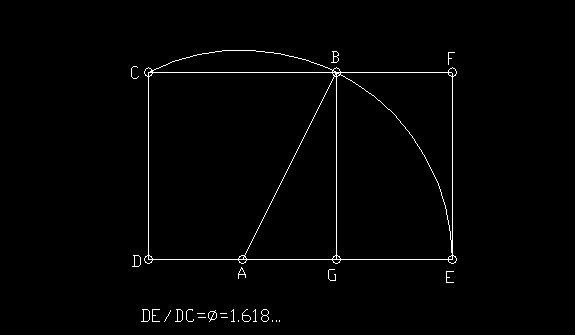
golden_ratio-1 The Golden Rectangle
And Its Construction From a Square:
– to – height ratio is in Divine Proportion. In other words, the golden rectangle’s height is to its width as its width is to its width plus its height. As was already mentioned in the history of the Divine Proportion (in Section 1), the golden rectangle is the most pleasing aspect-ratio to most people, and has been much used in art and architecture ever since the ancient Greeks discovered this harmonious proportionality of Nature. Even designers of computer monitor screens seem to be aware of the optimally-pleasing qualities of the Golden Rectangle, for the widescreen 1280 x 800 pixel (16:10 aspect ratio WXGA) computer screens approximate the golden rectangle to within about 1.127 percent — really quite a good approximation considering how “round” these numbers are (1280 = 5 x 28, and 800 = 52 x 25). And this format has another advantage, too: it turns out that (16:9 aspect ratio) 1280 x 720 progressive scan High Definition Television pictures can be displayed quite well on such a (1280 x 800) screen, with 80 pixels worth of room at the top and/or bottom of the screen for toolbars, clock, status indicators, etc. Anyway, back to the Golden Rectangle….
In this section, we will explore how the Golden Rectangle can be constructed from a square. Although this geometrical construction is not really any simpler that the construction of the Golden Section which is described in Section 3 of this article (because it necessitates the preliminary geometric construction of a square), nevertheless, the construction of the Golden Rectangle provides us with an interesting and enlightening alternative way of geometrically producing the Divine Proportion. Here, then, in summary form, is how to construct a Golden Rectangle:
Procedure for Constructing a Golden Rectangle From a Square:
1. Given square ABCD, bisect the square with line segment EO.
2. Draw diagonal OB (= OG). Set the radius of the compass to this distance (OB), and draw a circle with this radius centered on point “O”.
3. Extend line segment DC to reach the circle. Label this point of intersection “G”.
4. Erect a perpendicular upward at point “G”, and extend line segment AB to the right, to meet this perpendicular at point “F ”.
5. The rectangle AFGD thus produced is the Golden Rectangle, in which the height (AD) and the width (DG) are in divine proportion. Moreover, the part (BFGC) added onto the original square is a golden rectangle, too.
If a rectangle is drawn, whose sides are in Golden Ratio (as above), the “Golden Rectangle” may be divided into a square, which will leave another, similar (but smaller) residual golden rectangle. This process may then be repeated on the residual golden rectangle, and so on, ad infinitum. Because the sum of the areas in this infinite series of diminishing squares is equal to the area of the original golden rectangle (i.e., 1 x φ square units), we know that φ must be a root of the infinite series equation:
The Divine Proportion’s Connection with the Logarithmic (Equiangular) Spiral and the Chambered Nautilus; and How to Use Golden Rectangles to Draw an Approximation to an Equiangular Spiral: ‘
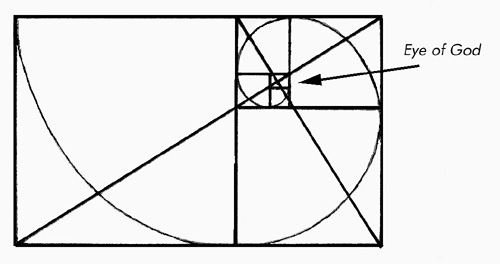
The Divine Proportion’s Connection with the Logarithmic (Equiangular) Spiral and the Chambered Nautilus; and How to Use Golden Rectangles to Draw an Approximation to an Equiangular Spiral:
As mentioned in Section 5, when a golden rectangle is divided into a square and a left-over piece, the left-over piece is itself a golden rectangle (albeit a smaller one, rotated by 90°). This process may then be repeated with similar results on the residual golden rectangle, ad infinitum. When a golden rectangle is divided into a series of diminishing squares like this, it is possible to draw an equiangular spiral through successive vertices of the sequence of squares. A good approximation to this (equiangular or logarithmic) spiral can be produced by a sequence of quarter-circles of diminishing radius. The spiral recedes inward, converging toward the point where the diagonals of all the golden rectangles meet:
Referring to the immediately-preceding figure, the equiangular (or logarithmic) spiral may be approximated (using a compass and straight-edge alone) from the golden rectangle in the following manner:
1. Construct a golden rectangle, in the manner outlined in Section 5.
2. Partition the golden rectangle into the largest possible square and a left-over rectangle (Note: this left-over rectangle also turns out to be in divine proportion — automatically!) This square is, of course, produced by marking off with the compass the (shorter) height of the golden rectangle along its (longer) width, and then drawing the partitioning segment, BC.
3. Now repeat Step 2 on every successive residual golden rectangle as many times as you can before the squares and rectangles become too small to work with. [As a practical matter, inaccuracies grow with every successive partitioning, but if you draw the diagonals AF and CE, this will help keep you from going too far astray, for three of the corners of every golden rectangle in the figure fall upon these two lines, as do two of the corners of every square. The diagonals are shown as the two crossing red line segments in the figure.]
4. After you have partitioned the original golden rectangle into a total of six (or so) squares, set the compass radius to span the distance from point “C” to point “D”, and then, using point O1 (at point “C”, or the bottom right corner of square #1) as center, swing a circular 90° arc from point “D” to point “B”.
5. Next, reset the compass radius to span the distance from point O2 to point “B” and, using point O2 (the bottom left corner of square #2) as center, swing a circular 90° arc from point “B” to the bottom right corner of square #2.
6. Now, reset the compass radius to span the distance from point O3 to the upper right corner of square #3 and, using point O3 (the upper left corner of square #3) as center, swing a circular 90° arc from the upper right corner of square # 3 to the bottom left corner of the same square.
7. Once again, reset the compass radius, this time to span the distance from point O4 to the bottom right corner of square #4; then, using point O4 (the upper right corner of square #4) as center, swing a circular 90° arc from the bottom right corner of square #4 to the upper left corner of the same square.
8. As before, reset the compass radius, this time to span the distance from point O5 to the bottom left corner of square #5; then, using point O5 (the bottom right corner of square #5) as center, swing a circular 90° arc from the bottom left corner of square #5 to the upper right corner of the same square.
9. Finally, reset the compass radius again, this time to span the distance from point O6 to the upper left corner of square #6; then, using point O6 (the bottom left corner of square #5) as center, swing a circular 90° arc from the upper left corner of square #5 to the bottom right corner of the same square. The resulting figure should be a fairly nice geometrically-constructed approximation of an equiangular or logarithmic spiral, based upon the properties of the divine proportion.
Approximate and true Golden Spirals. The green spiral is made from quarter-circles tangent to the interior of each square, while the red spiral is a Golden Spiral, a special type of
logarithmic spiral. Overlapping portions appear yellow. The length of the side of a larger square to the next smaller square is in the golden ratio. (A Fibonacci spiral is not shown, but could be constructed from a similar “whirling rectangle diagram”, in which the ratios of the rectangles were based on the terms in the Fibonacci series, rather than phi.)
In
geometry, a golden spiral is a
logarithmic spiral whose growth factor b is related to φ, the
golden ratio. Specifically, a golden spiral gets wider (or further from its origin) by a factor of φ for every quarter-turn it makes. Contents [
hide]
Approximations of the golden spiral
There are several similar spirals that approximate, but do not exactly equal, a golden spiral.
[3] These are often confused with the golden spiral.
For example, a golden spiral can be approximated by a “whirling rectangle diagram,” in which the opposite corners of squares formed by spiraling golden rectangles are connected by quarter-circles. The result is very similar to a true golden spiral (See image on top right). Another approximation is a
Fibonacci spiral, which is not a true logarithmic spiral. Every quarter turn a Fibonacci spiral gets wider not by φ, but by a changing factor related to the ratios of consecutive terms in the
Fibonacci sequence. The ratios of consecutive terms in the Fibonacci series approach φ, so that the two spirals are very similar in appearance. (See image on bottom right). Golden spiral in nature
Although it is often suggested that the golden spiral occurs repeatedly in nature (e.g. the arms of
spiral galaxies or sunflower heads) , this claim is rarely valid except perhaps in the most contrived of circumstances. For example, it is commonly believed that
nautilus shells get wider in the pattern of a golden spiral, and hence are related to both φ and the Fibonacci series. In truth nautilus shells exhibit
logarithmic spiral growth, but at a rate distinctly different from that of the golden spiral.
[4] The reason for this growth pattern is that it allows the animal to grow at a constant rate without having to change shape. Spirals are common features in nature, but there is no evidence that a single number dictates the shape of every one of these spirals. The greatest misconception in the mystification of the golden spiral is the incorrect assumption that all spirals in nature are in fact the golden spiral. While logarithmic spirals are often observed, they may be of differing pitches, and therefore there is no single “
spira mirabilis“.
— Divine Proportions Appearing in the Pentagram —
As proven in Euclid’s Elements (Book 13, Proposition 8,) in the regular pentagram (i.e., the five-pointed star made up of all five diagonals of the regular pentagon), each diagonal of the pentagon (in this case, AB) intersects two others such that the diagonal is sectioned into the divine proportion in four different ways:
According to the Encyclopædia Britannica, the pentagram contains a staggering two hundred golden ratios! Are you beginning to see why the Pythagoreans were in awe of the Pentagon, the Pentagram, and the polyhedron based upon them — the dodecahedron? When they discovered this mystical proportionality popping up over and over again, they felt they had touched divinity. Hence, the name.
— Divine Proportionality of Nested Pentagons —
If a series of nested pentagons and pentagrams is drawn such that two of the indented edges of one pentagram also define two of the protruding edges of the next (smaller) pentagon in the series, then the sides of any two adjacent pentagons nested in such a diminishing series will be in Divine Proportion:
This, of course, also implies that the distance between any two adjacent points of a pentagram (i.e., neighboring “points of the star”) is in divine proportion with the length of the long sides of the isosceles triangles which point outward from the central pentagon produced by the intersections of the five diagonals. It would seem, the divine proportions crop up in such profusion in the pentagon and pentagram, that they are literally piled one upon the other!
– Divine Proportions Appearing in the Decagon —
A regular decagon (i.e., a 10-sided polygon having all sides equal, and all angles equal) can be constructed by laying together ten acute isosceles golden triangles (i.e., acute triangles two of whose sides are in divine proportion to the third) in such a way that the vertices opposite the short side of the triangles meet at a point, which becomes the center of the decagon:
Another way of looking at this would be that, in the regular decagon, the circumcircle radius is in divine proportion with any side of the inscribed decagon. One would expect the central angle of each side of the decagon (and hence the triangles of which it is composed) to subtend 36° — since ten equal angles must add up to 360° — but what it is perhaps surprising is that the 72° – 36° – 72° isosceles triangle just so happens to have sides which are in divine proportion, and, therefore, five such triangles can be arranged to produce a regular pentagram.
The Divine Proportions Appearing in the Regular Icosahedron, Regular Dodecahedron, and Rhombic Triacontahedron
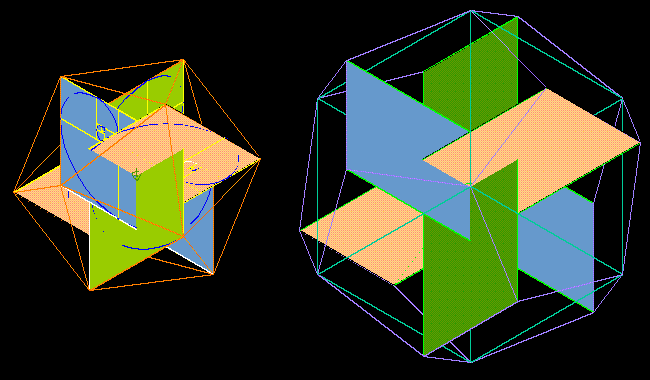
The Divine Proportions Appearing in the Regular Icosahedron, Regular Dodecahedron, and Rhombic Triacontahedron
In view of the fact that he was the discoverer of the Divine Proportion, it is perhaps not surprising that Pythagoras also knew of the Golden Section’s connection with two of the five possible regular polyhedra. The regular icosahedron is a polyhedron having 20 equilateral triangular faces, 12 vertices, and 30 edges. Well, it just so happens that when the icosahedron’s twelve vertices are divided into three coplanar groups of four, these groups of four vertices lie at the corners of three symmetrically-situated, mutually-perpendicular golden rectangles, with their one common point situated at the center of the icosahedron. In other words, the Divine Proportion is built into this beautiful mathematical shape! Bear in mind that this trio of golden rectangles does not merely appear accidentally within the icosahedron, but these golden rectangles in a sense define the icosahedron. An illustration may help to make this relationship easier to comprehend:
[In this figure, the ratio of the blue rectangle-edges to the magenta edges is exactly φ.]
Because the dodecahedron is the dual* form of the icosahedron, it is perhaps not surprising that the regular dodecahedron also has a connection with the Divine Proportion. The Regular dodecahedron is a polyhedron having 12 regular pentagonal faces, 20 vertices, and 30 edges. As one might expect from this polyhedron’s duality with the icosahedron, the centers of the 12 pentagonal faces of the regular dodecahedron are divisible into three coplanar groups of four. These tetrads lie at the corners of three symmetrically-situated mutually-perpendicular golden rectangles, with their common point situated at the centroid of the dodecahedron. Again, an illustration may help to make this relationship more readily comprehensible:
Once again, a beautiful shape of Nature is based upon the Divine Proportion!
* Note: Two polyhedra are duals if the vertices of one can be put in one-to-one correspondence with the centers of the faces of the other. Incidentally, the reader is asked to ignore the imperfections of the figure above, and to imagine that the corners of the golden rectangles do indeed touch the centers of the pentagons. It took Khan most of a day to get the drawing to this state of imperfection!
As we have already mentioned, Johannes Kepler (1571-1630) was quite enamored of the Divine Proportion, and indeed, upon occasion, he called it by that name. In view of his reverence for this harmonious proportionality of Nature, it is only fitting that Kepler was also the discoverer of the Archimedean polyhedron known as the Rhombic Triacontahedron. The Rhombic Triacontahedron is a polyhedron having 30 identical rhombic faces, 20 vertices where 3 rhombi meet, 12 vertices where 5 rhombi meet, and 60 edges. Because it is such an attractive polyhedron, the writer of this article could not resist the temptation to make one, in the year 1991. When constructing the template from which to cut matte-boards into the correctly-shaped rhombic faces (to be glued together), it was noted that the face angles were (the arctangent of 2) and (180° minus the arctangent of 2). This seemed to imply that the ratio between the lengths of the two diagonals of the rhombic triacontahedron’s faces was a very simple ratio, so we did a bit of analysis to find out what this ratio may be, and we were dumbfounded to see the Divine Proportion pop up again in yet another beautiful mathematical shape. Although we suspect that this was known to Kepler centuries before we re-discovered the fact, it turns out that every face of the Rhombic Triacontahedron is a golden rhombus, i.e., a rhombus whose diagonals are in Divine Proportion! In case the reader dares to risk catching the “polyhedron-constructing madness bug”, here is Khan Amore’s template for the golden rhombus used to construct the Rhombic Triacontahedron:
Polyhedra
Polyhedra
In this page not only some known polyhedra but also
animations of dual polyhedra are presented. Of the various polyhedra, which are simultaneously convex and regular? These polyhedra, already known in ancient Greece are called platonic solids. There are only five platonic solids – tetrahedron, cube, octahedron, icosahedron and dodecahedron.
(The animations and figures were made with mathematica© and converted with the help of
LiveGraphics3D. About how to use the software see
help).
https://www.mathsisfun.com/geometry/tetrahedron.html
Polyhedra
Polyhedra
In this page not only some known polyhedra but also
animations of dual polyhedra are presented. Of the various polyhedra, which are simultaneously convex and regular? These polyhedra, already known in ancient Greece are called platonic solids. There are only five platonic solids – tetrahedron, cube, octahedron, icosahedron and dodecahedron.
(The animations and figures were made with mathematica© and converted with the help of
LiveGraphics3D. About how to use the software see
help).
click on text here:
tetrahedron , and control moving dimensional image with mouse cursor.
Polyhedra
Octahedron
click on text here:
cube , and control moving dimensional image with mouse cursor.
click on text here:
octahedron , and control moving dimensional image with mouse cursor.
click on text here:
icosahedron , and control moving dimensional image with mouse cursor.
click on text here:
dodecahedron , and control moving dimensional image with mouse cursor.
Once all the regular convex polyhedra are known, it is natural to ask: Are all regular polyhedra convex? Johannes Kepler, in 1619, found two polyhedra which are simultaneously regular and not convex – the small stellated dodecahedron and the big stellated dodecahedron. Two centuries later it woud be proved that there are only nine polyhedra in these conditions: the five platonic solids and four nonconvex regular polyhedra – the Kepler-Poinsot polyhedra. Kepler-Poinsot Polyhedra
Johannes Kepler’s regular and not convex polyhedra, peqdodecahedron, small stellated dodecahedron
click on text here: big stellated dodecahedron , and control moving dimensional image with mouse cursor.
Kepler-Poinsot polyhedral, nonconvex regular polyhedral, grandodhedron, big dodecahedron
click on text here: big dodecahedron , and control moving dimensional image with mouse cursor.
Kepler-Poinsot Polyhedra, nonconvex regular polyhedral, Graicosahedron, stellated icosahedron
If we consider any platonic solid and “join” the center ponts of sides, we get a new platonic solid (see the lower table). These two solids are said to be duals of one another. Duality
Platonic Solids, joined center ponts of sides two solids are said to be duals of one another, Dual of the tetrahedron, dtetrahedron
click on text here: Dual of the tetrahedron , and control moving dimensional image with mouse cursor.
Platonic Solids, joined center ponts of sides two solids are said to be duals of one another, Dual of the cube, dcuboedron
click on text here:
Dual of the cube , and control moving dimensional image with mouse cursor.
Platonic Solids, joined center ponts of sides two solids are said to be duals of one another, Dual of the octahedron, doctaedron
The previous table points to a certain distribution of the 5 regular polyhedra in 3 classes: Tetrahedron (dual of itself), Cube and Octahedron, Dodecahedron and Icosahedron. Consider the pair – octahedron/cube – count the number of faces, vertices and edges of each of these solids. Now consider the pair – dodecahedron/icosahedron – and do the same. To finish, count the number of faces, vertices and edges of the tetrahedron. What do you conclude?
The animations presented in the following table show that it is possible to construct the dual of a given platonic solid by truncating it successively.
Table of Animations
Platonic Solids truncated successively Anim. trunc. tetr./tetrahedron, animtetrahedron
Platonic Solids truncated successively Anim. trunc. cube/octahedron, animcubohedron
click on text here: Anim. trunc. cube/octahedron , and control moving dimensional image with mouse cursor.
click on text here: Anim. trunc. dodec./icosahedron , and control moving dimensional image with mouse cursor.
In the model formed by a tetrahedron and its dual (which is also a tetrahedron) presented in the duality table, if we enlarge the interior tetrahedron so that the edges of both tetrahedron are at the same distance of the common center, we obtain a composed polyhedron – the stella octangula.
Composed polyhedron
Platonic Solids tetrahedron and its dual, enlarged interior tetrahedron, edges of both tetrahedron same distance from the common center, composed polyhedron – Stella Octangula
click on text here:
stella octangula , and control moving dimensional image with mouse cursor.
///////////////////////////////////////////////////////////////////////////
Polyclitus, Aristotle and Plotinus
If beauty is definable some general concept on order of this sort must be part of the definition. If it is not definable, mathematical order must at least be a potent criterion of beauty, on Plato’s view. In this he was at one with artists who like Polyclitus incorporated systems of proportions into their work. Polyclitus, a late 5th century Greek sculptor, is said to have written a book setting forth ideal human proportions and sculpted a statue called the Canon (rule) because it exhibited these relationships at least as far as a physical particular can.
During the 500 years between Aristotle and Plotinus intellectual life was vigorous and thinkers certainly discussed beauty. But very little is left, especially of Hellenistic writings about beauty. One major idea appearing in this period may be identified from later sources, namely the idea of the phantasia in the mind of the artist or appreciator of beauty. The great Roman orator Cicero presents this notion in the following passage, written in the first century B.C.
…I am firmly of the opinion that nothing of any kind is so beautiful as not to be excelled in beauty by that of which it is a copy, as a mask is a copy of a face. This ideal cannot be perceived by the eye or ear, nor by any of the senses, but we can nevertheless grasp it by the mind and the imagination. For example, in the case of the statues of Phidias, the most perfect of their kind that we have ever seen, and in the case of the paintings I have mentioned, we can, in spite of their beauty, imagine something more beautiful. Surely that great sculptor, while making the image of Jupiter or Minerva, did not look at any person whom he was using as a model, but in his own mind there dwelt a surpassing vision of beauty; at this he gazed and all intent on this he guided his artist’s hand to produce the likeness of the god.
Accordingly, as there is something perfect and surpassing in the case of sculpture and painting-an intellectual ideal by reference to which the artist represents those objects which do not appear to the eye [for instance, gods and perhaps other mythological personages ], so with our minds we conceive the ideal of perfect eloquence (Cicero’s subject is rhetoric], but with our ears we catch only the copy. These patterns of things are called ideai [Ideas, Forms] by Plato, that eminent master and teacher both of style and of thought… (Orator III, 8-10) Cicero makes a connection here between beauty and representational art that Plato evidently did not, judging from the Book X of the Republic. This connection was to become the cornerstone of artistic theory in the Renaissance.
{ I actually find this a little silly, to quote Cicero, an orator about the sculpture method, that was not known at this time of Phidias. Logically if one studies the slow and even progression of sculpture technique, and content in Greek sculpture – there isn’t any great break from earlier times, the process is additive. The geometry in Phidias’s sculpture would be simplistic if the basis for Classical period sculpture (of the upper tier work) was from the imagination, not extracted from nature. The whole premise in Greek art is an understanding of nature in its essential depth. Abstraction in form is evident throughout Greek sculpture periods. This abstraction is beyond a simple likeness in the Classical, Transitional, and Hellenistic. The complexity would not be seen in such depth, visually scanning obliquely across the surface as walking round the sculpture,-sighting very complex geometry as the boundaries of the sculpture surface., – Blogger P Brad Parker }
Plotinus’ theory of beauty
Plotinus (204-69 A.D.) revived and modified Plato’s philosophy, considerably increasing the mystical element in it. His writings were collected by his pupil, Porphyry, and arranged in six Enneads (literally, of nine parts each). As background, let me first sketch Plotinus’ cosmology or theory of reality at large, even though I can give only the roughest sketch of it. Plotinus conceived of all reality as the outflowing of a single mystical being, “the one”, which was ineffable (literally indescribable) and capable of being apprehended only in exalted mystical states of consciousness. The “emanations” of this One formed a continuous hierarchy of beings: Divine Intellect, the Platonic Forms, the World Soul, individual souls, physical things ranging from the most refined to the grossest, and at the bottom raw matter. This ordered array of things filled all possible grades of being, and came to be known as the Great Chain of Being. The philosopher’s quest is to rise up as far as possible in the chain of being by developing the aspects of himself that stand highest in it, which are of course his intellectual and moral capacities, as Plato says in the Symposium. This ascent achieves as much beauty as we are capable of; above our reach stand yet more beautiful beings which we can only contemplate.Plotinus’ texts give us more about beauty than any of those which have survived other than Plato’s. Further, he is the first thinker to write an extended essay specifically on beauty. The following sections present some of the more notable parts of his discusssions.
As mystical as Plotinus is, at times he becomes rigorously analytical, as in this argument against the view that beauty being the reducible to symmetry of parts and charm of color. (trans. S. Mackenna) What is it that attracts the eyes of those to whom a beautiful object is presented, and calls them, lures them, toward it, and fills them with joy at the sight? If we possess ourselves of this, we have at once a standpoint for the wider survey.
Almost everyone declares that the symmetry of parts towards each other and towards a whole, with, besides, a certain charm of colour, constitutes the beauty recognized by the eye, that in visible things, as indeed in all else, universally, the beautiful thing is essentially symmetrical, patterned.
But think what this means. [On such a hypothesis] only a compound could be beautiful, never anything devoid of parts, and only a whole; the several parts would have beauty not in themselves but only as working together to give a comely totality. Yet in fact [contrary to the hypothesis] beauty in any aggregate demands beauty in details; it cannot be constructed out of ugliness; its law must run throughout.1 All the loveliness of colour and even the light of the sun, being devoid of parts (2) and so not beautiful by symmetry, must [on the hypothesis] be ruled out of the realm of beauty. And how [on that theory] comes gold to be a beautiful thing? And lightning by night, and the stars, why [according to the theory] are these so fair? [1. Here Plotinus repeats the idea in Plato’s Symposium that really beautiful things must be beautiful through and through. But it is highly dubious, since its suggests e.g. that sculptures are more beautiful if made of precious materials. 2. It is not easy to know whether light, color, and musical tones should be regarded as simple or complex in their aesthetic aspect, that is, as they are experienced. Can we perceive any complexity in them? Plotinus thinks not, but we can certainly distinguish hue from brightness and saturation, and pitch from loudness and tone quality. However, Plotinus’ main point does not require the strict simplicity of these things, but only that there be no parts which could be symmetrically arrayed. And that seems undeniable. His argument could easily be recast to avoid the problem of strict simplicity.] In sounds also the simple must be proscribed though often [contrary to the hypothesis] in a noble composition each individual tone is delicious in itself. Again since the one face, constant in symmetry, appears sometimes fair and sometimes not, can we doubt that beauty is something more than symmetry, that symmetry itself owes its beauty to a remoter principle? Turn to what is attractive in methods of life or in the expression of thought; are we to call in symmetry here? What symmetry is to be found in noble conduct, or excellent laws, in any form of mental pursuit?
In sounds also the simple must be proscribed though often [contrary to the hypothesis] in a noble composition each individual tone is delicious in itself. What symmetry can there be in points of abstract thought?
The symmetry of being accordant with each other? But there may be accordance or entire identity where there is nothing but ugliness; the proposition that honesty is merely a generous artlessness chimes in the more perfect harmony with the proposition that morality means weakness of will; the accordance is complete.
The again, all the virtues are a beauty of the soul, a beauty authentic beyond any of these others; but how does symmetry enter here? The soul, it is true, is not a simple unity, but still its virtue cannot have the symmetry of size or of number: what standard of measurement could preside over the compromise or the coalescence of the soul’s faculties or purposes?
Finally, how by this theory would there be beauty in the Intellectual-Principle, essentially’ the solitary? (Ennead I, 6, §1) Like Plato, Plotinus stresses how spontaneous our response to beauty and ugliness is:
…it is something perceived at first glance, something which the soul names as if from an ancient knowledge and, recognizing it, welcomes it, even enters into unison with it.
But let the soul fall in with the ugly and at once it shrinks within itself, denies the thing, turns away from it, not accordant, resenting it. Our interpretation is that the soul — by the very truth of its nature, by its affiliation to the noblest Existents in the hierarchy of Being — when it sees anything of that kinship, thrills with an immediate delight, (3) takes its own to itself, and thus stirs anew to the sense of its nature and of all its affinity. Ennead, I, 6, 2.
[3. Plotinus gives the impression that the delight never fails, as if beauty always thrills. But elsewhere he acknowledges that this holds only for the purified soul. Commonly people fall short of this ideal because they are in some degree corrupt or ill-trained. The term immediate in this context is mainly a matter of the delight not depending on our ability to explain what is so good about the thing that delights us.]
The following excerpts reflect the Apollonian ideal and were more influential in the Middle Ages than were Plato’s writings, which were less widely available than were those of Plotinus and Christian Neoplatonists. We hold that all the loveliness of this world comes by communion in Ideal-Form.
All shapelessness whose kind admits of pattern and form, as long as it remains outside of Reason and Idea, is ugly by that very isolation from the ‘Divine-Thought. And this is the Absolute Ugly: an ugly thing is something that has not been entirely mastered by pattern, that is by Reason, the Matter not yielding at all points and all respects to Ideal-Form.
But where the Ideal-Form has entered, it has grouped and coordinated what from a diversity of parts was to become a unity; it has rallied confusion into cooperation; it has made the sum one harmonious coherence; for the Idea is a unity and what it moulds must come to unity as far as multiplicity may.
And on what has thus been compacted to unity, Beauty enthrones itself, giving itself to the parts as to the sum: when it lights on some natural unity, a thing of like parts, then it gives itself to that whole. Thus, for an illustration, there is the beauty, conferred by craftsmanship, of all a house with all its parts, and the beauty which some natural quality may give to a single stone. (§2)
The beauty of color is also the outcome of a unification: it derives from shape (1), from the conquest of the darkness inherent in Matter by the pouring-in of light, the unembodied, which is a Rational-Principle and an Ideal-Form.
Hence it is that Fire itself is splendid beyond all material bodies, holding the rank of Ideal Principle to the other elements, making ever upwards, the subtlest and sprightliest of all bodies, as very near to the unembodied; itself alone admitting no other, all the others penetrated by it; for they take warmth but this is never cold; it has colour primally; they receive the Form of colour from it: hence the splendour of its light, the spendour that belongs to the Idea. And all that has resisted and is but uncertainly held by its light remains outside of beauty as not having absorbed the plentitude of the Form of colour.
And harmonies unheard in sound create the harmonies we hear (2) and wake the Soul to the consciousness of beauty, showing it the one essence in another kind: for the measures of our sensible music are not arbitrary but are determined by the Principle whose labour is to dominate Matter and bring pattern into being.
Thus far of the beauties of the realm of sense, images and shadow-pictures, fugitives that have entered into Matter — to adorm, and to ravish, where they are seen. (Ennead I, 6, §3)
[1. It is hard to make out what Plotinus could mean by color being derived from shape. Perhaps it is connected with the idea of color being a mixture of daylight and darkness derived from matter. He seems to believe that color results from daylight being partly absorbed by the matter of things which we see as colored, and the shape of the particles of matter may produce the different mixtures we see as color. 2. The unheard harmonies are the pure mathematical ratios involved in musical harmony. Plotinus thinks that the soul responds to the mathematics rather than to the heard qualities of sound]
Plotinus picks up the phantasia idea earlier expressed by Cicero and in addition neatly inverts Plato’s argument about the mimetic arts. They can’t be much worse than natural objects if they are so much like them. Further, he develops Aristotle’s idea that artists (in the broad sense which includes craftsmen) create as nature does. They don’t merely produce imitations of nature’s products. So conceived the best artist is just one step below the creative principle in nature, which is a compliment, coming from someone so finely tuned to the glories of the world as Plotinus. This last is demonstrated by praise of nature in the same passage, even though here and elsewhere he stresses the incomparable beauty of purely spiritual things, from individual souls all the way up to the One, or Intellectual-Principle, which is beyond mere beauty.
Still the arts are not to be slighted on the ground that they create by imitations of natural objects; for, to begin with, these natural objects are themselves imitations; then, we must recognize that they give no bare reproduction of the thing seen but go back to the Reason-Principles from which Nature itself derives, and, furthermore, that much of their work is all their own; they are holders of beauty and add where nature is lacking. Thus Pheidias wrought the Zeus upon no model among things of sense but by apprehending what form Zeus must take if he chose to become manifest to sight. (Ennead V, 8, §1) Whence shone forth the beauty of Helen, battlesought; or of all those women like in loveliness to Aphrodite; or of Aphrodite herself; or of any human being that has been perfect in beauty; or of any of these gods manifest to sight, or unseen but carrying what would be beauty if we saw? In all these is it not the Idea, something of that realm but communicated to the produced from within the producer, just as in the works of art, we held, it is communicated from the arts to their creations? Now we can surely not believe that, while the made thing and the Idea thus impressed upon Matter are beautiful, yet the Idea not so alloyed but resting still with the creator — the Idea primal, immaterial, firmly a unity — is not Beauty. (§2)
And indeed if the divine did not exist, the transcendently beautiful, in a beauty beyond all thought, what could be lovelier than the things we see? Certainly no reproach can rightly be brought against this world save only it is not That. (§8)
In the next passage Plotinus speaks about the process of inner reflection which he believes is required if we are to refine and deepen our apprehension of beauty. It provides a corrective to any hasty conclusion from the earlier reference to our knowledge of beauty as immediate and spontaneous. “We must close our eyes and invoke a new manner of seeing, a wakefulness that is the birthright of us all, though few put it to use.” He continues:
What, then, is this inner vision?
Like anyone just wakened, the soul cannot look at bright object. It must be persuaded first to look at beautiful habits, then the works of beauty produced not by craftsman’s skill but by virtue of men known for their goodness, then the soul of those who achieve beautiful deeds. “How can one see the beauty of a good soul?” Withdraw into yourself and look. If you do not as yet see beauty within you, do as does the sculptor of a statue that is to be beautified; he cuts away here, he smooths it there, he makes this line lighter, this other one purer, until he disengages beautiful lineaments in the marble. Do you this, too. Cut away all that is excessive, straighten all that is crooked, bring light to all that is overcast, labor to make all one radiance of beauty. Never cease “working at the statue” until there shines out upon you from it the divine sheen of virtue, until you see perfect “goodness firmly established in stainless shrine.” Have you become like this? Do you see yourself, abiding within yourself, in pure solitude? Does nothing remain now to shatter that interior unity, nor anything external cling to your authentic self? Are you entirely that sole true light which is not contained by space, not confined to any circumscribed form, not diffused as something without a limit, but ever unmeasurable as something greater than all measure and something more than all quantity? Do you see yourself in this state? Then you have become vision itself. Be of good cheer. Remaining here you have ascended aloft. You need a guide no longer. Strain and see. Only the mind’s eye can contemplate this mightly beauty, But if it comes to contemplation purblind with vice, impure, weak, without the strength to look upon brilliant objects, it then sees nothing even if it is placed in the presence of an object that can be seen. For the eye must be adapted to what is to be seen, have some likeness to it, if it would give itself to contemplation. No eye that has not become like unto the sun will ever look upon the sun; nor will any that is not beautiful look upon the beautiful. Let each one therefore become godlike and beautiful who would contemplate the divine and beautiful.
So ascending, the soul will come first to The Intelligence and will survey all the beautiful Ideas therein and will avow their beauty, for it is by these ideas that there comes all beauty else, by the offspring and the essence of The Intelligence. What is beyond The Intelligence we affirm to be the nature of the good, radiating beauty before it. (Ennead I, 6, §9)
///////////////////////////////////////////////////////////////////////////
Hellenistic period – Alexandria, Egypt
One may conclude, as does Fowden, that “genuine cultural fusion” between, on the one hand, native Egyptian religion & philosophy and, on the other hand, Greek rationality, both scientific & philosophical, most likely took place in the “educated native milieu”. The origin of Alexandro-Egyptian culture (of a genuine merge) is thus to be found in the relatively small upper classes of the native priesthood & administrators (open to the impact of Greek thought and different from the large majority of natives that did not adopt Greek beliefs and practices) as well as in the very limited number of Greeks that egyptianized. As only ca.10% of the total population was literate (
Davies, 1995, p.27), we may conclude that the original “niche” of this emergent new Graeco-Egyptian consciousness (infusing fertile traditions with rationality) was rather small in number. Was it potent enough to initiate a new Alexandro-Egyptian cultural form, including a religious system, a philosophy, a ceremonial order as well as a vast number of popular magical practices, namely Hermetism ?4.4 Religious syncretism & stellar fatalism.syncretism as a political toolSerapis was associated with Isis, to whom Alexander the Great had dedicated a temple in Alexandria. This divine pair was linked with the divine royal couple, Serapis to Pharaoh, Isis to the queen. With these linear equations, the Greeks introduced dual-natured syncretic deities, corresponding to the two-fold aspect of the Ptolemaic rulers, both Basileus and Pharaoh. They deified themselves in the process. The dynastic cult was the political device with which the Ptolemies legitimized their rule : for the ruling classes Ptolemy I was Basileus, a divine person in Alexandrian style, for the natives he was Pharaoh, son of Re, Egypt personified.
Anubis as a Roman in the sarcophagus room of the hypogaeum – Roman period – first centuries CE – Alexandria Ptolemaic kingship had to be upheld by the gods, and hence the Greek rulers worshipped Greek, Egyptian and Graeco-Egyptian deities.Cultic syncretism is best evidenced in the Hellenized parts of Egypt, such as Alexandria (and the Fayyum) and was initiated by the Greek rulers.The principle continued to be applied until the Roman period, when it ran against the canon of Egyptian art and involved a grotesque putting together of disparate elements, like the use of Roman vestments …
In general, the native Egyptian remained loyal to the venerable cultic forms (preferably going back to the Old Kingdom) and religious syncretism is an ambiguous process :”Although it presupposes the interaction of at least two religious cultures, interest in this process may fluctuate widely among different categories of worshippers, and produce an extremely uneven effect on their conception of the gods involved, and on the way in which they worship those gods.”
Fowden, 1986, p.19. As we know that both groups tended to keep to their own, it is unlikely that syncretic deities as Serapis were worshipped by native Egyptians without thinking of Osiris (as Amun might have been praised by a few exceptional Greeks, but never without considering Zeus). In many ways, syncretism downgrades the specificity of each archetype. In Ptolemaic Egypt, it was a diplomatic way for the ruler to honor both sides.fatalism and the movement of the stars : “Aegyptus imago sit caeli”Next to the traditional Egyptian religious forms (recapitulating Old Kingdom canons), and the particularities of the ideology of the Greek Basileus, we must stress the further development of a trend which started in the Late New Kingdom. It consisted in attributing less importance to worldly success (position in the Pharaonic state) and more to the inward man and his realization of modesty in the face of reality. This regrouping of values made the new ideal man humble before godhead. He realized that everything was decreed by god’s will. Maat was still the divine order which governed the world, but, living according to Maat, was no longer described in terms of material rewards or position in society, but as the humility of man toward the omnipotent will of god. Worship was thus a way to please god, a sacrifice made to make the personal will coincide with the divine will (with magic the opposite was aimed at, namely influence over the divine will by assuming it).
… it has become certain that the Hermetic Gnosis was routed in a secret society in Alexandria, a sort of Masonic lodge, with certain rites like a kiss of peace, a baptism of rebirth in the spirit and a sacred meal of the brethren. It started with the astrologic lore contained in works like the Hermetic Panaretos, of the second century before the beginning of the common era. (…) Greeks, Egyptians, and Jews were members of the Hermetic lodge and unanimously contributed their specific traditions to the common views. Christian influences, however, are completely absent.”
Quispel, 1998, p.74.the philosophical HermeticaFor Mahé, the allusions to “the god” and “the gods” in the Egyptian instruction genre are an anticipation of the complex Hermetic God, both One and All. However, this position is disputed, for we are dealing here with a syncretistic culture whose elements were not easily separable. Indeed, the philosophical Hermetica also refer to Jewish (Septuagint) and Greek sources (Plato, Aristotle, the Stoics). Hence, these texts are not lineal descendants of the Egyptian wisdom teachings. Egyptian wisdom is ethical, social and engaged with life here and now. The Hermetica are individualistic, theological, reflective, contemplative and invoke the inner, mystical initiation or celestial voyage of the soul (in trance) during life on Earth (cf. Dionysian and Orphic elements). Moreover, Hermetism is ascetical and rejects matter and the world (cf. the influence of Greek philosophy, Parmenides’ two roads, Plato’s two-world ontology and bi-polar anthropology). the historical phases of HermetismThree fundamental phases appear :
1. native Hermopolitan theology : the perennial worship of the native Egyptian Thoth centered in Hermopolis (“Hermoupolis Magna”). Although the contents of this theology is only know from Ptolemaic sources, “Khnum Khemenu”, “the Eight town” (also called “Per-Djehuty”, the “house of Thoth”) existed in the Vth Dynasty and was associated with the Ogdoad or company of eight precreational gods (frog heads) & goddesses (serpent-headed). A few of them were mentioned in the Pyramid Texts, but the complete list is first mentioned in the Middle Kingdom. These deities emerged from the Nun (the primordial, undifferentiated ocean) and constituted the soul of Thoth. They may also be understood as further characterizations of this dark, unlimited realm of before creation : Amun and Amaunet (hiddenness), Heh and Heket or Huh and Hauhet (eternity), Kek and Keket or Kuk and Kauket (darkness), Nun and Nunet or Nun and Naunet (primordial chaos). This dark, unlimited and eternal realm would return in Jewish qabalah as the “negative existence” of the “Ain Soph”. Hermopolitan theology will provide the framework for Ptolemaic Hermetism.
2. historical Hermetism : the identification of Thoth, “Thrice Greatest”, with Hermes Trismegistus, who, in his philosophical teachings, is Greek and human (although Egyptian elements persist), but who assumed, in the technical Hermetica, the cosmicity of the native Egyptian Thoth. The technical Hermetica are attested under the Ptolemies, and the existence of an Alexandrian multi-cultural Hermetic lodge in the first century BCE is likely. The theo-philosophical sources are the 17 treatises of the Corpus Hermeticum, the Latin Asclepius, the Armenian Hermetic Definitions and the Coptic Hermetica found at Nag Hammadi, in particular The Eighth and the Ninth Sphere (Codex VI.6), which all date from the first centuries CE. It is possible to see Hermetism as a “gnosticism”, but then one particular to imperial Alexandrian culture, for the notion of an evil demiurge (cf. Christian gnosticism) is not present. Constituted by Egyptian, Greek and Jewish elements, Hermetism will influence Judaism (the Merkabah mystics of the Jewish gnostics of Alexandria), Christianity (Clement of Alexandria, the Greek Fathers, the “Orientale Lumen”) and Islam (the Hermetic star worshippers of Harran) ;
3. literary Hermeticism : Renaissance Hermeticism produced a fictional Trismegistus as the godhead of its esoteric concept of the world as an organic whole, with an intimate sympathy between its material (natural) and spiritual (supernatural) components. This view was consistent with the
humanistic phase of modernism, which was followed by a mechanization of the world and the “enlightenment” of the eighteenth century. These new forces ousted all formative & final causes from their physical inquiries, and reduced the four Aristotelian categories of determination to the material & efficient causes. Astrology, magic and alchemy were deemed scientifically backward & religiously suspect. “Actio-in-distans” was impossible, and Paganism was Satanical. In 1666, Colbert evicts astrology from the Academy of Sciences (the court-astrologer Morin de Villefranche had to take place behind a curtain to note the hour of birth of the dauphin). In the nineteenth century, under the influence of the morbid but exotical fancies of the Romantics, Hermeticism became part of Rosicrucianism, Freemasonry, Theosophy and generalized Egyptomania
[contact-form-7 id=”1819″ title=”Contact form 1″]
